FIGHTING COMMON COLD NATURALLY
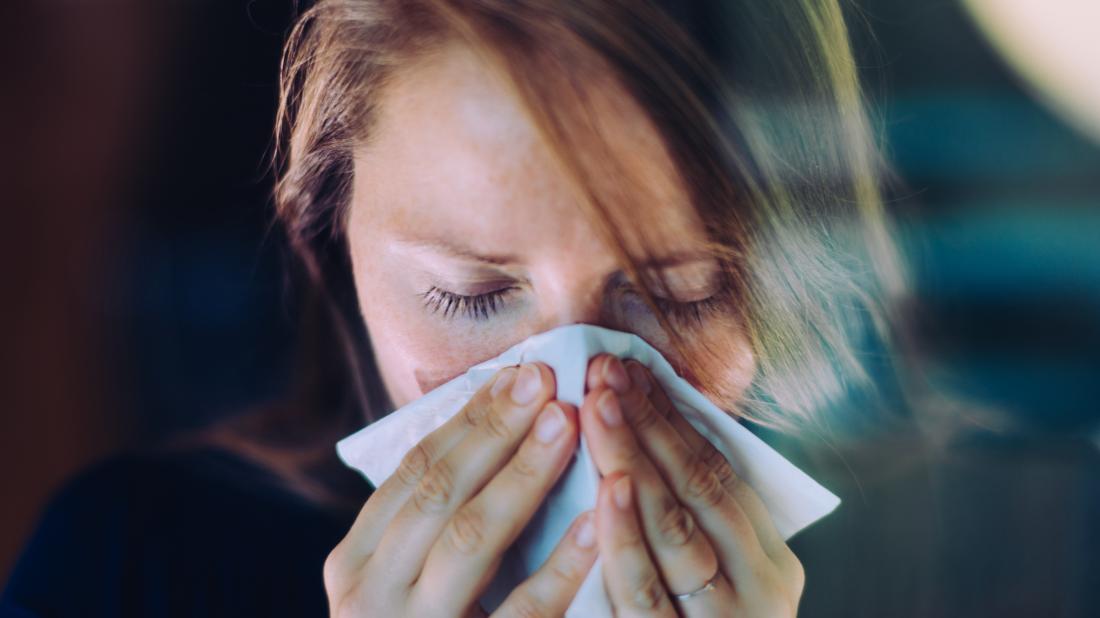
With the change in weather, sneeze, coughs and runny nose are in full swing. The viral in the air have been activated and immunity levels have drop down. Our daily activities, physical and mental we
With the change in weather, sneeze, coughs and runny nose are in full swing. The viral in the air have been activated and immunity levels have drop down. Our daily activities, physical and mental well-being gets affected. So let us learn more about the Common Cold and building our immunity to help us heal naturally.
COLD
There are 100 different types of viruses and if even one gets into the body we catch cold. Once a cold virus attacks the body, our immune system launches a counter attack to defend the body. This response from the body is in the form of cough, stuffed nose, runny nose and headaches. The common cold infects the upper respiratory system. These viruses are contagious. We can contract them when someone affected sneezes, coughs, or even by touching infected surfaces. Because there are 200 sub types of viruses that can cause cold, our body can rarely build resistance to all of them. Hence the name common cold, it often returns with the SNEEZE. According to CDC (Centre for Disease Control and Prevention), adults get 2-3 colds and children get around 12 colds per year.
Cold results in sneeze, headache, runny nose, sore throat and fever. A strong immune system will help to recover from cold without medication. The lower the
immunity, the longer the healing process.
NATURAL REMEDIES THAT HEAL COLD
1. Take 1 inch ginger, one clove garlic, 3 peppercorns, 2 cloves, 2 cardamoms, and one inch cinnamon stick, mash and boil in water. Reduce to half, strain and add honey. Drink this concoction twice or thrice.
2. Do not over eat - When sick, body needs time to heal do not over eat and give time for body to heal.
3. Hydrate- Drink plenty of fluids because cold leads to water loss from body, increasing the chances of dehydration. Soups are a good way to increase consumption of fluids during cold.
4. Raw turmeric drink- Boil ½ inch raw turmeric or ¼ tsp turmeric powder in a cup of water for 5 min, add honey and drink this. Curcumin in turmeric, help increase immunity. The antiviral and antibacterial properties of turmeric help fight infections
5. Steam inhalation- Boil water in open vessel; add 2 drops of eucalyptus oil. Cover head with a towel and slowly inhale. Do this morning and evening for 10 minutes. This helps cure blocked and stuffy nose and chest congestion.
6. Rest- When we limit our screen time and mobility, body gets more resources to fight cold. Do not exert. Breathing exercise, relaxation and walking are good to help the body fight cold.
Stay healthy and strong.
COLD
There are 100 different types of viruses and if even one gets into the body we catch cold. Once a cold virus attacks the body, our immune system launches a counter attack to defend the body. This response from the body is in the form of cough, stuffed nose, runny nose and headaches. The common cold infects the upper respiratory system. These viruses are contagious. We can contract them when someone affected sneezes, coughs, or even by touching infected surfaces. Because there are 200 sub types of viruses that can cause cold, our body can rarely build resistance to all of them. Hence the name common cold, it often returns with the SNEEZE. According to CDC (Centre for Disease Control and Prevention), adults get 2-3 colds and children get around 12 colds per year.
Cold results in sneeze, headache, runny nose, sore throat and fever. A strong immune system will help to recover from cold without medication. The lower the
immunity, the longer the healing process.
NATURAL REMEDIES THAT HEAL COLD
1. Take 1 inch ginger, one clove garlic, 3 peppercorns, 2 cloves, 2 cardamoms, and one inch cinnamon stick, mash and boil in water. Reduce to half, strain and add honey. Drink this concoction twice or thrice.
2. Do not over eat - When sick, body needs time to heal do not over eat and give time for body to heal.
3. Hydrate- Drink plenty of fluids because cold leads to water loss from body, increasing the chances of dehydration. Soups are a good way to increase consumption of fluids during cold.
4. Raw turmeric drink- Boil ½ inch raw turmeric or ¼ tsp turmeric powder in a cup of water for 5 min, add honey and drink this. Curcumin in turmeric, help increase immunity. The antiviral and antibacterial properties of turmeric help fight infections
5. Steam inhalation- Boil water in open vessel; add 2 drops of eucalyptus oil. Cover head with a towel and slowly inhale. Do this morning and evening for 10 minutes. This helps cure blocked and stuffy nose and chest congestion.
6. Rest- When we limit our screen time and mobility, body gets more resources to fight cold. Do not exert. Breathing exercise, relaxation and walking are good to help the body fight cold.
Stay healthy and strong.
1 Like(s)
Myths related to Nutrition
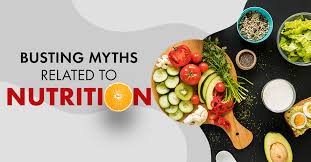
Avoid dairy when you have a cold
FALSE
Milk does not cause mucus production. Due to the creamy texture of milk, some people feel that there is a temporary coating over the mouth and throat after dri
Avoid dairy when you have a cold
FALSE
Milk does not cause mucus production. Due to the creamy texture of milk, some people feel that there is a temporary coating over the mouth and throat after drinking milk. This is not mucus – it’s just the natural sensation of drinking milk and only lasts for a short period of time.
Raw vegetables are always better than cooked vegetables
FALSE
Not always. The amount of nutrients you get from vegetables can differ for a number of reasons, such as how long you store them and how (or if) you cook them. Although cooking vegetables can lose nutrients, cooking can sometimes increase the amount of nutrients available to the body. An example of this is the antioxidant lycopene in tomatoes. Cooking tomatoes releases more lycopene than is available in raw tomatoes. Loss of nutrients can occur in cooking because some vitamins, like Vitamins B and C dissolve in water. Some can be lost if the vegetables are boiled for too long. Steaming or stir-frying helps retain the vitamins when you cook vegetables. The fact of the matter is vegetables are powerhouses of nutrition, no matter which way you eat them. Whether raw or cooked, three to five serves of vegetables a day are recommended in a healthy diet.
Brown sugar is better for you than white sugar
FALSE
The only difference between brown and white sugar is that brown sugar contains molasses, which has a caramel aroma and flavour, while white sugar has been refined to remove the molasses. Both of these sugars provide the same amount of energy (kilojoules), so the truth is that your body can’t really tell the difference.
People with diabetes need to avoid sugar
FALSE
There was a time when people with diabetes were told to avoid eating sugar, but science has since shown that this isn’t necessary. All carbohydrates (eg bread, rice, pasta, starchy vegetables) are broken down to sugar which is absorbed into the blood stream. Rather than avoid sugars, it is important that people with diabetes choose carbohydrates that are slowly broken down, and spread these carbohydrates evenly across the day to help control their blood sugar levels. The best choices are low glycemic index carbohydrates. For eg. Whole bran, oats, brown rice, porridge etc.
Skipping meals is a good way to lose weight
FALSE
It may seem logical that skipping a meal will help you lose weight because you eat less, but it’s not that simple. Missing out on meals can actually have the opposite effect. Your body goes into ‘survival mode’, slowing down your metabolism and conserving energy rather than using it up. Skipping meals can also make you hungrier, and more likely to snack on high fat or sugar foods. A better way to reach and maintain a healthy weight is eat small meals regularly throughout the day and find ways to be more active.
What Is an Avocado?
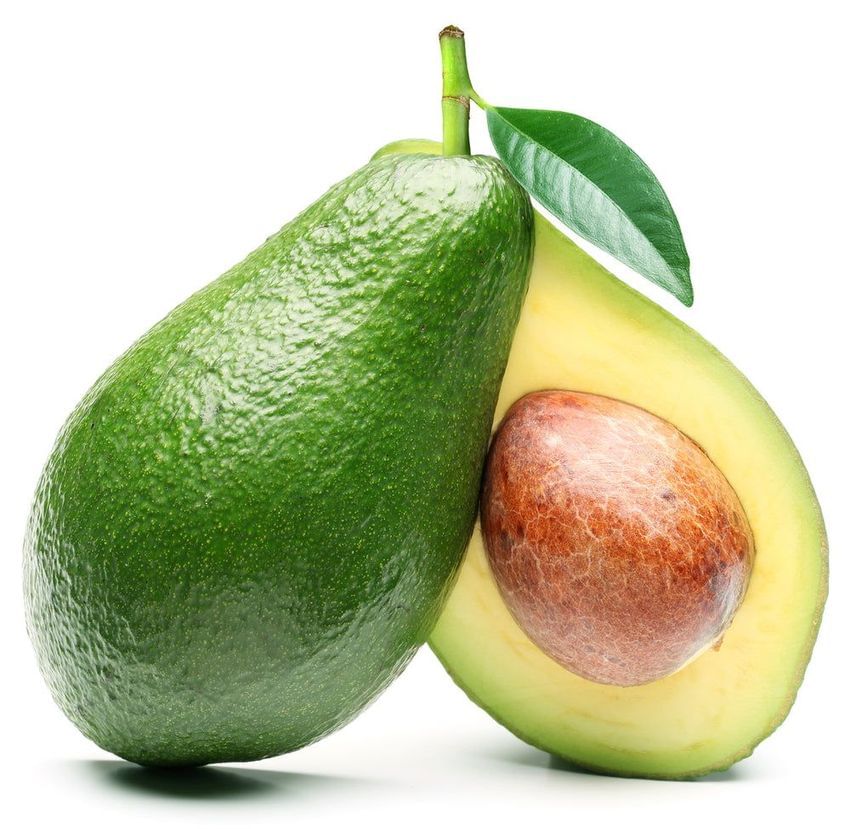
Avocado, alligator pear or avocado pear or butter fruit (Persea americana) is an evergreen tree in the laurel family (Lauraceae). It is native to the Americas and was first domesticated in Mesoamerica
Avocado, alligator pear or avocado pear or butter fruit (Persea americana) is an evergreen tree in the laurel family (Lauraceae). It is native to the Americas and was first domesticated in Mesoamerica more than 5,000 years ago.
100 gm Avocado contains
• 160 calories (kcal)
• 14.7 g of fat
• 8.5 g of carbohydrates
• 6.7 g of fiber
• less than 1 g of sugar
Avocados are a source of vitamins C, E, K, and B6, as well as riboflavin, niacin, folate, pantothenic acid, magnesium, and potassium. They also provide lutein, beta carotene, and omega-3 fatty acids.
Benefits-
1. Healthy for Heart
2. Great for vision
3. Help to prevent Osteoporosis
4. Help to prevent cancer
5. Reducing risk of depression
6. Improving digestion
7. Protecting from chronic diseases like Diabetes, Hypertension, Cardiovascular Disease etc.
100 gm Avocado contains
• 160 calories (kcal)
• 14.7 g of fat
• 8.5 g of carbohydrates
• 6.7 g of fiber
• less than 1 g of sugar
Avocados are a source of vitamins C, E, K, and B6, as well as riboflavin, niacin, folate, pantothenic acid, magnesium, and potassium. They also provide lutein, beta carotene, and omega-3 fatty acids.
Benefits-
1. Healthy for Heart
2. Great for vision
3. Help to prevent Osteoporosis
4. Help to prevent cancer
5. Reducing risk of depression
6. Improving digestion
7. Protecting from chronic diseases like Diabetes, Hypertension, Cardiovascular Disease etc.
Flax Seed
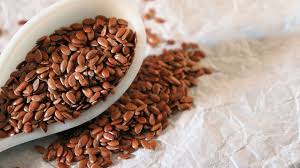
Flax seeds (Linum usitatissimum) — also known as common flax or linseeds — are small oil seeds that originated in the Middle East thousands of years ago.Flax seeds are small oil seeds that contain
Flax seeds (Linum usitatissimum) — also known as common flax or linseeds — are small oil seeds that originated in the Middle East thousands of years ago.Flax seeds are small oil seeds that contain omega-3 fats, fiber, and other plant compounds. They may help improve digestion and reduce the risk of heart disease, type 2 diabetes, and cancer.
One tablespoon (10 grams) of whole flax seeds provides the following nutrients (4Trusted Source):
Calories: 55
Water: 7%
Protein: 1.9 grams
Carbs: 3 grams
Sugar: 0.2 grams
Fiber: 2.8 grams
Fat: 4.3 grams
Health Benefits of flax seed-
1. Diabetes-Studies in people with type 2 diabetes show that supplementing with 10–20 grams of flaxseed powder per day for 1–2 months may reduce fasting blood sugar
2. Cancer-studies show that flax seeds may suppress the formation of several types of cancer, such as those of the colon, breast, skin, and lungs.
3. Heart Disease-Flax seeds are very high in the omega-3 fatty acid alpha-linolenic acid (ALA).They have been shown to decrease heart disease by reducing inflammation in the arteries
4. Blood pressure- Flax seed lower the blood pressure level also
One tablespoon (10 grams) of whole flax seeds provides the following nutrients (4Trusted Source):
Calories: 55
Water: 7%
Protein: 1.9 grams
Carbs: 3 grams
Sugar: 0.2 grams
Fiber: 2.8 grams
Fat: 4.3 grams
Health Benefits of flax seed-
1. Diabetes-Studies in people with type 2 diabetes show that supplementing with 10–20 grams of flaxseed powder per day for 1–2 months may reduce fasting blood sugar
2. Cancer-studies show that flax seeds may suppress the formation of several types of cancer, such as those of the colon, breast, skin, and lungs.
3. Heart Disease-Flax seeds are very high in the omega-3 fatty acid alpha-linolenic acid (ALA).They have been shown to decrease heart disease by reducing inflammation in the arteries
4. Blood pressure- Flax seed lower the blood pressure level also
Pumpkin Seed
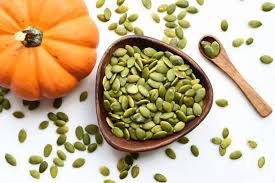
Pumpkin seeds are source of healthy fats, magnesium, and other nutrients that enhance heart and bone health.
They are also rich in polyunsaturated fatty acids and antioxidants such as selenium and be
They are also rich in polyunsaturated fatty acids and antioxidants such as selenium and be
Pumpkin seeds are source of healthy fats, magnesium, and other nutrients that enhance heart and bone health.
They are also rich in polyunsaturated fatty acids and antioxidants such as selenium and beta carotene. Additionally, they are a high source of iron. One cup of pumpkin seeds contains 9.52 milligrams (mg) of iron.
Pumpkin seeds also contain:
zinc
phosphorus
manganese
protein
fiber
Health Benefits-
1. Pumpkin seeds contain magnesium , which is important for bone formation.
2.Helping maintain a moderate , because the individual feels full for longer after eating.
3.Managing blood sugar.
4.Pumpkin seeds have a high source of vitamin E and other antioxidants which help to boost the immunity.
5. Help in digestion.
6.Pumpkin seeds are rich in the amino acid tryptophan, which is help to prevent insomnia.
They are also rich in polyunsaturated fatty acids and antioxidants such as selenium and beta carotene. Additionally, they are a high source of iron. One cup of pumpkin seeds contains 9.52 milligrams (mg) of iron.
Pumpkin seeds also contain:
zinc
phosphorus
manganese
protein
fiber
Health Benefits-
1. Pumpkin seeds contain magnesium , which is important for bone formation.
2.Helping maintain a moderate , because the individual feels full for longer after eating.
3.Managing blood sugar.
4.Pumpkin seeds have a high source of vitamin E and other antioxidants which help to boost the immunity.
5. Help in digestion.
6.Pumpkin seeds are rich in the amino acid tryptophan, which is help to prevent insomnia.
1 Like(s)
Acute Myeloid Leukemia (AML)

What Is Leukemia ?
Leukemias are cancers that start in cells that would normally develop into different types of blood cells. Most often, leukemia starts in early forms of white blood cells, but some
Leukemias are cancers that start in cells that would normally develop into different types of blood cells. Most often, leukemia starts in early forms of white blood cells, but some
What Is Leukemia ?
Leukemias are cancers that start in cells that would normally develop into different types of blood cells. Most often, leukemia starts in early forms of white blood cells, but some leukemias start in other blood cell types. There are several types of leukemia, which are divided based mainly on whether the leukemia is acute (fast growing) or chronic (slower growing), and whether it starts in myeloid cells or lymphoid cells.
What Is Acute Myeloid Leukemia (AML)?
Acute myeloid leukemia (AML) starts in the bone marrow (the soft inner part of certain bones, where new blood cells are made), but most often it quickly moves into the blood, as well. It can sometimes spread to other parts of the body including the lymph nodes, liver, spleen, central nervous system (brain and spinal cord), and testicles.
AML subtypes include:
1. Myeloid leukemia: Cancer in cells that produce neutrophils, a white blood cell. Most people with AML have the myeloid leukemia subtype.
2. Acute monocytic leukemia (AML-M5): Cancer in cells that produce monocytes, a white blood cell.
3. Acute megakaryocytic leukemia (AMLK): Cancer in cells that produce red blood cells or platelets.
4. Acute promyelocytic leukemia (APL): Cancer in promyelocytes (immature white blood cells) that keeps these cells from developing.
What are acute myeloid leukemia symptoms
1. Dizziness.
2. Easy bruising or bleeding, including frequent nosebleeds and bleeding gums.
3. Fatigue.
4. Feeling cold.
5. Fever.
6. Night sweats.
7. Frequent infections or infections that don’t go away.
8. Headaches.
9. Loss of appetite.
10. Unexplained weight loss.
11. Pale skin.
12. Shortness of breath (dyspnea).
13. Swollen lymph nodes.
14. Weakness.
15. Bone, back or abdominal pain.
16. Tiny red spots on your skin (petechiae).
17. Wounds or sores that don’t go away.
Healthy food habit for the prevention of cancer-
It’s important to make sure you’re getting enough
1. Protein ( meat, poultry, fish, tofu, beans, lentils, milk, soy, eggs, yogurt )
2. Healthy fats ( avocado, olives, nuts, seeds, oils )
3. Carbohydrates (bread, rice, potatoes, cereals, barley, millet, oatmeal )
4. vitamin c rich fruits like berries, oranges, sweet lime, Grapes etc.
Leukemias are cancers that start in cells that would normally develop into different types of blood cells. Most often, leukemia starts in early forms of white blood cells, but some leukemias start in other blood cell types. There are several types of leukemia, which are divided based mainly on whether the leukemia is acute (fast growing) or chronic (slower growing), and whether it starts in myeloid cells or lymphoid cells.
What Is Acute Myeloid Leukemia (AML)?
Acute myeloid leukemia (AML) starts in the bone marrow (the soft inner part of certain bones, where new blood cells are made), but most often it quickly moves into the blood, as well. It can sometimes spread to other parts of the body including the lymph nodes, liver, spleen, central nervous system (brain and spinal cord), and testicles.
AML subtypes include:
1. Myeloid leukemia: Cancer in cells that produce neutrophils, a white blood cell. Most people with AML have the myeloid leukemia subtype.
2. Acute monocytic leukemia (AML-M5): Cancer in cells that produce monocytes, a white blood cell.
3. Acute megakaryocytic leukemia (AMLK): Cancer in cells that produce red blood cells or platelets.
4. Acute promyelocytic leukemia (APL): Cancer in promyelocytes (immature white blood cells) that keeps these cells from developing.
What are acute myeloid leukemia symptoms
1. Dizziness.
2. Easy bruising or bleeding, including frequent nosebleeds and bleeding gums.
3. Fatigue.
4. Feeling cold.
5. Fever.
6. Night sweats.
7. Frequent infections or infections that don’t go away.
8. Headaches.
9. Loss of appetite.
10. Unexplained weight loss.
11. Pale skin.
12. Shortness of breath (dyspnea).
13. Swollen lymph nodes.
14. Weakness.
15. Bone, back or abdominal pain.
16. Tiny red spots on your skin (petechiae).
17. Wounds or sores that don’t go away.
Healthy food habit for the prevention of cancer-
It’s important to make sure you’re getting enough
1. Protein ( meat, poultry, fish, tofu, beans, lentils, milk, soy, eggs, yogurt )
2. Healthy fats ( avocado, olives, nuts, seeds, oils )
3. Carbohydrates (bread, rice, potatoes, cereals, barley, millet, oatmeal )
4. vitamin c rich fruits like berries, oranges, sweet lime, Grapes etc.
Mediterranean Diet
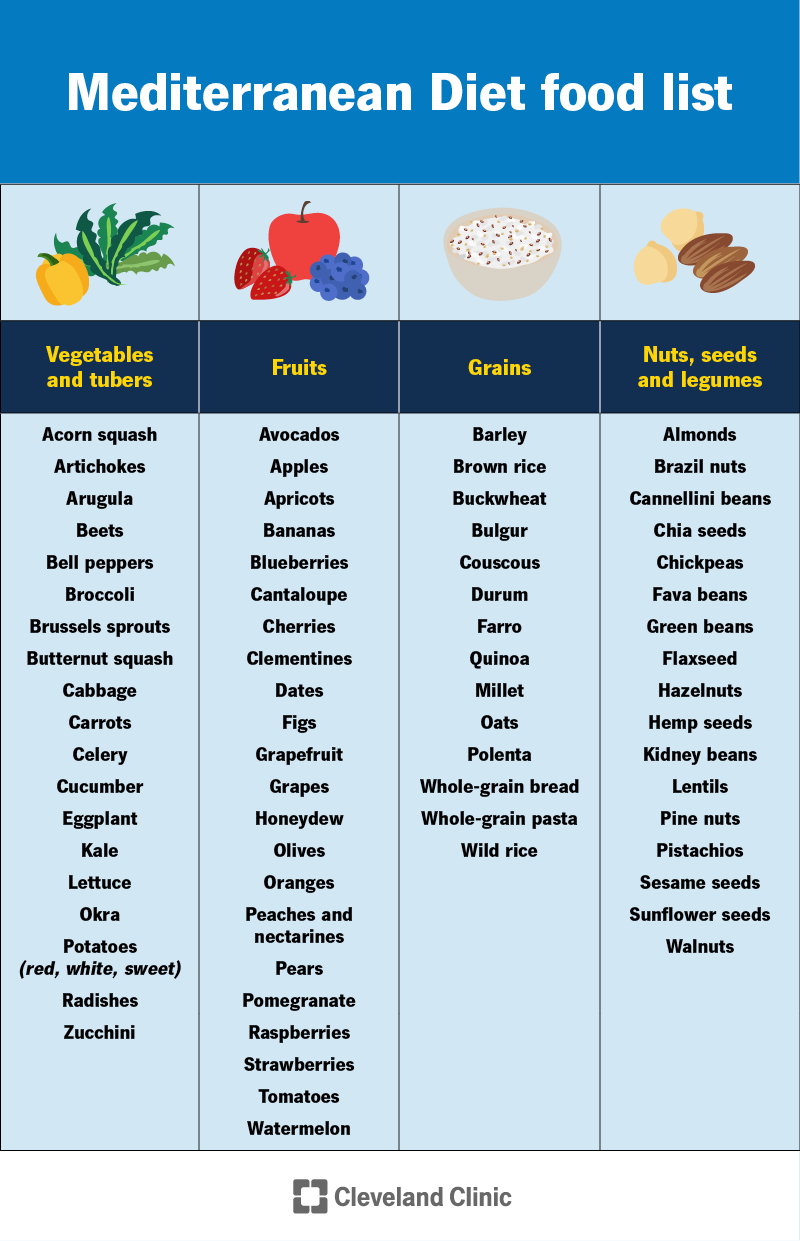
What is the Mediterranean Diet?
The Mediterranean Diet is a way of eating that emphasizes plant-based foods and healthy fats. You focus on overall eating patterns rather than following strict formula
The Mediterranean Diet is a way of eating that emphasizes plant-based foods and healthy fats. You focus on overall eating patterns rather than following strict formula
What is the Mediterranean Diet?
The Mediterranean Diet is a way of eating that emphasizes plant-based foods and healthy fats. You focus on overall eating patterns rather than following strict formulas or calculations.
In general, you’ll eat:
1. Lots of vegetables, fruit, beans, lentils and nuts.
2. A good amount of whole grains, like whole-wheat bread and brown rice.
3. Plenty of extra virgin olive oil (EVOO) as a source of healthy fat.
4. A good amount of fish, especially fish rich in omega-3 fatty acids.
5. A moderate amount of natural cheese and yogurt.
6. Little or no red meat, choosing poultry, fish or beans instead of red meat.
7. Little or no sweets, sugary drinks or butter.
What are the benefits of the Mediterranean Diet?
1. Lowering your risk of cardiovascular disease, including a heart attack or stroke.
2. Supporting a body weight that’s healthy for you.
3. Supporting healthy blood sugar levels, blood pressure and cholesterol.
4. Lowering your risk of metabolic syndrome.
5. Supporting a healthy balance of gut microbiota (bacteria and other microorganisms) in your digestive system.
6. Lowering your risk for certain types of cancer.
The Mediterranean Diet is a way of eating that emphasizes plant-based foods and healthy fats. You focus on overall eating patterns rather than following strict formulas or calculations.
In general, you’ll eat:
1. Lots of vegetables, fruit, beans, lentils and nuts.
2. A good amount of whole grains, like whole-wheat bread and brown rice.
3. Plenty of extra virgin olive oil (EVOO) as a source of healthy fat.
4. A good amount of fish, especially fish rich in omega-3 fatty acids.
5. A moderate amount of natural cheese and yogurt.
6. Little or no red meat, choosing poultry, fish or beans instead of red meat.
7. Little or no sweets, sugary drinks or butter.
What are the benefits of the Mediterranean Diet?
1. Lowering your risk of cardiovascular disease, including a heart attack or stroke.
2. Supporting a body weight that’s healthy for you.
3. Supporting healthy blood sugar levels, blood pressure and cholesterol.
4. Lowering your risk of metabolic syndrome.
5. Supporting a healthy balance of gut microbiota (bacteria and other microorganisms) in your digestive system.
6. Lowering your risk for certain types of cancer.
Chia Seed

What Are Chia Seeds?
Chia seeds (Salvia hispanica), also called Salba chia or Mexican chia, are the edible seeds of a flowering plant from the mint family.
Chia Seeds Nutrition
Chia seeds provide
Chia seeds (Salvia hispanica), also called Salba chia or Mexican chia, are the edible seeds of a flowering plant from the mint family.
Chia Seeds Nutrition
Chia seeds provide
What Are Chia Seeds?
Chia seeds (Salvia hispanica), also called Salba chia or Mexican chia, are the edible seeds of a flowering plant from the mint family.
Chia Seeds Nutrition
Chia seeds provide many essential nutrients, including:
Calcium
Manganese
Magnesium
Selenium
Copper
Iron
Phosphorus
Chia seeds are also an incredible source of alpha-linoleic acid (ALA), an omega-3 fatty acid that helps to promote a lower ratio of omega-6 to omega-3 fatty acids.
1-ounce serving (28.35 grams) of chia seeds has:
Calories: 138
Protein: 4.7 grams
Fat: 8.7 grams
Carbohydrates: 12 grams
Fiber: 9.8 grams
Sugar: 0 grams
Health benefits of chia seed-
1. Reducing blood pressure
2. lowering cholesterol level
3. Supporting digestive health
4. Help to reduce weight
5. Reducing inflammation
6. Help to control diabetes
7. Protect against chronic diseases
8. Improving anxiety and depression
Chia seeds (Salvia hispanica), also called Salba chia or Mexican chia, are the edible seeds of a flowering plant from the mint family.
Chia Seeds Nutrition
Chia seeds provide many essential nutrients, including:
Calcium
Manganese
Magnesium
Selenium
Copper
Iron
Phosphorus
Chia seeds are also an incredible source of alpha-linoleic acid (ALA), an omega-3 fatty acid that helps to promote a lower ratio of omega-6 to omega-3 fatty acids.
1-ounce serving (28.35 grams) of chia seeds has:
Calories: 138
Protein: 4.7 grams
Fat: 8.7 grams
Carbohydrates: 12 grams
Fiber: 9.8 grams
Sugar: 0 grams
Health benefits of chia seed-
1. Reducing blood pressure
2. lowering cholesterol level
3. Supporting digestive health
4. Help to reduce weight
5. Reducing inflammation
6. Help to control diabetes
7. Protect against chronic diseases
8. Improving anxiety and depression
Diet and Mental Health
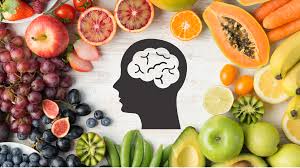
How diet and Mental Health Linked?
The relationship between our diet and mental Health is complex.
1. Eat well can help to feel better.
2. Eat regularly- This can stop blood sugar level from dropp
The relationship between our diet and mental Health is complex.
1. Eat well can help to feel better.
2. Eat regularly- This can stop blood sugar level from dropp
How diet and Mental Health Linked?
The relationship between our diet and mental Health is complex.
1. Eat well can help to feel better.
2. Eat regularly- This can stop blood sugar level from dropping, which make feel tired and bad-tempered
3. Stay hydrated, even mild hydration can affect mood, energy level and ability to concentrate.
4. Need to eat balanced fat because brain need healthy fat for working well. They are found in olive oil, nuts, seeds, oily fish,avocados,milk and eggs.avoid
trans fats found is processed food that can bad for brain and heart.
5. Need to include more fruits and vegetables in your diet as they help the brain and body to stay well.
6. Need to include protein in diet because protein contains amino acid that is uses by brain and help to regulate mood.
7. Need to include healthy food for gut such as fruits, vegetables,beans and probiotics because it can reflect on mental health.
8. Be aware of caffeine found in such as coffee, tea, cola. energy drinks and chocolates that can cause sleep problems if you drink it close to bed time. That can
also hamper mental health.
So, think about it before take food.
The relationship between our diet and mental Health is complex.
1. Eat well can help to feel better.
2. Eat regularly- This can stop blood sugar level from dropping, which make feel tired and bad-tempered
3. Stay hydrated, even mild hydration can affect mood, energy level and ability to concentrate.
4. Need to eat balanced fat because brain need healthy fat for working well. They are found in olive oil, nuts, seeds, oily fish,avocados,milk and eggs.avoid
trans fats found is processed food that can bad for brain and heart.
5. Need to include more fruits and vegetables in your diet as they help the brain and body to stay well.
6. Need to include protein in diet because protein contains amino acid that is uses by brain and help to regulate mood.
7. Need to include healthy food for gut such as fruits, vegetables,beans and probiotics because it can reflect on mental health.
8. Be aware of caffeine found in such as coffee, tea, cola. energy drinks and chocolates that can cause sleep problems if you drink it close to bed time. That can
also hamper mental health.
So, think about it before take food.
Spinach
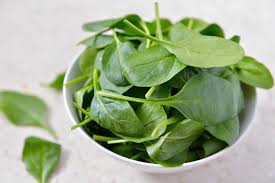
What is spinach?
Spinach belongs to the Chenopodiaceae family (also known as goosefoot), which includes beetroot, chard and quinoa. It shares a similar taste profile with these vegetables – the bit
Spinach belongs to the Chenopodiaceae family (also known as goosefoot), which includes beetroot, chard and quinoa. It shares a similar taste profile with these vegetables – the bit
What is spinach?
Spinach belongs to the Chenopodiaceae family (also known as goosefoot), which includes beetroot, chard and quinoa. It shares a similar taste profile with these vegetables – the bitterness of beet greens and the slightly salty flavour of chard. There are three different types of spinach: savoy, semi-savoy and smooth leaf.
One cup of raw spinach contains:
7 calories
0.86 g of protein
29.7 mg of calcium
0.81 g of iron
24 mg of magnesium
167 mg of potassium
141 micrograms (mcg) of vitamin A
58 mcg of folate
Spinach also contains vitamin K, fiber, phosphorus, and thiamine. Most of the calories in this vegetable come from protein and carbohydrates.
Spinach health benefits include:
• May help maintain good vision
• May support energy levels
• May support heart health
• May support healthy bones
• May help in our fight against cancer
• Has protective antioxidant properties
• Useful source of fibre
• May help weight management
• may reduce the adverse effects of a high-fat diet
• May support mental health
Spinach belongs to the Chenopodiaceae family (also known as goosefoot), which includes beetroot, chard and quinoa. It shares a similar taste profile with these vegetables – the bitterness of beet greens and the slightly salty flavour of chard. There are three different types of spinach: savoy, semi-savoy and smooth leaf.
One cup of raw spinach contains:
7 calories
0.86 g of protein
29.7 mg of calcium
0.81 g of iron
24 mg of magnesium
167 mg of potassium
141 micrograms (mcg) of vitamin A
58 mcg of folate
Spinach also contains vitamin K, fiber, phosphorus, and thiamine. Most of the calories in this vegetable come from protein and carbohydrates.
Spinach health benefits include:
• May help maintain good vision
• May support energy levels
• May support heart health
• May support healthy bones
• May help in our fight against cancer
• Has protective antioxidant properties
• Useful source of fibre
• May help weight management
• may reduce the adverse effects of a high-fat diet
• May support mental health
Sunflower seed
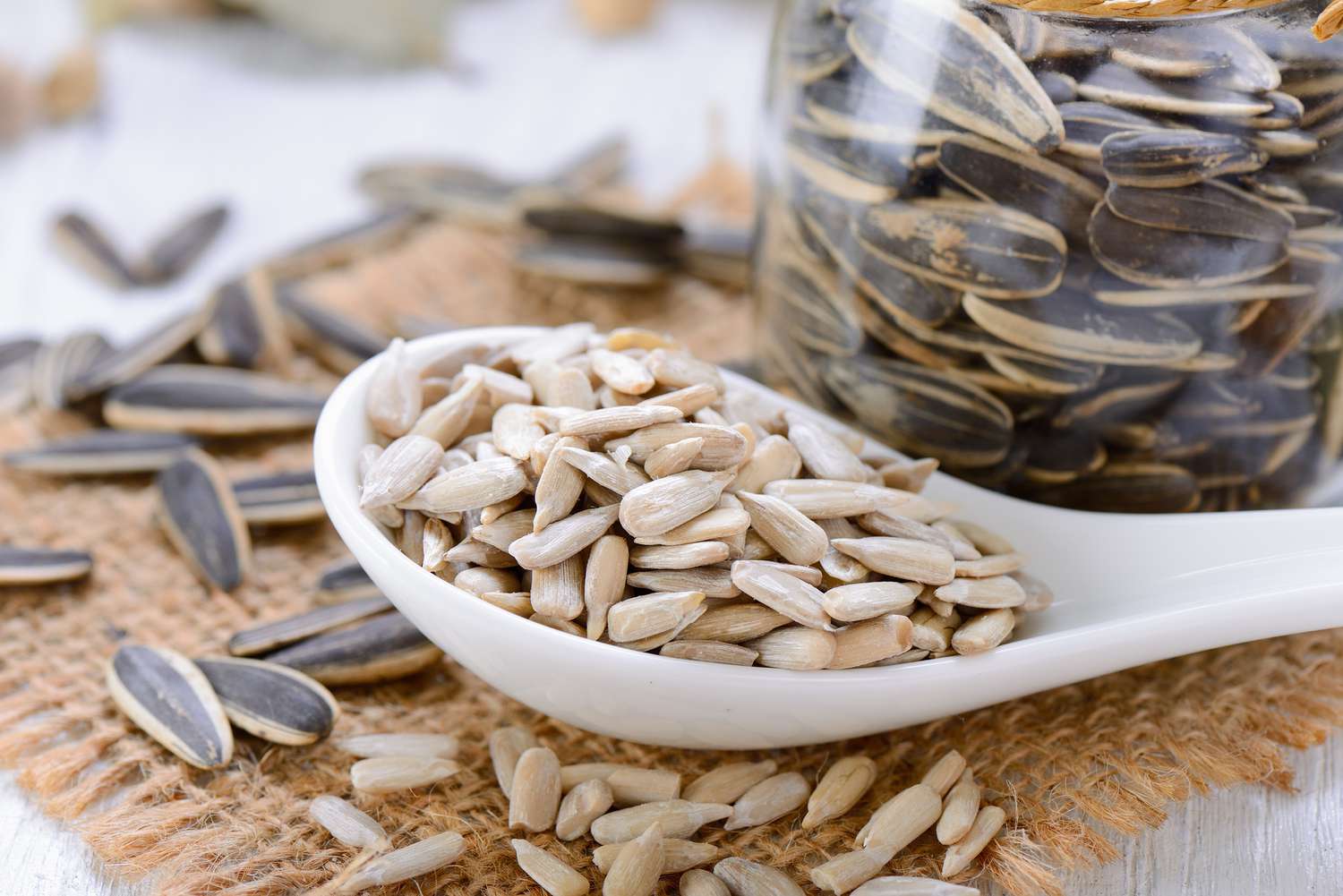
Sunflower seeds come from the sunflower (Helianthus annuus). Most farmed sunflowers go to sunflower oil production, with only certain varieties raised for eating.
Health benefits of sunflower seeds
Health benefits of sunflower seeds
Sunflower seeds come from the sunflower (Helianthus annuus). Most farmed sunflowers go to sunflower oil production, with only certain varieties raised for eating.
Health benefits of sunflower seeds-
They contain nutrients that fight
1.cancer
2. Lower your risk of heart disease,
3. Balance blood sugar
4. Support thyroid health and lower inflammation.
Sunflower seeds are an excellent source of antioxidants like
1. vitamin E
2.Healthy fats
3. B vitamins
4. Copper and other minerals.
5. Flavonoids.
28.35 grams or 1/4 cup of shelled, dry roasted sunflower seeds are:
Calories: 165
Total fat: 14.1 grams
Protein: 5.5 grams
Carbs: 6.8 grams
Fiber: 3.2 grams
Health benefits of sunflower seeds-
They contain nutrients that fight
1.cancer
2. Lower your risk of heart disease,
3. Balance blood sugar
4. Support thyroid health and lower inflammation.
Sunflower seeds are an excellent source of antioxidants like
1. vitamin E
2.Healthy fats
3. B vitamins
4. Copper and other minerals.
5. Flavonoids.
28.35 grams or 1/4 cup of shelled, dry roasted sunflower seeds are:
Calories: 165
Total fat: 14.1 grams
Protein: 5.5 grams
Carbs: 6.8 grams
Fiber: 3.2 grams
Relationship Between Diet And Exercise
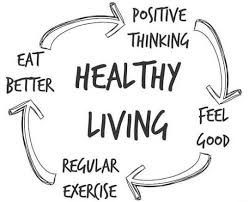
Eating a balanced diet and being physically fit are two components of body and mind. As our energy is sourced from a balanced plate of food, nutrition plays an essential role in our physical fitness t
Eating a balanced diet and being physically fit are two components of body and mind. As our energy is sourced from a balanced plate of food, nutrition plays an essential role in our physical fitness too. Without nutritious food, physical fitness cannot be achieved. Food is the fuel of our body. Food with high nutritional content boosts our stamina and helps us exercise better. It is scientifically proven that nutrition can help you enhance your physical health, athletic performance, and fitness. Keep reading to find out more about the role of nutrition in physical fitness.
Poor nutrition can hinder growth and development, while excessive calorie consumption can lead to obesity, especially when paired with too little physical activity. Inadequate physical activity also contributes to increased risk of conditions such as coronary heart disease, diabetes, and some cancers.When performed routinely, exercise has been shown to lower symptoms of depression, reduce risk of chronic disease and premature death, and delay age-related cognitive decline.
Together with exercise, eating a healthy diet can also help you to lower your cholesterol levels and blood pressure and decrease your risk of type 2 diabetes.
"So, Exercise Daily, Eat healthy and stay Healthy"
Poor nutrition can hinder growth and development, while excessive calorie consumption can lead to obesity, especially when paired with too little physical activity. Inadequate physical activity also contributes to increased risk of conditions such as coronary heart disease, diabetes, and some cancers.When performed routinely, exercise has been shown to lower symptoms of depression, reduce risk of chronic disease and premature death, and delay age-related cognitive decline.
Together with exercise, eating a healthy diet can also help you to lower your cholesterol levels and blood pressure and decrease your risk of type 2 diabetes.
"So, Exercise Daily, Eat healthy and stay Healthy"
Breast Cancer
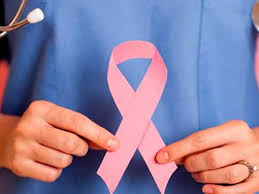
Breast cancer is a disease in which abnormal breast cells grow out of control and form tumors. If left unchecked, the tumors can spread throughout the body and become fatal. Breast cancer cells begin
Breast cancer is a disease in which abnormal breast cells grow out of control and form tumors. If left unchecked, the tumors can spread throughout the body and become fatal. Breast cancer cells begin inside the milk ducts and/or the milk-producing lobules of the breast. The earliest form (in situ) is not life-threatening and can be detected in early stages. Cancer cells can spread into nearby breast tissue (invasion). This creates tumors that cause lumps or thickening.
Symptoms-
Some warning signs of breast cancer are:
New lump in the breast or underarm (armpit).
Thickening or swelling of part of the breast.
Irritation or dimpling of breast skin.
Redness or flaky skin in the nipple area or the breast.
Pulling in of the nipple or pain in the nipple area.
Nipple discharge other than breast milk, including blood.
Any change in the size or the shape of the breast.
Pain in any area of the breast.
Diet-
1. Eat small and frequent meal through out the day
2. Choose protein rich foods like soybeans, nuts, mushroom and paneer in diet
3. Include whole grain foods like Oatmeal, whole wheat breads, Brown rice etc.
4. Eat variety of fruits and vegetables
5. Choose sources of healthy fats
Symptoms-
Some warning signs of breast cancer are:
New lump in the breast or underarm (armpit).
Thickening or swelling of part of the breast.
Irritation or dimpling of breast skin.
Redness or flaky skin in the nipple area or the breast.
Pulling in of the nipple or pain in the nipple area.
Nipple discharge other than breast milk, including blood.
Any change in the size or the shape of the breast.
Pain in any area of the breast.
Diet-
1. Eat small and frequent meal through out the day
2. Choose protein rich foods like soybeans, nuts, mushroom and paneer in diet
3. Include whole grain foods like Oatmeal, whole wheat breads, Brown rice etc.
4. Eat variety of fruits and vegetables
5. Choose sources of healthy fats
Paleo Diet
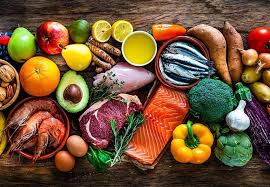
The paleo diet includes whole, unprocessed foods like vegetables, nuts, seeds, and meat. It may benefit your overall health and reduce your risk for some health conditions, including obesity.
The key
The key
The paleo diet includes whole, unprocessed foods like vegetables, nuts, seeds, and meat. It may benefit your overall health and reduce your risk for some health conditions, including obesity.
The key principles of the Paleo diet include:
1. Focus on whole, unprocessed foods. The diet emphasizes foods that were likely available to our ancestors, such as lean meats, fish, fruits, vegetables, nuts, and seeds.
2. Avoid processed foods. Foods that are highly processed, such as grains, legumes, dairy products, and refined sugars, are generally avoided.
3. Prioritize nutrient-dense foods. The emphasis is on consuming foods that are rich in nutrients, such as vitamins, minerals, and antioxidants.
4. Limit added sugars and unhealthy fats. The diet encourages cutting back on added sugars and unhealthy fats, which are often found in processed foods.
The key principles of the Paleo diet include:
1. Focus on whole, unprocessed foods. The diet emphasizes foods that were likely available to our ancestors, such as lean meats, fish, fruits, vegetables, nuts, and seeds.
2. Avoid processed foods. Foods that are highly processed, such as grains, legumes, dairy products, and refined sugars, are generally avoided.
3. Prioritize nutrient-dense foods. The emphasis is on consuming foods that are rich in nutrients, such as vitamins, minerals, and antioxidants.
4. Limit added sugars and unhealthy fats. The diet encourages cutting back on added sugars and unhealthy fats, which are often found in processed foods.
Myocardial Infarction
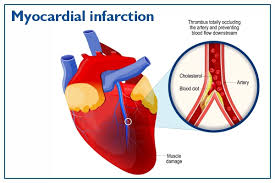
A heart attack (myocardial infarction) is an extremely dangerous condition that happens because you don’t have enough blood flow to some of your heart muscle.This lack of blood flow can occur becaus
A heart attack (myocardial infarction) is an extremely dangerous condition that happens because you don’t have enough blood flow to some of your heart muscle.This lack of blood flow can occur because of many different factors but is usually related to a blockage in one or more of your heart’s arteries.
Symptoms-
Chest pain (angina).
Shortness of breath or trouble breathing.
Trouble sleeping (insomnia).
Nausea or stomach discomfort.
Heart palpitations.
Anxiety or a feeling of “impending doom.”
Feeling lightheaded, dizzy or passing out
The plan should include plenty of lean protein, vegetables, fruits and whole grains. Limit high-fat foods such as red meat, cheese and baked goods. Also limit foods that are high in sodium such as sandwiches, pizza, soup and processed foods. Cut back on foods and drinks with added sugar too.
Symptoms-
Chest pain (angina).
Shortness of breath or trouble breathing.
Trouble sleeping (insomnia).
Nausea or stomach discomfort.
Heart palpitations.
Anxiety or a feeling of “impending doom.”
Feeling lightheaded, dizzy or passing out
The plan should include plenty of lean protein, vegetables, fruits and whole grains. Limit high-fat foods such as red meat, cheese and baked goods. Also limit foods that are high in sodium such as sandwiches, pizza, soup and processed foods. Cut back on foods and drinks with added sugar too.
Celiac Disease
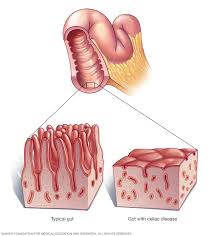
Celiac disease is an illness caused by an immune reaction to eating gluten. Gluten is a protein found in foods containing wheat, barley or rye. If you have celiac disease, eating gluten triggers an im
Celiac disease is an illness caused by an immune reaction to eating gluten. Gluten is a protein found in foods containing wheat, barley or rye. If you have celiac disease, eating gluten triggers an immune response to the gluten protein in your small intestine. Over time, this reaction damages your small intestine's lining and prevents it from absorbing nutrients, a condition called malabsorption. There's no definite cure for celiac disease. But for most people, following a strict gluten-free diet can help manage symptoms and help the intestines heal.
Symtoms-
• Diarrhea.
• Fatigue.
• Weight loss.
• Bloating and gas.
• Abdominal pain.
• Nausea and vomiting.
• Constipation
Diet-
A strict, lifelong gluten-free diet is the only way to manage celiac disease.
1. stay away from all products with barley, rye, triticale (a cross between wheat and rye), farina, graham flour, semolina, and any other kind of flour. This includes self-rising and durum
not labeled gluten-free.
2. Be careful with corn and rice products. These don’t have gluten, but they can sometimes be contaminated with wheat gluten. This can happen if they're processed in factories that
also make wheat products. Look for such a warning on the package label.
3. Go with oats. Recent studies suggest you can eat oats if they are not contaminated with wheat gluten during processing. Check with your healthcare provider first.
4. Use potato, rice, soy, amaranth, quinoa, buckwheat, nut, or bean flour instead of wheat flour. You can also use sorghum, chickpea or Bengal gram, arrowroot, and corn flour. T
tapioca starch extract is another choice. These act as thickeners and can be used for leavening.
Symtoms-
• Diarrhea.
• Fatigue.
• Weight loss.
• Bloating and gas.
• Abdominal pain.
• Nausea and vomiting.
• Constipation
Diet-
A strict, lifelong gluten-free diet is the only way to manage celiac disease.
1. stay away from all products with barley, rye, triticale (a cross between wheat and rye), farina, graham flour, semolina, and any other kind of flour. This includes self-rising and durum
not labeled gluten-free.
2. Be careful with corn and rice products. These don’t have gluten, but they can sometimes be contaminated with wheat gluten. This can happen if they're processed in factories that
also make wheat products. Look for such a warning on the package label.
3. Go with oats. Recent studies suggest you can eat oats if they are not contaminated with wheat gluten during processing. Check with your healthcare provider first.
4. Use potato, rice, soy, amaranth, quinoa, buckwheat, nut, or bean flour instead of wheat flour. You can also use sorghum, chickpea or Bengal gram, arrowroot, and corn flour. T
tapioca starch extract is another choice. These act as thickeners and can be used for leavening.
Alzheimer’s disease
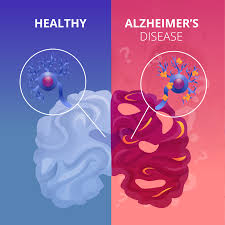
What is Alzheimer’s disease?
Alzheimer’s disease (pronounced “alz-HAI-mirs”) is a brain condition that causes a progressive decline in memory, thinking, learning and organizing skills. It eve
Alzheimer’s disease (pronounced “alz-HAI-mirs”) is a brain condition that causes a progressive decline in memory, thinking, learning and organizing skills. It eve
What is Alzheimer’s disease?
Alzheimer’s disease (pronounced “alz-HAI-mirs”) is a brain condition that causes a progressive decline in memory, thinking, learning and organizing skills. It eventually affects a person’s ability to carry out basic daily activities. Alzheimer’s disease (AD) is the most common cause of dementia.
Signs and Symptoms-
1. Memory.
2. Reasoning and handling of complex tasks.
3. Language.
4. Understanding visual form and space relationship.
5. Behavior and personality.
Diet-
1.Eat a variety of foods, especially fruits and vegetables, whole grains, lean protein, and low-fat dairy.
2.Keep a healthy weight. Proper portion sizes and exercise are a key part of this, too.
3.Limit foods with high saturated fat and cholesterol, like fatty meats and fried foods.
4.Cut down on sugar.
5.Avoid eating too much salt.
6.Drink plenty of water.
Alzheimer’s disease (pronounced “alz-HAI-mirs”) is a brain condition that causes a progressive decline in memory, thinking, learning and organizing skills. It eventually affects a person’s ability to carry out basic daily activities. Alzheimer’s disease (AD) is the most common cause of dementia.
Signs and Symptoms-
1. Memory.
2. Reasoning and handling of complex tasks.
3. Language.
4. Understanding visual form and space relationship.
5. Behavior and personality.
Diet-
1.Eat a variety of foods, especially fruits and vegetables, whole grains, lean protein, and low-fat dairy.
2.Keep a healthy weight. Proper portion sizes and exercise are a key part of this, too.
3.Limit foods with high saturated fat and cholesterol, like fatty meats and fried foods.
4.Cut down on sugar.
5.Avoid eating too much salt.
6.Drink plenty of water.
Motor neurone disease (MND)
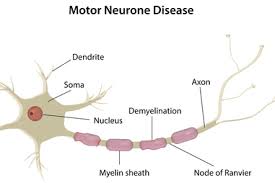
What is MND?
Motor neurone disease (MND) is the name for a group of diseases that affect nerves known as motor nerves, or motor neurons. Your motor nerves carry messages from your brain to your muscl
Motor neurone disease (MND) is the name for a group of diseases that affect nerves known as motor nerves, or motor neurons. Your motor nerves carry messages from your brain to your muscl
What is MND?
Motor neurone disease (MND) is the name for a group of diseases that affect nerves known as motor nerves, or motor neurons. Your motor nerves carry messages from your brain to your muscles via your spinal cord. These messages allow you to move, swallow, talk and breathe. In MND, these motor neurons become damaged and die. Messages can no longer travel between your brain and muscles. This causes your muscles to become weaker and weaker. This eventually causes paralysis.
The MND disease group includes the following diseases:
Amyotrophic lateral sclerosis (ALS), also known as Lou Gehrig's disease
Progressive muscular atrophy (PMA)
Progressive bulbar palsy (PBP)
Primary lateral sclerosis (PLS)
Kennedy's disease, also known as spinal and bulbar muscular atrophy (SBMA)
What are the symptoms of MND?
Your first symptoms of MND that you notice can be mild, such as:
1.Stumbling because of weakness in your leg muscles
2.Difficulty holding and gripping objects because of weakness in your hand muscles
3.Slurred speech and swallowing difficulties because of weakness of your tongue and throat muscles
4.cramps and muscle twitching.
This is a non curable disease. But by giving some healthy diet we can help the patients.
Motor neurone disease (MND) is the name for a group of diseases that affect nerves known as motor nerves, or motor neurons. Your motor nerves carry messages from your brain to your muscles via your spinal cord. These messages allow you to move, swallow, talk and breathe. In MND, these motor neurons become damaged and die. Messages can no longer travel between your brain and muscles. This causes your muscles to become weaker and weaker. This eventually causes paralysis.
The MND disease group includes the following diseases:
Amyotrophic lateral sclerosis (ALS), also known as Lou Gehrig's disease
Progressive muscular atrophy (PMA)
Progressive bulbar palsy (PBP)
Primary lateral sclerosis (PLS)
Kennedy's disease, also known as spinal and bulbar muscular atrophy (SBMA)
What are the symptoms of MND?
Your first symptoms of MND that you notice can be mild, such as:
1.Stumbling because of weakness in your leg muscles
2.Difficulty holding and gripping objects because of weakness in your hand muscles
3.Slurred speech and swallowing difficulties because of weakness of your tongue and throat muscles
4.cramps and muscle twitching.
This is a non curable disease. But by giving some healthy diet we can help the patients.
UNDERSTANDING THE GUT MICROBIOME: THE KEY TO YOUR OVERALL HEALTH
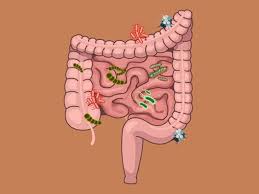
The gut microbiome consists of trillions of microorganisms that live in our intestines and regulate nearly every aspect of our health. Bacteria, viruses, and fungi are some of the microorganisms cruci
The gut microbiome consists of trillions of microorganisms that live in our intestines and regulate nearly every aspect of our health. Bacteria, viruses, and fungi are some of the microorganisms crucial for digestion, as they can break down and synthesize nutrients that our bodies need while also helping us absorb vitamins and minerals. The gut microbiome, part of the immune system, allows your body to put up a fight with any pathogen that may enter your body; it also balances the immune response.
TYPES OF GUT BACTERIA ANALYZED:
1. Lactobacillus: Important for aiding digestion and inhibiting harmful bacteria.
2. Bifidobacterium: Supports the immune system and helps break down food.
3. Escherichia coli (E. coli): While some strains can cause illness, many are harmless and contribute to vitamin K production.
4. Clostridium: Plays a role in breaking down complex carbohydrates, though some species can produce toxins.
5. Firmicutes: Helps in the absorption of fats and energy regulation.
6. Bacteroidetes: Vital for digesting complex molecules and maintaining gut health.
7. Enterococcus: Assists in breaking down food and vitamin production but can cause infections if overgrown.
8. Streptococcus: Many species are benign and contribute to nutrient absorption despite their association with infections
KEY NUTRIENTS AND FOODS FOR A HEALTHY MICROBIOME-
1. Prebiotics and Probiotics:
A. Prebiotic Foods (Fiber-Rich Foods): Prebiotics are types of fiber that feed the friendly bacteria in your gut. Some fiber-rich foods that are great sources of
prebiotics include:
Onions, Garlic, Leeks, Asparagus, Barley, Oats
B. Probiotic Foods (Fermented Foods): Probiotics are live bacteria and yeasts that are beneficial for your digestive system. Foods that are rich in probiotics
include:
Yogurt, Kefir, Sauerkraut, Kimchi, Miso, Kombucha, Tempeh, Pickles (fermented)
2.Fiber and antioxidant-
A. Fiber’s Role in Digestion: To ensure your stomach undergoes healthy digestion, it is important to feed it fiber-rich foods. It helps to keep the digestive
system running smoothly by promoting regular bowel movements and preventing constipation.
Legumes: Beans, lentils, and chickpeas are excellent sources of dietary fiber.
Whole Grains: Oats, brown rice, and whole wheat provide substantial amounts of fiber.
Fruits: Apples, pears, and berries are rich in both soluble and insoluble fiber.
Vegetables: Broccoli, carrots, and leafy greens offer high fiber content.
B. Antioxidant-rich foods for gut health: Antioxidants help to protect your cells from damage and support overall health, including gut health. Some
antioxidant-rich foods that are beneficial for the gut include:
Berries (such as blueberries, strawberries, and raspberries), Green tea, Dark chocolate, Nuts and seeds (such as almonds and flaxseeds),Leafy greens (such as
spinach and kale)
LIFESTYLE FACTORS THAT INFLUENCE GUT HEALTH
The gut microbiome is important if you wish to maintain a well-balanced diet. What you feed yourself can make a large difference in the diversity and activity of the microorganisms in your gut. Diverse, nutrient-dense foods will help to support a strongly associated microbiome, which will help strengthen your health.So it is important to eat food that contains both prebiotics and probiotics. Foods rich in prebiotic substances like fiber, which may come from fruits, vegetables, and whole grains, are just what your gut’s bugs need to thrive and do their jobs. Probiotic foods, including yogurt, kefir, and fermented vegetables, play the role of live beneficial bacteria in your gut that help to balance healthy microorganisms.
On the other hand, a diet rich in processed food, sugars, and unhealthy fats can upset the equilibrium of your gut microbiome, resulting in fewer beneficial bacteria and more harmful bacteria.
TYPES OF GUT BACTERIA ANALYZED:
1. Lactobacillus: Important for aiding digestion and inhibiting harmful bacteria.
2. Bifidobacterium: Supports the immune system and helps break down food.
3. Escherichia coli (E. coli): While some strains can cause illness, many are harmless and contribute to vitamin K production.
4. Clostridium: Plays a role in breaking down complex carbohydrates, though some species can produce toxins.
5. Firmicutes: Helps in the absorption of fats and energy regulation.
6. Bacteroidetes: Vital for digesting complex molecules and maintaining gut health.
7. Enterococcus: Assists in breaking down food and vitamin production but can cause infections if overgrown.
8. Streptococcus: Many species are benign and contribute to nutrient absorption despite their association with infections
KEY NUTRIENTS AND FOODS FOR A HEALTHY MICROBIOME-
1. Prebiotics and Probiotics:
A. Prebiotic Foods (Fiber-Rich Foods): Prebiotics are types of fiber that feed the friendly bacteria in your gut. Some fiber-rich foods that are great sources of
prebiotics include:
Onions, Garlic, Leeks, Asparagus, Barley, Oats
B. Probiotic Foods (Fermented Foods): Probiotics are live bacteria and yeasts that are beneficial for your digestive system. Foods that are rich in probiotics
include:
Yogurt, Kefir, Sauerkraut, Kimchi, Miso, Kombucha, Tempeh, Pickles (fermented)
2.Fiber and antioxidant-
A. Fiber’s Role in Digestion: To ensure your stomach undergoes healthy digestion, it is important to feed it fiber-rich foods. It helps to keep the digestive
system running smoothly by promoting regular bowel movements and preventing constipation.
Legumes: Beans, lentils, and chickpeas are excellent sources of dietary fiber.
Whole Grains: Oats, brown rice, and whole wheat provide substantial amounts of fiber.
Fruits: Apples, pears, and berries are rich in both soluble and insoluble fiber.
Vegetables: Broccoli, carrots, and leafy greens offer high fiber content.
B. Antioxidant-rich foods for gut health: Antioxidants help to protect your cells from damage and support overall health, including gut health. Some
antioxidant-rich foods that are beneficial for the gut include:
Berries (such as blueberries, strawberries, and raspberries), Green tea, Dark chocolate, Nuts and seeds (such as almonds and flaxseeds),Leafy greens (such as
spinach and kale)
LIFESTYLE FACTORS THAT INFLUENCE GUT HEALTH
The gut microbiome is important if you wish to maintain a well-balanced diet. What you feed yourself can make a large difference in the diversity and activity of the microorganisms in your gut. Diverse, nutrient-dense foods will help to support a strongly associated microbiome, which will help strengthen your health.So it is important to eat food that contains both prebiotics and probiotics. Foods rich in prebiotic substances like fiber, which may come from fruits, vegetables, and whole grains, are just what your gut’s bugs need to thrive and do their jobs. Probiotic foods, including yogurt, kefir, and fermented vegetables, play the role of live beneficial bacteria in your gut that help to balance healthy microorganisms.
On the other hand, a diet rich in processed food, sugars, and unhealthy fats can upset the equilibrium of your gut microbiome, resulting in fewer beneficial bacteria and more harmful bacteria.
Anti- Aging Superfood
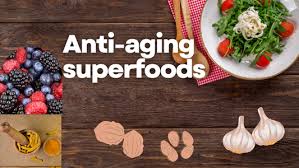
Eating a diet rich in nutritious foods can contribute to healthy aging. While there are no specific "anti-aging superfoods" that can magically turn back the clock, consuming a variety of nutrient-dens
Eating a diet rich in nutritious foods can contribute to healthy aging. While there are no specific "anti-aging superfoods" that can magically turn back the clock, consuming a variety of nutrient-dense foods in the morning can help support overall well-being and promote healthy aging. Here are some foods to consider including in routine:
1. Berries: Blueberries, strawberries, and raspberries are packed with antioxidants that may help protect your cells from damage and support brain health.
2. Oats: Oatmeal is a great source of complex carbohydrates and fiber, which can help stabilize blood sugar levels and keep you full throughout the
morning.
3. Nuts and Seeds: Almonds, walnuts, and flaxseeds provide healthy fats, fiber, and essential nutrients. They can support heart health and brain function.
4. Fresh Curd: Homemade curd is high in protein and probiotics and can promote gut health and support your immune system.
6. Eggs: Eggs are a good source of protein and important nutrients like choline, which is beneficial for brain health.
7. Green Tea: Green tea is rich in antioxidants, particularly EGCG, which may have anti-aging properties and support metabolism.
8. Spinach and Fenugreek: Leafy greens like spinach and fenugreek are packed with vitamins, minerals, and antioxidants that can support your overall
health.
9. Turmeric: This spice contains curcumin, which has anti-inflammatory properties and may help with joint health.
10. Tomatoes and carrots: Tomatoes and carrots are high in lycopene, an antioxidant that may protect your skin from UV damage and reduce the risk of
certain age-related diseases. Carrots are also a rich source of Vitamin A, beta carotene and eye healthy antioxidants lutein and lycopene.
11. Lemon and Oranges: Citrus fruits like lemon and oranges are rich in vitamin C, which can support skin health and boost your immune system.
12. Garlic: Garlic cloves have cholesterol-lowering, antihypertensive, antimicrobial, and anticancer qualities.
Remember to maintain a well-balanced diet that includes a variety of foods. While these morning superfoods are beneficial, overall dietary habits and lifestyle choices also play a significant role in the aging process. Staying hydrated, getting regular exercise, managing stress, and getting adequate sleep are equally important for healthy aging.
1. Berries: Blueberries, strawberries, and raspberries are packed with antioxidants that may help protect your cells from damage and support brain health.
2. Oats: Oatmeal is a great source of complex carbohydrates and fiber, which can help stabilize blood sugar levels and keep you full throughout the
morning.
3. Nuts and Seeds: Almonds, walnuts, and flaxseeds provide healthy fats, fiber, and essential nutrients. They can support heart health and brain function.
4. Fresh Curd: Homemade curd is high in protein and probiotics and can promote gut health and support your immune system.
6. Eggs: Eggs are a good source of protein and important nutrients like choline, which is beneficial for brain health.
7. Green Tea: Green tea is rich in antioxidants, particularly EGCG, which may have anti-aging properties and support metabolism.
8. Spinach and Fenugreek: Leafy greens like spinach and fenugreek are packed with vitamins, minerals, and antioxidants that can support your overall
health.
9. Turmeric: This spice contains curcumin, which has anti-inflammatory properties and may help with joint health.
10. Tomatoes and carrots: Tomatoes and carrots are high in lycopene, an antioxidant that may protect your skin from UV damage and reduce the risk of
certain age-related diseases. Carrots are also a rich source of Vitamin A, beta carotene and eye healthy antioxidants lutein and lycopene.
11. Lemon and Oranges: Citrus fruits like lemon and oranges are rich in vitamin C, which can support skin health and boost your immune system.
12. Garlic: Garlic cloves have cholesterol-lowering, antihypertensive, antimicrobial, and anticancer qualities.
Remember to maintain a well-balanced diet that includes a variety of foods. While these morning superfoods are beneficial, overall dietary habits and lifestyle choices also play a significant role in the aging process. Staying hydrated, getting regular exercise, managing stress, and getting adequate sleep are equally important for healthy aging.
Sodium Restricted Diet
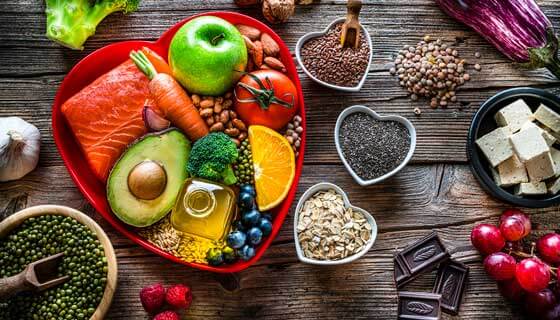
A low sodium diet may benefit people with certain health condtions including high blood pressure, Kidney disease and liver disease.
Food that contain a lot of salt-
Olives in brine , salted nuts
Food that contain a lot of salt-
Olives in brine , salted nuts
A low sodium diet may benefit people with certain health condtions including high blood pressure, Kidney disease and liver disease.
Food that contain a lot of salt-
Olives in brine , salted nuts
Canned beans, corn and peas
Potato chips
Sauerkraut , tomato ketchup or puree
Peanut butter
Corn flakes
Bread , crackers , donuts, muffins, pies, pretzels , scones
Cheese (specially Roquefort , processed cheese etc.)
Pickle
Foods that contain little salt-
Fruits and fruit juices
Vegetables and salads
Unsalted nuts
Grains and pasta
Eggs, milk, yogurt, ice cream
Chocolate
Cottage cheese
Carbonated drinks and alcoholic beverages
The body needs certain amount of sodium to function properly. Sodium helps to maintain body fluid balance and plays a important role in muscle and nerve
function. However too sodium lead to worsening high blood pressure and associated Health complications.
How a low sodium diet benefits the body -
Consuming too much sodium can lead to excess sodium in a person’s blood. Sodium draws water into the bloodstream, resulting in a higher blood volume. This increased blood volume triggers a rise in blood pressure, which doctors refer to as hypertension.
According to the Food and Drug Administration (FDA)Trusted Source, uncontrolled hypertension may increase a person’s risk of the following health complications:
1. Stroke
2. Heart attack
3. Heart failure
4. Blindness
5. kidney disease
Food that contain a lot of salt-
Olives in brine , salted nuts
Canned beans, corn and peas
Potato chips
Sauerkraut , tomato ketchup or puree
Peanut butter
Corn flakes
Bread , crackers , donuts, muffins, pies, pretzels , scones
Cheese (specially Roquefort , processed cheese etc.)
Pickle
Foods that contain little salt-
Fruits and fruit juices
Vegetables and salads
Unsalted nuts
Grains and pasta
Eggs, milk, yogurt, ice cream
Chocolate
Cottage cheese
Carbonated drinks and alcoholic beverages
The body needs certain amount of sodium to function properly. Sodium helps to maintain body fluid balance and plays a important role in muscle and nerve
function. However too sodium lead to worsening high blood pressure and associated Health complications.
How a low sodium diet benefits the body -
Consuming too much sodium can lead to excess sodium in a person’s blood. Sodium draws water into the bloodstream, resulting in a higher blood volume. This increased blood volume triggers a rise in blood pressure, which doctors refer to as hypertension.
According to the Food and Drug Administration (FDA)Trusted Source, uncontrolled hypertension may increase a person’s risk of the following health complications:
1. Stroke
2. Heart attack
3. Heart failure
4. Blindness
5. kidney disease
Garlic
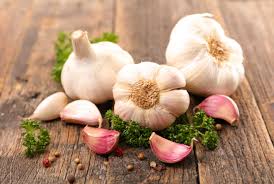
Garlic is a plant in the Allium (onion) family. It’s closely related to onions, shallots, and leeks.Each segment of a garlic bulb is called a clove. There are about 10–20 cloves in a single bulb,
Garlic is a plant in the Allium (onion) family. It’s closely related to onions, shallots, and leeks.Each segment of a garlic bulb is called a clove. There are about 10–20 cloves in a single bulb, give or take. Garlic grows in many parts of the world and is a popular ingredient in cooking due to its strong smell and delicious taste.
A single clove (about 3 grams) contains 4.5 caloriesTrusted Source, 0.2 grams of protein, and 1 gram of carbs.
Garlic is a good source of several nutrients, notably:
Manganese
Vitamin B6
Vitamin C
Selenium
Fiber
Benefits of Garlic-
1. Regulates Blood pressure and sugar.
2. Strengthens immunity system
3. Prevent Heart disease
4. Help in Detoxification
5. Anti- inflammatory
6. Prevents and treats cold
7. Improves bone health
8. Lower cholesterol level
9. Antioxidants
10. Anti- cancer
A single clove (about 3 grams) contains 4.5 caloriesTrusted Source, 0.2 grams of protein, and 1 gram of carbs.
Garlic is a good source of several nutrients, notably:
Manganese
Vitamin B6
Vitamin C
Selenium
Fiber
Benefits of Garlic-
1. Regulates Blood pressure and sugar.
2. Strengthens immunity system
3. Prevent Heart disease
4. Help in Detoxification
5. Anti- inflammatory
6. Prevents and treats cold
7. Improves bone health
8. Lower cholesterol level
9. Antioxidants
10. Anti- cancer
Diabetic Ketoacidosis ( DKA)
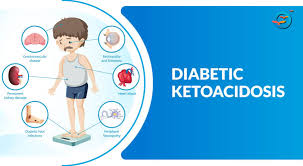
Diabetic ketoacidosis is a serious complication of diabetes.The condition develops when the body can't produce enough insulin. Insulin plays a key role in helping sugar — a major source of energy fo
Diabetic ketoacidosis is a serious complication of diabetes.The condition develops when the body can't produce enough insulin. Insulin plays a key role in helping sugar — a major source of energy for muscles and other tissues — enter cells in the body.Without enough insulin, the body begins to break down fat as fuel. This causes a buildup of acids in the bloodstream called ketones. If it's left untreated, the buildup can lead to diabetic ketoacidosis.
Symptoms-
Symptoms might include:
1. Being very thirsty
2. Urinating often
3. Feeling a need to throw up and throwing up
4. Having stomach pain
5. Being weak or tired
6. Being short of breath
7. Having fruity-scented breath
8. Being confused
Symptoms-
Symptoms might include:
1. Being very thirsty
2. Urinating often
3. Feeling a need to throw up and throwing up
4. Having stomach pain
5. Being weak or tired
6. Being short of breath
7. Having fruity-scented breath
8. Being confused
Hyperthyroidism
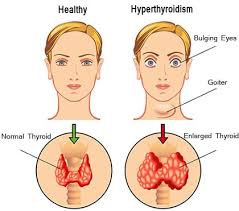
Hyperthyroidism happens when the thyroid gland makes too much thyroid hormone. This condition also is called overactive thyroid. Hyperthyroidism speeds up the body's metabolism. That can cause many sy
Hyperthyroidism happens when the thyroid gland makes too much thyroid hormone. This condition also is called overactive thyroid. Hyperthyroidism speeds up the body's metabolism. That can cause many symptoms, such as weight loss, hand tremors, and rapid or irregular heartbeat.
Symptoms-
1. Losing weight without trying.
2. Fast heartbeat, a condition called tachycardia.
3. Irregular heartbeat, also called arrhythmia.
4. Pounding of the heart, sometimes called heart palpitations.
5. Increased hunger.
6. Nervousness, anxiety and irritability.
7. Tremor, usually a small trembling in the hands and fingers.
8. Sweating.
9. Changes in menstrual cycles.
10. Increased sensitivity to heat.
11. Changes in bowel patterns, especially more-frequent bowel movements.
12. Enlarged thyroid gland, sometimes called a goiter, which may appear as a swelling at the base of the neck.
13. Tiredness.
14. Muscle weakness.
15. Sleep problems.
16. Warm, moist skin.
17. Thinning skin.
18. Fine, brittle hair.
Foods to avoid
Below, we look at the foods that can be harmful to people with hyperthyroidism if they eat them in large quantities:
Iodine-rich foods
Too much iodine can make hyperthyroidism worse by leading the thyroid gland to produce too much thyroid hormone.
A person with hyperthyroidism should avoid eating excessive amounts of iodine-rich foods, such as:
iodized salt
fish and shellfish
seaweed or kelp
dairy products
iodine supplements
food products containing red dye
egg yolks
blackstrap molasses
carrageenan, which is an additive
baked goods with iodate dough conditioners
Soy-
Animal studies have shown that soy ingestion can interfere with radioactive iodine uptake for the treatment of hyperthyroidism.
Sources of soy include:
soy milk
soy sauce
tofu
edamame beans
soybean oil
Caffeine-
Caffeine can worsenTrusted Source some symptoms of hyperthyroidism, including:
palpitations
tremors
anxiety
insomnia
Where possible, a person with hyperthyroidism should try to avoid foods and drinks containing caffeine. These include:
regular coffee
black tea
chocolate
regular soda
energy drinks
Symptoms-
1. Losing weight without trying.
2. Fast heartbeat, a condition called tachycardia.
3. Irregular heartbeat, also called arrhythmia.
4. Pounding of the heart, sometimes called heart palpitations.
5. Increased hunger.
6. Nervousness, anxiety and irritability.
7. Tremor, usually a small trembling in the hands and fingers.
8. Sweating.
9. Changes in menstrual cycles.
10. Increased sensitivity to heat.
11. Changes in bowel patterns, especially more-frequent bowel movements.
12. Enlarged thyroid gland, sometimes called a goiter, which may appear as a swelling at the base of the neck.
13. Tiredness.
14. Muscle weakness.
15. Sleep problems.
16. Warm, moist skin.
17. Thinning skin.
18. Fine, brittle hair.
Foods to avoid
Below, we look at the foods that can be harmful to people with hyperthyroidism if they eat them in large quantities:
Iodine-rich foods
Too much iodine can make hyperthyroidism worse by leading the thyroid gland to produce too much thyroid hormone.
A person with hyperthyroidism should avoid eating excessive amounts of iodine-rich foods, such as:
iodized salt
fish and shellfish
seaweed or kelp
dairy products
iodine supplements
food products containing red dye
egg yolks
blackstrap molasses
carrageenan, which is an additive
baked goods with iodate dough conditioners
Soy-
Animal studies have shown that soy ingestion can interfere with radioactive iodine uptake for the treatment of hyperthyroidism.
Sources of soy include:
soy milk
soy sauce
tofu
edamame beans
soybean oil
Caffeine-
Caffeine can worsenTrusted Source some symptoms of hyperthyroidism, including:
palpitations
tremors
anxiety
insomnia
Where possible, a person with hyperthyroidism should try to avoid foods and drinks containing caffeine. These include:
regular coffee
black tea
chocolate
regular soda
energy drinks
PCOD & PCOS
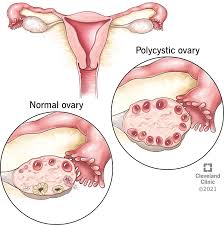
What is PCOS?
Polycystic ovary syndrome (PCOS) is a problem with hormones that happens during the reproductive years. If you have PCOS, you may not have periods very often. Or you may have
What is PCOS?
Polycystic ovary syndrome (PCOS) is a problem with hormones that happens during the reproductive years. If you have PCOS, you may not have periods very often. Or you may have periods that last many days. You may also have too much of a hormone called androgen in your body.With PCOS, many small sacs of fluid develop along the outer edge of the ovary. These are called cysts. The small fluid-filled cysts contain immature eggs. These are called follicles. The follicles fail to regularly release eggs.
What is PCOD?
Ovaries are the reproductive organs of a female which control the menstrual cycle and the production of hormones like estrogen, progesterone, inhibin, relaxin etc. The accumulation of the eggs swells the ovary and makes it release large quantities of male hormone thus causing infertility.
Common Symptoms of PCOD/PCOS
PCOD (Polycystic Ovarian Disease) often starts showing symptoms around the time of the first menstrual cycle during puberty, but it can also develop later, especially with weight gain over the years.
Common signs of PCOD include:
1. Increased androgen levels: High levels of male hormones can lead to excess facial and body hair, as well as male-pattern baldness.
2. Irregular periods: You may experience irregular or delayed periods due to problems with egg maturation.
3. Difficulty getting pregnant: Hormonal imbalances can prevent eggs from maturing and being released, which can affect ovulation and make it harder to
conceive. Many women are diagnosed with PCOD when they seek help for difficulty getting pregnant.
4. Hair loss or thinning: Excess male hormones can cause hair to thin or fall out.
5. Acne: Hormonal imbalances may lead to acne on the skin.
6. Weight gain: Many women with PCOD experience weight gain or have difficulty losing weight.
Causes-
1. Family History
2. Insulin resistance and lifestyle
3. Inflammation
4. Obesity
5. Dietary Habit etc.
Diet to treat PCOD and PCOD-
1. Includes natural, unprocessed food in diet
2. Includes leafy vegetables, vegestables in diet
3. Add high in fiber rich food
4. Add Nuts and legumes in diet
5. Add Whole grain food in diet
6. Add Low-fat dairy products in diet
Liver Chirrhosis
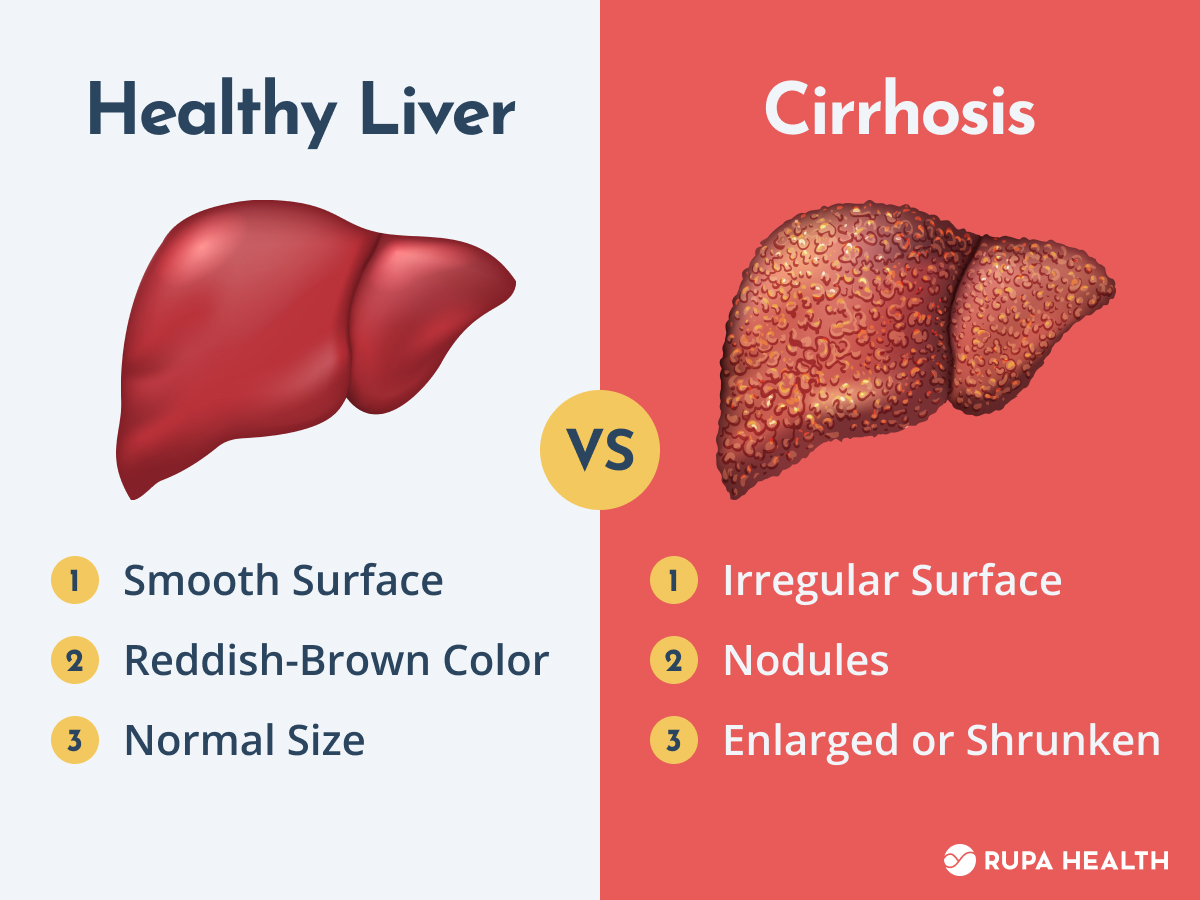
Cirrhosis is severe scarring of the liver. This serious condition can be caused by many forms of liver diseases and conditions, such as hepatitis or chronic alcoholism.Cirrhosis is severe scarring of
Cirrhosis is severe scarring of the liver. This serious condition can be caused by many forms of liver diseases and conditions, such as hepatitis or chronic alcoholism.Cirrhosis is severe scarring of the liver. This serious condition can be caused by many forms of liver diseases and conditions, such as hepatitis or chronic alcoholism.
Symptoms-
Fatigue.
Easily bleeding or bruising.
Loss of appetite.
Nausea.
Swelling in the legs, feet or ankles, called edema.
Weight loss.
Itchy skin.
Yellow discoloration in the skin and eyes, called jaundice.
Fluid accumulation in the abdomen, called ascites (uh-SAHY-teez).
Spiderlike blood vessels on the skin.
Redness in the palms of the hands.
Pale fingernails, especially the thumb and index finger.
Clubbing of the fingers, in which the fingertips spread out and become rounder than usual.
For women, absence of or loss of periods not related to menopause.
For men, loss of sex drive, testicular shrinkage or breast enlargement, known as gynecomastia.
Confusion, drowsiness or slurred speech.
Causes-
A wide range of diseases and conditions can damage the liver and lead to cirrhosis.
Some of the causes include:
Long-term alcohol abuse.
Ongoing viral hepatitis (hepatitis B, C and D).
Nonalcoholic fatty liver disease, a condition in which fat accumulates in the liver.
Hemochromatosis, a condition that causes iron buildup in the body.
Autoimmune hepatitis, which is a liver disease caused by the body's immune system.
Destruction of the bile ducts caused by primary biliary cholangitis.
Hardening and scarring of the bile ducts caused by primary sclerosing cholangitis.
Wilson's disease, a condition in which copper accumulates in the liver.
Cystic fibrosis.
Alpha-1 antitrypsin deficiency.
Poorly formed bile ducts, a condition known as biliary atresia.
Inherited disorders of sugar metabolism, such as galactosemia or glycogen storage disease.
Alagille syndrome, a genetic digestive disorder.
Infection, such as syphilis or brucellosis.
Medications, including methotrexate or isoniazid.
Foods to Avoid-
1. Fast food, fried food
2. Canned food ( soup, vegetables)
3. Packaged, processed snacks and meals (including frozen)
4. Sauerkraut, pickles.
5. Tomato sauce or paste
6. Instant hot cereal.
7. Potato chips, pretzels, crackers, popcorn
8. Oils high in trans fat or partially hydrogenated oils (palm oil, coconut oil)
9. Breading, coating, and stuffing mixes
10. Full-fat dairy products
11. Pancake, and baked good mixes
12. Pastries, cake, cookies, muffins, doughnuts
13. American, Parmesan, Swiss, blue, feta, cottage cheese, cheese slices or spreads
14. Pudding, custard, or frosting mixes
15. Table salt, sea salt, mixed seasonings
16. Ketchup, soy sauce, salsa, salad dressing, steak sauce
17. Caffeinated tea, coffee, and soft drinks
18. Alcohol
Symptoms-
Fatigue.
Easily bleeding or bruising.
Loss of appetite.
Nausea.
Swelling in the legs, feet or ankles, called edema.
Weight loss.
Itchy skin.
Yellow discoloration in the skin and eyes, called jaundice.
Fluid accumulation in the abdomen, called ascites (uh-SAHY-teez).
Spiderlike blood vessels on the skin.
Redness in the palms of the hands.
Pale fingernails, especially the thumb and index finger.
Clubbing of the fingers, in which the fingertips spread out and become rounder than usual.
For women, absence of or loss of periods not related to menopause.
For men, loss of sex drive, testicular shrinkage or breast enlargement, known as gynecomastia.
Confusion, drowsiness or slurred speech.
Causes-
A wide range of diseases and conditions can damage the liver and lead to cirrhosis.
Some of the causes include:
Long-term alcohol abuse.
Ongoing viral hepatitis (hepatitis B, C and D).
Nonalcoholic fatty liver disease, a condition in which fat accumulates in the liver.
Hemochromatosis, a condition that causes iron buildup in the body.
Autoimmune hepatitis, which is a liver disease caused by the body's immune system.
Destruction of the bile ducts caused by primary biliary cholangitis.
Hardening and scarring of the bile ducts caused by primary sclerosing cholangitis.
Wilson's disease, a condition in which copper accumulates in the liver.
Cystic fibrosis.
Alpha-1 antitrypsin deficiency.
Poorly formed bile ducts, a condition known as biliary atresia.
Inherited disorders of sugar metabolism, such as galactosemia or glycogen storage disease.
Alagille syndrome, a genetic digestive disorder.
Infection, such as syphilis or brucellosis.
Medications, including methotrexate or isoniazid.
Foods to Avoid-
1. Fast food, fried food
2. Canned food ( soup, vegetables)
3. Packaged, processed snacks and meals (including frozen)
4. Sauerkraut, pickles.
5. Tomato sauce or paste
6. Instant hot cereal.
7. Potato chips, pretzels, crackers, popcorn
8. Oils high in trans fat or partially hydrogenated oils (palm oil, coconut oil)
9. Breading, coating, and stuffing mixes
10. Full-fat dairy products
11. Pancake, and baked good mixes
12. Pastries, cake, cookies, muffins, doughnuts
13. American, Parmesan, Swiss, blue, feta, cottage cheese, cheese slices or spreads
14. Pudding, custard, or frosting mixes
15. Table salt, sea salt, mixed seasonings
16. Ketchup, soy sauce, salsa, salad dressing, steak sauce
17. Caffeinated tea, coffee, and soft drinks
18. Alcohol
Chronic Kidney Disease (CKD)
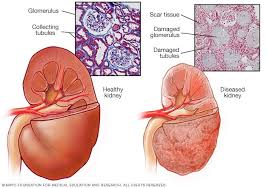
Chronic kidney disease, also called chronic kidney failure, involves a gradual loss of kidney function. Your kidneys filter wastes and excess fluids from your blood, which are then removed in your uri
Chronic kidney disease, also called chronic kidney failure, involves a gradual loss of kidney function. Your kidneys filter wastes and excess fluids from your blood, which are then removed in your urine. Advanced chronic kidney disease can cause dangerous levels of fluid, electrolytes and wastes to build up in your body.
Symptoms-
Nausea
Vomiting
Loss of appetite
Fatigue and weakness
Sleep problems
Urinating more or less
Decreased mental sharpness
Muscle cramps
Swelling of feet and ankles
Dry, itchy skin
High blood pressure (hypertension) that's difficult to control
Shortness of breath, if fluid builds up in the lungs
Chest pain, if fluid builds up around the lining of the heart
Causes-
1. Type 1 or type 2 diabetes
2. High blood pressure
3. Glomerulonephritis, an inflammation of the kidney's filtering units (glomeruli).
4. Interstitial nephritis, an inflammation of the kidney's tubules and surrounding structures
5. Polycystic kidney disease or other inherited kidney diseases
6. Prolonged obstruction of the urinary tract, from conditions such as enlarged prostate, kidney stones and some cancers
7. Vesicoureteral reflux, a condition that causes urine to back up into your kidneys
8. Recurrent kidney infection, also called pyelonephritis
Dietary Guidelines -
1. Choose low sodium diet.
2. Eat well balanced diet of fruits, vegetables, whole grains, legumes etc.
3. For advanced kidney disease need to reduce intake of potassium and phosphorus.
4. Monitor the fluid intake.
Symptoms-
Nausea
Vomiting
Loss of appetite
Fatigue and weakness
Sleep problems
Urinating more or less
Decreased mental sharpness
Muscle cramps
Swelling of feet and ankles
Dry, itchy skin
High blood pressure (hypertension) that's difficult to control
Shortness of breath, if fluid builds up in the lungs
Chest pain, if fluid builds up around the lining of the heart
Causes-
1. Type 1 or type 2 diabetes
2. High blood pressure
3. Glomerulonephritis, an inflammation of the kidney's filtering units (glomeruli).
4. Interstitial nephritis, an inflammation of the kidney's tubules and surrounding structures
5. Polycystic kidney disease or other inherited kidney diseases
6. Prolonged obstruction of the urinary tract, from conditions such as enlarged prostate, kidney stones and some cancers
7. Vesicoureteral reflux, a condition that causes urine to back up into your kidneys
8. Recurrent kidney infection, also called pyelonephritis
Dietary Guidelines -
1. Choose low sodium diet.
2. Eat well balanced diet of fruits, vegetables, whole grains, legumes etc.
3. For advanced kidney disease need to reduce intake of potassium and phosphorus.
4. Monitor the fluid intake.
Kidney stone
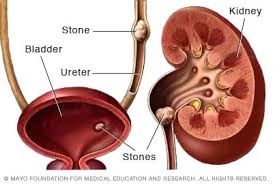
Kidney stones (also called renal calculi, nephrolithiasis or urolithiasis) are hard deposits made of minerals and salts that form inside your kidneys.Diet, excess body weight, some medical conditions,
Kidney stones (also called renal calculi, nephrolithiasis or urolithiasis) are hard deposits made of minerals and salts that form inside your kidneys.Diet, excess body weight, some medical conditions, and certain supplements and medications are among the many causes of kidney stones. Kidney stones can affect any part of your urinary tract — from your kidneys to your bladder. Often, stones form when the urine becomes concentrated, allowing minerals to crystallize and stick together.
Symptoms-
Severe, sharp pain in the side and back, below the ribs
Pain that radiates to the lower abdomen and groin
Pain that comes in waves and fluctuates in intensity
Pain or burning sensation while urinating
Types of kidney stones-
1. Calcium stones.
2. Uric acid stones.
3. Struvite stones.
4. Cystine stones.
Dietary Guidelines -
1. Drink plenty of fluid: 2-3 quarts/day
This includes any type of fluid such as water, coffee and lemonade which have been shown to have a beneficial effect with the exception of grapefruit juice and soda.This will help produce less concentrated urine and ensure a good urine volume of at least 2.5L/day
2. Limit foods with high oxalate content like Spinach, many berries, chocolate, wheat bran, nuts, beets, tea and rhubarb should be eliminated from your diet
intake.
3. Eat enough dietary calcium
4. Three servings of dairy per day will help lower the risk of calcium stone formation. Eat with meals.
5. Avoid extra calcium supplements
6. Calcium supplements should be individualized by your physician and registered kidney dietitian
7. Eat a moderate amount of protein
8. High protein intakes will cause the kidneys to excrete more calcium therefore this may cause more stones to form in the kidney
9. Avoid high salt intake. High sodium intake increases calcium in the urine which increases the chances of developing stones
10. Low salt diet is also important to control blood pressure.
11. Avoid high doses of vitamin C supplements.
Symptoms-
Severe, sharp pain in the side and back, below the ribs
Pain that radiates to the lower abdomen and groin
Pain that comes in waves and fluctuates in intensity
Pain or burning sensation while urinating
Types of kidney stones-
1. Calcium stones.
2. Uric acid stones.
3. Struvite stones.
4. Cystine stones.
Dietary Guidelines -
1. Drink plenty of fluid: 2-3 quarts/day
This includes any type of fluid such as water, coffee and lemonade which have been shown to have a beneficial effect with the exception of grapefruit juice and soda.This will help produce less concentrated urine and ensure a good urine volume of at least 2.5L/day
2. Limit foods with high oxalate content like Spinach, many berries, chocolate, wheat bran, nuts, beets, tea and rhubarb should be eliminated from your diet
intake.
3. Eat enough dietary calcium
4. Three servings of dairy per day will help lower the risk of calcium stone formation. Eat with meals.
5. Avoid extra calcium supplements
6. Calcium supplements should be individualized by your physician and registered kidney dietitian
7. Eat a moderate amount of protein
8. High protein intakes will cause the kidneys to excrete more calcium therefore this may cause more stones to form in the kidney
9. Avoid high salt intake. High sodium intake increases calcium in the urine which increases the chances of developing stones
10. Low salt diet is also important to control blood pressure.
11. Avoid high doses of vitamin C supplements.
Inflammatory Bowel Disease (IBD)
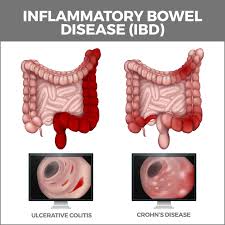
Inflammatory bowel disease, also called IBD, is an umbrella term for a group of conditions that cause swelling and inflammation of the tissues in the digestive tract.
The most common types of IBD i
The most common types of IBD i
Inflammatory bowel disease, also called IBD, is an umbrella term for a group of conditions that cause swelling and inflammation of the tissues in the digestive tract.
The most common types of IBD include:
Ulcerative colitis. This condition involves inflammation and sores, called ulcers, along the lining of the colon and rectum.
Crohn's disease. In this type of IBD, the lining of the digestive tract is inflamed. The condition often involves the deeper layers of the digestive tract. Crohn's disease most commonly affects the small intestine. However, it also can affect the large intestine and, uncommonly, the upper gastrointestinal tract.
Symptoms-
Symptoms that are common to both Crohn's disease and ulcerative colitis include:
1. Diarrhea.
2. Belly pain and cramping.
3. Blood in the stool.
4. Loss of appetite.
5. Losing weight without trying.
6. Feeling extremely tired.
Dietary guidelines-
1. Eat a low-fiber diet. Limit foods such as seeds, nuts, beans, fruit and bran.
2. Try a low FODMAP diet. FODMAP stands for fermentable, oligo-, di-, monosaccharides and polyols. This type of diet cuts back on a group of sugars that can be 3. Poorly absorbed by your gastrointestinal tract. This includes foods containing fructose; lactose; sugar polyols, such as sorbitol and mannitol; fructans, which
are found in garlic, leeks, artichokes, and wheat; and galacto-oligosaccharides, which are found in lentils, chickpeas, and green peas.
4. Drink water to stay hydrated.
5. Avoid caffeine and energy drinks.
The most common types of IBD include:
Ulcerative colitis. This condition involves inflammation and sores, called ulcers, along the lining of the colon and rectum.
Crohn's disease. In this type of IBD, the lining of the digestive tract is inflamed. The condition often involves the deeper layers of the digestive tract. Crohn's disease most commonly affects the small intestine. However, it also can affect the large intestine and, uncommonly, the upper gastrointestinal tract.
Symptoms-
Symptoms that are common to both Crohn's disease and ulcerative colitis include:
1. Diarrhea.
2. Belly pain and cramping.
3. Blood in the stool.
4. Loss of appetite.
5. Losing weight without trying.
6. Feeling extremely tired.
Dietary guidelines-
1. Eat a low-fiber diet. Limit foods such as seeds, nuts, beans, fruit and bran.
2. Try a low FODMAP diet. FODMAP stands for fermentable, oligo-, di-, monosaccharides and polyols. This type of diet cuts back on a group of sugars that can be 3. Poorly absorbed by your gastrointestinal tract. This includes foods containing fructose; lactose; sugar polyols, such as sorbitol and mannitol; fructans, which
are found in garlic, leeks, artichokes, and wheat; and galacto-oligosaccharides, which are found in lentils, chickpeas, and green peas.
4. Drink water to stay hydrated.
5. Avoid caffeine and energy drinks.
Coronary Artery Disease (CAD)
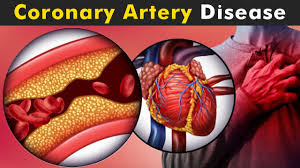
Coronary artery disease (CAD) is a common type of heart disease. It affects the main blood vessels that supply blood to the heart, called the coronary arteries. In CAD, there is reduced blood flow to
Coronary artery disease (CAD) is a common type of heart disease. It affects the main blood vessels that supply blood to the heart, called the coronary arteries. In CAD, there is reduced blood flow to the heart muscle. A buildup of fats, cholesterol and other substances in and on the artery walls, a condition called atherosclerosis, usually causes coronary artery disease. The buildup, called plaque, makes the arteries narrow.
Coronary artery disease often develops over many years. Symptoms are from the lack of blood flow to the heart. They may include chest pain and shortness of breath. A complete blockage of blood flow can cause a heart attack.
Symptoms-
Chest pain, called angina.
Shortness of breath.
Fatigue.
A completely blocked coronary artery will cause a heart attack. Common heart attack symptoms include:
Chest pain that may feel like pressure, tightness, squeezing or aching.
Pain or discomfort that spreads to the shoulder, arm, back, neck, jaw, teeth or sometimes the upper belly.
Cold sweats.
Fatigue.
Heartburn.
Nausea.
Shortness of breath.
Lightheadedness or sudden dizziness.
What Foods to Eat with Coronary Heart Disease?
Adopting a heart-healthy diet is crucial for individuals with coronary artery disease. Here are some foods that you should include in your diet for coronary artery disease:
1. Fruits and Vegetables: Fresh fruits and vegetables contain enormous amounts of vitamins, minerals, and fibre. They are low in calories and rich in antioxidants that may help prevent heart disease. Aim for at least five portions of fresh fruits and vegetables daily, including leafy greens, broccoli, bananas, and oranges.
2. Whole Grains: Whole grains, like oats, brown rice, and whole-grain bread, are good sources of fibre and other nutrients that play crucial roles in heart health and controlling blood pressure. Choose whole-grain options over refined grains whenever possible.
3. Lean Protein Sources: Lean meat, poultry, fish, eggs, legumes, and low-fat or fat-free dairy products are excellent protein sources. Choose lower-fat options like lean cuts of meat, skinless chicken breasts, and fish high in omega-3 fatty acids, such as salmon and tuna.
4. Healthy Fats: While it's crucial to limit saturated and trans fats, a balanced diet should still include unsaturated fats. Foods containing unsaturated fats, like avocados, nuts, and seeds, and olive, canola, and vegetable oils, can help increase good cholesterol levels and reduce arterial blockages.
5. High-fibre Foods: Foods high in fibre, such as lentils, beans, berries, and whole grains, can help lower cholesterol levels and promote heart health. Fibre also helps maintain a healthy weight, which is crucial for managing coronary artery disease.
6. Low-fat Dairy Products: Low-fat or fat-free dairy products, such as yoghurt and cheese, can be included in a heart-healthy diet. They provide essential nutrients (protein and calcium) while being low in saturated fat.
7. Herbs and Spices: Various herbs and spices, like garlic, turmeric, and ginger, can add flavour to meals while providing potential heart-health benefits due to their anti-inflammatory properties.
Foods to Avoid with Coronary Heart Disease
Just as it's important to include heart-healthy foods in your diet for coronary artery disease, it's equally essential to avoid or limit certain foods that can exacerbate the condition. Here are some foods to steer clear of:
1. Saturated and Trans Fats: Saturated and trans fats can raise low-density lipoprotein (LDL) levels, increasing the risk of plaque buildup in the arteries. Limit your intake of:
A. Full-fat dairy products like cream, cheese, and whole milk
B. Baked goods like cakes, cookies, and pastries
C. Fried foods and foods cooked in butter or lard
D. Coconut, palm, and palm kernel oils
E. Processed and High-sodium Foods: Processed foods are often high in sodium content, which can contribute to high blood pressure, a significant risk factor for coronary artery disease. Avoid or limit:
Canned and processed meats like bacon, sausages, and deli meats
1. Frozen meals and convenience foods
2. Salty snacks like chips, pretzels, and crackers
3. Pickled foods and condiments like soy sauce and ketchup
4. Aim to keep your daily sodium consumption below 2,300 milligrams (about one teaspoon of salt).
5. Added Sugars and Refined Carbohydrates: Consuming too many added sugar foods and refined carbohydrates can increase the likelihood of obesity,
diabetes, and high triglyceride levels, all of which contribute to coronary artery disease. Limit or avoid:
Sugary beverages like soda, fruit juices, and sweetened coffee drinks
Baked goods like cakes, cookies, and pastries
Candy and other sweets
White bread, pasta, and rice
Coronary artery disease often develops over many years. Symptoms are from the lack of blood flow to the heart. They may include chest pain and shortness of breath. A complete blockage of blood flow can cause a heart attack.
Symptoms-
Chest pain, called angina.
Shortness of breath.
Fatigue.
A completely blocked coronary artery will cause a heart attack. Common heart attack symptoms include:
Chest pain that may feel like pressure, tightness, squeezing or aching.
Pain or discomfort that spreads to the shoulder, arm, back, neck, jaw, teeth or sometimes the upper belly.
Cold sweats.
Fatigue.
Heartburn.
Nausea.
Shortness of breath.
Lightheadedness or sudden dizziness.
What Foods to Eat with Coronary Heart Disease?
Adopting a heart-healthy diet is crucial for individuals with coronary artery disease. Here are some foods that you should include in your diet for coronary artery disease:
1. Fruits and Vegetables: Fresh fruits and vegetables contain enormous amounts of vitamins, minerals, and fibre. They are low in calories and rich in antioxidants that may help prevent heart disease. Aim for at least five portions of fresh fruits and vegetables daily, including leafy greens, broccoli, bananas, and oranges.
2. Whole Grains: Whole grains, like oats, brown rice, and whole-grain bread, are good sources of fibre and other nutrients that play crucial roles in heart health and controlling blood pressure. Choose whole-grain options over refined grains whenever possible.
3. Lean Protein Sources: Lean meat, poultry, fish, eggs, legumes, and low-fat or fat-free dairy products are excellent protein sources. Choose lower-fat options like lean cuts of meat, skinless chicken breasts, and fish high in omega-3 fatty acids, such as salmon and tuna.
4. Healthy Fats: While it's crucial to limit saturated and trans fats, a balanced diet should still include unsaturated fats. Foods containing unsaturated fats, like avocados, nuts, and seeds, and olive, canola, and vegetable oils, can help increase good cholesterol levels and reduce arterial blockages.
5. High-fibre Foods: Foods high in fibre, such as lentils, beans, berries, and whole grains, can help lower cholesterol levels and promote heart health. Fibre also helps maintain a healthy weight, which is crucial for managing coronary artery disease.
6. Low-fat Dairy Products: Low-fat or fat-free dairy products, such as yoghurt and cheese, can be included in a heart-healthy diet. They provide essential nutrients (protein and calcium) while being low in saturated fat.
7. Herbs and Spices: Various herbs and spices, like garlic, turmeric, and ginger, can add flavour to meals while providing potential heart-health benefits due to their anti-inflammatory properties.
Foods to Avoid with Coronary Heart Disease
Just as it's important to include heart-healthy foods in your diet for coronary artery disease, it's equally essential to avoid or limit certain foods that can exacerbate the condition. Here are some foods to steer clear of:
1. Saturated and Trans Fats: Saturated and trans fats can raise low-density lipoprotein (LDL) levels, increasing the risk of plaque buildup in the arteries. Limit your intake of:
A. Full-fat dairy products like cream, cheese, and whole milk
B. Baked goods like cakes, cookies, and pastries
C. Fried foods and foods cooked in butter or lard
D. Coconut, palm, and palm kernel oils
E. Processed and High-sodium Foods: Processed foods are often high in sodium content, which can contribute to high blood pressure, a significant risk factor for coronary artery disease. Avoid or limit:
Canned and processed meats like bacon, sausages, and deli meats
1. Frozen meals and convenience foods
2. Salty snacks like chips, pretzels, and crackers
3. Pickled foods and condiments like soy sauce and ketchup
4. Aim to keep your daily sodium consumption below 2,300 milligrams (about one teaspoon of salt).
5. Added Sugars and Refined Carbohydrates: Consuming too many added sugar foods and refined carbohydrates can increase the likelihood of obesity,
diabetes, and high triglyceride levels, all of which contribute to coronary artery disease. Limit or avoid:
Sugary beverages like soda, fruit juices, and sweetened coffee drinks
Baked goods like cakes, cookies, and pastries
Candy and other sweets
White bread, pasta, and rice
Fatty Liver
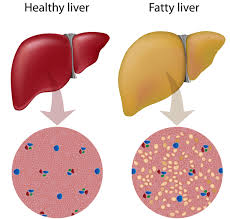
What is fatty liver disease?
Your liver is the largest organ inside your body. It helps your body digest food, store energy, and remove poisons. Fatty liver disease is a condition in which fat builds
Your liver is the largest organ inside your body. It helps your body digest food, store energy, and remove poisons. Fatty liver disease is a condition in which fat builds
What is fatty liver disease?
Your liver is the largest organ inside your body. It helps your body digest food, store energy, and remove poisons. Fatty liver disease is a condition in which fat builds up in your liver. There are two main types:
1. Nonalcoholic fatty liver disease (NAFLD)
2. Alcoholic fatty liver disease, also called alcoholic steatohepatitis
What is nonalcoholic fatty liver disease (NAFLD)?
NAFLD is a type of fatty liver disease that is not related to heavy alcohol use. There are two kinds:
Simple fatty liver, in which you have fat in your liver but little or no inflammation or liver cell damage. Simple fatty liver typically does not get bad enough to cause liver damage or complications.
Nonalcoholic steatohepatitis (NASH), in which you have inflammation and liver cell damage, as well as fat in your liver. Inflammation and liver cell damage can cause fibrosis, or scarring, of the liver. NASH may lead to cirrhosis or liver cancer.
What is alcoholic fatty liver disease?
Alcoholic fatty liver disease is due to heavy alcohol use. Your liver breaks down most of the alcohol you drink, so it can be removed from your body. But the process of breaking it down can generate harmful substances. These substances can damage liver cells, promote inflammation, and weaken your body's natural defenses. The more alcohol that you drink, the more you damage your liver. Alcoholic fatty liver disease is the earliest stage of alcohol-related liver disease. The next stages are alcoholic hepatitis and cirrhosis.
Symptoms-
1. Abdominal Pain
2. Fatique
2. Nausea
3. Loss of appetite
4. Weight loss
5. Ascites
6. Jaundice
7. Swelling of legs etc.
Dietary guidelines-
1. Add fruits and vegetables in diet
2. Add high fiber plants like legumes and whole grains
3. Significantly reducing your intake of certain foods and beverages, including those high in added sugar, salt, refined carbohydrates, and saturated fat
4. Limited alcohol
Your liver is the largest organ inside your body. It helps your body digest food, store energy, and remove poisons. Fatty liver disease is a condition in which fat builds up in your liver. There are two main types:
1. Nonalcoholic fatty liver disease (NAFLD)
2. Alcoholic fatty liver disease, also called alcoholic steatohepatitis
What is nonalcoholic fatty liver disease (NAFLD)?
NAFLD is a type of fatty liver disease that is not related to heavy alcohol use. There are two kinds:
Simple fatty liver, in which you have fat in your liver but little or no inflammation or liver cell damage. Simple fatty liver typically does not get bad enough to cause liver damage or complications.
Nonalcoholic steatohepatitis (NASH), in which you have inflammation and liver cell damage, as well as fat in your liver. Inflammation and liver cell damage can cause fibrosis, or scarring, of the liver. NASH may lead to cirrhosis or liver cancer.
What is alcoholic fatty liver disease?
Alcoholic fatty liver disease is due to heavy alcohol use. Your liver breaks down most of the alcohol you drink, so it can be removed from your body. But the process of breaking it down can generate harmful substances. These substances can damage liver cells, promote inflammation, and weaken your body's natural defenses. The more alcohol that you drink, the more you damage your liver. Alcoholic fatty liver disease is the earliest stage of alcohol-related liver disease. The next stages are alcoholic hepatitis and cirrhosis.
Symptoms-
1. Abdominal Pain
2. Fatique
2. Nausea
3. Loss of appetite
4. Weight loss
5. Ascites
6. Jaundice
7. Swelling of legs etc.
Dietary guidelines-
1. Add fruits and vegetables in diet
2. Add high fiber plants like legumes and whole grains
3. Significantly reducing your intake of certain foods and beverages, including those high in added sugar, salt, refined carbohydrates, and saturated fat
4. Limited alcohol
Gastroesophageal Reflux Disease (GERD)
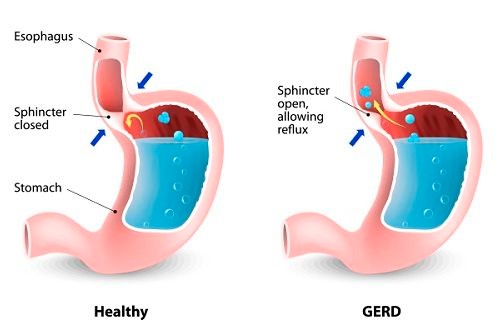
Gastroesophageal reflux disease (GERD) is a common condition in which the stomach contents move up into the esophagus. Reflux becomes a disease when it causes frequent or severe symptoms or injury. Re
Gastroesophageal reflux disease (GERD) is a common condition in which the stomach contents move up into the esophagus. Reflux becomes a disease when it causes frequent or severe symptoms or injury. Reflux may damage the esophagus, pharynx or respiratory tract.
Symptoms -
Non-burning chest pain, which is usually located in the middle of the chest and radiates to the back
Difficulty swallowing (dysphagia)
Atypical reflux symptoms relating to the throat, larynx or lungs:
Sore throat
Coughing
Increased salivation
Shortness of breath
Causes-
GERD is caused by frequent acid reflux or reflux of nonacidic content from the stomach.When you swallow, a circular band of muscle around the bottom of the esophagus, called the lower esophageal sphincter, relaxes to allow food and liquid to flow into the stomach. Then the sphincter closes again.If the sphincter does not relax as is typical or it weakens, stomach acid can flow back into the esophagus. This constant backwash of acid irritates the lining of the esophagus, often causing it to become inflamed.
Food to be avoided-
• Coffee (with or without caffeine)
• Citrus fruits and juices
• Tomatoes
• Carbonated beverages
• Chocolate
• Peppermint, garlic and onions relax the lower
• Fatty, spicy or fried foods
Dietary Guidelines-
When making food choices, some foods have been found to be less reflux-triggering. The following foods may help you ease or avoid symptoms.
1. Non-citrus fruits. While you should avoid citrus fruits, you can enjoy non-citrus fruits such as bananas, melons, apples, and pears, among others.
2. Vegetables. Try to eat your vegetables raw. While tomato sauce may bother you, a fresh tomato may not.
3. Lean meats. Lean meats that are grilled, poached, broiled, or baked are your best options. Try using fresh herbs, rather than spices, to make them flavorful.
4. Oatmeal, whole-grain bread, rice, and couscous. These are all good sources of healthy complex carbs and fiber.
5. Unsaturated fats from plants and fish. Replace saturated fats and trans fats with oils such as olive, sesame, canola, sunflower, and safflower; avocados;
nuts and seeds; soybean.
Symptoms -
Non-burning chest pain, which is usually located in the middle of the chest and radiates to the back
Difficulty swallowing (dysphagia)
Atypical reflux symptoms relating to the throat, larynx or lungs:
Sore throat
Coughing
Increased salivation
Shortness of breath
Causes-
GERD is caused by frequent acid reflux or reflux of nonacidic content from the stomach.When you swallow, a circular band of muscle around the bottom of the esophagus, called the lower esophageal sphincter, relaxes to allow food and liquid to flow into the stomach. Then the sphincter closes again.If the sphincter does not relax as is typical or it weakens, stomach acid can flow back into the esophagus. This constant backwash of acid irritates the lining of the esophagus, often causing it to become inflamed.
Food to be avoided-
• Coffee (with or without caffeine)
• Citrus fruits and juices
• Tomatoes
• Carbonated beverages
• Chocolate
• Peppermint, garlic and onions relax the lower
• Fatty, spicy or fried foods
Dietary Guidelines-
When making food choices, some foods have been found to be less reflux-triggering. The following foods may help you ease or avoid symptoms.
1. Non-citrus fruits. While you should avoid citrus fruits, you can enjoy non-citrus fruits such as bananas, melons, apples, and pears, among others.
2. Vegetables. Try to eat your vegetables raw. While tomato sauce may bother you, a fresh tomato may not.
3. Lean meats. Lean meats that are grilled, poached, broiled, or baked are your best options. Try using fresh herbs, rather than spices, to make them flavorful.
4. Oatmeal, whole-grain bread, rice, and couscous. These are all good sources of healthy complex carbs and fiber.
5. Unsaturated fats from plants and fish. Replace saturated fats and trans fats with oils such as olive, sesame, canola, sunflower, and safflower; avocados;
nuts and seeds; soybean.
Anemia
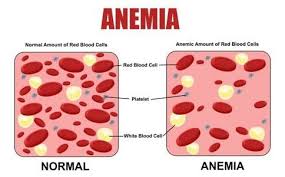
What is anemia?
Anemia is a blood disorder that happens when you don’t have enough red blood cells or your red blood cells don’t work as they should. Some types of anemia are inherited, but peopl
Anemia is a blood disorder that happens when you don’t have enough red blood cells or your red blood cells don’t work as they should. Some types of anemia are inherited, but peopl
What is anemia?
Anemia is a blood disorder that happens when you don’t have enough red blood cells or your red blood cells don’t work as they should. Some types of anemia are inherited, but people may also acquire or develop the condition during their lifetimes.
Symptoms-
Fatigue
Chest pain.
Dizziness.
Frequent infections.
Heart palpitations.
Headache.
Pallor (skin color that’s paler than usual).
Pulsatile tinnitus.
Shortness of breath (dyspnea).
What causes anemia?
Many things can cause it. For example, iron-deficiency anemia is the most common type of anemia. You can develop this type if you don’t get enough iron from the food you eat, or if you lose blood from an injury or illness. Healthcare providers classify anemia as being acquired or inherited.
Types of Anaemia-
1. Autoimmune hemolytic anemia: In this case, your immune system attacks your red blood cells.
2. Macrocytic anemia and megaloblastic anemia: These are types of anemia that develop when your bone marrow makes unusually large red blood cells.
Certain medical conditions and vitamin deficiencies may cause these types of anemia. Healthcare providers may call these conditions vitamin deficiency
anemia.
3. Normocytic anemia: In this type, you have fewer red blood cells than usual. There are many causes of normocytic anemia.
Pernicious anemia: This condition, which is one of the causes of vitamin B12 deficiency, is an autoimmune condition that prevents your body from absorbing
vitamin B12.
Nutrional Guidelines-
A well balanced diet with adequate calories and good quality protein, foods rich
in iron, folic acid, Vitamin ‘B12’ & ‘C’ needs to be taken.
1. Eat often and eat small meals that help in better absorption and digestion.
2. Include protein-rich foods . Sources of protein for vegetarians are milk, curds (yoghurt), cheese, soya nuggets, tofu and paneer.
3. Eat Vitamin / Mineral-rich foods
Iron-rich Foods :
Cereals and millets : Bajra, ragi, whole wheat flour, puffed rice and rice
flakes.
Legumes : Horse gram, moth beans, lentils, bengal gram dal, rajmah, peas
dry, cow peas.
Dark green and leafy vegetables like curry leaves powder, mint chutney, gogu, methi, amaranth, drumstick leaves, onion stalks etc. daily.
Nuts and oil seeds : Til, chia seeds, groundnuts, flax seeds, almonds and pista, melon seeds, coconut dry.
Dry fruits : Raisins, black dates, apricot.
4. Take Vitamin C-rich foods like amla, guava, berries, melon, mango, pineapple, citrus fruits, lime juice etc. along with your meals.
5. Use of double fortified salt (iron + iodine) is recommended.
Avoid the following :
1. Do not drink tea or coffee with your meals. Take it an hour before or after the meal.
2. Do not combine an iron-rich meal with too many calcium-rich foods like milk, cheese, paneer etc.
3. Too much fiber in the diet also affects the iron absorption.
4. Avoid refined and processed foods – Limit intake of pasta, noodles, polished rice, ready-to-eat foods, etc.
Anemia is a blood disorder that happens when you don’t have enough red blood cells or your red blood cells don’t work as they should. Some types of anemia are inherited, but people may also acquire or develop the condition during their lifetimes.
Symptoms-
Fatigue
Chest pain.
Dizziness.
Frequent infections.
Heart palpitations.
Headache.
Pallor (skin color that’s paler than usual).
Pulsatile tinnitus.
Shortness of breath (dyspnea).
What causes anemia?
Many things can cause it. For example, iron-deficiency anemia is the most common type of anemia. You can develop this type if you don’t get enough iron from the food you eat, or if you lose blood from an injury or illness. Healthcare providers classify anemia as being acquired or inherited.
Types of Anaemia-
1. Autoimmune hemolytic anemia: In this case, your immune system attacks your red blood cells.
2. Macrocytic anemia and megaloblastic anemia: These are types of anemia that develop when your bone marrow makes unusually large red blood cells.
Certain medical conditions and vitamin deficiencies may cause these types of anemia. Healthcare providers may call these conditions vitamin deficiency
anemia.
3. Normocytic anemia: In this type, you have fewer red blood cells than usual. There are many causes of normocytic anemia.
Pernicious anemia: This condition, which is one of the causes of vitamin B12 deficiency, is an autoimmune condition that prevents your body from absorbing
vitamin B12.
Nutrional Guidelines-
A well balanced diet with adequate calories and good quality protein, foods rich
in iron, folic acid, Vitamin ‘B12’ & ‘C’ needs to be taken.
1. Eat often and eat small meals that help in better absorption and digestion.
2. Include protein-rich foods . Sources of protein for vegetarians are milk, curds (yoghurt), cheese, soya nuggets, tofu and paneer.
3. Eat Vitamin / Mineral-rich foods
Iron-rich Foods :
Cereals and millets : Bajra, ragi, whole wheat flour, puffed rice and rice
flakes.
Legumes : Horse gram, moth beans, lentils, bengal gram dal, rajmah, peas
dry, cow peas.
Dark green and leafy vegetables like curry leaves powder, mint chutney, gogu, methi, amaranth, drumstick leaves, onion stalks etc. daily.
Nuts and oil seeds : Til, chia seeds, groundnuts, flax seeds, almonds and pista, melon seeds, coconut dry.
Dry fruits : Raisins, black dates, apricot.
4. Take Vitamin C-rich foods like amla, guava, berries, melon, mango, pineapple, citrus fruits, lime juice etc. along with your meals.
5. Use of double fortified salt (iron + iodine) is recommended.
Avoid the following :
1. Do not drink tea or coffee with your meals. Take it an hour before or after the meal.
2. Do not combine an iron-rich meal with too many calcium-rich foods like milk, cheese, paneer etc.
3. Too much fiber in the diet also affects the iron absorption.
4. Avoid refined and processed foods – Limit intake of pasta, noodles, polished rice, ready-to-eat foods, etc.
High Testosterone Levels in Women
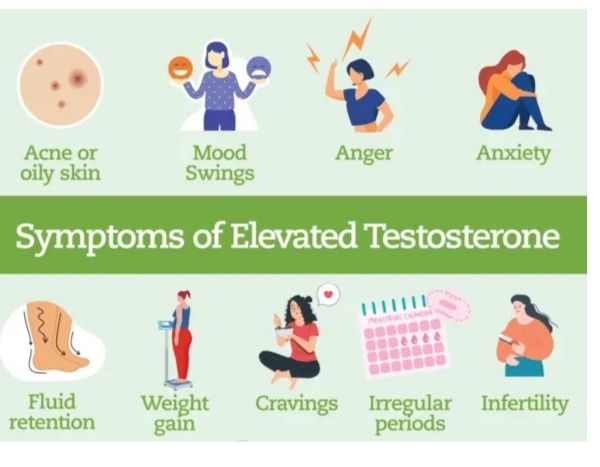
Testosterone is a naturally occurring hormone primarily associated with males, but females also produce it, albeit in smaller amounts. When testosterone levels in women become unusually high, it can l
Testosterone is a naturally occurring hormone primarily associated with males, but females also produce it, albeit in smaller amounts. When testosterone levels in women become unusually high, it can lead to a condition called hyperandrogenism. This hormonal imbalance can cause various symptoms, including irregular menstrual periods, acne, male-pattern hair growth (hirsutism), deepening of the voice, and mood changes. High testosterone levels in women may result from conditions such as polycystic ovary syndrome (PCOS) or adrenal gland disorders and may require medical evaluation and management.
Causes -
Several factors are responsible for the high testosterone levels in women. Let's check in detail.
1. Polycystic Ovary Syndrome (PCOS)
2. Congenital Adrenal Hyperplasia (CAH)
3. Tumours
4. Insulin Resistance
5. Obesity
6. Medications
7. Menopause
Symptoms of High Testosterone Levels in Women
The symptoms of high testosterone levels in women can vary widely and may include:
1. Experiencing irregular or absent periods.
2. Increased hair growth in areas where men typically grow hair, such as the face, chest, and back.
3. Acne and oily skin
4. Thinning hair on the scalp
5. Deepening of the voice
6. Increase in muscle mass etc.
Dietary Guidelines-
Diet to treat PCOD and PCOD-
1. Includes natural, unprocessed food in diet
2. Includes leafy vegetables, vegestables in diet
3. Includes high in fiber rich food
4. Includes Nuts and legumes in diet
5. Includes Whole grain food in diet
6. Include Low-fat dairy products in diet
Causes -
Several factors are responsible for the high testosterone levels in women. Let's check in detail.
1. Polycystic Ovary Syndrome (PCOS)
2. Congenital Adrenal Hyperplasia (CAH)
3. Tumours
4. Insulin Resistance
5. Obesity
6. Medications
7. Menopause
Symptoms of High Testosterone Levels in Women
The symptoms of high testosterone levels in women can vary widely and may include:
1. Experiencing irregular or absent periods.
2. Increased hair growth in areas where men typically grow hair, such as the face, chest, and back.
3. Acne and oily skin
4. Thinning hair on the scalp
5. Deepening of the voice
6. Increase in muscle mass etc.
Dietary Guidelines-
Diet to treat PCOD and PCOD-
1. Includes natural, unprocessed food in diet
2. Includes leafy vegetables, vegestables in diet
3. Includes high in fiber rich food
4. Includes Nuts and legumes in diet
5. Includes Whole grain food in diet
6. Include Low-fat dairy products in diet
Pulmonary Fibrosis
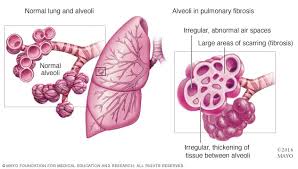
Pulmonary fibrosis is a lung disease that occurs when lung tissue becomes damaged and scarred. This thickened, stiff tissue makes it harder for the lungs to work properly. Pulmonary fibrosis worsens o
Pulmonary fibrosis is a lung disease that occurs when lung tissue becomes damaged and scarred. This thickened, stiff tissue makes it harder for the lungs to work properly. Pulmonary fibrosis worsens over time. Some people can stay stable for a long time, but the condition gets worse faster in others. As it gets worse, people become more and more short of breath.
Symptoms-
Symptoms of pulmonary fibrosis may include:
Shortness of breath.
Dry cough.
Extreme tiredness.
Weight loss that's not intended.
Aching muscles and joints.
Widening and rounding of the tips of the fingers or toes, called clubbing.
Causes-
Pulmonary fibrosis is scarring and thickening of the tissue around and between the air sacs called alveoli in the lungs. These changes make it harder for oxygen to pass into the bloodstream.Damage to the lungs that results in pulmonary fibrosis may be caused by many different things. Examples include long-term exposure to certain toxins, radiation therapy, some medicines and certain medical conditions. In some cases, the cause of pulmonary fibrosis is not known.
Dietary guidelines-
1. Eat a diet low in sodium (salt), added sugars, saturated and trans fat.
2. Try and get most of your calories from lean meats and fish, fruits, whole grains, beans, vegetables and low-fat dairy products.
3. If you are having a hard time gaining or maintaining your weight, try nutritional shakes or add healthy fats such as olive oil to your food.
4. If you have acid reflux, avoid acidic foods such as citrus, coffee and tomatoes. Do not eat within 3 hours of your bedtime. Talk with your doctor about
medication that can help.
5. Eat smaller, more frequent meals to avoid getting too full, which can make it harder to breathe.
6. Drink lots of water, especially when you are exercising.
7. Some medications may have diarrhea as a side effect. Eating a bland diet, made up of bananas, rice, applesauce and toast (sometimes called the BRAT diet),
can help.
Symptoms-
Symptoms of pulmonary fibrosis may include:
Shortness of breath.
Dry cough.
Extreme tiredness.
Weight loss that's not intended.
Aching muscles and joints.
Widening and rounding of the tips of the fingers or toes, called clubbing.
Causes-
Pulmonary fibrosis is scarring and thickening of the tissue around and between the air sacs called alveoli in the lungs. These changes make it harder for oxygen to pass into the bloodstream.Damage to the lungs that results in pulmonary fibrosis may be caused by many different things. Examples include long-term exposure to certain toxins, radiation therapy, some medicines and certain medical conditions. In some cases, the cause of pulmonary fibrosis is not known.
Dietary guidelines-
1. Eat a diet low in sodium (salt), added sugars, saturated and trans fat.
2. Try and get most of your calories from lean meats and fish, fruits, whole grains, beans, vegetables and low-fat dairy products.
3. If you are having a hard time gaining or maintaining your weight, try nutritional shakes or add healthy fats such as olive oil to your food.
4. If you have acid reflux, avoid acidic foods such as citrus, coffee and tomatoes. Do not eat within 3 hours of your bedtime. Talk with your doctor about
medication that can help.
5. Eat smaller, more frequent meals to avoid getting too full, which can make it harder to breathe.
6. Drink lots of water, especially when you are exercising.
7. Some medications may have diarrhea as a side effect. Eating a bland diet, made up of bananas, rice, applesauce and toast (sometimes called the BRAT diet),
can help.
Quinoa
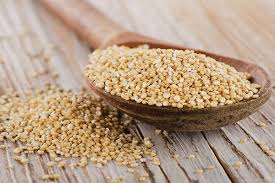
Quinoa (Chenopodium quinoa) is a flowering plant in the amaranth family. It is a herbaceous annual plant grown as a crop primarily for its edible seeds; the seeds are rich in protein, dietary fiber,
Quinoa (Chenopodium quinoa) is a flowering plant in the amaranth family. It is a herbaceous annual plant grown as a crop primarily for its edible seeds; the seeds are rich in protein, dietary fiber, B vitamins and dietary minerals.In the past couple of decades, quinoa’s popularity has grown exponentially as the demand for easy-to-grow, nutritious, gluten-free grain alternatives has soared.Not only is quinoa nutrient-dense, but it may offer health benefits, too.
Different types of quinoa include:
red
black
white
1 cup (185 grams) of cooked quinoa:
Calories: 222
Protein: 8 grams
Fat: 3.55 grams
Carbohydrates: 39 grams
Fiber: 5 grams
Quinoa is a good source of several important nutrients, including:
Magnesium
Manganese
Folate
Phosphorus
Copper
Iron
Zinc
Potassium
Vitamin B1
Riboflavin
Vitamin B6
Health Benefits-
Unlike most plant-based foods, quinoa is a complete protein, which means it contains all of the essential amino acids. Amino acids are the building blocks of the proteins that make up your muscles, bones, skin, and blood. The nine classified as “essential” must be obtained from food daily — your body cannot produce or store them — and quinoa provides all nine.
1. Disease Prevention-At least Half of the grains be whole grains like quinoa. Refined grains have been stripped of most of the fiber, iron, and vitamins present in
the whole grain. Including whole grains in your diet can help lower your risk of diabetes, heart disease, and cancer.
2. Digestive Health-Quinoa is a great source of fiber. Fiber can prevent or treat constipation and may lower your risk of intestinal cancers. It also helps you feel
full longer, so it may help with weight loss.
3. Heart Health-Maintaining a healthy weight is important for heart health. The fiber in quinoa can also help with cholesterol and blood sugar levels, lowering
your risk of diabetes and heart disease.
Different types of quinoa include:
red
black
white
1 cup (185 grams) of cooked quinoa:
Calories: 222
Protein: 8 grams
Fat: 3.55 grams
Carbohydrates: 39 grams
Fiber: 5 grams
Quinoa is a good source of several important nutrients, including:
Magnesium
Manganese
Folate
Phosphorus
Copper
Iron
Zinc
Potassium
Vitamin B1
Riboflavin
Vitamin B6
Health Benefits-
Unlike most plant-based foods, quinoa is a complete protein, which means it contains all of the essential amino acids. Amino acids are the building blocks of the proteins that make up your muscles, bones, skin, and blood. The nine classified as “essential” must be obtained from food daily — your body cannot produce or store them — and quinoa provides all nine.
1. Disease Prevention-At least Half of the grains be whole grains like quinoa. Refined grains have been stripped of most of the fiber, iron, and vitamins present in
the whole grain. Including whole grains in your diet can help lower your risk of diabetes, heart disease, and cancer.
2. Digestive Health-Quinoa is a great source of fiber. Fiber can prevent or treat constipation and may lower your risk of intestinal cancers. It also helps you feel
full longer, so it may help with weight loss.
3. Heart Health-Maintaining a healthy weight is important for heart health. The fiber in quinoa can also help with cholesterol and blood sugar levels, lowering
your risk of diabetes and heart disease.
Dyslipidemia
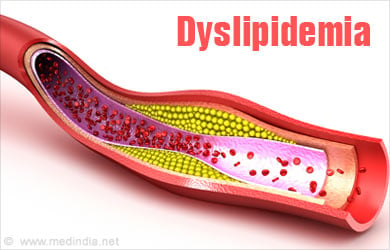
Dyslipidemia refers to abnormal or impaired levels of lipids in the bloodstream. It is defined as increased levels of total cholesterol, low-density lipoprotein (LDL), and triglycerides (TG) with decr
Dyslipidemia refers to abnormal or impaired levels of lipids in the bloodstream. It is defined as increased levels of total cholesterol, low-density lipoprotein (LDL), and triglycerides (TG) with decreased levels of high-density lipoprotein (HDL) in the bloodstream. The intestine absorbs lipids such as cholesterol or triglycerides and via lipoproteins, they are carried throughout the body for the purpose of energy, steroid production, or bile acid formation. Cholesterol, low-density lipoproteins, triglycerides, and high-density lipoproteins are important factors for the pathway. Any disturbance in the pathway or imbalance to any of the factors, whatever may be the reason may lead to dyslipidemia.
Symptoms-
ndividuals with dyslipidemia may have no symptoms, but some patients with severe dyslipidemia develop few signs and symptoms linked to atherosclerosis. Some of the common signs and symptoms of dyslipidemia are described below.
Xanthomas, which are yellowish deposits of fats appearing on the skin of eyelids, palms, tendons, or others indicating high serum levels of cholesterol or triglycerides.
Arcus senilis, which is common in elderly people, may occur in young patients appearing as grey or white rings around the eye cornea due to cholesterol depositing in the corneal margin indicating high cholesterol levels.
Lipemia retinalis is a rare condition causing a milky appearance in retinal vessels and blurred vision indicating severe hypertriglyceridemia.
Lower limb ischemia indicates high levels of low-density lipoproteins (LDL) cholesterol and triglycerides.
Angina is described as chest pain occurring due to a lack of oxygen-rich blood reaching the heart. It is a symptom of coronary artery disease caused by thickening or narrowing of blood vessels.
Transient ischemic attacks and strokes: Due to the narrowing of blood vessels, there is a sudden interruption blockage of blood flow to the brain. This blockage of blood supply to the brain is a stroke, transient ischemic attack is a temporary blockage of blood flow to the brain, often referred to as mini stroke.
Causes
Dyslipidemia has varied etiologies influenced by genetic, environmental, and lifestyle factors. It is categorized into primary and secondary based on etiology:
1. Primary dyslipidemia-
Genetic mutation
2. Secondary dyslipidemia-
Obesity
Diabetes
Chronic Kidney Disease
Excessive consumption of Alcohol
Smoking
Dietary Guidelines-
1. Choose foods of plant origin.
2. Pay attention to calories
3. Increase fiber in the diet
4. Choose unsaturated fat instead of saturated fat
5. Reduce alcohol intake or avoid it at all to help lower blood lipid levels.
6. Exercise regularly
Symptoms-
ndividuals with dyslipidemia may have no symptoms, but some patients with severe dyslipidemia develop few signs and symptoms linked to atherosclerosis. Some of the common signs and symptoms of dyslipidemia are described below.
Xanthomas, which are yellowish deposits of fats appearing on the skin of eyelids, palms, tendons, or others indicating high serum levels of cholesterol or triglycerides.
Arcus senilis, which is common in elderly people, may occur in young patients appearing as grey or white rings around the eye cornea due to cholesterol depositing in the corneal margin indicating high cholesterol levels.
Lipemia retinalis is a rare condition causing a milky appearance in retinal vessels and blurred vision indicating severe hypertriglyceridemia.
Lower limb ischemia indicates high levels of low-density lipoproteins (LDL) cholesterol and triglycerides.
Angina is described as chest pain occurring due to a lack of oxygen-rich blood reaching the heart. It is a symptom of coronary artery disease caused by thickening or narrowing of blood vessels.
Transient ischemic attacks and strokes: Due to the narrowing of blood vessels, there is a sudden interruption blockage of blood flow to the brain. This blockage of blood supply to the brain is a stroke, transient ischemic attack is a temporary blockage of blood flow to the brain, often referred to as mini stroke.
Causes
Dyslipidemia has varied etiologies influenced by genetic, environmental, and lifestyle factors. It is categorized into primary and secondary based on etiology:
1. Primary dyslipidemia-
Genetic mutation
2. Secondary dyslipidemia-
Obesity
Diabetes
Chronic Kidney Disease
Excessive consumption of Alcohol
Smoking
Dietary Guidelines-
1. Choose foods of plant origin.
2. Pay attention to calories
3. Increase fiber in the diet
4. Choose unsaturated fat instead of saturated fat
5. Reduce alcohol intake or avoid it at all to help lower blood lipid levels.
6. Exercise regularly
The Role of Nutrition in Immune System Support
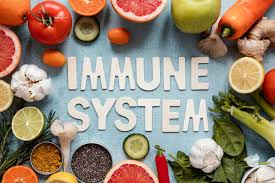
The immune system is a sophisticated network that works nonstop to defend the body from bacteria, viruses, toxins, and parasites, collectively known as antigens. Our immune system offers two layers of
The immune system is a sophisticated network that works nonstop to defend the body from bacteria, viruses, toxins, and parasites, collectively known as antigens. Our immune system offers two layers of defense namely innate immunity and adaptive immunity.Innate immunity is the primary line of defense, which is made up of physical barriers like the skin and mucous membranes as well as chemical and cellular defenses. Innate immunity is the defense we are born with and acts uniformly against all antigens. Our cough reflexes, skin, stomach acid, etc. are various forms of innate immunity.
The adaptive immune system on the other hand takes over if the innate immune system fails to counter a potential threat. Adaptive immunity is made up of specialized blood cells and proteins that target a particular infection’s cause. The adaptive immune system has a memory which is why, following initial exposure, the body develops an immunity to a particular form of illness.
To stay healthy, a person’s immune system must be in good working order. The immune system might face several adverse effects due to various lifestyle choices, such as excessive drinking, smoking, and sedentary life.
How Our Diet Influences Immune System-
1. Nutrition has a direct impact on the immune system’s function as it influences the microbiome, gut barrier function, inflammatory reactions, and white blood
cell function. There are links between dietary habits and specific foods that elevate illness risk and weaken immunological response.
2. Diets that tend to be heavy in calories such as ultra-processed foods, added sugar and salt, and saturated fat can lead to several chronic ailments. These diets
also cause inflammation and disrupt immune system operation, accelerating the onset of illness.
3. High consumption of soda, candy, sugary cereals, and sugary baked goods can lead to a spike in blood sugar levels which in turn increases the levels of
inflammatory proteins such as tumor necrosis factor-alpha (TNF-alpha), C-reactive protein (CRP), and interleukin-6 (IL-6). Additionally, they also disrupt the
operation of defense immunological cells including phagocytes and neutrophils.
4. On the other hand, diets high in whole foods, such as vegetables, fruits, nuts, legumes, and seafood, and non-processed foods cut the risk of diseases and aid
in maintaining a healthy immune system.
5. Lack of some nutrients such as vitamin D, zinc, and vitamin C, which are necessary for immunological function, might also impair immune response. The
relationship between nutrition and immunological health is extremely complex, even though it is obvious that dietary choices have an impact on overall
health, including immune function.
Ideal Diet for Better Immunity-
• A diet rich in nutrients as opposed to diets loaded with ultra-processed foods and added sugar as excessive calories is good for immune function. The latter is
one of the key disruptors of immunological function.
• Foods high in beneficial plant compounds, healthy fats, fiber, vitamins, proteins, and minerals lower systemic inflammation, promote healthy gut bacteria, cut
oxidative stress and cellular damage along with enhancing blood sugar and insulin sensitivity. These are all necessary for the proper functioning of the
immune system.
• Additionally, research suggests that adding vitamin D, zinc, and vitamin C to the diet can improve immune performance and lower the risk of illness. A person
should ideally focus on maintaining a balanced dietary pattern full of complete, nutrient-dense foods. This includes vegetables, fruits, legumes, nuts, and
seeds which have been proven to boost immunological function.
The adaptive immune system on the other hand takes over if the innate immune system fails to counter a potential threat. Adaptive immunity is made up of specialized blood cells and proteins that target a particular infection’s cause. The adaptive immune system has a memory which is why, following initial exposure, the body develops an immunity to a particular form of illness.
To stay healthy, a person’s immune system must be in good working order. The immune system might face several adverse effects due to various lifestyle choices, such as excessive drinking, smoking, and sedentary life.
How Our Diet Influences Immune System-
1. Nutrition has a direct impact on the immune system’s function as it influences the microbiome, gut barrier function, inflammatory reactions, and white blood
cell function. There are links between dietary habits and specific foods that elevate illness risk and weaken immunological response.
2. Diets that tend to be heavy in calories such as ultra-processed foods, added sugar and salt, and saturated fat can lead to several chronic ailments. These diets
also cause inflammation and disrupt immune system operation, accelerating the onset of illness.
3. High consumption of soda, candy, sugary cereals, and sugary baked goods can lead to a spike in blood sugar levels which in turn increases the levels of
inflammatory proteins such as tumor necrosis factor-alpha (TNF-alpha), C-reactive protein (CRP), and interleukin-6 (IL-6). Additionally, they also disrupt the
operation of defense immunological cells including phagocytes and neutrophils.
4. On the other hand, diets high in whole foods, such as vegetables, fruits, nuts, legumes, and seafood, and non-processed foods cut the risk of diseases and aid
in maintaining a healthy immune system.
5. Lack of some nutrients such as vitamin D, zinc, and vitamin C, which are necessary for immunological function, might also impair immune response. The
relationship between nutrition and immunological health is extremely complex, even though it is obvious that dietary choices have an impact on overall
health, including immune function.
Ideal Diet for Better Immunity-
• A diet rich in nutrients as opposed to diets loaded with ultra-processed foods and added sugar as excessive calories is good for immune function. The latter is
one of the key disruptors of immunological function.
• Foods high in beneficial plant compounds, healthy fats, fiber, vitamins, proteins, and minerals lower systemic inflammation, promote healthy gut bacteria, cut
oxidative stress and cellular damage along with enhancing blood sugar and insulin sensitivity. These are all necessary for the proper functioning of the
immune system.
• Additionally, research suggests that adding vitamin D, zinc, and vitamin C to the diet can improve immune performance and lower the risk of illness. A person
should ideally focus on maintaining a balanced dietary pattern full of complete, nutrient-dense foods. This includes vegetables, fruits, legumes, nuts, and
seeds which have been proven to boost immunological function.
Binge-eating Disorder
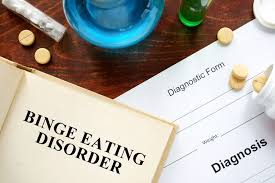
Binge-eating disorder is a serious condition. It always involves feeling like you're not able to stop eating. It also often involves eating much larger than usual amounts of food.Almost everyone overe
Binge-eating disorder is a serious condition. It always involves feeling like you're not able to stop eating. It also often involves eating much larger than usual amounts of food.Almost everyone overeats on occasion, such as having seconds or thirds of a holiday meal. But regularly feeling that eating is out of control and eating an unusually large amount of food may be symptoms of binge-eating disorder.People who have binge-eating disorder often feel embarrassed or ashamed about eating binges. People with the disorder often go through periods of trying to restrict or severely cut back on their eating as a result. But this instead may increase urges to eat and lead to a cycle of ongoing binge eating. Treatment for binge-eating disorder can help people feel more in control and balanced with their eating.
Symptoms-
Feeling that you don't have control over your eating behavior, for example, you can't stop once you start.
Often eating much larger than usual amounts of food in a specific amount of time, such as over a two-hour period.
Eating even when you're full or not hungry.
Eating very fast during eating binges.
Eating until you're uncomfortably full.
Often eating alone or in secret.
Feeling depressed, disgusted, ashamed, guilty or upset about your eating.
Causes-
The causes of binge-eating disorder are not known. But certain genes, how your body works, long-term dieting and the presence of other mental health conditions increase your risk.
Treatment-
The goal for treatment of binge-eating disorder is to have healthy, regular eating habits. Because binge eating often involves shame, poor body self-image and other negative emotions, treatment also addresses these and related mental health conditions, such as depression. By getting help for binge eating, you can learn how to feel more in control of your eating.Treatment of binge-eating disorder may be done by a team of specialists. The team can include doctors and other healthcare professionals, mental health professionals, and dietitians, all with experience in eating disorders.
Symptoms-
Feeling that you don't have control over your eating behavior, for example, you can't stop once you start.
Often eating much larger than usual amounts of food in a specific amount of time, such as over a two-hour period.
Eating even when you're full or not hungry.
Eating very fast during eating binges.
Eating until you're uncomfortably full.
Often eating alone or in secret.
Feeling depressed, disgusted, ashamed, guilty or upset about your eating.
Causes-
The causes of binge-eating disorder are not known. But certain genes, how your body works, long-term dieting and the presence of other mental health conditions increase your risk.
Treatment-
The goal for treatment of binge-eating disorder is to have healthy, regular eating habits. Because binge eating often involves shame, poor body self-image and other negative emotions, treatment also addresses these and related mental health conditions, such as depression. By getting help for binge eating, you can learn how to feel more in control of your eating.Treatment of binge-eating disorder may be done by a team of specialists. The team can include doctors and other healthcare professionals, mental health professionals, and dietitians, all with experience in eating disorders.
Juvenile Diabetes

Juvenile diabetes, is an autoimmune disease that occurs when pancreatic cells (beta cells) are destroyed by the body's immune system.[5] In healthy persons, beta cells produce insulin. Insulin is a ho
Juvenile diabetes, is an autoimmune disease that occurs when pancreatic cells (beta cells) are destroyed by the body's immune system.[5] In healthy persons, beta cells produce insulin. Insulin is a hormone required by the body to store and convert blood sugar into energy.
Symptoms-
Feeling more thirsty than usual
Urinating a lot
Bed-wetting in children who have never wet the bed during the night
Feeling very hungry
Losing weight without trying
Feeling irritable or having other mood changes
Feeling tired and weak
Having blurry vision
Causes-
The exact cause of type 1 diabetes is unknown. Usually, the body's own immune system — which normally fights harmful bacteria and viruses — destroys the insulin-producing (islet) cells in the pancreas. Other possible causes include:
1. Genetics
2. Exposure to viruses and other environmental factors
Lifestyle changes for children with type 1 diabetes
a. Dietary management-
Monitor carbohydrate intake
Consume food rich in dietary fiber and low glycemic load
Limit saturated fat
Avoid sugary foods and processed foods
b. Physical activity and body weight management-
Manage body weight with proper diet and exercises
60 minutes of aerobic activity daily
Muscle and bone strengthening exercise at least three days per week
Symptoms-
Feeling more thirsty than usual
Urinating a lot
Bed-wetting in children who have never wet the bed during the night
Feeling very hungry
Losing weight without trying
Feeling irritable or having other mood changes
Feeling tired and weak
Having blurry vision
Causes-
The exact cause of type 1 diabetes is unknown. Usually, the body's own immune system — which normally fights harmful bacteria and viruses — destroys the insulin-producing (islet) cells in the pancreas. Other possible causes include:
1. Genetics
2. Exposure to viruses and other environmental factors
Lifestyle changes for children with type 1 diabetes
a. Dietary management-
Monitor carbohydrate intake
Consume food rich in dietary fiber and low glycemic load
Limit saturated fat
Avoid sugary foods and processed foods
b. Physical activity and body weight management-
Manage body weight with proper diet and exercises
60 minutes of aerobic activity daily
Muscle and bone strengthening exercise at least three days per week
Laryngopharyngeal Reflux (LPR)
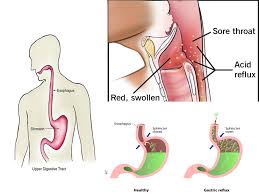
What is laryngopharyngeal reflux (LPR)?
Laryngopharyngeal (“la-Ring-go-fa-Rin-jee-al”) reflux, or LPR, is a special type of acid reflux. Acid reflux occurs when stomach juices (including acid) ri
Laryngopharyngeal (“la-Ring-go-fa-Rin-jee-al”) reflux, or LPR, is a special type of acid reflux. Acid reflux occurs when stomach juices (including acid) ri
What is laryngopharyngeal reflux (LPR)?
Laryngopharyngeal (“la-Ring-go-fa-Rin-jee-al”) reflux, or LPR, is a special type of acid reflux. Acid reflux occurs when stomach juices (including acid) rise from your stomach into your esophagus (swallowing tube). Symptoms of acid reflux usually affect your lower esophagus, within your chest. But if you have LPR, the reflux has a habit of creeping higher up, into your larynx (voice box) and pharynx (throat).
LPR vs. GERD — what’s the difference?
GERD stands for gastroesophageal reflux disease, otherwise known as chronic acid reflux. This is what we call it when stomach acid routinely rises into your esophagus, which runs from your throat down to your stomach. GERD more often affects your lower esophagus, while LPR reaches higher up in your throat. Some people have LPR in addition to GERD, but other people only have LPR symptoms.
Symptoms-
Hoarseness and/or lowering of your voice register.
A lump or a feeling of something stuck in your throat.
Throat clearing.
Chronic cough.
Excessive mucus or phlegm.
Difficulty swallowing.
Chronic sore throat.
Laryngitis (inflammation of your vocal cords or losing your voice).
Wheezing.
Postnasal drip.
Frequent upper respiratory infections.
New or worsening asthma.
Causes-
For gastric juices to travel from your stomach all the way up through your esophagus and into your throat, they have to get past two important guards. These are your upper and lower esophageal sphincters — the muscular valves that seal off your esophagus at the top and bottom. The lower one separates your esophagus and stomach, while the upper one separates your esophagus and throat.
Normal acid reflux happens when something weakens your lower esophageal sphincter (LES), allowing stomach juices to flow back up into your esophagus. LPR happens when your upper esophageal sphincter (UES) also relaxes inappropriately. This allows reflux that’s already in your esophagus to creep up higher into your throat. Different things can affect these two sphincters and cause them to relax.
Food To be avoided-
1. Avoid unhealthy Fats like Ghee , Vanaspati, Margarine, Butter etc.
2. Avoid fried Foods likes chips, French fries, Samosa, Bajji, Papad, Patties
3. Avoid cheese, Mayonnaise, jam, jelly, Sauce
4. Avoid fast food like Pizza, Burger, Pasta, Rolls, Maggi
5. Avoid Pastries, Cakes, Cookies, ice-cream, Packed Fruit juices, Chocolates
6. Avoid Sodas , Carbonated drinks
7. Avoid alcoholic beverages, Malted beverages like (horlics, complain, Milo, Boost)
8. Avoid food with lots of preservatives like canned food, ready to eat food
9. Avoid sugars, artificial sweetners.
10. Avoid Baking soda, Pickles, Baking powder
11. Avoid fruits like Oranges, Sweet lime, Kiwi, Pineapple, Grapes, All type of berries, lemons etc.
12. Avoid vegetables like Tomatoes, Radish, Brinjal, Garlic
13. Reduce the intake of Onion .
14. Avoid Tea, Coffee, Chocolates
15. Aviod spicy foods
Dietary guidelines-
1. Include Green leavey Vegetsbles in diet
2. Include carbohydrate food like brown rice, oats, wheat flour, ragi flour in diet.
3. Include fruits like melons, apple, guava, Pears, Banana in diet.
4. Intake of coconut water help to reduce the symtoms.
5. It is recommended to walk for 20 minutes daily.
Laryngopharyngeal (“la-Ring-go-fa-Rin-jee-al”) reflux, or LPR, is a special type of acid reflux. Acid reflux occurs when stomach juices (including acid) rise from your stomach into your esophagus (swallowing tube). Symptoms of acid reflux usually affect your lower esophagus, within your chest. But if you have LPR, the reflux has a habit of creeping higher up, into your larynx (voice box) and pharynx (throat).
LPR vs. GERD — what’s the difference?
GERD stands for gastroesophageal reflux disease, otherwise known as chronic acid reflux. This is what we call it when stomach acid routinely rises into your esophagus, which runs from your throat down to your stomach. GERD more often affects your lower esophagus, while LPR reaches higher up in your throat. Some people have LPR in addition to GERD, but other people only have LPR symptoms.
Symptoms-
Hoarseness and/or lowering of your voice register.
A lump or a feeling of something stuck in your throat.
Throat clearing.
Chronic cough.
Excessive mucus or phlegm.
Difficulty swallowing.
Chronic sore throat.
Laryngitis (inflammation of your vocal cords or losing your voice).
Wheezing.
Postnasal drip.
Frequent upper respiratory infections.
New or worsening asthma.
Causes-
For gastric juices to travel from your stomach all the way up through your esophagus and into your throat, they have to get past two important guards. These are your upper and lower esophageal sphincters — the muscular valves that seal off your esophagus at the top and bottom. The lower one separates your esophagus and stomach, while the upper one separates your esophagus and throat.
Normal acid reflux happens when something weakens your lower esophageal sphincter (LES), allowing stomach juices to flow back up into your esophagus. LPR happens when your upper esophageal sphincter (UES) also relaxes inappropriately. This allows reflux that’s already in your esophagus to creep up higher into your throat. Different things can affect these two sphincters and cause them to relax.
Food To be avoided-
1. Avoid unhealthy Fats like Ghee , Vanaspati, Margarine, Butter etc.
2. Avoid fried Foods likes chips, French fries, Samosa, Bajji, Papad, Patties
3. Avoid cheese, Mayonnaise, jam, jelly, Sauce
4. Avoid fast food like Pizza, Burger, Pasta, Rolls, Maggi
5. Avoid Pastries, Cakes, Cookies, ice-cream, Packed Fruit juices, Chocolates
6. Avoid Sodas , Carbonated drinks
7. Avoid alcoholic beverages, Malted beverages like (horlics, complain, Milo, Boost)
8. Avoid food with lots of preservatives like canned food, ready to eat food
9. Avoid sugars, artificial sweetners.
10. Avoid Baking soda, Pickles, Baking powder
11. Avoid fruits like Oranges, Sweet lime, Kiwi, Pineapple, Grapes, All type of berries, lemons etc.
12. Avoid vegetables like Tomatoes, Radish, Brinjal, Garlic
13. Reduce the intake of Onion .
14. Avoid Tea, Coffee, Chocolates
15. Aviod spicy foods
Dietary guidelines-
1. Include Green leavey Vegetsbles in diet
2. Include carbohydrate food like brown rice, oats, wheat flour, ragi flour in diet.
3. Include fruits like melons, apple, guava, Pears, Banana in diet.
4. Intake of coconut water help to reduce the symtoms.
5. It is recommended to walk for 20 minutes daily.
Chronic obstructive pulmonary disease (COPD)

Chronic obstructive pulmonary disease (COPD) is an ongoing lung condition caused by damage to the lungs. The damage results in swelling and irritation, also called inflammation, inside the airways tha
Chronic obstructive pulmonary disease (COPD) is an ongoing lung condition caused by damage to the lungs. The damage results in swelling and irritation, also called inflammation, inside the airways that limit airflow into and out of the lungs. This limited airflow is known as obstruction. Symptoms include trouble breathing, a daily cough that brings up mucus and a tight, whistling sound in the lungs called wheezing.
Symptoms-
Trouble catching your breath, especially during physical activities.
Wheezing or whistling sounds when breathing.
Ongoing cough that may bring up a lot of mucus. The mucus may be clear, white, yellow or greenish.
Chest tightness or heaviness.
Lack of energy or feeling very tired.
Frequent lung infections.
Losing weight without meaning to. This may happen as the condition worsens.
Swelling in ankles, feet or legs.
Causes-
Emphysema
Chronic bronchitis
Cigarette smoke and other irritants
Alpha-1-antitrypsin deficiency
Dietary Guidelines-
1. Choose complex carbohydrates, such as whole-grain bread and pasta, fresh fruits and vegetables.
2. Choose a variety of whole-grain carbohydrates and fresh fruits and vegetables.
3. Eat 20 to 30 grams of fiber each day.
4. Choose a good source of protein at least twice a day to help maintain strong respiratory muscles. Good choices include milk, cheese,nuts and dried beans or
peas.
5. Choose mono- and poly-unsaturated fats, which do not contain cholesterol. These are fats that are often liquid at room temperature and come from plant
sources, such as canola, safflower and corn oils.
6. Limit foods that contain trans fats and saturated fat. For example, butter, lard, fat and skin from meat, hydrogenated vegetable oils, shortening, fried foods,
cookies, crackers and pastries.
Symptoms-
Trouble catching your breath, especially during physical activities.
Wheezing or whistling sounds when breathing.
Ongoing cough that may bring up a lot of mucus. The mucus may be clear, white, yellow or greenish.
Chest tightness or heaviness.
Lack of energy or feeling very tired.
Frequent lung infections.
Losing weight without meaning to. This may happen as the condition worsens.
Swelling in ankles, feet or legs.
Causes-
Emphysema
Chronic bronchitis
Cigarette smoke and other irritants
Alpha-1-antitrypsin deficiency
Dietary Guidelines-
1. Choose complex carbohydrates, such as whole-grain bread and pasta, fresh fruits and vegetables.
2. Choose a variety of whole-grain carbohydrates and fresh fruits and vegetables.
3. Eat 20 to 30 grams of fiber each day.
4. Choose a good source of protein at least twice a day to help maintain strong respiratory muscles. Good choices include milk, cheese,nuts and dried beans or
peas.
5. Choose mono- and poly-unsaturated fats, which do not contain cholesterol. These are fats that are often liquid at room temperature and come from plant
sources, such as canola, safflower and corn oils.
6. Limit foods that contain trans fats and saturated fat. For example, butter, lard, fat and skin from meat, hydrogenated vegetable oils, shortening, fried foods,
cookies, crackers and pastries.
Gastritis
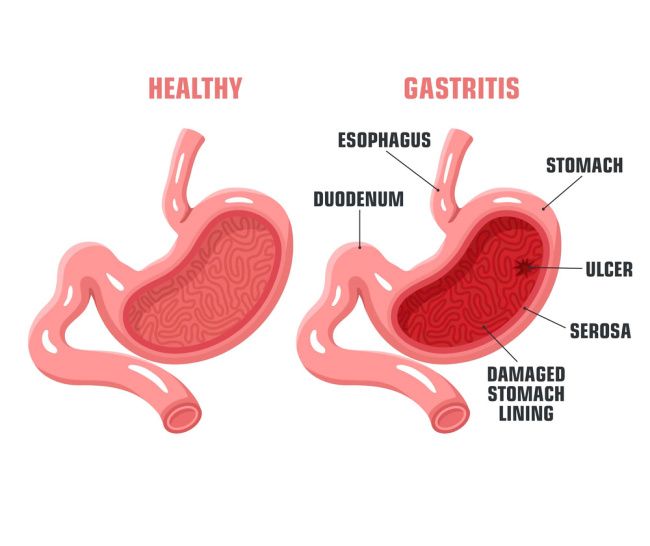
Gastritis is a general term for a group of conditions with one thing in common: Inflammation of the lining of the stomach. The inflammation of gastritis is most often the result of infection with the
Gastritis is a general term for a group of conditions with one thing in common: Inflammation of the lining of the stomach. The inflammation of gastritis is most often the result of infection with the same bacterium that causes most stomach ulcers or the regular use of certain pain relievers. Drinking too much alcohol also can contribute to gastritis.
Symptoms-
Gnawing or burning ache or pain, called indigestion, in your upper belly. This feeling may become either worse or better after eating.
Nausea.
Vomiting.
A feeling of fullness in your upper abdomen after eating.
Causes-
Gastritis is an inflammation of the stomach lining. The stomach lining is a mucus-lined barrier that protects the stomach wall. Weaknesses or injury to the barrier allows digestive juices to damage and inflame the stomach lining. Several diseases and conditions can increase the risk of gastritis. These include inflammatory conditions, such as Crohn's disease.
Dietary Guidelines-
1. High-fiber foods: Opt for fruits, vegetables, whole grains, legumes, and nuts. These are gentle on the stomach and help regulate digestion.
2. Lean proteins: Include tofu, and beans as they are low in fat and easily digestible.
3. Low-fat dairy products: Choose skim milk, yogurt, and low-fat cheeses to maintain calcium intake without excessive fat.
4. Healthy fats: Incorporate sources like avocados, olive oil, nuts, and seeds in moderation. These provide essential nutrients without triggering symptoms.
5. Probiotic-rich foods: Consume fermented foods such as yogurt, kefir, sauerkraut, and kimchi. They promote a healthy gut microbiome and aid digestion.
6. Ginger: This natural anti-inflammatory can help relieve nausea and soothe the stomach. Enjoy ginger tea or add it to your meals.
7. Fruits and Vegetables: Opt for non-acidic fruits such as bananas, melons, and papayas, as well as cooked or steamed vegetables like carrots, spinach, and
sweet potatoes.
Symptoms-
Gnawing or burning ache or pain, called indigestion, in your upper belly. This feeling may become either worse or better after eating.
Nausea.
Vomiting.
A feeling of fullness in your upper abdomen after eating.
Causes-
Gastritis is an inflammation of the stomach lining. The stomach lining is a mucus-lined barrier that protects the stomach wall. Weaknesses or injury to the barrier allows digestive juices to damage and inflame the stomach lining. Several diseases and conditions can increase the risk of gastritis. These include inflammatory conditions, such as Crohn's disease.
Dietary Guidelines-
1. High-fiber foods: Opt for fruits, vegetables, whole grains, legumes, and nuts. These are gentle on the stomach and help regulate digestion.
2. Lean proteins: Include tofu, and beans as they are low in fat and easily digestible.
3. Low-fat dairy products: Choose skim milk, yogurt, and low-fat cheeses to maintain calcium intake without excessive fat.
4. Healthy fats: Incorporate sources like avocados, olive oil, nuts, and seeds in moderation. These provide essential nutrients without triggering symptoms.
5. Probiotic-rich foods: Consume fermented foods such as yogurt, kefir, sauerkraut, and kimchi. They promote a healthy gut microbiome and aid digestion.
6. Ginger: This natural anti-inflammatory can help relieve nausea and soothe the stomach. Enjoy ginger tea or add it to your meals.
7. Fruits and Vegetables: Opt for non-acidic fruits such as bananas, melons, and papayas, as well as cooked or steamed vegetables like carrots, spinach, and
sweet potatoes.
Probiotics & Prebiotics
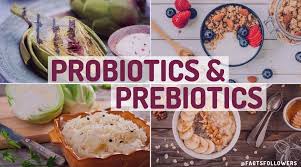
What are probiotics and prebiotics?
Probiotics are foods or supplements that contain live microorganisms intended to maintain or improve the "good" bacteria (normal microflora) in the body. Prebiotic
Probiotics are foods or supplements that contain live microorganisms intended to maintain or improve the "good" bacteria (normal microflora) in the body. Prebiotic
What are probiotics and prebiotics?
Probiotics are foods or supplements that contain live microorganisms intended to maintain or improve the "good" bacteria (normal microflora) in the body. Prebiotics are foods (typically high-fiber foods) that act as food for human microflora.Prebiotics are used with the intention of improving the balance of these microorganisms.
Probiotcs foods-
Yogurt
Kefir
Sauerkraut
Tempeh
Kimchi
Miso
Kombucha
Pickles
Traditional buttermilk
Natto
Prebiotic Foods-
Chicory root
Dandelion greens
Garlic
Onions
Asparagus
Bananas
Barley
Oats
Apples
Health benefits of Probiotics-
1. Help to improve gut health.
2. Help to boost and enhance immunity
3. Improved Digestive Health
4. Reduced Symptoms of Anxiety and Depression
5. Lowered Risk of Certain Allergies
6. Better Nutrient Absorption
7. Help in weight Management
8. Improved Skin Health
9. Help to treat diarrhea
Heath benefits of Prebiotics-
1. Improve digestion and metabolism
2. Help regulate bowel movements
3. Improve calcium absorption and increase bone density
4. Regulate blood sugar and insulin resistance
5. Stimulate the production of hormones that aid in appetite suppression
6. Lower inflammation in the body
7. Strengthen the immune system
8. Help balance and maintain hormone levels
9. Reduce risk of allergy
10. Lower the risk of cardiovascular disease
11. Regulate moods and reduce stress hormone levels
12. Lower cholesterol level
13.Reduce risk of colon cancer
Probiotics are foods or supplements that contain live microorganisms intended to maintain or improve the "good" bacteria (normal microflora) in the body. Prebiotics are foods (typically high-fiber foods) that act as food for human microflora.Prebiotics are used with the intention of improving the balance of these microorganisms.
Probiotcs foods-
Yogurt
Kefir
Sauerkraut
Tempeh
Kimchi
Miso
Kombucha
Pickles
Traditional buttermilk
Natto
Prebiotic Foods-
Chicory root
Dandelion greens
Garlic
Onions
Asparagus
Bananas
Barley
Oats
Apples
Health benefits of Probiotics-
1. Help to improve gut health.
2. Help to boost and enhance immunity
3. Improved Digestive Health
4. Reduced Symptoms of Anxiety and Depression
5. Lowered Risk of Certain Allergies
6. Better Nutrient Absorption
7. Help in weight Management
8. Improved Skin Health
9. Help to treat diarrhea
Heath benefits of Prebiotics-
1. Improve digestion and metabolism
2. Help regulate bowel movements
3. Improve calcium absorption and increase bone density
4. Regulate blood sugar and insulin resistance
5. Stimulate the production of hormones that aid in appetite suppression
6. Lower inflammation in the body
7. Strengthen the immune system
8. Help balance and maintain hormone levels
9. Reduce risk of allergy
10. Lower the risk of cardiovascular disease
11. Regulate moods and reduce stress hormone levels
12. Lower cholesterol level
13.Reduce risk of colon cancer
Attention Deficit Hyperactivity Disorder (ADHD)

What Is ADHD?
ADHD stands for attention deficit hyperactivity disorder. It’s a brain disorder that affects how you pay attention, sit still, and control your behavior. It happens in children and te
ADHD stands for attention deficit hyperactivity disorder. It’s a brain disorder that affects how you pay attention, sit still, and control your behavior. It happens in children and te
What Is ADHD?
ADHD stands for attention deficit hyperactivity disorder. It’s a brain disorder that affects how you pay attention, sit still, and control your behavior. It happens in children and teens and can continue into adulthood. ADHD is one of the most commonly diagnosed mental disorders in children. It’s usually spotted during the early school years, when a child begins to have problems paying attention. ADHD can't be prevented or cured. But spotting it early, plus having a good treatment and education plan, can help.
Symptoms-
In Child-
A child with inattentive ADHD may:
Be easily distracted
Have trouble following directions or finishing tasks
Have poor listening skills
Have trouble paying attention
Make careless mistakes
Forget things easily
Have problems organizing daily tasks
Have trouble sitting still
Often lose things
Daydream a lot
A child with with this type of ADHD may:
Often squirm, fidget, or bounce when sitting
Have trouble staying seated
Not be able to play quietly by themselves
Always be moving, such as running or climbing on things
Talk excessively
Have trouble waiting for their turn
Blurt out answers
Interrupt others
In Adult-
Often being late or forgetting things
Restlessness
Trouble controlling anger
Impulsiveness
Trouble staying organized
Procrastination
Easily frustrated
Often bored
Trouble concentrating when reading
Mood swings
Depression
Causes-
Had a brain injury
Were born to a mother who smoked or drank while she was pregnant
Had a low birth weight or were born early
Were exposed to lead or other toxic environmental substances before you were born or as a child
Foods to be Included-
1. A high-protein diet. Beans, cheese and nuts can be good sources of protein. Eat these kinds of foods in the morning and for after-school snacks. It may
improve concentration and possibly make ADHD medications work longer.
2. More complex carbohydrates. Body needs carbohydrates because it converts them into glucose to use for energy. Carbs are made up of chains of sugar molecules, and they are either simple or complex in structure. Load up on vegetables and some fruits, including oranges, tangerines, pears, grapefruits, apples, and kiwis. Eat this type of food in the evening, and it may help you sleep.
3. More omega-3 fatty acids.Walnuts, Brazil nuts, and olive and canola oils are other foods with omega-3 fatty acids. You could also take an omega-3 fatty acid supplement.
Food to be Avoided-
1. Sugary foods
2. Simple carbs
3. Unhealthy fats
4. Caffeine
ADHD stands for attention deficit hyperactivity disorder. It’s a brain disorder that affects how you pay attention, sit still, and control your behavior. It happens in children and teens and can continue into adulthood. ADHD is one of the most commonly diagnosed mental disorders in children. It’s usually spotted during the early school years, when a child begins to have problems paying attention. ADHD can't be prevented or cured. But spotting it early, plus having a good treatment and education plan, can help.
Symptoms-
In Child-
A child with inattentive ADHD may:
Be easily distracted
Have trouble following directions or finishing tasks
Have poor listening skills
Have trouble paying attention
Make careless mistakes
Forget things easily
Have problems organizing daily tasks
Have trouble sitting still
Often lose things
Daydream a lot
A child with with this type of ADHD may:
Often squirm, fidget, or bounce when sitting
Have trouble staying seated
Not be able to play quietly by themselves
Always be moving, such as running or climbing on things
Talk excessively
Have trouble waiting for their turn
Blurt out answers
Interrupt others
In Adult-
Often being late or forgetting things
Restlessness
Trouble controlling anger
Impulsiveness
Trouble staying organized
Procrastination
Easily frustrated
Often bored
Trouble concentrating when reading
Mood swings
Depression
Causes-
Had a brain injury
Were born to a mother who smoked or drank while she was pregnant
Had a low birth weight or were born early
Were exposed to lead or other toxic environmental substances before you were born or as a child
Foods to be Included-
1. A high-protein diet. Beans, cheese and nuts can be good sources of protein. Eat these kinds of foods in the morning and for after-school snacks. It may
improve concentration and possibly make ADHD medications work longer.
2. More complex carbohydrates. Body needs carbohydrates because it converts them into glucose to use for energy. Carbs are made up of chains of sugar molecules, and they are either simple or complex in structure. Load up on vegetables and some fruits, including oranges, tangerines, pears, grapefruits, apples, and kiwis. Eat this type of food in the evening, and it may help you sleep.
3. More omega-3 fatty acids.Walnuts, Brazil nuts, and olive and canola oils are other foods with omega-3 fatty acids. You could also take an omega-3 fatty acid supplement.
Food to be Avoided-
1. Sugary foods
2. Simple carbs
3. Unhealthy fats
4. Caffeine
Hemochromatosis
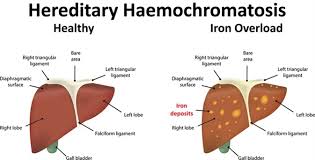
Hemochromatosis causes when body absorb too much iron from the food you eat. Excess iron is stored in your organs, especially your liver, heart and pancreas. Too much iron can lead to life-threatenin
Hemochromatosis causes when body absorb too much iron from the food you eat. Excess iron is stored in your organs, especially your liver, heart and pancreas. Too much iron can lead to life-threatening conditions, such as liver disease, heart problems and diabetes.
Symptoms-
Symptoms may include:
Joint pain.
Abdominal pain.
Fatigue.
Weakness.
Diabetes.
Impotence.
Heart failure.
Liver failure.
Bronze or gray skin color.
Memory fog.
Causes-
Hemochromatosis is most often caused by a change in a gene. This gene controls the amount of iron your body absorbs from food. The altered gene is passed from parents to children. This type of hemochromatosis is by far the most common type. It's called hereditary hemochromatosis.
Dietaty Guidelines-
1. Include fruits and vegetables in diet. Some fruits and vegetables, including spinach, mushrooms, and olives, are high in nonheme iron. However, as nonheme
iron is harder for the body to absorb, they are less likely to affect iron levels significantly.
2. Add, soy proteins, such as tofu, tempeh, soybeans, soy milk, and edamame beans can help to inhibit iron absorption.
3. Wholegrains contain phytates, which can make it difficult for the body to absorb iron.
4. Tea and coffee contain tannins, which are types of polyphenol plant compounds.The tannins in tea and coffee may reduce iron absorption. Drinking these beverages is another way for people with hemochromatosis to manage their iron levels.
Symptoms-
Symptoms may include:
Joint pain.
Abdominal pain.
Fatigue.
Weakness.
Diabetes.
Impotence.
Heart failure.
Liver failure.
Bronze or gray skin color.
Memory fog.
Causes-
Hemochromatosis is most often caused by a change in a gene. This gene controls the amount of iron your body absorbs from food. The altered gene is passed from parents to children. This type of hemochromatosis is by far the most common type. It's called hereditary hemochromatosis.
Dietaty Guidelines-
1. Include fruits and vegetables in diet. Some fruits and vegetables, including spinach, mushrooms, and olives, are high in nonheme iron. However, as nonheme
iron is harder for the body to absorb, they are less likely to affect iron levels significantly.
2. Add, soy proteins, such as tofu, tempeh, soybeans, soy milk, and edamame beans can help to inhibit iron absorption.
3. Wholegrains contain phytates, which can make it difficult for the body to absorb iron.
4. Tea and coffee contain tannins, which are types of polyphenol plant compounds.The tannins in tea and coffee may reduce iron absorption. Drinking these beverages is another way for people with hemochromatosis to manage their iron levels.
Cholangitis
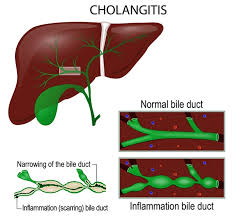
What is Cholangitis?
Cholangitis is swelling (inflammation) of the bile duct system that results from infection.The bile duct system carries bile from your liver and gallbladder into the first part o
Cholangitis is swelling (inflammation) of the bile duct system that results from infection.The bile duct system carries bile from your liver and gallbladder into the first part o
What is Cholangitis?
Cholangitis is swelling (inflammation) of the bile duct system that results from infection.The bile duct system carries bile from your liver and gallbladder into the first part of your small intestine (the duodenum).In most cases, cholangitis is caused by a bacterial infection. The infection often happens suddenly (acute). But in some cases, it may be long-term (chronic).
What causes cholangitis?
Lumps of solid material (gallstones)
A tumor
Blood clots
A narrowing of a duct that may happen after surgery
Swollen pancreas
Inflammatory conditions of the liver and bile ducts
A parasite infection
Trauma to the belly (abdomen)
Symptoms-
Symptoms may include:
Pain in the upper right part of your belly (abdomen)
Fever
Chills
Loss of appetite
Yellowing of the skin and eyes (jaundice)
Nausea and vomiting
Clay-colored stools
Dark urine
Low blood pressure
Lethargy
Dietary guidelines-
1. Choose lots of fruits and vegetables.
2. Choose unsaturated fats like Omega 3s, extra virgin olive oil, nuts.
3. Choose whole grains and complex carbohydrates. Whether it’s cereal, crackers, breads or rice, always choose the whole grain variety.
Cholangitis is swelling (inflammation) of the bile duct system that results from infection.The bile duct system carries bile from your liver and gallbladder into the first part of your small intestine (the duodenum).In most cases, cholangitis is caused by a bacterial infection. The infection often happens suddenly (acute). But in some cases, it may be long-term (chronic).
What causes cholangitis?
Lumps of solid material (gallstones)
A tumor
Blood clots
A narrowing of a duct that may happen after surgery
Swollen pancreas
Inflammatory conditions of the liver and bile ducts
A parasite infection
Trauma to the belly (abdomen)
Symptoms-
Symptoms may include:
Pain in the upper right part of your belly (abdomen)
Fever
Chills
Loss of appetite
Yellowing of the skin and eyes (jaundice)
Nausea and vomiting
Clay-colored stools
Dark urine
Low blood pressure
Lethargy
Dietary guidelines-
1. Choose lots of fruits and vegetables.
2. Choose unsaturated fats like Omega 3s, extra virgin olive oil, nuts.
3. Choose whole grains and complex carbohydrates. Whether it’s cereal, crackers, breads or rice, always choose the whole grain variety.
Almond milk
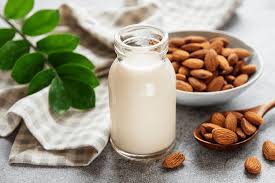
Almond milk is a plant-based milk substitute with a watery texture and nutty flavor manufactured from almonds, It does not contain cholesterol or lactose and is low in saturated fat. Almond milk is of
Almond milk is a plant-based milk substitute with a watery texture and nutty flavor manufactured from almonds, It does not contain cholesterol or lactose and is low in saturated fat. Almond milk is often consumed by those who are lactose-intolerant and others, such as vegans, who do not consume dairy products.
Almond milk can also be an excellent source of:
Phosphorus
Manganese
Iron
Copper
Potassium
Vitamin D
Vitamin E
Nutrients per serving. An 8-ounce (one-cup) serving of unsweetened almond milk contains:
Calories: 40
Protein: 1 gram
Fat: 2.5 grams
Carbohydrates: 1 gram
Fiber: 0 gram
Sugar: 0 grams
Almond Milk Benefits-
Almond milk, especially fortified almond milk, has these health benefits:
1. It is dairy-free. Almond milk has no lactose (a type of sugar found naturally in dairy milk) since it's not an animal product. As a result, it's a good milk
substitute for people with lactose intolerance. It’s also suitable for people who are vegan (don't eat animal products).
2. It’s a good source of magnesium. Almond milk is rich in magnesium, a mineral many American diets lack. Magnesium is important for muscle function, blood
sugar control, blood pressure, and making bone, protein, and DNA.
3. It’s rich in antioxidant vitamin E. Almond milk is a good source of vitamin E, which is important for your immune system and blood vessels. Some studies have
shown a link between high vitamin E intake and a lower risk of cognitive diseases such as Alzheimer's disease. Vitamin E is an antioxidant that protects your
cells from the effects of dangerous molecules called free radicals.
4. It may contain bone-building calcium. Many commercial brands of almond milk are fortified with calcium. Bone health is tied to calcium because the mineral
makes up most of the hard structures in bones. Getting enough calcium strengthens your bones and can help your body fight osteoporosis.
5. It can be low in calories and carbs. Compared to animal milk, unsweetened almond milk — but not the sweetened kind — is low in sugars and carbohydrates.
It has 50% to 80% fewer calories than dairy milk. It's considered a low glycemic index food. This means it's less likely to cause blood sugar spikes.
Almond milk can also be an excellent source of:
Phosphorus
Manganese
Iron
Copper
Potassium
Vitamin D
Vitamin E
Nutrients per serving. An 8-ounce (one-cup) serving of unsweetened almond milk contains:
Calories: 40
Protein: 1 gram
Fat: 2.5 grams
Carbohydrates: 1 gram
Fiber: 0 gram
Sugar: 0 grams
Almond Milk Benefits-
Almond milk, especially fortified almond milk, has these health benefits:
1. It is dairy-free. Almond milk has no lactose (a type of sugar found naturally in dairy milk) since it's not an animal product. As a result, it's a good milk
substitute for people with lactose intolerance. It’s also suitable for people who are vegan (don't eat animal products).
2. It’s a good source of magnesium. Almond milk is rich in magnesium, a mineral many American diets lack. Magnesium is important for muscle function, blood
sugar control, blood pressure, and making bone, protein, and DNA.
3. It’s rich in antioxidant vitamin E. Almond milk is a good source of vitamin E, which is important for your immune system and blood vessels. Some studies have
shown a link between high vitamin E intake and a lower risk of cognitive diseases such as Alzheimer's disease. Vitamin E is an antioxidant that protects your
cells from the effects of dangerous molecules called free radicals.
4. It may contain bone-building calcium. Many commercial brands of almond milk are fortified with calcium. Bone health is tied to calcium because the mineral
makes up most of the hard structures in bones. Getting enough calcium strengthens your bones and can help your body fight osteoporosis.
5. It can be low in calories and carbs. Compared to animal milk, unsweetened almond milk — but not the sweetened kind — is low in sugars and carbohydrates.
It has 50% to 80% fewer calories than dairy milk. It's considered a low glycemic index food. This means it's less likely to cause blood sugar spikes.
Hemophilia
.jpg)
What is hemophilia?
Hemophilia is a rare, inherited blood disorder that causes your blood to clot less, which results in an increased risk of bleeding or bruising.
Hemophilia happens because your bo
Hemophilia is a rare, inherited blood disorder that causes your blood to clot less, which results in an increased risk of bleeding or bruising.
Hemophilia happens because your bo
What is hemophilia?
Hemophilia is a rare, inherited blood disorder that causes your blood to clot less, which results in an increased risk of bleeding or bruising.
Hemophilia happens because your body doesn’t make enough protein (clotting factors) to help your blood form clots. Clotting factors are proteins in your blood. They work with your platelets to form blood clots that control bleeding. Low clotting factor levels increase bleeding risk.There are several types of hemophilia. Hemophilia may be severe, moderate or mild based on the amount of clotting factor in your blood.
Symptoms-
1. People with hemophilia may develop large bruises after minor injuries. This is a sign of bleeding under their skin.
2. They may bleed for an unusually long time, whether that’s bleeding after surgery, bleeding after dental treatment or simply bleeding from a cut finger.
3. They may start bleeding for no apparent reason, such as sudden bloody noses.
4. Joint pain from internal bleeding.
5. Bleeding into your brain.
Causes-
Certain genes create clotting factors. In inherited hemophilia, the genes carrying instructions for making normal clotting factors mutate or change. The mutated genes may give instructions that end up making abnormal clotting factors or not enough clotting factors.
Dietary Guidelines-
1. Consume low sodium and low sugar
2. Add whole-grain intake come from oats, barley, whole wheat, bran, brown rice, or pasta
3. Switching to low-fat dairy products like skimmed milk and low-fat cheese
4. Incorporate dried beans, nuts and seeds instead of meats for a better source of protein
5. Choose olive or canola oils over unhealthy fats like butter, or shortening.
Hemophilia is a rare, inherited blood disorder that causes your blood to clot less, which results in an increased risk of bleeding or bruising.
Hemophilia happens because your body doesn’t make enough protein (clotting factors) to help your blood form clots. Clotting factors are proteins in your blood. They work with your platelets to form blood clots that control bleeding. Low clotting factor levels increase bleeding risk.There are several types of hemophilia. Hemophilia may be severe, moderate or mild based on the amount of clotting factor in your blood.
Symptoms-
1. People with hemophilia may develop large bruises after minor injuries. This is a sign of bleeding under their skin.
2. They may bleed for an unusually long time, whether that’s bleeding after surgery, bleeding after dental treatment or simply bleeding from a cut finger.
3. They may start bleeding for no apparent reason, such as sudden bloody noses.
4. Joint pain from internal bleeding.
5. Bleeding into your brain.
Causes-
Certain genes create clotting factors. In inherited hemophilia, the genes carrying instructions for making normal clotting factors mutate or change. The mutated genes may give instructions that end up making abnormal clotting factors or not enough clotting factors.
Dietary Guidelines-
1. Consume low sodium and low sugar
2. Add whole-grain intake come from oats, barley, whole wheat, bran, brown rice, or pasta
3. Switching to low-fat dairy products like skimmed milk and low-fat cheese
4. Incorporate dried beans, nuts and seeds instead of meats for a better source of protein
5. Choose olive or canola oils over unhealthy fats like butter, or shortening.
Nephrolithiasis ( Kidney stone)

Kidney stones (also called renal calculi, nephrolithiasis or urolithiasis) are hard deposits made of minerals and salts that form inside your kidneys.
Symptoms-
1. Severe, sharp pain in the side a
Symptoms-
1. Severe, sharp pain in the side a
Kidney stones (also called renal calculi, nephrolithiasis or urolithiasis) are hard deposits made of minerals and salts that form inside your kidneys.
Symptoms-
1. Severe, sharp pain in the side and back, below the ribs
2. Pain that radiates to the lower abdomen and groin
3. Pain that comes in waves and fluctuates in intensity
4. Pain or burning sensation while urinating
5. Pink, red or brown urine
6. Cloudy or foul-smelling urine
7. A persistent need to urinate, urinating more often than usual or urinating in small amounts
8. Nausea and vomiting
9. Fever and chills if an infection is present
Causes-
Lack of water
Family history
Diet
Obesity
Other medical condition like Diabetes, Gout, Hyperparathyroidism, Renal tubular acidosis, Metabolic syndrome
Dietary Guidelines-
1. Avoiding vitamin D supplements-Excessive intake of vitamin D, especially without adequate sunlight exposure, can contribute to kidney stone formation.
Individuals with a history of kidney stones should exercise caution and avoid vitamin D supplements.
2. Limiting salt intake-Salt (sodium) increases the amount of calcium in your urine.
3. Limiting oxalate-rich foods- Reducing oxalate in your diet helps decrease oxalate levels in urine. Limit the intake of:Rhubarb, spinach, silverbeet, beetroot,
eggplant, sweet potato, celery, leeks.
4. Drink more fluid, especially water. When you do not consume the right amount of water, you may face gastric problems and constipation.Consume at least 3
litres or 12 cups of fluid daily, with at least half being water.
5. Lemon juice for citrate- Lemon juice, a good source of citrate, aids in preventing stone formation. Consume 100 ml of lemon juice daily, which can be added to
water.
6. Ensuring adequate calcium intake Dietary calcium is essential for bones and teeth. Include 2-3 daily choices from the following list:
7. Add grains ike: rice, wheat, maize, bread, barley, jowar, rice flakes, puffed rice, cornflakes in diet
8. Add legumes like: red gram dal, black gram dal, green gram dal, bengal gram dal, peas, soya beans in diert
9. Fruits and vegetables: Incorporate fruits and vegetables with both low and medium potassium levels.
10.Dairy: milk, curd, and buttermilk (limited to 200 ml/day).
Symptoms-
1. Severe, sharp pain in the side and back, below the ribs
2. Pain that radiates to the lower abdomen and groin
3. Pain that comes in waves and fluctuates in intensity
4. Pain or burning sensation while urinating
5. Pink, red or brown urine
6. Cloudy or foul-smelling urine
7. A persistent need to urinate, urinating more often than usual or urinating in small amounts
8. Nausea and vomiting
9. Fever and chills if an infection is present
Causes-
Lack of water
Family history
Diet
Obesity
Other medical condition like Diabetes, Gout, Hyperparathyroidism, Renal tubular acidosis, Metabolic syndrome
Dietary Guidelines-
1. Avoiding vitamin D supplements-Excessive intake of vitamin D, especially without adequate sunlight exposure, can contribute to kidney stone formation.
Individuals with a history of kidney stones should exercise caution and avoid vitamin D supplements.
2. Limiting salt intake-Salt (sodium) increases the amount of calcium in your urine.
3. Limiting oxalate-rich foods- Reducing oxalate in your diet helps decrease oxalate levels in urine. Limit the intake of:Rhubarb, spinach, silverbeet, beetroot,
eggplant, sweet potato, celery, leeks.
4. Drink more fluid, especially water. When you do not consume the right amount of water, you may face gastric problems and constipation.Consume at least 3
litres or 12 cups of fluid daily, with at least half being water.
5. Lemon juice for citrate- Lemon juice, a good source of citrate, aids in preventing stone formation. Consume 100 ml of lemon juice daily, which can be added to
water.
6. Ensuring adequate calcium intake Dietary calcium is essential for bones and teeth. Include 2-3 daily choices from the following list:
7. Add grains ike: rice, wheat, maize, bread, barley, jowar, rice flakes, puffed rice, cornflakes in diet
8. Add legumes like: red gram dal, black gram dal, green gram dal, bengal gram dal, peas, soya beans in diert
9. Fruits and vegetables: Incorporate fruits and vegetables with both low and medium potassium levels.
10.Dairy: milk, curd, and buttermilk (limited to 200 ml/day).
Hepatitis
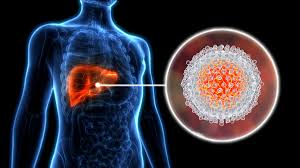
What is hepatitis?
Hepatitis is inflammation of the liver. Inflammation is swelling that happens when tissues of the body are injured or infected. It can damage your liver. This swelling and damage c
Hepatitis is inflammation of the liver. Inflammation is swelling that happens when tissues of the body are injured or infected. It can damage your liver. This swelling and damage c
What is hepatitis?
Hepatitis is inflammation of the liver. Inflammation is swelling that happens when tissues of the body are injured or infected. It can damage your liver. This swelling and damage can affect how well your liver functions.Hepatitis can be an acute (short-term) infection or a chronic (long-term) infection. Some types of hepatitis cause only acute infections. Other types can cause both acute and chronic infections.
Types-
1. Hepatitis A
2. Hepatitis B
3. Hepatitis C
4. Hepatitis D
5. Hepatitis E
Symptoms-
Fever
Fatigue
Loss of appetite
Nausea and/or vomiting
Abdominal pain
Dark urine
Clay-colored bowel movements
Joint pain
Jaundice, yellowing of your skin and eyes
Causes-
hepatitis A : exposure to HAV in food or water
hepatitis B : contact with HBV in body fluids, such as blood, vaginal secretions, or semen
hepatitis C : contact with HCV in body fluids, such as blood, vaginal secretions, or semen
hepatitis D : contact with blood containing HDV
hepatitis E : exposure to HEV in food or water
Other causes are Alcohol and other toxins and Autoimmune system response
Dietary guidelines-
1. Whole Grains and Millets are very beneficial to consume as part of a healthy Hepatitis diet. These can be in the form of bran, whole wheat bread or cereal,
brown rice, red rice, small millets. Include other whole grains such as quinoa, barley, whole oats or rolled oats, wild rice, rye, oatmeal and corn.
2. Fruits and vegetables should be a significant part of any diet to help in recovering from a liver disease. These are full of vitamins and high fiber its helps, easy
to digest. As a bonus, they also contain antioxidants, which can protect the liver cells from damage. However, it is recommended that one go easy on starchy 3. vegetables such as fiber rich, seasonal vegetables, Green leafy vegetables. Fruits such as citrus fruits (Rich in Vitamin C), seasonal fruits when on a Hepatitis
recovery diet. it is always a good idea to try and eat fresh and seasonal produce when possible.
4. MCT oil (Medium Chain Triglyceride) such as Coconut oil helps to reduce the inflammation and other oils such as Olive oil, canola oil, flaxseed oil are all
healthy fats that are recommended as part of a diet for patients with Hepatitis.
5. Healthy proteins in the form of low-fat milk and dairy products along with high biological value protein such as lean meats, eggs, poultry, fish and vegetarian
sources such legumes, whole dal, soy products can also be a part of a healthy liver diet.
Food to be avoided-
1. Processed food items are best avoided when recovering from Hepatitis. Processed food items include processed ingredients that are harder on the liver and
relatively devoid of nutrients. Processed breads, cheese maida products (wheat flour with low roughage), fried food, packed, tinned food and almost all fast -
food items are also best avoided during Hepatitis, as they can worsen recovery times.
2. Hydrogenated oils must be replaced with healthy oils. In fact for a lifelong healthy liver it is a good idea to switch to healthy oil choices. Avoid consuming
foods high in saturated fats or trans- fats such as margarine, Dalda oil, reheated oil, animal fats, palm oil.
3. Sugar intake should be limited for a healthy liver. This includes all artificial sweeteners as well as fruits juices. Juices have high concentrations of sugar in
them, which can be difficult for the liver to digest when the body is under attack from the Hepatitis virus.
Hepatitis is inflammation of the liver. Inflammation is swelling that happens when tissues of the body are injured or infected. It can damage your liver. This swelling and damage can affect how well your liver functions.Hepatitis can be an acute (short-term) infection or a chronic (long-term) infection. Some types of hepatitis cause only acute infections. Other types can cause both acute and chronic infections.
Types-
1. Hepatitis A
2. Hepatitis B
3. Hepatitis C
4. Hepatitis D
5. Hepatitis E
Symptoms-
Fever
Fatigue
Loss of appetite
Nausea and/or vomiting
Abdominal pain
Dark urine
Clay-colored bowel movements
Joint pain
Jaundice, yellowing of your skin and eyes
Causes-
hepatitis A : exposure to HAV in food or water
hepatitis B : contact with HBV in body fluids, such as blood, vaginal secretions, or semen
hepatitis C : contact with HCV in body fluids, such as blood, vaginal secretions, or semen
hepatitis D : contact with blood containing HDV
hepatitis E : exposure to HEV in food or water
Other causes are Alcohol and other toxins and Autoimmune system response
Dietary guidelines-
1. Whole Grains and Millets are very beneficial to consume as part of a healthy Hepatitis diet. These can be in the form of bran, whole wheat bread or cereal,
brown rice, red rice, small millets. Include other whole grains such as quinoa, barley, whole oats or rolled oats, wild rice, rye, oatmeal and corn.
2. Fruits and vegetables should be a significant part of any diet to help in recovering from a liver disease. These are full of vitamins and high fiber its helps, easy
to digest. As a bonus, they also contain antioxidants, which can protect the liver cells from damage. However, it is recommended that one go easy on starchy 3. vegetables such as fiber rich, seasonal vegetables, Green leafy vegetables. Fruits such as citrus fruits (Rich in Vitamin C), seasonal fruits when on a Hepatitis
recovery diet. it is always a good idea to try and eat fresh and seasonal produce when possible.
4. MCT oil (Medium Chain Triglyceride) such as Coconut oil helps to reduce the inflammation and other oils such as Olive oil, canola oil, flaxseed oil are all
healthy fats that are recommended as part of a diet for patients with Hepatitis.
5. Healthy proteins in the form of low-fat milk and dairy products along with high biological value protein such as lean meats, eggs, poultry, fish and vegetarian
sources such legumes, whole dal, soy products can also be a part of a healthy liver diet.
Food to be avoided-
1. Processed food items are best avoided when recovering from Hepatitis. Processed food items include processed ingredients that are harder on the liver and
relatively devoid of nutrients. Processed breads, cheese maida products (wheat flour with low roughage), fried food, packed, tinned food and almost all fast -
food items are also best avoided during Hepatitis, as they can worsen recovery times.
2. Hydrogenated oils must be replaced with healthy oils. In fact for a lifelong healthy liver it is a good idea to switch to healthy oil choices. Avoid consuming
foods high in saturated fats or trans- fats such as margarine, Dalda oil, reheated oil, animal fats, palm oil.
3. Sugar intake should be limited for a healthy liver. This includes all artificial sweeteners as well as fruits juices. Juices have high concentrations of sugar in
them, which can be difficult for the liver to digest when the body is under attack from the Hepatitis virus.
Parkinson's disease
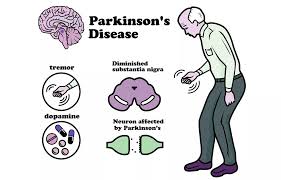
Parkinson's disease is a movement disorder of the nervous system that worsens over time. The nervous system is a network of nerve cells that controls many parts of the body, including movement.Symptom
Parkinson's disease is a movement disorder of the nervous system that worsens over time. The nervous system is a network of nerve cells that controls many parts of the body, including movement.Symptoms start slowly. The first symptom may be a barely noticeable tremor in just one hand or sometimes a foot or the jaw. Tremor is common in Parkinson's disease. But the disorder also may cause stiffness, slowing of movement and trouble with balance that raises the risk of falls.
Symptoms-
1. Tremor- This rhythmic shaking usually begins in the hands or fingers. Sometimes tremor begins in the foot or jaw. You may rub your thumb and forefinger
back and forth. This is known as a pill-rolling tremor. Your hand may tremble when it's at rest or when you're under stress. You may notice that you shake
less when you're doing some sort of task or moving around.
2. Slowed movement also called bradykinesia. Parkinson's disease may slow your movement, making simple tasks more difficult. It may be hard to get out of
a chair, shower or get dressed. You may have less expression in your face. It may be hard to blink.
3. Rigid muscles. You may have stiff muscles in any part of your body. Your muscles may feel tense and painful, and your arm movements may be short and
jerky.
4. Poor posture and balance. Your posture may become stooped. You may fall or have balance problems.
5. Loss of automatic movements. You may be less able to make certain movements that you typically do without thinking, including blinking, smiling or 6. 6. 6. swinging your arms when you walk.
7. Speech changes. You may speak softly or quickly, slur, or hesitate before talking. Your speech may be flat or monotone, without typical speech patterns.
8. Writing changes. You may have trouble writing, and your writing may appear cramped and small.
9. Nonmotor symptoms. These may include depression, anxiety, constipation and sleep problems. They also may include acting out dreams, needing to
urinate often, trouble smelling, problems with thinking and memory, and feeling very tired.
Causes-
Genes. Specific genetic changes are linked to Parkinson's disease. But these are rare unless many family members have had Parkinson's disease.
Environmental factors. Exposure to certain toxins or other environmental factors may increase the risk of later Parkinson's disease.
Dietary Guidelines-
Diet improves general well-being and boosts your ability to deal with symptoms of the disease. Eating plenty of
1. Whole foods, such as fruits and vegetables
2. Lean protein such as beans and legumes
3. Whole grains
4. Staying hydrated are key ways to stay energized and healthy overall.
Symptoms-
1. Tremor- This rhythmic shaking usually begins in the hands or fingers. Sometimes tremor begins in the foot or jaw. You may rub your thumb and forefinger
back and forth. This is known as a pill-rolling tremor. Your hand may tremble when it's at rest or when you're under stress. You may notice that you shake
less when you're doing some sort of task or moving around.
2. Slowed movement also called bradykinesia. Parkinson's disease may slow your movement, making simple tasks more difficult. It may be hard to get out of
a chair, shower or get dressed. You may have less expression in your face. It may be hard to blink.
3. Rigid muscles. You may have stiff muscles in any part of your body. Your muscles may feel tense and painful, and your arm movements may be short and
jerky.
4. Poor posture and balance. Your posture may become stooped. You may fall or have balance problems.
5. Loss of automatic movements. You may be less able to make certain movements that you typically do without thinking, including blinking, smiling or 6. 6. 6. swinging your arms when you walk.
7. Speech changes. You may speak softly or quickly, slur, or hesitate before talking. Your speech may be flat or monotone, without typical speech patterns.
8. Writing changes. You may have trouble writing, and your writing may appear cramped and small.
9. Nonmotor symptoms. These may include depression, anxiety, constipation and sleep problems. They also may include acting out dreams, needing to
urinate often, trouble smelling, problems with thinking and memory, and feeling very tired.
Causes-
Genes. Specific genetic changes are linked to Parkinson's disease. But these are rare unless many family members have had Parkinson's disease.
Environmental factors. Exposure to certain toxins or other environmental factors may increase the risk of later Parkinson's disease.
Dietary Guidelines-
Diet improves general well-being and boosts your ability to deal with symptoms of the disease. Eating plenty of
1. Whole foods, such as fruits and vegetables
2. Lean protein such as beans and legumes
3. Whole grains
4. Staying hydrated are key ways to stay energized and healthy overall.
Diabetes
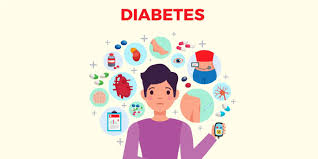
Diabetes is a chronic disease that occurs either when the pancreas does not produce enough insulin or when the body cannot effectively use the insulin it produces. Insulin is a hormone that regulates
Diabetes is a chronic disease that occurs either when the pancreas does not produce enough insulin or when the body cannot effectively use the insulin it produces. Insulin is a hormone that regulates blood glucose. Hyperglycaemia, also called raised blood glucose or raised blood sugar, is a common effect of uncontrolled diabetes and over time leads to serious damage to many of the body's systems, especially the nerves and blood vessels.
Types-
1. Type 1 diabetes
2. Type 2 diabetes
3. Gestational diabetes
Symptoms-
feeling very thirsty
needing to urinate more often than usual
blurred vision
feeling tired
losing weight unintentionally
Dietary Guidelines-
Fruits and vegetables
1. Include whole grains, such as whole wheat, brown rice, barley, quinoa, and oats
2. Include proteins, such as nuts, beans, lentils, and tofu
3. Include nonfat or low-fat dairy, such as milk, yogurt, and cheese
Food to be Avoided-
1. High-carb foods and drinks, such as: Sugary foods, such as candy, cookies, cake, ice cream, sweetened cereals, and canned fruits with added sugar
Drinks with added sugars, such as juice, regular soda, and regular sports or energy drinks
White rice, tortillas, breads and pasta - especially those made with white flour
Starchy vegetables, such as white potatoes, corn, and peas
2. Fried foods and other foods high in saturated trans fats.
3. Foods high in sodium (salt).
4. Alcohol.
Types-
1. Type 1 diabetes
2. Type 2 diabetes
3. Gestational diabetes
Symptoms-
feeling very thirsty
needing to urinate more often than usual
blurred vision
feeling tired
losing weight unintentionally
Dietary Guidelines-
Fruits and vegetables
1. Include whole grains, such as whole wheat, brown rice, barley, quinoa, and oats
2. Include proteins, such as nuts, beans, lentils, and tofu
3. Include nonfat or low-fat dairy, such as milk, yogurt, and cheese
Food to be Avoided-
1. High-carb foods and drinks, such as: Sugary foods, such as candy, cookies, cake, ice cream, sweetened cereals, and canned fruits with added sugar
Drinks with added sugars, such as juice, regular soda, and regular sports or energy drinks
White rice, tortillas, breads and pasta - especially those made with white flour
Starchy vegetables, such as white potatoes, corn, and peas
2. Fried foods and other foods high in saturated trans fats.
3. Foods high in sodium (salt).
4. Alcohol.
Hypertension
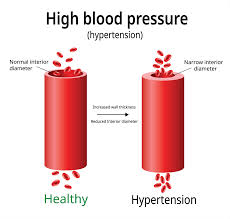
Hypertension, also known as high blood pressure, is a long-term medical condition in which the blood pressure in the arteries is persistently elevated.
Symptoms-
A few people with high blood pressur
Symptoms-
A few people with high blood pressur
Hypertension, also known as high blood pressure, is a long-term medical condition in which the blood pressure in the arteries is persistently elevated.
Symptoms-
A few people with high blood pressure may have:
Headaches
Shortness of breath
Nosebleeds
Causes-
There are two main types of high blood pressure.
1. Primary hypertension, also called essential hypertension. For most adults, there's no identifiable cause of high blood pressure. This type of high blood
pressure is called primary hypertension or essential hypertension. It tends to develop gradually over many years. Plaque buildup in the arteries, called
atherosclerosis, increases the risk of high blood pressure.
2. Secondary hypertension-This type of high blood pressure is caused by an underlying condition. It tends to appear suddenly and cause higher blood pressure than does primary hypertension. Conditions and medicines that can lead to secondary hypertension include:
Adrenal gland tumors
Blood vessel problems present at birth, also called congenital heart defects
Cough and cold medicines, some pain relievers, birth control pills, and other prescription drugs
Illegal drugs, such as cocaine and amphetamines
Kidney disease
Obstructive sleep apnea
Thyroid problems
Dietary Guidelines-
1. Limit sodium intake.
2. Reduce saturated fat.
3. When choosing fats, select monounsaturated oils, such as olive or canola oil.
4. Choose whole grains over white flour or pasta products.
5. Choose fresh fruits and vegetables every day. Many of these foods are rich in potassium, fiber, or both.
6. Eat nuts, seeds, or legumes (dried beans or peas) daily.
7. Choose modest amounts of protein soy products are the best healthy protein sources.
Symptoms-
A few people with high blood pressure may have:
Headaches
Shortness of breath
Nosebleeds
Causes-
There are two main types of high blood pressure.
1. Primary hypertension, also called essential hypertension. For most adults, there's no identifiable cause of high blood pressure. This type of high blood
pressure is called primary hypertension or essential hypertension. It tends to develop gradually over many years. Plaque buildup in the arteries, called
atherosclerosis, increases the risk of high blood pressure.
2. Secondary hypertension-This type of high blood pressure is caused by an underlying condition. It tends to appear suddenly and cause higher blood pressure than does primary hypertension. Conditions and medicines that can lead to secondary hypertension include:
Adrenal gland tumors
Blood vessel problems present at birth, also called congenital heart defects
Cough and cold medicines, some pain relievers, birth control pills, and other prescription drugs
Illegal drugs, such as cocaine and amphetamines
Kidney disease
Obstructive sleep apnea
Thyroid problems
Dietary Guidelines-
1. Limit sodium intake.
2. Reduce saturated fat.
3. When choosing fats, select monounsaturated oils, such as olive or canola oil.
4. Choose whole grains over white flour or pasta products.
5. Choose fresh fruits and vegetables every day. Many of these foods are rich in potassium, fiber, or both.
6. Eat nuts, seeds, or legumes (dried beans or peas) daily.
7. Choose modest amounts of protein soy products are the best healthy protein sources.
Typhoid fever
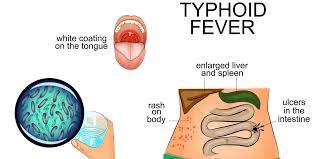
Typhoid fever, also known simply as typhoid, is a disease caused by Salmonella enterica serotype Typhi bacteria, also called Salmonella typhi.Symptoms vary from mild to severe, and usually begin six t
Typhoid fever, also known simply as typhoid, is a disease caused by Salmonella enterica serotype Typhi bacteria, also called Salmonella typhi.Symptoms vary from mild to severe, and usually begin six to 30 days after exposure.
Symptoms-
Fever that starts low and increases throughout the day, possibly reaching as high as 104 degrees Fahrenheit (40 degrees Celsius).
Chills.
Headache.
Weakness and fatigue.
Muscle aches.
Stomach pain.
Diarrhea or constipation.
Rash.
Causes-
A bacteria strain called Salmonella enterica serotype typhi causes typhoid fever. Other strains of salmonella bacteria cause a similar disease called paratyphoid fever.
Dietary Guidelines-
1. Luids: Hydration is critical during typhoid recovery. Here are some fluids to keep you hydrated and replenish lost electrolytes: Tender coconut water ,Barley
water,Fresh fruit juice,Vegetable soup, Buttermilk, Plain water
2. Fruits: Soft, easy-to-digest fruits are an excellent choice: Bananas, Cantaloupes,Watermelons,Grapes, Peaches,Apricots.
3. Semi-solid foods: These foods are gentle on the stomach yet provide the necessary energy and nutrients: Boiled rice, Baked potato, Baked apples.
4. Yoghurt: Provides probiotics and protein for gut health.
5. Vegetable soup: Easy to digest and packed with nutrients
Symptoms-
Fever that starts low and increases throughout the day, possibly reaching as high as 104 degrees Fahrenheit (40 degrees Celsius).
Chills.
Headache.
Weakness and fatigue.
Muscle aches.
Stomach pain.
Diarrhea or constipation.
Rash.
Causes-
A bacteria strain called Salmonella enterica serotype typhi causes typhoid fever. Other strains of salmonella bacteria cause a similar disease called paratyphoid fever.
Dietary Guidelines-
1. Luids: Hydration is critical during typhoid recovery. Here are some fluids to keep you hydrated and replenish lost electrolytes: Tender coconut water ,Barley
water,Fresh fruit juice,Vegetable soup, Buttermilk, Plain water
2. Fruits: Soft, easy-to-digest fruits are an excellent choice: Bananas, Cantaloupes,Watermelons,Grapes, Peaches,Apricots.
3. Semi-solid foods: These foods are gentle on the stomach yet provide the necessary energy and nutrients: Boiled rice, Baked potato, Baked apples.
4. Yoghurt: Provides probiotics and protein for gut health.
5. Vegetable soup: Easy to digest and packed with nutrients
Dengue
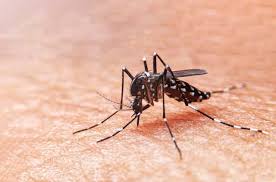
Dengue fever is a mosquito-borne disease caused by dengue virus, prevalent in tropical and subtropical areas.
Symptoms-
Headache
Muscle, bone or joint pain
Nausea
Vomiting
Pain behind the eyes
Symptoms-
Headache
Muscle, bone or joint pain
Nausea
Vomiting
Pain behind the eyes
Dengue fever is a mosquito-borne disease caused by dengue virus, prevalent in tropical and subtropical areas.
Symptoms-
Headache
Muscle, bone or joint pain
Nausea
Vomiting
Pain behind the eyes
Swollen glands
Rash
Causes-
Dengue fever is due to infection with the dengue virus (DENV), which belongs to one of four strains: DENV-1, DENV-2, DENV-3, or DENV-4. The virus is transmitted through the bite of the Aedes aegypti mosquito, also known as the yellow fever mosquito.
Dietary Guidelines-
1. Hydration: Maintaining proper hydration is essential to combat the dehydration caused by high fever and sweating. Drink plenty of fluids, such as water, oral
rehydration solutions (ORS), clear soups, and coconut water.
2. Balanced Diet: Consume a well-balanced diet during dengue fever, rich in nutrients to support the immune system. Include fruits for dengue, vegetables,
whole grains, lean proteins, and healthy fats in your meals.
3. Small, Frequent Meals: Dengue can reduce appetite. Small, frequent meals help maintain energy levels and provide essential nutrients.
4. Avoid Salty and Spicy Foods: Salty and spicy foods can exacerbate dehydration and digestive discomfort. Opt for a bland, easy-to-digest diet for dengue fever
patients.
5. Foods Rich in Vitamins and Minerals: Foods high in vitamin C (e.g., citrus fruits), vitamin A (e.g., carrots, sweet potatoes), and zinc (e.g., lean meats, legumes) can
support the immune system.
6. Avoid Alcohol and Caffeine: Alcohol and caffeine can dehydrate the body and should be avoided.
7. Soft and Easily Digestible Foods: Opt for soft, easily digestible foods such as rice, porridge, yoghurt, and boiled or steamed vegetables. Food to avoid for
8. dengue patients includes spicy, salty foods, alcohol, caffeine, fried and fatty foods.
9. Protein Sources: Include lean protein sources such as poultry, fish, tofu, and eggs to aid in tissue repair.
10.Rest: Rest is crucial for recovery. Ensure that the dengue patient gets adequate sleep and avoids strenuous activities.
Symptoms-
Headache
Muscle, bone or joint pain
Nausea
Vomiting
Pain behind the eyes
Swollen glands
Rash
Causes-
Dengue fever is due to infection with the dengue virus (DENV), which belongs to one of four strains: DENV-1, DENV-2, DENV-3, or DENV-4. The virus is transmitted through the bite of the Aedes aegypti mosquito, also known as the yellow fever mosquito.
Dietary Guidelines-
1. Hydration: Maintaining proper hydration is essential to combat the dehydration caused by high fever and sweating. Drink plenty of fluids, such as water, oral
rehydration solutions (ORS), clear soups, and coconut water.
2. Balanced Diet: Consume a well-balanced diet during dengue fever, rich in nutrients to support the immune system. Include fruits for dengue, vegetables,
whole grains, lean proteins, and healthy fats in your meals.
3. Small, Frequent Meals: Dengue can reduce appetite. Small, frequent meals help maintain energy levels and provide essential nutrients.
4. Avoid Salty and Spicy Foods: Salty and spicy foods can exacerbate dehydration and digestive discomfort. Opt for a bland, easy-to-digest diet for dengue fever
patients.
5. Foods Rich in Vitamins and Minerals: Foods high in vitamin C (e.g., citrus fruits), vitamin A (e.g., carrots, sweet potatoes), and zinc (e.g., lean meats, legumes) can
support the immune system.
6. Avoid Alcohol and Caffeine: Alcohol and caffeine can dehydrate the body and should be avoided.
7. Soft and Easily Digestible Foods: Opt for soft, easily digestible foods such as rice, porridge, yoghurt, and boiled or steamed vegetables. Food to avoid for
8. dengue patients includes spicy, salty foods, alcohol, caffeine, fried and fatty foods.
9. Protein Sources: Include lean protein sources such as poultry, fish, tofu, and eggs to aid in tissue repair.
10.Rest: Rest is crucial for recovery. Ensure that the dengue patient gets adequate sleep and avoids strenuous activities.
Gooseberry ( Amla)
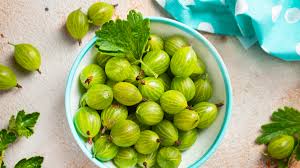
Gooseberry is a common name for many species of Ribes (which also includes currants), as well as a large number of plants of similar appearance, and also several unrelated plants . The berries of tho
Gooseberry is a common name for many species of Ribes (which also includes currants), as well as a large number of plants of similar appearance, and also several unrelated plants . The berries of those in the genus Ribes (sometimes placed in the genus Grossularia) are edible and may be green, orange, red, purple, yellow, white, or black.
Gooseberries are nutritious, low-calorie fruits that are rich in vitamins, minerals, and antioxidants. These berries may have health benefits that include lower blood sugar, cholesterol and blood pressure.
100 grams of gooseberries contains :
Calories: 23.66 Kcal
Protein: 0.35 gm
Fat: 0.16 gm
Carbs: 4.39 gm
Fiber: 7.75 gm
Health Benefits-
1. Strengthens the Immune System-One of the main benefits of gooseberry juice is that it can strengthen your immune system remarkably. A 100g (i.e.,
approximately half a cup) serving of diced gooseberries can offer 300mg of Vitamin C — an amount which is almost double the amount recommended daily
for adults. Vitamin C, along with other beneficial compounds like alkaloids, polyphenols, and flavonoids, act as excellent immune boosters.
2. Protects Cardiovascular Health-The fruit can safeguard cardiovascular health by lowering LDL (low-density lipoprotein) or 'bad' cholesterol levels and
increasing HDL (high-density lipoprotein) or 'good' cholesterol levels. This way, the fruit reduces the risk of heart attacks.
3. Prevents Neurodegenerative Diseases-Intake of gooseberry juice or gooseberry powder can significantly reduce inflammation. The fruit's anti-inflammatory
properties play a role in preventing the onset of neurodegenerative diseases like Alzheimer's Disease, Parkinson's Disease, Motor Neuron Disease, etc.
4. Manages Diabetes-Consumption of gooseberry fruit or its juice can help manage diabetes effectively. The soluble fibres in the fruit get dissolved easily,
thereby controlling the sugar absorption rate by your body. This phenomenon prevents sudden sugar spikes, which are common in individuals coping with
diabetes. Furthermore, research has shown that drinking amla juice daily in the morning can favourably impact the lipid and blood glucose counts in patients
with type 2 diabetes.
5. Prevents Cancer-One of the most remarkable benefits of gooseberry juice or fruit is that it can increase longevity by preventing certain deadly diseases like
cancer. Studies, though limited, show that gooseberry can destroy cancer cells in the case of certain types of carcinoma. These include carcinoma of lungs,
breasts, ovaries, and cervix.
6. Improves Eye Health-Vitamins A and C, the two vital nutrients in gooseberry, may protect your eyes from issues like weak vision and age-related macular
degeneration. Vitamin C may also prevent eye infections like conjunctivitis or pink eye.
7. Improves Skin Health-One of the most well-known benefits of gooseberry juice and fruit is that it can give you radiant skin. Drinking the juice daily in the
morning can flush out toxins from your system, giving you flawless skin. Researchers have also declared that topical application of fresh gel extracted from
the gooseberry fruit can eliminate ageing signs like wrinkles, fine lines, loss of skin elasticity, and hydration.
8. Improves Digestive Health-The gooseberry fruit is excellent for digestive health. Consumption of the fruit can stimulate the secretion of various digestive
enzymes, thereby improving your digestion power. The fibre in the fruit can regulate your bowel movements, alleviating issues like constipation and irritable
bowel syndrome.
Gooseberries are nutritious, low-calorie fruits that are rich in vitamins, minerals, and antioxidants. These berries may have health benefits that include lower blood sugar, cholesterol and blood pressure.
100 grams of gooseberries contains :
Calories: 23.66 Kcal
Protein: 0.35 gm
Fat: 0.16 gm
Carbs: 4.39 gm
Fiber: 7.75 gm
Health Benefits-
1. Strengthens the Immune System-One of the main benefits of gooseberry juice is that it can strengthen your immune system remarkably. A 100g (i.e.,
approximately half a cup) serving of diced gooseberries can offer 300mg of Vitamin C — an amount which is almost double the amount recommended daily
for adults. Vitamin C, along with other beneficial compounds like alkaloids, polyphenols, and flavonoids, act as excellent immune boosters.
2. Protects Cardiovascular Health-The fruit can safeguard cardiovascular health by lowering LDL (low-density lipoprotein) or 'bad' cholesterol levels and
increasing HDL (high-density lipoprotein) or 'good' cholesterol levels. This way, the fruit reduces the risk of heart attacks.
3. Prevents Neurodegenerative Diseases-Intake of gooseberry juice or gooseberry powder can significantly reduce inflammation. The fruit's anti-inflammatory
properties play a role in preventing the onset of neurodegenerative diseases like Alzheimer's Disease, Parkinson's Disease, Motor Neuron Disease, etc.
4. Manages Diabetes-Consumption of gooseberry fruit or its juice can help manage diabetes effectively. The soluble fibres in the fruit get dissolved easily,
thereby controlling the sugar absorption rate by your body. This phenomenon prevents sudden sugar spikes, which are common in individuals coping with
diabetes. Furthermore, research has shown that drinking amla juice daily in the morning can favourably impact the lipid and blood glucose counts in patients
with type 2 diabetes.
5. Prevents Cancer-One of the most remarkable benefits of gooseberry juice or fruit is that it can increase longevity by preventing certain deadly diseases like
cancer. Studies, though limited, show that gooseberry can destroy cancer cells in the case of certain types of carcinoma. These include carcinoma of lungs,
breasts, ovaries, and cervix.
6. Improves Eye Health-Vitamins A and C, the two vital nutrients in gooseberry, may protect your eyes from issues like weak vision and age-related macular
degeneration. Vitamin C may also prevent eye infections like conjunctivitis or pink eye.
7. Improves Skin Health-One of the most well-known benefits of gooseberry juice and fruit is that it can give you radiant skin. Drinking the juice daily in the
morning can flush out toxins from your system, giving you flawless skin. Researchers have also declared that topical application of fresh gel extracted from
the gooseberry fruit can eliminate ageing signs like wrinkles, fine lines, loss of skin elasticity, and hydration.
8. Improves Digestive Health-The gooseberry fruit is excellent for digestive health. Consumption of the fruit can stimulate the secretion of various digestive
enzymes, thereby improving your digestion power. The fibre in the fruit can regulate your bowel movements, alleviating issues like constipation and irritable
bowel syndrome.
Black Plum ( Jamun)
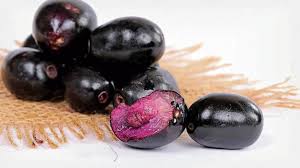
Syzygium cumini, commonly known as Malabar plum,Java plum, black plum, jamun, jaman, jambul, or jambolan. It is an evergreen tropical tree in the flowering plant family Myrtaceae, and favored for its
Syzygium cumini, commonly known as Malabar plum,Java plum, black plum, jamun, jaman, jambul, or jambolan. It is an evergreen tropical tree in the flowering plant family Myrtaceae, and favored for its fruit, timber, and ornamental value.
100gm of Black plum contain-
Calories 46 Kcal
Total Fat 0.3 gm
Total Carbohydrate 11 gm
Dietary fiber 1.4 gm
Health Benefits-
1. Jamun Increases Haemoglobin.
2. Jamun Keeps the heart healthy
3. It treats digestive problems
4. It fights against respiratory problems
5. Jamun helps in diabetes management. The ingredients like Jamboline and Jambosine present in the seeds slow down glucose levels in the blood and
increase the release of insulin.
6. Jamun protects against infections.
7. It strengthens teeth and gums
100gm of Black plum contain-
Calories 46 Kcal
Total Fat 0.3 gm
Total Carbohydrate 11 gm
Dietary fiber 1.4 gm
Health Benefits-
1. Jamun Increases Haemoglobin.
2. Jamun Keeps the heart healthy
3. It treats digestive problems
4. It fights against respiratory problems
5. Jamun helps in diabetes management. The ingredients like Jamboline and Jambosine present in the seeds slow down glucose levels in the blood and
increase the release of insulin.
6. Jamun protects against infections.
7. It strengthens teeth and gums
Gallstones
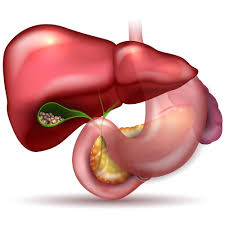
What are gallstones?
Gallstones form when bile stored in the gallbladder hardens into stone-like material. Too much cholesterol, bile salts, or bilirubin (bile pigment) can cause gallstones.
Gallstones form when bile stored in the gallbladder hardens into stone-like material. Too much cholesterol, bile salts, or bilirubin (bile pigment) can cause gallstones.
What are gallstones?
Gallstones form when bile stored in the gallbladder hardens into stone-like material. Too much cholesterol, bile salts, or bilirubin (bile pigment) can cause gallstones.
What causes gallstones?
Are overweight or obese Eat an unhealthy diet, particularly a high-fat diet
Have a family history of gallstones Have certain health conditions — this includes: A food allergy (eg coeliac disease) that you do not treat ie you do not avoid eating the foods that trigger your allergy, Coronary artery disease , Diabetes, Lactose-intolerance
Lose weight rapidly Smoke
Symptoms-
Steady, severe pain in the upper abdomen that increases rapidly and may last from 30 minutes to several hours
Pain in the back between the shoulder blades
Pain in the right shoulder
Nausea
Vomiting
Fever
Chills
Jaundice. A yellowing of the skin or eyes.
Abdominal bloating
Intolerance of fatty foods
Belching or gas
Indigestion
Dietary Guidelines-
1. Add fresh fruits and vegetables
2. Add whole grains (whole-wheat bread, brown rice, oats, bran cereal)
3. Add low-fat dairy products
4. Advised to follow fat restricted diet
Food to be avoided-
1. Fried foods
2.Highly processed foods (doughnuts, pie, cookies)
3. Whole-milk dairy products (cheese, ice cream, butter)
Gallstones form when bile stored in the gallbladder hardens into stone-like material. Too much cholesterol, bile salts, or bilirubin (bile pigment) can cause gallstones.
What causes gallstones?
Are overweight or obese Eat an unhealthy diet, particularly a high-fat diet
Have a family history of gallstones Have certain health conditions — this includes: A food allergy (eg coeliac disease) that you do not treat ie you do not avoid eating the foods that trigger your allergy, Coronary artery disease , Diabetes, Lactose-intolerance
Lose weight rapidly Smoke
Symptoms-
Steady, severe pain in the upper abdomen that increases rapidly and may last from 30 minutes to several hours
Pain in the back between the shoulder blades
Pain in the right shoulder
Nausea
Vomiting
Fever
Chills
Jaundice. A yellowing of the skin or eyes.
Abdominal bloating
Intolerance of fatty foods
Belching or gas
Indigestion
Dietary Guidelines-
1. Add fresh fruits and vegetables
2. Add whole grains (whole-wheat bread, brown rice, oats, bran cereal)
3. Add low-fat dairy products
4. Advised to follow fat restricted diet
Food to be avoided-
1. Fried foods
2.Highly processed foods (doughnuts, pie, cookies)
3. Whole-milk dairy products (cheese, ice cream, butter)
Gout
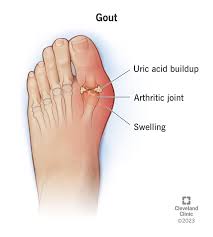
Gout is a form of inflammatory arthritis characterized by recurrent attacks of pain in a red, tender, hot, and swollen joint caused by the deposition of needle-like crystals of uric acid known as mono
Gout is a form of inflammatory arthritis characterized by recurrent attacks of pain in a red, tender, hot, and swollen joint caused by the deposition of needle-like crystals of uric acid known as monosodium urate crystals. Pain typically comes on rapidly, reaching maximal intensity in less than 12 hours
Symptoms-
Intense pain.
Discoloration or redness.
Stiffness.
Swelling.
Tenderness, even to a light touch (like a bedsheet covering your affected joint).
Warmth, or a feeling like the joint is “on fire.”
Causes-
A buildup of excess uric acid in your body causes gout. Your body naturally makes uric acid when it breaks down chemicals called purines found in certain foods and drinks. Your kidneys usually filter uric acid out of your blood, and then it leaves your body when you pee.Sometimes your body makes too much uric acid, or your kidneys don’t remove it from your blood fast enough. When your body has high levels of uric acid (hyperuricemia), uric acid crystals can build up and settle into your joints. The sharp crystals clump together and cause sudden episodes of pain, swelling and other symptoms.
Dietary Guidelines-
1. Weight loss. Being overweight increases the risk of developing gout, and losing weight lowers the risk of gout. Research suggests that reducing the number of
calories and losing weight — even without a purine-restricted diet — lower uric acid levels and reduce the number of gout attacks. Losing weight also lessens
the overall stress on joints.
2. Complex carbs. Eat more fruits, vegetables and whole grains, which provide complex carbohydrates. Avoid foods and beverages with high-fructose corn
syrup, and limit consumption of naturally sweet fruit juices.
3. Water. Stay well-hydrated by drinking water.
4. Fats. Cut back on saturated fats from red meat, fatty poultry and high-fat dairy products.
5. Proteins. Focus low-fat dairy and lentils as sources of protein.
Symptoms-
Intense pain.
Discoloration or redness.
Stiffness.
Swelling.
Tenderness, even to a light touch (like a bedsheet covering your affected joint).
Warmth, or a feeling like the joint is “on fire.”
Causes-
A buildup of excess uric acid in your body causes gout. Your body naturally makes uric acid when it breaks down chemicals called purines found in certain foods and drinks. Your kidneys usually filter uric acid out of your blood, and then it leaves your body when you pee.Sometimes your body makes too much uric acid, or your kidneys don’t remove it from your blood fast enough. When your body has high levels of uric acid (hyperuricemia), uric acid crystals can build up and settle into your joints. The sharp crystals clump together and cause sudden episodes of pain, swelling and other symptoms.
Dietary Guidelines-
1. Weight loss. Being overweight increases the risk of developing gout, and losing weight lowers the risk of gout. Research suggests that reducing the number of
calories and losing weight — even without a purine-restricted diet — lower uric acid levels and reduce the number of gout attacks. Losing weight also lessens
the overall stress on joints.
2. Complex carbs. Eat more fruits, vegetables and whole grains, which provide complex carbohydrates. Avoid foods and beverages with high-fructose corn
syrup, and limit consumption of naturally sweet fruit juices.
3. Water. Stay well-hydrated by drinking water.
4. Fats. Cut back on saturated fats from red meat, fatty poultry and high-fat dairy products.
5. Proteins. Focus low-fat dairy and lentils as sources of protein.
Rheumatoid arthritis (RA)
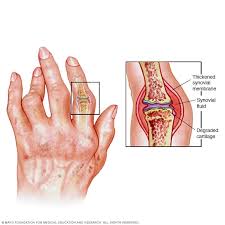
Rheumatoid arthritis (RA) is a chronic autoimmune disease that causes pain, swelling and stiffness in the lining of your joints (synovium). It most commonly affects the joints in fingers, hands, wrist
Rheumatoid arthritis (RA) is a chronic autoimmune disease that causes pain, swelling and stiffness in the lining of your joints (synovium). It most commonly affects the joints in fingers, hands, wrists, knees, ankles, feet and toes.
Uncontrolled inflammation damages cartilage, which normally acts as a “shock absorber” in joints. Rheumatoid arthritis sometimes affects other parts of your body, including your: Skin, Eyes, Mouth, Lungs, Heart.
Symptoms-
Pain, swelling, stiffness and tenderness in more than one joint
Stiffness, especially in the morning or after sitting for long periods
Pain and stiffness in the same joints on both sides of your body
Fatigue (extreme tiredness)
Weakness
Fever
Causes-
The exact cause of rheumatoid arthritis is unknown. It is assumed that it is caused by a combination of genetics, hormones and environmental factors.
Normally, your immune system protects your body from disease. With RA, something triggers your immune system to attack your own joints. An infection, smoking, or physical or emotional stress may be triggers.
Dietary Guidelines-
1. Fruits and veggies. Fruits and vegetables are rich in antioxidants, which help stabilize molecules called free radicals that can trigger inflammation and damage
cells. They’re also packed with vitamins and minerals the body needs and in polyphenols, all of which may help lower C-reactive protein (CRP), a marker of
inflammation. To get the greatest health benefits, eat several types of fresh or frozen fruits each day, but watch out for sugar content in frozen options. Eat a
colorful variety of veggies to get the most nutrients. Aim for two cups of fruits and two and a half to three cups of vegetables per day – fewer if you get less
than 30 minutes of exercise a day and more if you’re more active.
2. Whole grains. Oats, whole wheat, brown rice, quinoa and other whole grains may lower levels of CRP and reduce the risk of heart disease, which is elevated in
people with RA. Whole grains are higher in nutrients and fiber than refined grains. Plus, many products with refined grains contain ingredients that are not
healthful, such as added sugars and saturated fats. Read labels and choose breads, cereals and other products that specify a whole grain as a primary
ingredient.
3. Peas and beans. These legumes are a great source of protein, which is important for muscle health – and people with RA are prone to muscle loss. What’s
more, peas and beans are practically fat free, contain antioxidants, and some are rich in folic acid, magnesium, iron, zinc and potassium, all known for their
heart and immune-system benefits. Black, garbanzo and red kidney beans and black-eyed peas are good choices.
4. Nuts. Full of healthful monounsaturated fat, nuts are recognized for their heart-protective properties and important nutrients. Try pine nuts, pistachios,
hazelnuts and almonds. Walnuts are particularly good for people with RA because they’re high in omega-3 fatty acids. (Ground flaxseed is another good plant
source of omega-3s.) But don’t go overboard eating nuts; they contain healthy fats, but they are also high in calories.
5. Olive oil. Use olive oil instead of other oils and fats. In addition to healthy monounsaturated fat, it contains a compound called oleocanthal that reduces
inflammation and acts like ibuprofen in alleviating pain. But eat it in moderation; as with all oils, it’s a fat that can lead to weight gain.
Food to be avoided-
1. Processed foods
2. Fried foods
3. Refined sugars and carbohydrates
4. Salt
5. Alcohol
Uncontrolled inflammation damages cartilage, which normally acts as a “shock absorber” in joints. Rheumatoid arthritis sometimes affects other parts of your body, including your: Skin, Eyes, Mouth, Lungs, Heart.
Symptoms-
Pain, swelling, stiffness and tenderness in more than one joint
Stiffness, especially in the morning or after sitting for long periods
Pain and stiffness in the same joints on both sides of your body
Fatigue (extreme tiredness)
Weakness
Fever
Causes-
The exact cause of rheumatoid arthritis is unknown. It is assumed that it is caused by a combination of genetics, hormones and environmental factors.
Normally, your immune system protects your body from disease. With RA, something triggers your immune system to attack your own joints. An infection, smoking, or physical or emotional stress may be triggers.
Dietary Guidelines-
1. Fruits and veggies. Fruits and vegetables are rich in antioxidants, which help stabilize molecules called free radicals that can trigger inflammation and damage
cells. They’re also packed with vitamins and minerals the body needs and in polyphenols, all of which may help lower C-reactive protein (CRP), a marker of
inflammation. To get the greatest health benefits, eat several types of fresh or frozen fruits each day, but watch out for sugar content in frozen options. Eat a
colorful variety of veggies to get the most nutrients. Aim for two cups of fruits and two and a half to three cups of vegetables per day – fewer if you get less
than 30 minutes of exercise a day and more if you’re more active.
2. Whole grains. Oats, whole wheat, brown rice, quinoa and other whole grains may lower levels of CRP and reduce the risk of heart disease, which is elevated in
people with RA. Whole grains are higher in nutrients and fiber than refined grains. Plus, many products with refined grains contain ingredients that are not
healthful, such as added sugars and saturated fats. Read labels and choose breads, cereals and other products that specify a whole grain as a primary
ingredient.
3. Peas and beans. These legumes are a great source of protein, which is important for muscle health – and people with RA are prone to muscle loss. What’s
more, peas and beans are practically fat free, contain antioxidants, and some are rich in folic acid, magnesium, iron, zinc and potassium, all known for their
heart and immune-system benefits. Black, garbanzo and red kidney beans and black-eyed peas are good choices.
4. Nuts. Full of healthful monounsaturated fat, nuts are recognized for their heart-protective properties and important nutrients. Try pine nuts, pistachios,
hazelnuts and almonds. Walnuts are particularly good for people with RA because they’re high in omega-3 fatty acids. (Ground flaxseed is another good plant
source of omega-3s.) But don’t go overboard eating nuts; they contain healthy fats, but they are also high in calories.
5. Olive oil. Use olive oil instead of other oils and fats. In addition to healthy monounsaturated fat, it contains a compound called oleocanthal that reduces
inflammation and acts like ibuprofen in alleviating pain. But eat it in moderation; as with all oils, it’s a fat that can lead to weight gain.
Food to be avoided-
1. Processed foods
2. Fried foods
3. Refined sugars and carbohydrates
4. Salt
5. Alcohol
Osteoporosis
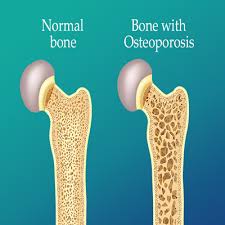
Osteoporosis is a bone disease that develops when bone mineral density and bone mass decreases, or when the structure and strength of bone changes. This can lead to a decrease in bone strength that ca
Osteoporosis is a bone disease that develops when bone mineral density and bone mass decreases, or when the structure and strength of bone changes. This can lead to a decrease in bone strength that can increase the risk of fractures (broken bones).
Symptoms-
Back pain, caused by a broken or collapsed bone in the spine.
Loss of height over time.
A stooped posture.
A bone that breaks much more easily than expected.
Causes-
A major cause is not having enough calcium to build new bone tissue.
A decrease in estrogen in women at the time of menopause and a decrease in testosterone in men as they age
Being confined to a bed due to a prolonged illness
Having certain medical conditions that cause increased inflammation in the body
Taking certain medicines, such as certain seizure medicines, hormone treatments for prostate or breast cancer, and steroid medicines taken for more than 3 months
Dietary guidelines-
1. Include dairy products such as low-fat and non-fat milk, yogurt and cheese.
2. Eat more vegetables, fruits and whole grains.
3. Limit sugar, salt and phosphate additives.
4. Limit alcohol and caffeine consumption.
Symptoms-
Back pain, caused by a broken or collapsed bone in the spine.
Loss of height over time.
A stooped posture.
A bone that breaks much more easily than expected.
Causes-
A major cause is not having enough calcium to build new bone tissue.
A decrease in estrogen in women at the time of menopause and a decrease in testosterone in men as they age
Being confined to a bed due to a prolonged illness
Having certain medical conditions that cause increased inflammation in the body
Taking certain medicines, such as certain seizure medicines, hormone treatments for prostate or breast cancer, and steroid medicines taken for more than 3 months
Dietary guidelines-
1. Include dairy products such as low-fat and non-fat milk, yogurt and cheese.
2. Eat more vegetables, fruits and whole grains.
3. Limit sugar, salt and phosphate additives.
4. Limit alcohol and caffeine consumption.
Endometriosis
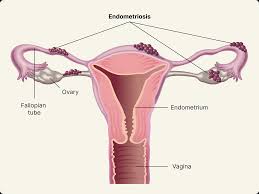
What is endometriosis?
Endometriosis is a condition where tissue that is similar to the lining of your uterus grows on other parts of your body. When this tissue grows in the wrong places, it can cau
Endometriosis is a condition where tissue that is similar to the lining of your uterus grows on other parts of your body. When this tissue grows in the wrong places, it can cau
What is endometriosis?
Endometriosis is a condition where tissue that is similar to the lining of your uterus grows on other parts of your body. When this tissue grows in the wrong places, it can cause painful symptoms that can impact not only your menstrual cycle but also your daily life. Some people with endometriosis have trouble getting pregnant due to scarring and fallopian tube blockage as well.
Symptoms-
Very painful menstrual cramps.
Abdominal pain or back pain during your period or in between periods.
Heavy bleeding during periods or spotting (light bleeding) between periods.
Infertility.
Pain when pooping or peeing.
Stomach problems like diarrhea, constipation or bloating.
Dietary Guidelines-
1. Gluten-free options like brown rice, quinoa, and gluten-free oats can be great sources of whole grains without triggering symptoms for those with celiac
disease or gluten intolerance.
2. Foods high in fatty acids, such as salmon, tuna, and other fatty fish, are rich in omega-3 fatty acids, which can help reduce inflammation.
3. Dark leafy greens such as kale, spinach, and collard greens are rich in vitamins and minerals and can help reduce inflammation.
4. High-antioxidant foods like blueberries, raspberries, and dark chocolate can help neutralize free radicals and protect against damage from oxidative stress.
5. Foods rich in non-heme iron, such as beans, lentils, and leafy greens, can help replenish iron lost during menstruation and reduce the risk of anemia.
Food to be avoided-
1. Trans Fats – Trans unsaturated fatty acids, commonly found in fast foods, fried foods and baked goods, can increase inflammation and contribute to painful
menstrual cramps. Not only this
2. Avoiding Gluten – Gluten can cause inflammation in the gut and worsen endometriosis pain in many women who are intolerant or have celiac disease.
3. Alcohol – Increased consumption and regular alcohol intake can spur inflammation and negatively impact estrogen levels.
Endometriosis is a condition where tissue that is similar to the lining of your uterus grows on other parts of your body. When this tissue grows in the wrong places, it can cause painful symptoms that can impact not only your menstrual cycle but also your daily life. Some people with endometriosis have trouble getting pregnant due to scarring and fallopian tube blockage as well.
Symptoms-
Very painful menstrual cramps.
Abdominal pain or back pain during your period or in between periods.
Heavy bleeding during periods or spotting (light bleeding) between periods.
Infertility.
Pain when pooping or peeing.
Stomach problems like diarrhea, constipation or bloating.
Dietary Guidelines-
1. Gluten-free options like brown rice, quinoa, and gluten-free oats can be great sources of whole grains without triggering symptoms for those with celiac
disease or gluten intolerance.
2. Foods high in fatty acids, such as salmon, tuna, and other fatty fish, are rich in omega-3 fatty acids, which can help reduce inflammation.
3. Dark leafy greens such as kale, spinach, and collard greens are rich in vitamins and minerals and can help reduce inflammation.
4. High-antioxidant foods like blueberries, raspberries, and dark chocolate can help neutralize free radicals and protect against damage from oxidative stress.
5. Foods rich in non-heme iron, such as beans, lentils, and leafy greens, can help replenish iron lost during menstruation and reduce the risk of anemia.
Food to be avoided-
1. Trans Fats – Trans unsaturated fatty acids, commonly found in fast foods, fried foods and baked goods, can increase inflammation and contribute to painful
menstrual cramps. Not only this
2. Avoiding Gluten – Gluten can cause inflammation in the gut and worsen endometriosis pain in many women who are intolerant or have celiac disease.
3. Alcohol – Increased consumption and regular alcohol intake can spur inflammation and negatively impact estrogen levels.
Vegan diet
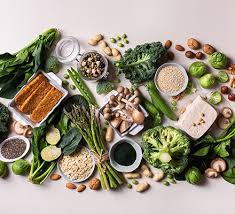
What is Vegan diet?
A vegan diet is based on plants (such as vegetables, grains, nuts and fruits) and foods made from plants.Vegans do not eat foods that come from animals, including dairy products a
A vegan diet is based on plants (such as vegetables, grains, nuts and fruits) and foods made from plants.Vegans do not eat foods that come from animals, including dairy products a
What is Vegan diet?
A vegan diet is based on plants (such as vegetables, grains, nuts and fruits) and foods made from plants.Vegans do not eat foods that come from animals, including dairy products and eggs.
Vegan vs. vegetarian
It's easy to confuse veganism and vegetarianism. They're quite similar. But a vegan diet is stricter than a vegetarian diet. Vegetarians don't eat the flesh of animals, such as meat, poultry, and fish, but they often eat dairy and eggs. Vegans don't eat any animal foods. This even includes foods that are produced by animals, such as honey.
Health benefits-
1. Help in weight management
2. More nutritious
3. Increases energy
4. Prevents heart disease
5. Boosts immunity and prevents chances of cancer
A vegan diet is based on plants (such as vegetables, grains, nuts and fruits) and foods made from plants.Vegans do not eat foods that come from animals, including dairy products and eggs.
Vegan vs. vegetarian
It's easy to confuse veganism and vegetarianism. They're quite similar. But a vegan diet is stricter than a vegetarian diet. Vegetarians don't eat the flesh of animals, such as meat, poultry, and fish, but they often eat dairy and eggs. Vegans don't eat any animal foods. This even includes foods that are produced by animals, such as honey.
Health benefits-
1. Help in weight management
2. More nutritious
3. Increases energy
4. Prevents heart disease
5. Boosts immunity and prevents chances of cancer
Passion Fruit
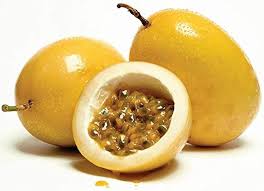
What Is Passion Fruit?
Passion fruit is a tropical fruit that most often has purple or yellow skin. At first glance, you might mistake it for a small lemon or a plum. Slice it in half and you find cr
Passion fruit is a tropical fruit that most often has purple or yellow skin. At first glance, you might mistake it for a small lemon or a plum. Slice it in half and you find cr
What Is Passion Fruit?
Passion fruit is a tropical fruit that most often has purple or yellow skin. At first glance, you might mistake it for a small lemon or a plum. Slice it in half and you find crunchy seeds in juicy yellow pulp. The seeds and pulp are good to eat and have potential health benefits.
Types of Passion Fruit-
1. Purple passion fruit
2. Yellow passion fruit
3. Sweet granadilla
4. Giant granadilla
Health Benefits-
1. Rich in antioxidants
2. Good source of fiber
3. Passion fruit is a tropical fruit that has a low glycemic index (GI) value. This means that it does not cause a steep increase in blood sugar after eating it, making
it a good option for people with diabetes.
4. Improve insulin sensitivity
5. Passion fruit is rich in vitamin C, an antioxidant that helps protect the body from damage caused by free radicals.
6. Passion fruit contains heart-healthy potassium and is also low in sodium.
7. Passion fruit contains magnesium, an important mineral that scientists have linked with decreased stress and anxiety.
Passion fruit is a tropical fruit that most often has purple or yellow skin. At first glance, you might mistake it for a small lemon or a plum. Slice it in half and you find crunchy seeds in juicy yellow pulp. The seeds and pulp are good to eat and have potential health benefits.
Types of Passion Fruit-
1. Purple passion fruit
2. Yellow passion fruit
3. Sweet granadilla
4. Giant granadilla
Health Benefits-
1. Rich in antioxidants
2. Good source of fiber
3. Passion fruit is a tropical fruit that has a low glycemic index (GI) value. This means that it does not cause a steep increase in blood sugar after eating it, making
it a good option for people with diabetes.
4. Improve insulin sensitivity
5. Passion fruit is rich in vitamin C, an antioxidant that helps protect the body from damage caused by free radicals.
6. Passion fruit contains heart-healthy potassium and is also low in sodium.
7. Passion fruit contains magnesium, an important mineral that scientists have linked with decreased stress and anxiety.
Dragon Fruit

What Is Dragon Fruit?
Dragon fruit is a tropical fruit that grows on a climbing cactus called hylocereus. The plant’s name comes from the Greek word "hyle," which means woody, and the Latin word "c
Dragon fruit is a tropical fruit that grows on a climbing cactus called hylocereus. The plant’s name comes from the Greek word "hyle," which means woody, and the Latin word "c
What Is Dragon Fruit?
Dragon fruit is a tropical fruit that grows on a climbing cactus called hylocereus. The plant’s name comes from the Greek word "hyle," which means woody, and the Latin word "cereus," which means waxen.
Types of Dragon Fruit -
1. White dragon fruit
2. Red dragon fruit
3. Yellow dragon fruit
Health benefits-
1. Help prevent oxidative damage.
2. Help with weight management
3. Ease constipation.
4. Help lower blood sugar.
5. Improve gut health.
6. Strengthen the immune system.
7. Reduce inflammation.
8. Boost iron levels and increase iron absorption.
9. Improve skin health
Dragon fruit is a tropical fruit that grows on a climbing cactus called hylocereus. The plant’s name comes from the Greek word "hyle," which means woody, and the Latin word "cereus," which means waxen.
Types of Dragon Fruit -
1. White dragon fruit
2. Red dragon fruit
3. Yellow dragon fruit
Health benefits-
1. Help prevent oxidative damage.
2. Help with weight management
3. Ease constipation.
4. Help lower blood sugar.
5. Improve gut health.
6. Strengthen the immune system.
7. Reduce inflammation.
8. Boost iron levels and increase iron absorption.
9. Improve skin health
Kiwi
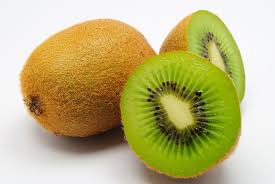
kiwi, (Actinidia deliciosa), woody vine and edible fruit of the family Actinidiaceae. The plant is native to mainland China and Taiwan and is also grown commercially in New Zealand and California. The
kiwi, (Actinidia deliciosa), woody vine and edible fruit of the family Actinidiaceae. The plant is native to mainland China and Taiwan and is also grown commercially in New Zealand and California. The fruit has a slightly acid taste and can be eaten.
Nutritional composition of a 100-gram serving of kiwifruit
Calories- 64 Kcal
Carbs- 14 grams
Fiber- 3 grams
Fat - 0.44 grams
Protein - 1 gram
Health Benefits-
1. Helps to maintain gut health
2. High in Vitamin C that's why it boosts immune system so it can fight off illnesses, Fights fatigue, Helps your body absorb iron, which you need to make red
blood cells, so oxygen can travel to your organs and tissues, Makes collagen in your skin, which helps wounds heal and keeps healthy skin.
3. Provides vitamin E
4. Because it contains vitamin C and vitamin E, kiwi is also a great source of antioxidants. These nutrients fight cell damage caused by free radicals.
5. Good source of potassium
6. Rich in vitamin K
Nutritional composition of a 100-gram serving of kiwifruit
Calories- 64 Kcal
Carbs- 14 grams
Fiber- 3 grams
Fat - 0.44 grams
Protein - 1 gram
Health Benefits-
1. Helps to maintain gut health
2. High in Vitamin C that's why it boosts immune system so it can fight off illnesses, Fights fatigue, Helps your body absorb iron, which you need to make red
blood cells, so oxygen can travel to your organs and tissues, Makes collagen in your skin, which helps wounds heal and keeps healthy skin.
3. Provides vitamin E
4. Because it contains vitamin C and vitamin E, kiwi is also a great source of antioxidants. These nutrients fight cell damage caused by free radicals.
5. Good source of potassium
6. Rich in vitamin K
Gestational diabetes
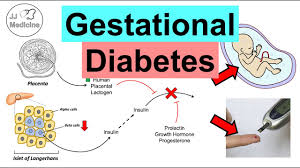
Gestational diabetes (GD or GDM) is a type of diabetes that develops exclusively in pregnancy when blood sugar levels get too high (hyperglycemia). It happens when the hormones from the placenta block
Gestational diabetes (GD or GDM) is a type of diabetes that develops exclusively in pregnancy when blood sugar levels get too high (hyperglycemia). It happens when the hormones from the placenta block your ability to use or make insulin. Insulin helps your body maintain the right amount of glucose in your blood. Too much glucose in your blood can lead to pregnancy complications. GD usually appears during the middle of pregnancy, between 24 and 28 weeks.
Symptoms-
Frequent urination.
Excessive thirst.
Tiredness.
Nausea.
Causes-
Gestational diabetes comes from hormonal changes and the way your body converts food into energy.A hormone called insulin breaks down the glucose (sugar) from food and delivers it to your cells. Insulin keeps the level of glucose in your blood at a healthy level. But if insulin doesn’t work right or you don’t have enough of it, sugar builds up in your blood and leads to diabetes. During pregnancy, hormones from the placenta can interfere with the way insulin works. It may not regulate your blood sugar levels like it’s supposed to, which can lead to gestational diabetes.
Dietary Management-
1. eat regularly – usually three meals a day – and avoid skipping meals
2. Eat starchy and low glycaemic index (GI) foods that release sugar slowly – such as wholewheat pasta, brown rice, granary bread, all-bran cereals, pulses,
beans, lentils, muesli and plain porridge
3. Eat plenty of fruit and vegetables – aim for at least 5 portions a day
4. Avoid sugary foods – you do not need a completely sugar-free diet, but swap snacks such as cakes and biscuits for healthier alternatives such as fruit, nuts
and seeds
5. Avoid sugary drinks – diet or sugar-free drinks are better than sugary versions.
Symptoms-
Frequent urination.
Excessive thirst.
Tiredness.
Nausea.
Causes-
Gestational diabetes comes from hormonal changes and the way your body converts food into energy.A hormone called insulin breaks down the glucose (sugar) from food and delivers it to your cells. Insulin keeps the level of glucose in your blood at a healthy level. But if insulin doesn’t work right or you don’t have enough of it, sugar builds up in your blood and leads to diabetes. During pregnancy, hormones from the placenta can interfere with the way insulin works. It may not regulate your blood sugar levels like it’s supposed to, which can lead to gestational diabetes.
Dietary Management-
1. eat regularly – usually three meals a day – and avoid skipping meals
2. Eat starchy and low glycaemic index (GI) foods that release sugar slowly – such as wholewheat pasta, brown rice, granary bread, all-bran cereals, pulses,
beans, lentils, muesli and plain porridge
3. Eat plenty of fruit and vegetables – aim for at least 5 portions a day
4. Avoid sugary foods – you do not need a completely sugar-free diet, but swap snacks such as cakes and biscuits for healthier alternatives such as fruit, nuts
and seeds
5. Avoid sugary drinks – diet or sugar-free drinks are better than sugary versions.
Pneumonia
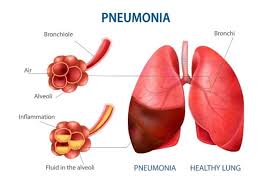
What is pneumonia?
Pneumonia is an infection in your lungs caused by bacteria, viruses or fungi. Pneumonia causes your lung tissue to swell (inflammation) and can cause fluid or pus in your lungs. Ba
Pneumonia is an infection in your lungs caused by bacteria, viruses or fungi. Pneumonia causes your lung tissue to swell (inflammation) and can cause fluid or pus in your lungs. Ba
What is pneumonia?
Pneumonia is an infection in your lungs caused by bacteria, viruses or fungi. Pneumonia causes your lung tissue to swell (inflammation) and can cause fluid or pus in your lungs. Bacterial pneumonia is usually more severe than viral pneumonia, which often resolves on its own.Pneumonia can affect one or both lungs. Pneumonia in both of your lungs is called bilateral or double pneumonia.
What causes pneumonia?
Pneumonia is caused by bacteria, viruses or fungus. There are literally dozens of different causes of pneumonia, grouped by the most common types. These are:
1. Bacterial pneumonia. This is caused by bacteria, the most common of which is streptococcus pneumoniae. The pneumonia might just affect one small area of
your lung, or it may encompass all of both of your lungs.
2. Viral pneumonia. Responsible for about one-third of all pneumonia cases, this type is caused by various viruses, including flu (influenza). People may be more
likely to get bacterial pneumonia if they first have viral pneumonia. Viral pneumonia is usually not as serious as bacterial and typically goes away more
quickly.
3. Mycoplasma pneumonia. Also known as walking pneumonia, this type is considered atypical because its symptoms and physical signs may vary. Also, it
causes a milder illness. It most often occurs in older children and young adults.
4. Fungal pneumonia. Fungi from soil or bird droppings can cause pneumonia in people who inhale large amounts of these organisms. One type, pneumocystis
jirovecii pneumonia (PCP), generally affects people with weak immune systems, including those with AIDS.
Symptoms-
High fever (up to 105 F or 40.55 C).
Cough with yellow, green or bloody mucus.
Tiredness (fatigue).
Rapid breathing.
Shortness of breath.
Rapid heart rate.
Sweating or chills.
Chest pain and/or abdominal pain, especially with coughing or deep breathing.
Loss of appetite.
Bluish skin, lips or nails (cyanosis).
Confusion or altered mental state.
Dietary Guidelines-
1. Whole Grains-Whole grains like brown rice, oats, and barley have good carbohydrate content to give the energy one needs to recover. The selenium content
present in whole grains boosts the immune system as well.
2. Green Leafy Vegetables-Spinach, kale, and other green leafy vegetables contain antioxidants that help with the healing of respiratory infections like
pneumonia faster.
3. Protein-rich Foods-Nuts, beans, seeds, chicken, and fish like salmon have anti-inflammatory properties. A protein-rich diet helps build new tissues in the body
and replace the damaged lung tissues affected by pneumonia.
4. Yoghurt- Yoghurt has excellent probiotics which promote good bacteria in the gut, and also suppress the growth of pneumonia-causing pathogens.
5. Water- Apart from the above 4 best food to prevent pneumonia, drinking water is very important. It is important to keep oneself hydrated with water and other healthy liquids like tender coconut water. This loosens the mucus that builds up in the lungs during the pneumonia infection. Water also flushes out
toxins from the body.
Food to Avoid in Pneumonia-
1. Alcohol
2. Sugary Drinks
3. Foods High in Sodium
Pneumonia is an infection in your lungs caused by bacteria, viruses or fungi. Pneumonia causes your lung tissue to swell (inflammation) and can cause fluid or pus in your lungs. Bacterial pneumonia is usually more severe than viral pneumonia, which often resolves on its own.Pneumonia can affect one or both lungs. Pneumonia in both of your lungs is called bilateral or double pneumonia.
What causes pneumonia?
Pneumonia is caused by bacteria, viruses or fungus. There are literally dozens of different causes of pneumonia, grouped by the most common types. These are:
1. Bacterial pneumonia. This is caused by bacteria, the most common of which is streptococcus pneumoniae. The pneumonia might just affect one small area of
your lung, or it may encompass all of both of your lungs.
2. Viral pneumonia. Responsible for about one-third of all pneumonia cases, this type is caused by various viruses, including flu (influenza). People may be more
likely to get bacterial pneumonia if they first have viral pneumonia. Viral pneumonia is usually not as serious as bacterial and typically goes away more
quickly.
3. Mycoplasma pneumonia. Also known as walking pneumonia, this type is considered atypical because its symptoms and physical signs may vary. Also, it
causes a milder illness. It most often occurs in older children and young adults.
4. Fungal pneumonia. Fungi from soil or bird droppings can cause pneumonia in people who inhale large amounts of these organisms. One type, pneumocystis
jirovecii pneumonia (PCP), generally affects people with weak immune systems, including those with AIDS.
Symptoms-
High fever (up to 105 F or 40.55 C).
Cough with yellow, green or bloody mucus.
Tiredness (fatigue).
Rapid breathing.
Shortness of breath.
Rapid heart rate.
Sweating or chills.
Chest pain and/or abdominal pain, especially with coughing or deep breathing.
Loss of appetite.
Bluish skin, lips or nails (cyanosis).
Confusion or altered mental state.
Dietary Guidelines-
1. Whole Grains-Whole grains like brown rice, oats, and barley have good carbohydrate content to give the energy one needs to recover. The selenium content
present in whole grains boosts the immune system as well.
2. Green Leafy Vegetables-Spinach, kale, and other green leafy vegetables contain antioxidants that help with the healing of respiratory infections like
pneumonia faster.
3. Protein-rich Foods-Nuts, beans, seeds, chicken, and fish like salmon have anti-inflammatory properties. A protein-rich diet helps build new tissues in the body
and replace the damaged lung tissues affected by pneumonia.
4. Yoghurt- Yoghurt has excellent probiotics which promote good bacteria in the gut, and also suppress the growth of pneumonia-causing pathogens.
5. Water- Apart from the above 4 best food to prevent pneumonia, drinking water is very important. It is important to keep oneself hydrated with water and other healthy liquids like tender coconut water. This loosens the mucus that builds up in the lungs during the pneumonia infection. Water also flushes out
toxins from the body.
Food to Avoid in Pneumonia-
1. Alcohol
2. Sugary Drinks
3. Foods High in Sodium
Hiatal Hernia
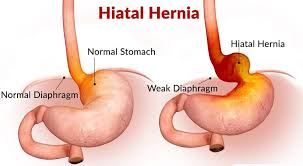
What is a hiatal hernia?
A hiatal hernia happens when the upper part of the stomach bulges through the large muscle that separates the abdomen and the chest. The muscle is called the diaphragm.The di
A hiatal hernia happens when the upper part of the stomach bulges through the large muscle that separates the abdomen and the chest. The muscle is called the diaphragm.The di
What is a hiatal hernia?
A hiatal hernia happens when the upper part of the stomach bulges through the large muscle that separates the abdomen and the chest. The muscle is called the diaphragm.The diaphragm has a small opening called a hiatus. The tube used for swallowing food, called the esophagus, passes through the hiatus before connecting to the stomach. In a hiatal hernia, the stomach pushes up through that opening and into the chest.
Causes-
Age-related changes in your diaphragm.
Injury to the area, for example, after trauma or certain types of surgery.
Being born with a very large hiatus.
Constant and intense pressure on the surrounding muscles. This can happen while coughing, vomiting, straining during a bowel movement, exercising or lifting heavy objects.
Symptoms-
Heartburn.
Backward flow of swallowed food or liquids into the mouth, called regurgitation.
Backflow of stomach acid into the esophagus, called acid reflux.
Trouble swallowing.
Chest or abdominal pain.
Feeling full soon after you eat.
Shortness of breath.
Vomiting of blood or passing of black stools, which could mean bleeding in the digestive tract.
Dietary Guidelines-
1.Low-fat food items and dairy products are preferable. Patients can have skimmed milk or yogurt.
2. A lot of water intake is necessary. Patients are told to have as much water as they could.
3. Whole grain food items like Brown Bread, brown rice, whole grain pasta are a good source of fibre. This would help overcome the problem of constipation.
4. Baked/broiled items are preferably better to be consumed rather than fried items.
5. Green and leafy vegetables rich in Vitamin B and calcium must be included in the diet. Eg: Broccoli, spinach, capsicum.
6. Apple and bananas are the most preferred fruits for hiatal hernia patients as they are known to reduce acid production in the stomach.
Foods to be avoided in a Hiatal Hernia:
1. Citrus fruits like oranges, lemons, grapes must be avoided as they can cause heartburn problems due to sour taste.
2. Spicy and fried food preparations
3. Vegetables like Onion and garlic, tomatoes, chilli must be avoided. Food items prepared using these ingredients must be avoided to get rid of acidity issues.
4. Using too much of oil and butter in food preparation should be avoided.
5. Large quantities of caffeine must be avoided and the intake of tea/coffee must be reduced.
6. Carbonated drinks, chocolates, and peppermint can also aggravate the symptoms.
7. High-fat dairy products and milk must be avoided.
A hiatal hernia happens when the upper part of the stomach bulges through the large muscle that separates the abdomen and the chest. The muscle is called the diaphragm.The diaphragm has a small opening called a hiatus. The tube used for swallowing food, called the esophagus, passes through the hiatus before connecting to the stomach. In a hiatal hernia, the stomach pushes up through that opening and into the chest.
Causes-
Age-related changes in your diaphragm.
Injury to the area, for example, after trauma or certain types of surgery.
Being born with a very large hiatus.
Constant and intense pressure on the surrounding muscles. This can happen while coughing, vomiting, straining during a bowel movement, exercising or lifting heavy objects.
Symptoms-
Heartburn.
Backward flow of swallowed food or liquids into the mouth, called regurgitation.
Backflow of stomach acid into the esophagus, called acid reflux.
Trouble swallowing.
Chest or abdominal pain.
Feeling full soon after you eat.
Shortness of breath.
Vomiting of blood or passing of black stools, which could mean bleeding in the digestive tract.
Dietary Guidelines-
1.Low-fat food items and dairy products are preferable. Patients can have skimmed milk or yogurt.
2. A lot of water intake is necessary. Patients are told to have as much water as they could.
3. Whole grain food items like Brown Bread, brown rice, whole grain pasta are a good source of fibre. This would help overcome the problem of constipation.
4. Baked/broiled items are preferably better to be consumed rather than fried items.
5. Green and leafy vegetables rich in Vitamin B and calcium must be included in the diet. Eg: Broccoli, spinach, capsicum.
6. Apple and bananas are the most preferred fruits for hiatal hernia patients as they are known to reduce acid production in the stomach.
Foods to be avoided in a Hiatal Hernia:
1. Citrus fruits like oranges, lemons, grapes must be avoided as they can cause heartburn problems due to sour taste.
2. Spicy and fried food preparations
3. Vegetables like Onion and garlic, tomatoes, chilli must be avoided. Food items prepared using these ingredients must be avoided to get rid of acidity issues.
4. Using too much of oil and butter in food preparation should be avoided.
5. Large quantities of caffeine must be avoided and the intake of tea/coffee must be reduced.
6. Carbonated drinks, chocolates, and peppermint can also aggravate the symptoms.
7. High-fat dairy products and milk must be avoided.
Hypoglycemia
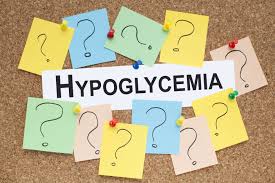
What is hypoglycemia (low blood sugar)?
Hypoglycemia happens when the level of sugar (glucose) in your blood drops below the range that’s healthy for you. It’s also called low blood sugar or low
Hypoglycemia happens when the level of sugar (glucose) in your blood drops below the range that’s healthy for you. It’s also called low blood sugar or low
What is hypoglycemia (low blood sugar)?
Hypoglycemia happens when the level of sugar (glucose) in your blood drops below the range that’s healthy for you. It’s also called low blood sugar or low blood glucose. Hypoglycemia is common in people with diabetes, especially Type 1 diabetes.
Symptoms-
Shaking or trembling.
Weakness.
Sweating and chills.
Extreme hunger (polyphagia).
Faster heart rate.
Dizziness or lightheadedness.
Confusion or trouble concentrating.
Anxiety or irritability.
Color draining from your skin (pallor).
Tingling or numbness in your lips, tongue or cheeks.
Signs of severe hypoglycemia include:
Blurred or double vision.
Slurred speech.
Clumsiness or difficulty with coordination.
Being disoriented.
Seizures.
Loss of consciousness.
What are the complications of low blood sugar?
Prolonged severe hypoglycemia is life-threatening and can lead to the following complications:
Multiple organ failure.
Cardiac arrhythmias.
Cardiac arrest.
Permanent brain damage.
Coma.
Death.
Dietary Guidelines-
1. Choose low glycemic index carbohydrate.
2. Include fiber in diet
3. Include plenty of fruits and vegetables.
4. Choose complex carbohydrate
5. Include protein like lentil, Beans in the diet
6. Avoid food with refined sugar
Hypoglycemia happens when the level of sugar (glucose) in your blood drops below the range that’s healthy for you. It’s also called low blood sugar or low blood glucose. Hypoglycemia is common in people with diabetes, especially Type 1 diabetes.
Symptoms-
Shaking or trembling.
Weakness.
Sweating and chills.
Extreme hunger (polyphagia).
Faster heart rate.
Dizziness or lightheadedness.
Confusion or trouble concentrating.
Anxiety or irritability.
Color draining from your skin (pallor).
Tingling or numbness in your lips, tongue or cheeks.
Signs of severe hypoglycemia include:
Blurred or double vision.
Slurred speech.
Clumsiness or difficulty with coordination.
Being disoriented.
Seizures.
Loss of consciousness.
What are the complications of low blood sugar?
Prolonged severe hypoglycemia is life-threatening and can lead to the following complications:
Multiple organ failure.
Cardiac arrhythmias.
Cardiac arrest.
Permanent brain damage.
Coma.
Death.
Dietary Guidelines-
1. Choose low glycemic index carbohydrate.
2. Include fiber in diet
3. Include plenty of fruits and vegetables.
4. Choose complex carbohydrate
5. Include protein like lentil, Beans in the diet
6. Avoid food with refined sugar
Lactose intolerance
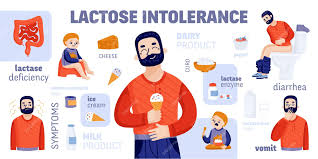
What is lactose intolerance?
Lactose intolerance is a reaction in your digestive system to lactose, the sugar in milk. It causes uncomfortable symptoms after you eat dairy products. Many people have
Lactose intolerance is a reaction in your digestive system to lactose, the sugar in milk. It causes uncomfortable symptoms after you eat dairy products. Many people have
What is lactose intolerance?
Lactose intolerance is a reaction in your digestive system to lactose, the sugar in milk. It causes uncomfortable symptoms after you eat dairy products. Many people have difficulty digesting lactose. It’s called lactose intolerance.
What causes lactose intolerance?
Two factors contribute to lactose intolerance: lactose malabsorption and gut sensitivity. Lactose malabsorption is the most important factor. It’s the inability to break down and absorb lactose in your small intestine that leads to lactose later entering your large intestine and triggering symptoms.
Small intestine needs a specific enzyme, called lactase, to break down lactose into smaller molecules that it can absorb. Most people naturally produce lactase in their small intestines during infancy to help digest breast milk. Most people begin to make less of it as they grow up.
Symptoms-
Bloated stomach.
Intestinal gas.
Nausea and vomiting.
Stomach pain and cramping.
Stomach gurgling or rumbling.
Diarrhea.
Foods to be included-
1. Fruits: apples, oranges, berries, peaches, plums, grapes, pineapples, mangoes
2. Vegetables: onions, garlic, broccoli, kale, spinach, arugula, collard greens, zucchini, carrot
3. Soy foods: tofu, tempeh, natto, miso
4. Legumes: black beans, kidney beans, lentils, pinto beans, chickpeas
5. Whole grains: barley, buckwheat, quinoa, couscous, wheat, farro, oats
6. Nuts: almonds, walnuts, pistachios, cashews, Brazil nuts, hazelnuts
7. Seeds: chia seeds, flax seeds, sunflower seeds, pumpkin seeds
8. Milk alternatives: lactose-free milk, rice milk, almond milk, oat milk, coconut milk, cashew milk, hemp milk
9. Lactose-free yogurts: coconut yogurt, almond milk yogurt, soy yogurt, cashew yogurt
10.Healthy fats: avocados, olive oil, sesame oil, coconut oil
11.Herbs and spices: turmeric, oregano, rosemary, basil, dill, mint
12.Beverages: water, tea, brewed coffee, coconut water, juice
Food to be avoided-
1. Milk — all types of cow’s milk, goat’s milk, and buffalo milk
2. Cheese — especially soft cheeses, such as cream cheese, cottage cheese, mozzarella, and ricotta
3. Butter
4. Yogurt
5. Ice cream, frozen yogurt, and dairy-based sherbet
6. Buttermilk
7. Sour cream
8. whipped cream
Lactose intolerance is a reaction in your digestive system to lactose, the sugar in milk. It causes uncomfortable symptoms after you eat dairy products. Many people have difficulty digesting lactose. It’s called lactose intolerance.
What causes lactose intolerance?
Two factors contribute to lactose intolerance: lactose malabsorption and gut sensitivity. Lactose malabsorption is the most important factor. It’s the inability to break down and absorb lactose in your small intestine that leads to lactose later entering your large intestine and triggering symptoms.
Small intestine needs a specific enzyme, called lactase, to break down lactose into smaller molecules that it can absorb. Most people naturally produce lactase in their small intestines during infancy to help digest breast milk. Most people begin to make less of it as they grow up.
Symptoms-
Bloated stomach.
Intestinal gas.
Nausea and vomiting.
Stomach pain and cramping.
Stomach gurgling or rumbling.
Diarrhea.
Foods to be included-
1. Fruits: apples, oranges, berries, peaches, plums, grapes, pineapples, mangoes
2. Vegetables: onions, garlic, broccoli, kale, spinach, arugula, collard greens, zucchini, carrot
3. Soy foods: tofu, tempeh, natto, miso
4. Legumes: black beans, kidney beans, lentils, pinto beans, chickpeas
5. Whole grains: barley, buckwheat, quinoa, couscous, wheat, farro, oats
6. Nuts: almonds, walnuts, pistachios, cashews, Brazil nuts, hazelnuts
7. Seeds: chia seeds, flax seeds, sunflower seeds, pumpkin seeds
8. Milk alternatives: lactose-free milk, rice milk, almond milk, oat milk, coconut milk, cashew milk, hemp milk
9. Lactose-free yogurts: coconut yogurt, almond milk yogurt, soy yogurt, cashew yogurt
10.Healthy fats: avocados, olive oil, sesame oil, coconut oil
11.Herbs and spices: turmeric, oregano, rosemary, basil, dill, mint
12.Beverages: water, tea, brewed coffee, coconut water, juice
Food to be avoided-
1. Milk — all types of cow’s milk, goat’s milk, and buffalo milk
2. Cheese — especially soft cheeses, such as cream cheese, cottage cheese, mozzarella, and ricotta
3. Butter
4. Yogurt
5. Ice cream, frozen yogurt, and dairy-based sherbet
6. Buttermilk
7. Sour cream
8. whipped cream
Irritable bowel syndrome (IBS)
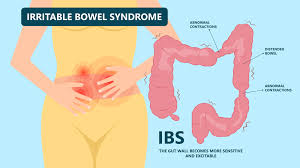
What is irritable bowel syndrome (IBS)?
Irritable bowel syndrome (IBS) is a group of symptoms that affect the digestive system. It’s a common but uncomfortable gastrointestinal disease, or conditio
Irritable bowel syndrome (IBS) is a group of symptoms that affect the digestive system. It’s a common but uncomfortable gastrointestinal disease, or conditio
What is irritable bowel syndrome (IBS)?
Irritable bowel syndrome (IBS) is a group of symptoms that affect the digestive system. It’s a common but uncomfortable gastrointestinal disease, or condition that affects the intestines.People with IBS experience symptoms that include abdominal pain and cramps. With IBS, you may also have frequent diarrhea, constipation or both. IBS doesn’t cause tissue damage in your GI (gastrointestinal) tract or increase your risk of more serious conditions, like colon cancer.
Causes-
1. Dysmotility: You may have problems with how your GI muscles contract and move food through your GI tract. The colon (large intestine) muscle tends to
contract more in people with IBS. These contractions cause cramps and pain.
2. Visceral hypersensitivity: You may have extra-sensitive nerves in your GI tract. People with IBS tend to have a lower pain tolerance than people without it.
Your digestive tract may be super sensitive to abdominal pain or discomfort
3. Gut bacteria: Research has shown that people with IBS may have altered bacteria in their GI tract, contributing to symptoms. Studies have shown that the
types and amounts of gut bacteria are different in people with IBS than in people without it.
4. Severe infections: Some people get diagnosed with IBS after a severe infection affecting their GI tract, suggesting germs may play a role.
5. Food intolerance: Sensitivities or allergies to certain foods may contribute to IBS.
6. Childhood stress: IBS is more common in people who experienced severe stressors in childhood, including physical, sexual and emotional abuse.
Symptoms-
Abdominal pain or cramps, usually related to the urge to poop.
Excess gas and bloating.
Diarrhea, constipation or alternating between the two.
Mucus in your poop (may look whitish).
Feeling like you’re unable to empty bowels after pooping.
Dietary Guidelines-
1. Increase fiber in your diet.
2. Limit dairy products, like cheese and milk.
3. Limit foods like beans, brussels sprouts and cabbage are notorious for causing gas.
4. Avoid gluten.
5. Drink plenty of water.
Irritable bowel syndrome (IBS) is a group of symptoms that affect the digestive system. It’s a common but uncomfortable gastrointestinal disease, or condition that affects the intestines.People with IBS experience symptoms that include abdominal pain and cramps. With IBS, you may also have frequent diarrhea, constipation or both. IBS doesn’t cause tissue damage in your GI (gastrointestinal) tract or increase your risk of more serious conditions, like colon cancer.
Causes-
1. Dysmotility: You may have problems with how your GI muscles contract and move food through your GI tract. The colon (large intestine) muscle tends to
contract more in people with IBS. These contractions cause cramps and pain.
2. Visceral hypersensitivity: You may have extra-sensitive nerves in your GI tract. People with IBS tend to have a lower pain tolerance than people without it.
Your digestive tract may be super sensitive to abdominal pain or discomfort
3. Gut bacteria: Research has shown that people with IBS may have altered bacteria in their GI tract, contributing to symptoms. Studies have shown that the
types and amounts of gut bacteria are different in people with IBS than in people without it.
4. Severe infections: Some people get diagnosed with IBS after a severe infection affecting their GI tract, suggesting germs may play a role.
5. Food intolerance: Sensitivities or allergies to certain foods may contribute to IBS.
6. Childhood stress: IBS is more common in people who experienced severe stressors in childhood, including physical, sexual and emotional abuse.
Symptoms-
Abdominal pain or cramps, usually related to the urge to poop.
Excess gas and bloating.
Diarrhea, constipation or alternating between the two.
Mucus in your poop (may look whitish).
Feeling like you’re unable to empty bowels after pooping.
Dietary Guidelines-
1. Increase fiber in your diet.
2. Limit dairy products, like cheese and milk.
3. Limit foods like beans, brussels sprouts and cabbage are notorious for causing gas.
4. Avoid gluten.
5. Drink plenty of water.
Cerebrovascular Disease
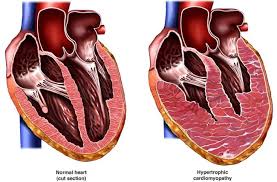
Cerebrovascular disease includes a variety of medical conditions that affect the blood vessels of the brain and the cerebral circulation. Arteries supplying oxygen and nutrients to the brain are often
Cerebrovascular disease includes a variety of medical conditions that affect the blood vessels of the brain and the cerebral circulation. Arteries supplying oxygen and nutrients to the brain are often damaged or deformed in these disorders.Cerebrovascular diseases may cause a reduction of blood flow to your brain (ischemia) or bleeding (hemorrhage) in a part of your brain. Both conditions are generally referred to as “stroke.” Blood vessel diseases in the brain can lead to strokes, as well as many other vascular conditions.
What are the types of cerebrovascular disease?
Stroke is the most common type of cerebrovascular disease. Other types of cerebrovascular disease include, but aren’t limited to:
Arteriovenous malformation (AVM).
Brain aneurysm.
Brain bleed, hemorrhage (intracranial hemorrhage).
Carotid artery disease (carotid artery stenosis).
Cervical artery dissection.
Reversible cerebral vasoconstriction syndrome.
Subarachnoid hemorrhage (SAH).
Transient ischemic attack (TIA) or mini stroke.
Hereditary hemorrhagic telangiectasia (HHT).
Moyamoya disease.
What causes cerebrovascular disease?
Causes of cerebrovascular disease may include:
Blood clot that spontaneously forms in a blood vessel in your brain. This is “thrombosis” and usually happens in areas where your blood vessel is narrow or irregular.
Blood clot that travels to your brain from elsewhere in your body (embolism). The most common type of embolism is when a clot travels from your heart to your brain.
Blood vessel rupture (hemorrhage). This usually occurs in conjunction with uncontrolled high blood pressure.
Plaque build-up in the arteries (atherosclerosis) in your brain.
Structural problems in your brain’s blood vessels.
Traumatic brain injury (TBI).
Symptoms-
Balance problems.
Delirium.
Fainting.
Loss of vision, visual field cut or double vision.
Paralysis or weakness on one side of your body or face.
Sudden, severe headache.
Trouble speaking or understanding speech (aphasia).
Slurred speech (dysarthria).
Sensory changes in one side of your body or face
Dietary guidelines-
1. Control portion sizes
2. Eat more vegetables and fruits
3. Choose whole grains
4. Limit unhealthy fats
5. Choose low-fat protein sources
6. Limit and reduce sodium and salt
What are the types of cerebrovascular disease?
Stroke is the most common type of cerebrovascular disease. Other types of cerebrovascular disease include, but aren’t limited to:
Arteriovenous malformation (AVM).
Brain aneurysm.
Brain bleed, hemorrhage (intracranial hemorrhage).
Carotid artery disease (carotid artery stenosis).
Cervical artery dissection.
Reversible cerebral vasoconstriction syndrome.
Subarachnoid hemorrhage (SAH).
Transient ischemic attack (TIA) or mini stroke.
Hereditary hemorrhagic telangiectasia (HHT).
Moyamoya disease.
What causes cerebrovascular disease?
Causes of cerebrovascular disease may include:
Blood clot that spontaneously forms in a blood vessel in your brain. This is “thrombosis” and usually happens in areas where your blood vessel is narrow or irregular.
Blood clot that travels to your brain from elsewhere in your body (embolism). The most common type of embolism is when a clot travels from your heart to your brain.
Blood vessel rupture (hemorrhage). This usually occurs in conjunction with uncontrolled high blood pressure.
Plaque build-up in the arteries (atherosclerosis) in your brain.
Structural problems in your brain’s blood vessels.
Traumatic brain injury (TBI).
Symptoms-
Balance problems.
Delirium.
Fainting.
Loss of vision, visual field cut or double vision.
Paralysis or weakness on one side of your body or face.
Sudden, severe headache.
Trouble speaking or understanding speech (aphasia).
Slurred speech (dysarthria).
Sensory changes in one side of your body or face
Dietary guidelines-
1. Control portion sizes
2. Eat more vegetables and fruits
3. Choose whole grains
4. Limit unhealthy fats
5. Choose low-fat protein sources
6. Limit and reduce sodium and salt
Role Of Nutrition In Skin Health
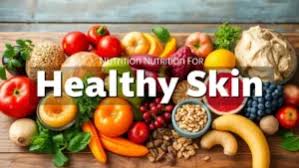
Nutritional status plays an important role in the maintenance of healthy skin . Macronutrients (carbohydrates, proteins, and lipids) and micronutrients (vitamins and nutritionally essential minerals)
Nutritional status plays an important role in the maintenance of healthy skin . Macronutrients (carbohydrates, proteins, and lipids) and micronutrients (vitamins and nutritionally essential minerals) work together to maintain the barrier functions of skin in the face of everyday challenges. Changes in nutritional status that alter skin structure and function can also directly affect skin appearance.
Skin provides a physical and chemical barrier between the outside environment and the inside tissues of the body . This ‘barrier function’ is critical to protect underlying tissues from pathogens, chemicals, and environmental exposures . Structurally, skin is comprised of two main layers, the epidermis and the dermis.
Key Nutrients for Healthy Skin-
The turnover of skin cells is influenced by essential nutrients, ensuring a continuous renewal process for a vibrant complexion.
1. Vitamins
Vitamin A: Essential for skin repair and maintenance, vitamin A promotes cell turnover and helps prevent signs of aging. Sources include sweet potatoes, carrots, spinach and liver.
Vitamin C: A potent antioxidant, vitamin C aids in collagen synthesis, promoting skin elasticity and resilience. Citrus fruits, strawberries, bell peppers and broccoli are rich sources.
Vitamin E: Known for its antioxidant properties, vitamin E protects the skin from oxidative stress and supports overall skin health. Nuts, seeds, spinach and avocados are excellent sources.
Vitamin D: While vitamin D is essential for overall health, moderation in sun exposure and dietary sources like fatty fish contribute to maintaining optimal levels.
2. Minerals
Zinc: This mineral is crucial for wound healing and maintaining skin integrity. Foods rich in zinc include meat, dairy, nuts and legumes.
Copper: Involved in the synthesis of collagen and elastin, copper contributes to skin elasticity. Seafood, nuts, seeds and whole grains are good sources.
Selenium: Selenium, found in foods like Brazil nuts and seafood, contributes to the protection of skin cells against oxidative stress, promoting overall skin health.
3. Fatty Acids
Omega-3 Fatty Acids: Found in fatty fish, flaxseeds and walnuts, omega-3 fatty acids contribute to skin hydration and help manage inflammatory skin conditions.
Omega-6 Fatty Acids: These fatty acids, present in oils such as evening primrose and safflower oil, support skin barrier function and prevent moisture loss.
4. The Impact of Antioxidants
Antioxidants play a crucial role in protecting the skin from damage caused by free radicals – unstable molecules that contribute to premature aging and skin diseases. Various fruits and vegetables, such as berries, tomatoes and leafy greens, are rich sources of antioxidants. Including these foods in your diet can help combat oxidative stress and contribute to a youthful complexion.
5. Hydration and Skin Health
Proper hydration is paramount for skin health. Water is essential for maintaining skin moisture, preventing dehydration and supporting the elimination of toxins through sweat. While external moisturizers are beneficial, internal hydration through adequate water intake is equally crucial. Herbal teas and water-rich foods like watermelon and cucumber contribute to overall hydration, reflecting positively on the skin's appearance.
6. The Gut-Skin Connection
Recent research has shed light on the intricate relationship between gut health and skin conditions. The gut microbiome, a diverse community of microorganisms residing in the digestive tract, influences various aspects of health, including skin. A balanced and diverse microbiome contributes to a well-functioning immune system, reducing the likelihood of inflammatory skin conditions.
7. Probiotics, beneficial bacteria that support gut health, can positively impact the skin. Fermented foods like yogurt, kefir and sauerkraut are rich in probiotics and can aid in maintaining a healthy gut-skin axis. Additionally, prebiotic-rich foods, such as garlic, onions and bananas, provide nourishment for the beneficial bacteria in the gut.
Dietary Habits and Skin Conditions-
1. Inflammatory Foods-Certain foods can contribute to inflammation, which may manifest as skin conditions like acne, eczema, or psoriasis. Processed foods, high in refined sugars and trans fats, are potential culprits. Adopting an anti-inflammatory diet, rich in fruits, vegetables, whole grains and omega-3 fatty acids, may help manage inflammatory skin conditions.
2. Sugar and Aging-Excessive sugar intake can lead to the formation of advanced glycation end products (AGEs), contributing to skin aging. Collagen and elastin, crucial proteins for skin elasticity, are particularly vulnerable to damage caused by AGEs. Limiting the consumption of sugary foods and beverages can contribute to maintaining youthful skin.
3. Acne and Dairy-Hormones and bioactive molecules in dairy products may contribute to increased sebum production and skin inflammation. Individuals with acne-prone skin may benefit from reducing or eliminating dairy from their diet.
4. Eczema and Food Sensitivities-Eczema, characterized by dry, itchy skin, may be influenced by food sensitivities. Common triggers include dairy, eggs and gluten. Identifying and eliminating specific trigger foods can aid in managing eczema symptoms.
Skin provides a physical and chemical barrier between the outside environment and the inside tissues of the body . This ‘barrier function’ is critical to protect underlying tissues from pathogens, chemicals, and environmental exposures . Structurally, skin is comprised of two main layers, the epidermis and the dermis.
Key Nutrients for Healthy Skin-
The turnover of skin cells is influenced by essential nutrients, ensuring a continuous renewal process for a vibrant complexion.
1. Vitamins
Vitamin A: Essential for skin repair and maintenance, vitamin A promotes cell turnover and helps prevent signs of aging. Sources include sweet potatoes, carrots, spinach and liver.
Vitamin C: A potent antioxidant, vitamin C aids in collagen synthesis, promoting skin elasticity and resilience. Citrus fruits, strawberries, bell peppers and broccoli are rich sources.
Vitamin E: Known for its antioxidant properties, vitamin E protects the skin from oxidative stress and supports overall skin health. Nuts, seeds, spinach and avocados are excellent sources.
Vitamin D: While vitamin D is essential for overall health, moderation in sun exposure and dietary sources like fatty fish contribute to maintaining optimal levels.
2. Minerals
Zinc: This mineral is crucial for wound healing and maintaining skin integrity. Foods rich in zinc include meat, dairy, nuts and legumes.
Copper: Involved in the synthesis of collagen and elastin, copper contributes to skin elasticity. Seafood, nuts, seeds and whole grains are good sources.
Selenium: Selenium, found in foods like Brazil nuts and seafood, contributes to the protection of skin cells against oxidative stress, promoting overall skin health.
3. Fatty Acids
Omega-3 Fatty Acids: Found in fatty fish, flaxseeds and walnuts, omega-3 fatty acids contribute to skin hydration and help manage inflammatory skin conditions.
Omega-6 Fatty Acids: These fatty acids, present in oils such as evening primrose and safflower oil, support skin barrier function and prevent moisture loss.
4. The Impact of Antioxidants
Antioxidants play a crucial role in protecting the skin from damage caused by free radicals – unstable molecules that contribute to premature aging and skin diseases. Various fruits and vegetables, such as berries, tomatoes and leafy greens, are rich sources of antioxidants. Including these foods in your diet can help combat oxidative stress and contribute to a youthful complexion.
5. Hydration and Skin Health
Proper hydration is paramount for skin health. Water is essential for maintaining skin moisture, preventing dehydration and supporting the elimination of toxins through sweat. While external moisturizers are beneficial, internal hydration through adequate water intake is equally crucial. Herbal teas and water-rich foods like watermelon and cucumber contribute to overall hydration, reflecting positively on the skin's appearance.
6. The Gut-Skin Connection
Recent research has shed light on the intricate relationship between gut health and skin conditions. The gut microbiome, a diverse community of microorganisms residing in the digestive tract, influences various aspects of health, including skin. A balanced and diverse microbiome contributes to a well-functioning immune system, reducing the likelihood of inflammatory skin conditions.
7. Probiotics, beneficial bacteria that support gut health, can positively impact the skin. Fermented foods like yogurt, kefir and sauerkraut are rich in probiotics and can aid in maintaining a healthy gut-skin axis. Additionally, prebiotic-rich foods, such as garlic, onions and bananas, provide nourishment for the beneficial bacteria in the gut.
Dietary Habits and Skin Conditions-
1. Inflammatory Foods-Certain foods can contribute to inflammation, which may manifest as skin conditions like acne, eczema, or psoriasis. Processed foods, high in refined sugars and trans fats, are potential culprits. Adopting an anti-inflammatory diet, rich in fruits, vegetables, whole grains and omega-3 fatty acids, may help manage inflammatory skin conditions.
2. Sugar and Aging-Excessive sugar intake can lead to the formation of advanced glycation end products (AGEs), contributing to skin aging. Collagen and elastin, crucial proteins for skin elasticity, are particularly vulnerable to damage caused by AGEs. Limiting the consumption of sugary foods and beverages can contribute to maintaining youthful skin.
3. Acne and Dairy-Hormones and bioactive molecules in dairy products may contribute to increased sebum production and skin inflammation. Individuals with acne-prone skin may benefit from reducing or eliminating dairy from their diet.
4. Eczema and Food Sensitivities-Eczema, characterized by dry, itchy skin, may be influenced by food sensitivities. Common triggers include dairy, eggs and gluten. Identifying and eliminating specific trigger foods can aid in managing eczema symptoms.
Foods that lower cholesterol
.jpg)
Different foods lower cholesterol in various ways. Some deliver soluble fiber, which binds cholesterol and its precursors in the digestive system and drags them out of the body before they get into ci
Different foods lower cholesterol in various ways. Some deliver soluble fiber, which binds cholesterol and its precursors in the digestive system and drags them out of the body before they get into circulation. Some give you polyunsaturated fats, which directly lower LDL. And some contain plant sterols and stanols, which block the body from absorbing cholesterol.
1. Oats. An easy first step to lowering your cholesterol is having a bowl of oatmeal .
2. Barley and other whole grains. Like oats and oat bran, barley and other whole grains can help lower the risk of heart disease
3. Beans. Beans are especially rich in soluble fiber. They also take a while for the body to digest, meaning you feel full for longer after a meal. That's one reason
beans are a useful food for folks trying to lose weight.
4. Eggplant and okra. These two low-calorie vegetables are good sources of soluble fiber.
5. Nuts. A bushel of studies shows that eating almonds, walnuts, peanuts, and other nuts is good for the heart. Eating 2 ounces of nuts a day can slightly lower
LDL.
6. Vegetable oils. Using liquid vegetable oils such as canola, sunflower, safflower, and others in place of butter, lard, or shortening when cooking or at the table
helps lower LDL
7. Apples, grapes, strawberries, citrus fruits. These fruits are rich in pectin, a type of soluble fiber that lowers LDL.
9. Soy. Eating soybeans and foods made from them, like tofu and soy milk, was once touted as a powerful way to lower cholesterol.
1. Oats. An easy first step to lowering your cholesterol is having a bowl of oatmeal .
2. Barley and other whole grains. Like oats and oat bran, barley and other whole grains can help lower the risk of heart disease
3. Beans. Beans are especially rich in soluble fiber. They also take a while for the body to digest, meaning you feel full for longer after a meal. That's one reason
beans are a useful food for folks trying to lose weight.
4. Eggplant and okra. These two low-calorie vegetables are good sources of soluble fiber.
5. Nuts. A bushel of studies shows that eating almonds, walnuts, peanuts, and other nuts is good for the heart. Eating 2 ounces of nuts a day can slightly lower
LDL.
6. Vegetable oils. Using liquid vegetable oils such as canola, sunflower, safflower, and others in place of butter, lard, or shortening when cooking or at the table
helps lower LDL
7. Apples, grapes, strawberries, citrus fruits. These fruits are rich in pectin, a type of soluble fiber that lowers LDL.
9. Soy. Eating soybeans and foods made from them, like tofu and soy milk, was once touted as a powerful way to lower cholesterol.
Benefits of Eating Seasonal (Summer, Monsoon, Winter) Fruits
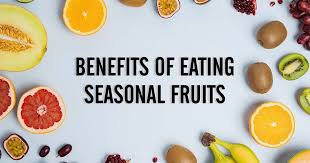
What are the Benefits of Eating Seasonal (Summer, Monsoon, Winter) Fruits?
With every season, there are climatic changes that affect everything around. Eventually, to accommodate these changing seaso
With every season, there are climatic changes that affect everything around. Eventually, to accommodate these changing seaso
What are the Benefits of Eating Seasonal (Summer, Monsoon, Winter) Fruits?
With every season, there are climatic changes that affect everything around. Eventually, to accommodate these changing seasons without getting ill, we all require a different seasonal food set to gain the best nutritional values.To support us in our endeavour to remain healthy with the changing season, seasonal fruits come to our aid, as they are power-packed with all vitamins, minerals, and nutrients. These help our body fulfill its nutritional demands.
Summer Seasonal Fruits and It’s Benefits-
Summers are among the most sensitive seasons. During summers, the body gets dehydrated very quickly, and energy levels drop drastically. Due to the hot climate, energy levels need to be maintained with the correct water level.To ensure that your body gets a sufficient amount of water and nutritional balance, we recommend the following seasonal fruits that are best consumed in summer to stay active and fresh.
1. Watermelon Fruit
2. Muskmelon Fruit
3. Lychee Fruit
4. Mango Fruit
5. Limes Fruit
6. Jackfruit
Late Summer and Pre-monsoon Fruits and It’s Benefits-
This is a time when Summer is about to end but the unpleasant heat, increasing humidity invites illness and discomfort. Our immunity needs an extra dose of antioxidants to stay healthy during this time. Following fruits are loaded with magical shield agents. Including them in your daily diet routine, you can reap the benefits.
1. Black Jamun Fruit
2. Blackberries Fruit
3. Peaches Fruit
4. Plums Fruit
Monsoon Seasonal Fruits and It’s Benefits-
Monsoon brings many infections, body allergies, and gastrointestinal disorders. You are also prone to skin rashes, digestive difficulties, malaria, etc. To avoid catching these health issues, get yourself prepared with seasonal fruits. The seasonal fruits boost your immunity levels and make you fit and active all day long.
1. Pear Fruit
2. White Jamun Fruit
3. Blueberries Fruit
4. Pomegranate Fruit
Winter Seasonal Fruits and It’s Benefits-
Winter brings a lot of fresh fruits that are full of nutritional values. Check out a few seasonal fruits for a pleasant winter.
1. Orange Fruit
2. Sweet Lime
3. Strawberries Fruit
4. Guava Fruit
5. Grapes Fruit
6. Custard Apple Fruit
7. Pineapple Fruit
8. Dragon Fruit
Year-Round Seasonal Fruits In India and It’s Benefits-
Some fruits are available year-round and full of nutritional benefits. Know and include them in your daily fruit diet.
1. Apple Fruit
2. Banana Fruit
3. Papaya Fruit
4. Dates
With every season, there are climatic changes that affect everything around. Eventually, to accommodate these changing seasons without getting ill, we all require a different seasonal food set to gain the best nutritional values.To support us in our endeavour to remain healthy with the changing season, seasonal fruits come to our aid, as they are power-packed with all vitamins, minerals, and nutrients. These help our body fulfill its nutritional demands.
Summer Seasonal Fruits and It’s Benefits-
Summers are among the most sensitive seasons. During summers, the body gets dehydrated very quickly, and energy levels drop drastically. Due to the hot climate, energy levels need to be maintained with the correct water level.To ensure that your body gets a sufficient amount of water and nutritional balance, we recommend the following seasonal fruits that are best consumed in summer to stay active and fresh.
1. Watermelon Fruit
2. Muskmelon Fruit
3. Lychee Fruit
4. Mango Fruit
5. Limes Fruit
6. Jackfruit
Late Summer and Pre-monsoon Fruits and It’s Benefits-
This is a time when Summer is about to end but the unpleasant heat, increasing humidity invites illness and discomfort. Our immunity needs an extra dose of antioxidants to stay healthy during this time. Following fruits are loaded with magical shield agents. Including them in your daily diet routine, you can reap the benefits.
1. Black Jamun Fruit
2. Blackberries Fruit
3. Peaches Fruit
4. Plums Fruit
Monsoon Seasonal Fruits and It’s Benefits-
Monsoon brings many infections, body allergies, and gastrointestinal disorders. You are also prone to skin rashes, digestive difficulties, malaria, etc. To avoid catching these health issues, get yourself prepared with seasonal fruits. The seasonal fruits boost your immunity levels and make you fit and active all day long.
1. Pear Fruit
2. White Jamun Fruit
3. Blueberries Fruit
4. Pomegranate Fruit
Winter Seasonal Fruits and It’s Benefits-
Winter brings a lot of fresh fruits that are full of nutritional values. Check out a few seasonal fruits for a pleasant winter.
1. Orange Fruit
2. Sweet Lime
3. Strawberries Fruit
4. Guava Fruit
5. Grapes Fruit
6. Custard Apple Fruit
7. Pineapple Fruit
8. Dragon Fruit
Year-Round Seasonal Fruits In India and It’s Benefits-
Some fruits are available year-round and full of nutritional benefits. Know and include them in your daily fruit diet.
1. Apple Fruit
2. Banana Fruit
3. Papaya Fruit
4. Dates
Guava
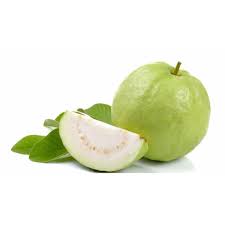
Guava, (Psidium guajava), small tropical tree or shrub of the family Myrtaceae, cultivated for its edible fruits. Guava trees are native to tropical America and are grown in tropical and subtropical a
Guava, (Psidium guajava), small tropical tree or shrub of the family Myrtaceae, cultivated for its edible fruits. Guava trees are native to tropical America and are grown in tropical and subtropical areas worldwide.Guava fruit and leaves contain nutrients, including vitamin C and potassium, that may help support your heart, digestion, and other body systems.Their fruits are oval in shape with light green or yellow skin and contain edible seeds. What’s more, guava leaves are used as an herbal tea and the leaf extract as a supplement.
Health Benefits-
1. May help to lower blood sugar levels
2. May boost heart health
3. May benefit for digestive system
4. May aid weight loss
5. May have an anticancer effect
6. May help to boost the immunity
7. The wide range of vitamins and antioxidants packed into a guava may work wonders for skin. Its antioxidants may protect skin from damage, which can slow
down its aging process, helping prevent wrinkles
Health Benefits-
1. May help to lower blood sugar levels
2. May boost heart health
3. May benefit for digestive system
4. May aid weight loss
5. May have an anticancer effect
6. May help to boost the immunity
7. The wide range of vitamins and antioxidants packed into a guava may work wonders for skin. Its antioxidants may protect skin from damage, which can slow
down its aging process, helping prevent wrinkles
Guillain-Barre syndrome
.jpg)
Guillain-Barre syndrome is a condition in which the body's immune system attacks the nerves. It can cause weakness, numbness or paralysis.
Weakness and tingling in the hands and feet are usually the
Weakness and tingling in the hands and feet are usually the
Guillain-Barre syndrome is a condition in which the body's immune system attacks the nerves. It can cause weakness, numbness or paralysis.
Weakness and tingling in the hands and feet are usually the first symptoms. These sensations can quickly spread and may lead to paralysis. In its most serious form, Guillain-Barre syndrome is a medical emergency. Most people with the condition need treatment in a hospital.There's no known cure for Guillain-Barre syndrome. Several treatment options can ease symptoms and help speed recovery. Most people recover completely from Guillain-Barre syndrome, but some serious illnesses can be fatal. While recovery may take up to several years, most people are able to walk again six months after symptoms first began. Some people may have lasting effects, such as weakness, numbness or fatigue.
Symptoms of Guillain-Barre syndrome may include:
A pins and needles feeling in the fingers, toes, ankles or wrists.
Weakness in the legs that spreads to the upper body.
Unsteady walk or not being able to walk or climb stairs.
Trouble with facial movements, including speaking, chewing or swallowing.
Double vision or inability to move the eyes.
Severe pain that may feel achy, shooting or cramplike and may be worse at night.
Trouble with bladder control or bowel function.
Rapid heart rate.
Low or high blood pressure.
Trouble breathing.
Types-
The symptoms of Guillain-Barre syndrome can vary based on the type. Guillain-Barre syndrome has several forms. The main types are:
1. Acute inflammatory demyelinating polyradiculoneuropathy (AIDP)
2. Miller Fisher syndrome (MFS), in which paralysis starts in the eyes.
3. Acute motor axonal neuropathy (AMAN) and acute motor-sensory axonal neuropathy (AMSAN)
Dietary management-
Foods to Include in the Diet for Guillain-Barré Syndrome-
1. High-protein foods: Include sources like chicken, fish, eggs, and legumes to support muscle recovery and immune function.
2. Fruits and vegetables: Rich in vitamins and antioxidants, citrus fruits, berries, spinach, and broccoli can help reduce inflammation.
3. Healthy fats: Avocados, nuts, and olive oil are sources of essential fatty acids, which protect nerve cells.
4. Whole grains: Oats, brown rice, and whole wheat are full of energy and fiber that initiate good digestion and health
5. Probiotics: Dahi (curd) and buttermilk improve the health of the gut, which is an important development for a healthy response.
Foods to Avoid with Diet in Guillain-Barré Syndrome
Some of the foods that need to be avoided because they trigger inflammation:
1. Processed foods: In these food products, unhealthy fats and chemical preservatives are in a big number that would spike up inflammation and damage the
recovery process.
2. Sugar-rich foods: that contain high amounts of sweets, soft drinks, and excessive sugar can weaken the immune system and inflammation.
3. Fatty foods: oily food that is heavy and greasy can provoke inflammation and digestive disturbance
4. Too much milk: High-fat dairy products can also cause inflammation in some patients.
5. High-sodium food: Processed snacks and canned food may provoke water retention and other health problems.
Weakness and tingling in the hands and feet are usually the first symptoms. These sensations can quickly spread and may lead to paralysis. In its most serious form, Guillain-Barre syndrome is a medical emergency. Most people with the condition need treatment in a hospital.There's no known cure for Guillain-Barre syndrome. Several treatment options can ease symptoms and help speed recovery. Most people recover completely from Guillain-Barre syndrome, but some serious illnesses can be fatal. While recovery may take up to several years, most people are able to walk again six months after symptoms first began. Some people may have lasting effects, such as weakness, numbness or fatigue.
Symptoms of Guillain-Barre syndrome may include:
A pins and needles feeling in the fingers, toes, ankles or wrists.
Weakness in the legs that spreads to the upper body.
Unsteady walk or not being able to walk or climb stairs.
Trouble with facial movements, including speaking, chewing or swallowing.
Double vision or inability to move the eyes.
Severe pain that may feel achy, shooting or cramplike and may be worse at night.
Trouble with bladder control or bowel function.
Rapid heart rate.
Low or high blood pressure.
Trouble breathing.
Types-
The symptoms of Guillain-Barre syndrome can vary based on the type. Guillain-Barre syndrome has several forms. The main types are:
1. Acute inflammatory demyelinating polyradiculoneuropathy (AIDP)
2. Miller Fisher syndrome (MFS), in which paralysis starts in the eyes.
3. Acute motor axonal neuropathy (AMAN) and acute motor-sensory axonal neuropathy (AMSAN)
Dietary management-
Foods to Include in the Diet for Guillain-Barré Syndrome-
1. High-protein foods: Include sources like chicken, fish, eggs, and legumes to support muscle recovery and immune function.
2. Fruits and vegetables: Rich in vitamins and antioxidants, citrus fruits, berries, spinach, and broccoli can help reduce inflammation.
3. Healthy fats: Avocados, nuts, and olive oil are sources of essential fatty acids, which protect nerve cells.
4. Whole grains: Oats, brown rice, and whole wheat are full of energy and fiber that initiate good digestion and health
5. Probiotics: Dahi (curd) and buttermilk improve the health of the gut, which is an important development for a healthy response.
Foods to Avoid with Diet in Guillain-Barré Syndrome
Some of the foods that need to be avoided because they trigger inflammation:
1. Processed foods: In these food products, unhealthy fats and chemical preservatives are in a big number that would spike up inflammation and damage the
recovery process.
2. Sugar-rich foods: that contain high amounts of sweets, soft drinks, and excessive sugar can weaken the immune system and inflammation.
3. Fatty foods: oily food that is heavy and greasy can provoke inflammation and digestive disturbance
4. Too much milk: High-fat dairy products can also cause inflammation in some patients.
5. High-sodium food: Processed snacks and canned food may provoke water retention and other health problems.
Deficiency Diseases
.jpg)
What are Deficiency Diseases?
A balanced diet is extremely important for the good health of a person. Any imbalance in the diet might lead to excess or insufficient intake of certain nutrients. Insuf
A balanced diet is extremely important for the good health of a person. Any imbalance in the diet might lead to excess or insufficient intake of certain nutrients. Insuf
What are Deficiency Diseases?
A balanced diet is extremely important for the good health of a person. Any imbalance in the diet might lead to excess or insufficient intake of certain nutrients. Insufficient intake of a particular nutrient can lead to a deficiency disease.
Vitamin Deficiency Diseases-
Vitamin is a micronutrient that is not prepared by the body in sufficient amounts. This is the reason why it is necessary to take in from outside sources for the normal functioning of the body. Inadequate intake of vitamins results in vitamin deficiency diseases.
Following is the list of some of the vitamins and the deficiency diseases caused by them:
1. Vitamin A- It is an important micronutrient that is obtained from different food sources such as carrots, spinach, milk, egg, liver and fish. It is required for normal vision, reproduction, growth and healthy immune system of an individual.Most children below five years of age suffer from xerophthalmia, a serious eye disorder, in which the child is at risk of becoming blind. Vitamin A deficiency in a pregnant woman can lead to complications during pregnancy and childbirth.
2. Vitamin B-Vitamin B can be of different types, such as Vitamin B1, B2, B12 etc. The deficiency diseases depend on the type of Vitamin B that a person is lacking.
Vitamin B1: Deficiency of vitamin B1 causes beriberi, which results in weak muscles and severe weight loss. Acute deficiency can lead to paralysis and cardiac failure.
Vitamin B6: Lack of vitamin B6 causes deficiency diseases such as anaemia and certain skin disorders such as cracks around the mouth. It can also lead to depression and nervous breakdowns.
Vitamin B12: Lack of vitamin B12 causes pernicious anaemia. Other diseases related to B12 deficiency are muscle and nerve paralysis, extreme fatigue, dementia and depression.
3. Vitamin C-Deficiency of vitamin C can cause scurvy, a disease that is characterised by bleeding gums, skin spots and swelling in joints. It also affects the immune system and can even be fatal in acute conditions.
4. Vitamin D-Vitamin D deficiency causes rickets, which leads to the weakening of bones, especially near the joints. It can also lead to the decay of teeth.
5. Vitamin K-Vitamin K is important for blood coagulation. Its deficiency is common in infants and leads to excessive bleeding due to the inability to form blood clots.
Mineral Deficiency Diseases-
Minerals are inorganic nutrients that include trace elements such as copper, zinc, iodine, and iron, along with the micronutrients such as calcium, potassium, magnesium and sodium.
1. Iodine-Iodine is the most important element required for the brain development of the developing foetus. It is responsible for a number of other functions such as the production of hormones. Salt is an important source of iodine in many countries. The deficiency of iodine leads to goitre.
2. Iron-Iron, in the form of haemoglobin, carries oxygen from the lungs to different tissues of the body. Iron deficiency causes anaemia, a condition in which the blood is unable to carry the required oxygen to the tissues, which also results in death. Around 40-60% of infants in developing countries suffer from mental impairment due to iron deficiency. Red meat, spinach, poultry, etc. are some of the iron-rich foods.
A balanced diet is extremely important for the good health of a person. Any imbalance in the diet might lead to excess or insufficient intake of certain nutrients. Insufficient intake of a particular nutrient can lead to a deficiency disease.
Vitamin Deficiency Diseases-
Vitamin is a micronutrient that is not prepared by the body in sufficient amounts. This is the reason why it is necessary to take in from outside sources for the normal functioning of the body. Inadequate intake of vitamins results in vitamin deficiency diseases.
Following is the list of some of the vitamins and the deficiency diseases caused by them:
1. Vitamin A- It is an important micronutrient that is obtained from different food sources such as carrots, spinach, milk, egg, liver and fish. It is required for normal vision, reproduction, growth and healthy immune system of an individual.Most children below five years of age suffer from xerophthalmia, a serious eye disorder, in which the child is at risk of becoming blind. Vitamin A deficiency in a pregnant woman can lead to complications during pregnancy and childbirth.
2. Vitamin B-Vitamin B can be of different types, such as Vitamin B1, B2, B12 etc. The deficiency diseases depend on the type of Vitamin B that a person is lacking.
Vitamin B1: Deficiency of vitamin B1 causes beriberi, which results in weak muscles and severe weight loss. Acute deficiency can lead to paralysis and cardiac failure.
Vitamin B6: Lack of vitamin B6 causes deficiency diseases such as anaemia and certain skin disorders such as cracks around the mouth. It can also lead to depression and nervous breakdowns.
Vitamin B12: Lack of vitamin B12 causes pernicious anaemia. Other diseases related to B12 deficiency are muscle and nerve paralysis, extreme fatigue, dementia and depression.
3. Vitamin C-Deficiency of vitamin C can cause scurvy, a disease that is characterised by bleeding gums, skin spots and swelling in joints. It also affects the immune system and can even be fatal in acute conditions.
4. Vitamin D-Vitamin D deficiency causes rickets, which leads to the weakening of bones, especially near the joints. It can also lead to the decay of teeth.
5. Vitamin K-Vitamin K is important for blood coagulation. Its deficiency is common in infants and leads to excessive bleeding due to the inability to form blood clots.
Mineral Deficiency Diseases-
Minerals are inorganic nutrients that include trace elements such as copper, zinc, iodine, and iron, along with the micronutrients such as calcium, potassium, magnesium and sodium.
1. Iodine-Iodine is the most important element required for the brain development of the developing foetus. It is responsible for a number of other functions such as the production of hormones. Salt is an important source of iodine in many countries. The deficiency of iodine leads to goitre.
2. Iron-Iron, in the form of haemoglobin, carries oxygen from the lungs to different tissues of the body. Iron deficiency causes anaemia, a condition in which the blood is unable to carry the required oxygen to the tissues, which also results in death. Around 40-60% of infants in developing countries suffer from mental impairment due to iron deficiency. Red meat, spinach, poultry, etc. are some of the iron-rich foods.
Goiter
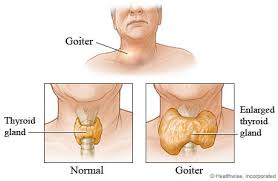
A goiter is the irregular growth of the thyroid gland. The thyroid is a butterfly-shaped gland located at the base of the neck just below the Adam's apple.A goiter may be an overall enlargement of th
A goiter is the irregular growth of the thyroid gland. The thyroid is a butterfly-shaped gland located at the base of the neck just below the Adam's apple.A goiter may be an overall enlargement of the thyroid, or it may be the result of irregular cell growth that forms one or more lumps (nodules) in the thyroid. A goiter may be associated with no change in thyroid function or with an increase or decrease in thyroid hormones.The most common cause of goiters worldwide is a lack of iodine in the diet.
Symptoms-
Underactive thyroid (hypothyroidism)
Signs and symptoms of hypothyroidism include:
Fatigue
Increased sensitivity to cold
Increased sleepiness
Dry skin
Constipation
Muscle weakness
Problems with memory or concentration
Overactive thyroid (hyperthyroidism)
Signs and symptoms of hyperthyroidism include:
Weight loss
Rapid heartbeat (tachycardia)
Increased sensitivity to heat
Excess sweating
Tremors
Irritability and nervousness
Muscle weakness
Frequent bowel movements
Changes in menstrual patterns
Sleep difficulty
High blood pressure
Increased appetite
Obstructive goiter
The size or position of a goiter may obstruct the airway and voice box. Signs and symptoms may include:
Difficulty swallowing
Difficulty breathing with exertion
Cough
Hoarseness
Snoring
Causes-
Two hormones produced by the thyroid are thyroxine (T-4) and triiodothyronine (T-3). When the thyroid releases thyroxine (T-4) and triiodothyronine (T-3) into the bloodstream, they play a role in many functions in the body, including the regulation of:
The conversion of food into energy (metabolism)
Body temperature
Heart rate
Blood pressure
Other hormone interactions
Growth during childhood
Dietary management-
1. Dairy: Milk, cheese, and yogurt
2. Iodized salt: A teaspoon contains about 250 micrograms of iodine
3. Prunes: A good source of iodine
4. Lima beans: A good source of iodine
5. Sesame seeds: A good source of iodine
6. Eat a variety of fruits and vegetables
7. Eat foods high in fiber, like potatoes, bread, rice, or pasta
8. Choose unsaturated oils and spreads
9. Drink plenty of fluid
Food to be avoided-
Avoid processed foods and reduce sugar intake
Raw cruciferous vegetables, like broccoli and cabbage
Spinach
Soybeans, tofu, tempeh, and soy milk
Symptoms-
Underactive thyroid (hypothyroidism)
Signs and symptoms of hypothyroidism include:
Fatigue
Increased sensitivity to cold
Increased sleepiness
Dry skin
Constipation
Muscle weakness
Problems with memory or concentration
Overactive thyroid (hyperthyroidism)
Signs and symptoms of hyperthyroidism include:
Weight loss
Rapid heartbeat (tachycardia)
Increased sensitivity to heat
Excess sweating
Tremors
Irritability and nervousness
Muscle weakness
Frequent bowel movements
Changes in menstrual patterns
Sleep difficulty
High blood pressure
Increased appetite
Obstructive goiter
The size or position of a goiter may obstruct the airway and voice box. Signs and symptoms may include:
Difficulty swallowing
Difficulty breathing with exertion
Cough
Hoarseness
Snoring
Causes-
Two hormones produced by the thyroid are thyroxine (T-4) and triiodothyronine (T-3). When the thyroid releases thyroxine (T-4) and triiodothyronine (T-3) into the bloodstream, they play a role in many functions in the body, including the regulation of:
The conversion of food into energy (metabolism)
Body temperature
Heart rate
Blood pressure
Other hormone interactions
Growth during childhood
Dietary management-
1. Dairy: Milk, cheese, and yogurt
2. Iodized salt: A teaspoon contains about 250 micrograms of iodine
3. Prunes: A good source of iodine
4. Lima beans: A good source of iodine
5. Sesame seeds: A good source of iodine
6. Eat a variety of fruits and vegetables
7. Eat foods high in fiber, like potatoes, bread, rice, or pasta
8. Choose unsaturated oils and spreads
9. Drink plenty of fluid
Food to be avoided-
Avoid processed foods and reduce sugar intake
Raw cruciferous vegetables, like broccoli and cabbage
Spinach
Soybeans, tofu, tempeh, and soy milk
Autoimmune diseases
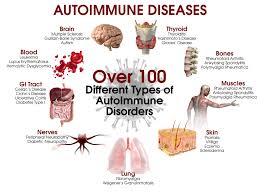
What are autoimmune diseases?
Autoimmune diseases are health conditions that happen when immune system attacks your body instead of defending it. Immune system is like body’s built-in security syst
Autoimmune diseases are health conditions that happen when immune system attacks your body instead of defending it. Immune system is like body’s built-in security syst
What are autoimmune diseases?
Autoimmune diseases are health conditions that happen when immune system attacks your body instead of defending it. Immune system is like body’s built-in security system. It automatically detects substances that shouldn’t be in body (like viruses, bacteria or toxins) and sends out white blood cells to eliminate them before they can damage body or make sick.
Types of autoimmune diseases-
1. Joints and muscles-
2. Rheumatoid arthritis (RA).
3. Lupus.
4. Myositis.
Skin and blood vessels
1. Sjogren’s syndrome.
2. Psoriasis.
3. Psoriatic arthritis.
4. Dermatomyositis.
5. Scleroderma.
6. Vasculitis.
7. Rheumatoid vasculitis.
8. Urticarial vasculitis.
9. Vitiligo.
Digestive system
1. Crohn’s disease.
2. Celiac disease.
3. Ulcerative colitis.
4. Autoimmune gastritis.
Endocrine system
1. Type 1 diabetes.
2. Addison’s disease.
3. Hashimoto’s thyroiditis.
4. Graves’ disease.
Nervous system
1. Multiple sclerosis (MS).
2. Myasthenia gravis (MG).
3. Guillain-Barré syndrome.
4. Chronic inflammatory demyelinating polyneuropathy (CIPD).
Symptoms -
Autoimmune diseases can cause a wide range of symptoms. They can affect your body almost literally from head to toe.
For example, conditions that affect your muscles can cause muscle weakness. You might also have joint pain, swelling or feel stiffness if you have a condition like rheumatoid arthritis. Type 1 diabetes causes high blood sugar (hyperglycemia). Some autoimmune conditions affect your vision.
Many autoimmune diseases cause inflammation, which can include:
A feeling of warmth or heat.
Discoloration or redness on your skin.
Swelling.
Pain.
Dietary Guidelines-
1. Vegetables: Broccoli, cauliflower, carrots, celery, spinach, kale, zucchini, bell peppers
2. Fruits: Berries, apples, bananas, oranges, avocado
3. Healthy fats: Olive oil, avocado, nuts, seeds, fatty fish (salmon, sardines)
4. Whole grains: Brown rice, quinoa, oats
5. Legumes: Lentils, chickpeas, beans
6. Bone broth: Can be a source of nutrients and gut-healing properties
7. Fermented foods: Yogurt, kefir, sauerkraut, kimchi
8. Focus on anti-inflammatory foods: Prioritize fruits, vegetables (especially leafy greens), berries, olive oil, nuts, seeds, and legumes
9. Hydrate well: Drink plenty of water throughout the day.
Autoimmune diseases are health conditions that happen when immune system attacks your body instead of defending it. Immune system is like body’s built-in security system. It automatically detects substances that shouldn’t be in body (like viruses, bacteria or toxins) and sends out white blood cells to eliminate them before they can damage body or make sick.
Types of autoimmune diseases-
1. Joints and muscles-
2. Rheumatoid arthritis (RA).
3. Lupus.
4. Myositis.
Skin and blood vessels
1. Sjogren’s syndrome.
2. Psoriasis.
3. Psoriatic arthritis.
4. Dermatomyositis.
5. Scleroderma.
6. Vasculitis.
7. Rheumatoid vasculitis.
8. Urticarial vasculitis.
9. Vitiligo.
Digestive system
1. Crohn’s disease.
2. Celiac disease.
3. Ulcerative colitis.
4. Autoimmune gastritis.
Endocrine system
1. Type 1 diabetes.
2. Addison’s disease.
3. Hashimoto’s thyroiditis.
4. Graves’ disease.
Nervous system
1. Multiple sclerosis (MS).
2. Myasthenia gravis (MG).
3. Guillain-Barré syndrome.
4. Chronic inflammatory demyelinating polyneuropathy (CIPD).
Symptoms -
Autoimmune diseases can cause a wide range of symptoms. They can affect your body almost literally from head to toe.
For example, conditions that affect your muscles can cause muscle weakness. You might also have joint pain, swelling or feel stiffness if you have a condition like rheumatoid arthritis. Type 1 diabetes causes high blood sugar (hyperglycemia). Some autoimmune conditions affect your vision.
Many autoimmune diseases cause inflammation, which can include:
A feeling of warmth or heat.
Discoloration or redness on your skin.
Swelling.
Pain.
Dietary Guidelines-
1. Vegetables: Broccoli, cauliflower, carrots, celery, spinach, kale, zucchini, bell peppers
2. Fruits: Berries, apples, bananas, oranges, avocado
3. Healthy fats: Olive oil, avocado, nuts, seeds, fatty fish (salmon, sardines)
4. Whole grains: Brown rice, quinoa, oats
5. Legumes: Lentils, chickpeas, beans
6. Bone broth: Can be a source of nutrients and gut-healing properties
7. Fermented foods: Yogurt, kefir, sauerkraut, kimchi
8. Focus on anti-inflammatory foods: Prioritize fruits, vegetables (especially leafy greens), berries, olive oil, nuts, seeds, and legumes
9. Hydrate well: Drink plenty of water throughout the day.
Insulin resistance
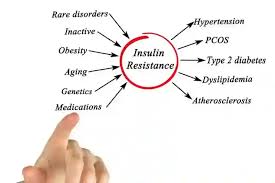
What is insulin resistance?
Insulin resistance happens when cells in muscles, fat and liver don’t respond to insulin as they should. This is also known as impaired insulin sensitivity. Insulin is e
Insulin resistance happens when cells in muscles, fat and liver don’t respond to insulin as they should. This is also known as impaired insulin sensitivity. Insulin is e
What is insulin resistance?
Insulin resistance happens when cells in muscles, fat and liver don’t respond to insulin as they should. This is also known as impaired insulin sensitivity. Insulin is essential for life and regulating blood glucose (sugar) levels. Insulin helps move glucose from blood into cells so body can use it for energy. For several reasons, cells can respond inappropriately to insulin. This means they can’t efficiently use the glucose for energy or for storage. As a result, glucose continues to build up in blood. Pancreas makes more insulin to try to overcome increasing blood glucose levels. This is called hyperinsulinemia. As long as pancreas can make enough insulin to balance out blood sugar levels, they’ll stay in a healthy range. If cells become too resistant to insulin, it leads to elevated blood glucose levels (hyperglycemia). Over time, hyperglycemia can lead to prediabetes and Type 2 diabetes.
The condition is also associated with:
Obesity
Cardiovascular disease
Metabolic dysfunction-associated steatotic liver disease
Metabolic syndrome
Polycystic ovary syndrome (PCOS)
Symptoms-
Unexplained weight loss
Fatigue
Increased thirst
Frequent urination (peeing)
Increased hunger
Blurred vision
Yeast infections
Causes-
1. Excess body fat: Scientists believe obesity is a primary cause of insulin resistance. Excess fat in your belly and around your organs (visceral fat) especially raises
your risk.
2. Physical inactivity: Movement and exercise make your body more sensitive to insulin. Exercise also builds muscle that can absorb blood glucose. A lack of
physical activity can lead to the condition.
3. Food choices: A diet of highly processed foods, high in carbohydrates and saturated fats, has been linked to the condition
4. Certain medications: Steroids, blood pressure medications, HIV treatments and other medications can cause insulin resistance.
Hormonal disorders that can cause insulin resistance-
Issues with certain hormones can affect how well your body uses insulin. Hormonal disorders that can cause insulin resistance include:
1. Cushing’s syndrome: This rare condition happens when there’s extra cortisol in your body. Excess cortisol can counteract the effects of insulin, causing the
condition.
2. Acromegaly: This is a very rare but serious condition that happens when you have high levels of growth hormone (GH). High levels of GH can lead to insulin
resistance.
3. Hypothyroidism: This means your thyroid is underactive and doesn’t produce enough thyroid hormone. It causes your metabolism to slow down, which can
lead to insulin resistance.
Genetic conditions that cause insulin resistance
Certain inherited genetic disorders — conditions you’re born with – can cause the condition for various reasons. These are rare but include Type A insulin resistance syndrome and Donohue syndrome.
How is it diagnosed?
Physical exam and a variety of blood tests that measure the levels of glucose, or sugar, in your blood and/or your tolerance to that glucose. Or more recently, a blood test called hemoglobin glycosylated A1C, often simply referred to as A1C.
Insulin resistance happens when cells in muscles, fat and liver don’t respond to insulin as they should. This is also known as impaired insulin sensitivity. Insulin is essential for life and regulating blood glucose (sugar) levels. Insulin helps move glucose from blood into cells so body can use it for energy. For several reasons, cells can respond inappropriately to insulin. This means they can’t efficiently use the glucose for energy or for storage. As a result, glucose continues to build up in blood. Pancreas makes more insulin to try to overcome increasing blood glucose levels. This is called hyperinsulinemia. As long as pancreas can make enough insulin to balance out blood sugar levels, they’ll stay in a healthy range. If cells become too resistant to insulin, it leads to elevated blood glucose levels (hyperglycemia). Over time, hyperglycemia can lead to prediabetes and Type 2 diabetes.
The condition is also associated with:
Obesity
Cardiovascular disease
Metabolic dysfunction-associated steatotic liver disease
Metabolic syndrome
Polycystic ovary syndrome (PCOS)
Symptoms-
Unexplained weight loss
Fatigue
Increased thirst
Frequent urination (peeing)
Increased hunger
Blurred vision
Yeast infections
Causes-
1. Excess body fat: Scientists believe obesity is a primary cause of insulin resistance. Excess fat in your belly and around your organs (visceral fat) especially raises
your risk.
2. Physical inactivity: Movement and exercise make your body more sensitive to insulin. Exercise also builds muscle that can absorb blood glucose. A lack of
physical activity can lead to the condition.
3. Food choices: A diet of highly processed foods, high in carbohydrates and saturated fats, has been linked to the condition
4. Certain medications: Steroids, blood pressure medications, HIV treatments and other medications can cause insulin resistance.
Hormonal disorders that can cause insulin resistance-
Issues with certain hormones can affect how well your body uses insulin. Hormonal disorders that can cause insulin resistance include:
1. Cushing’s syndrome: This rare condition happens when there’s extra cortisol in your body. Excess cortisol can counteract the effects of insulin, causing the
condition.
2. Acromegaly: This is a very rare but serious condition that happens when you have high levels of growth hormone (GH). High levels of GH can lead to insulin
resistance.
3. Hypothyroidism: This means your thyroid is underactive and doesn’t produce enough thyroid hormone. It causes your metabolism to slow down, which can
lead to insulin resistance.
Genetic conditions that cause insulin resistance
Certain inherited genetic disorders — conditions you’re born with – can cause the condition for various reasons. These are rare but include Type A insulin resistance syndrome and Donohue syndrome.
How is it diagnosed?
Physical exam and a variety of blood tests that measure the levels of glucose, or sugar, in your blood and/or your tolerance to that glucose. Or more recently, a blood test called hemoglobin glycosylated A1C, often simply referred to as A1C.
Natural foods that boost insulin sensitivity
.jpg)
Here are some natural foods that can help enhance insulin sensitivity:
Fruits-
1. Berries: Blueberries, raspberries, and strawberries are rich in anthocyanins, which improve insulin sensitivity.
Fruits-
1. Berries: Blueberries, raspberries, and strawberries are rich in anthocyanins, which improve insulin sensitivity.
Here are some natural foods that can help enhance insulin sensitivity:
Fruits-
1. Berries: Blueberries, raspberries, and strawberries are rich in anthocyanins, which improve insulin sensitivity.
2. Apples: Quercetin, a flavonoid in apples, enhances insulin sensitivity.
3. Citrus fruits: Oranges, grapefruits, and lemons contain naringenin, which improves insulin sensitivity.
Vegetables-
1. Leafy greens: Spinach, kale, and collard greens are rich in magnesium, which enhances insulin sensitivity.
2. Broccoli: Sulforaphane, a compound in broccoli, improves insulin sensitivity.
3. Carrots: Carotenoids, such as beta-carotene, enhance insulin sensitivity.
Legumes-
1. Lentils: Rich in fiber, protein, and minerals, lentils improve insulin sensitivity.
2. Chickpeas: Fiber, protein, and minerals in chickpeas enhance insulin sensitivity.
3. Black beans: Fiber, protein, and minerals in black beans improve insulin sensitivity.
Nuts and seeds-
1. Almonds: Magnesium and healthy fats in almonds enhance insulin sensitivity.
2. Chia seeds: Fiber, protein, and omega-3 fatty acids in chia seeds improve insulin sensitivity.
3. Flaxseeds: Fiber, protein, and omega-3 fatty acids in flaxseeds enhance insulin sensitivity.
Whole grains-
1. Brown rice: Fiber, magnesium, and selenium in brown rice improve insulin sensitivity.
2. Quinoa: Fiber, protein, and minerals in quinoa enhance insulin sensitivity.
3. Whole wheat: Fiber, magnesium, and selenium in whole wheat improve insulin sensitivity.
Spices and herbs-
1. Cinnamon: Cinnamaldehyde, a compound in cinnamon, improves insulin sensitivity.
2. Turmeric: Curcumin, a compound in turmeric, enhances insulin sensitivity.
3. Ginger: Gingerol, a compound in ginger, improves insulin sensitivity.
Beverages-
1. Green tea: Catechins, such as EGCG, in green tea improve insulin sensitivity.
2. Coffee: Chlorogenic acid, a compound in coffee, enhances insulin sensitivity.
Incorporating these foods into your diet can help improve insulin sensitivity, reduce the risk of developing insulin resistance and type 2 diabetes, and promote overall health and well-being.
Fruits-
1. Berries: Blueberries, raspberries, and strawberries are rich in anthocyanins, which improve insulin sensitivity.
2. Apples: Quercetin, a flavonoid in apples, enhances insulin sensitivity.
3. Citrus fruits: Oranges, grapefruits, and lemons contain naringenin, which improves insulin sensitivity.
Vegetables-
1. Leafy greens: Spinach, kale, and collard greens are rich in magnesium, which enhances insulin sensitivity.
2. Broccoli: Sulforaphane, a compound in broccoli, improves insulin sensitivity.
3. Carrots: Carotenoids, such as beta-carotene, enhance insulin sensitivity.
Legumes-
1. Lentils: Rich in fiber, protein, and minerals, lentils improve insulin sensitivity.
2. Chickpeas: Fiber, protein, and minerals in chickpeas enhance insulin sensitivity.
3. Black beans: Fiber, protein, and minerals in black beans improve insulin sensitivity.
Nuts and seeds-
1. Almonds: Magnesium and healthy fats in almonds enhance insulin sensitivity.
2. Chia seeds: Fiber, protein, and omega-3 fatty acids in chia seeds improve insulin sensitivity.
3. Flaxseeds: Fiber, protein, and omega-3 fatty acids in flaxseeds enhance insulin sensitivity.
Whole grains-
1. Brown rice: Fiber, magnesium, and selenium in brown rice improve insulin sensitivity.
2. Quinoa: Fiber, protein, and minerals in quinoa enhance insulin sensitivity.
3. Whole wheat: Fiber, magnesium, and selenium in whole wheat improve insulin sensitivity.
Spices and herbs-
1. Cinnamon: Cinnamaldehyde, a compound in cinnamon, improves insulin sensitivity.
2. Turmeric: Curcumin, a compound in turmeric, enhances insulin sensitivity.
3. Ginger: Gingerol, a compound in ginger, improves insulin sensitivity.
Beverages-
1. Green tea: Catechins, such as EGCG, in green tea improve insulin sensitivity.
2. Coffee: Chlorogenic acid, a compound in coffee, enhances insulin sensitivity.
Incorporating these foods into your diet can help improve insulin sensitivity, reduce the risk of developing insulin resistance and type 2 diabetes, and promote overall health and well-being.
Deficiency of Vitamin E
.jpg)
Vitamin E is a fat-soluble vitamin that plays a crucial role in maintaining overall health.
Causes of Vitamin E Deficiency-
1. Poor diet: A diet lacking in vitamin E-rich foods, such as nuts, seeds
Causes of Vitamin E Deficiency-
1. Poor diet: A diet lacking in vitamin E-rich foods, such as nuts, seeds
Vitamin E is a fat-soluble vitamin that plays a crucial role in maintaining overall health.
Causes of Vitamin E Deficiency-
1. Poor diet: A diet lacking in vitamin E-rich foods, such as nuts, seeds, and vegetable oils.
2. Malabsorption: Certain conditions, like celiac disease, Crohn's disease, or liver disease, can impair vitamin E absorption.
3. Genetic disorders: Rare genetic disorders, such as abetalipoproteinemia, can affect vitamin E absorption.
Symptoms of Vitamin E Deficiency-
1. Fatigue: Feeling tired or weak.
2. Muscle weakness: Muscle wasting or weakness.
3. Vision problems: Blurred vision, double vision, or loss of vision.
4. Immune system impairment: Increased risk of infections.
5. Skin problems: Dry, rough skin or skin lesions.
6. Hair loss: Unexplained hair loss.
7. Neurological problems: Numbness, tingling, or loss of sensation in hands and feet.
Health Risks Associated with Vitamin E Deficiency
1. Increased risk of infections: Weakened immune system.
2. Anemia: Impaired red blood cell production.
3. Neurodegenerative diseases: Increased risk of conditions like Alzheimer's disease.
4. Cancer: Some studies suggest a link between vitamin E deficiency and increased cancer risk.
Foods Rich in Vitamin E
1. Nuts: Almonds, hazelnuts, and pecans.
2. Seeds: Sunflower seeds, pumpkin seeds, and sesame seeds.
3. Vegetable oils: Wheat germ oil, sunflower oil, and safflower oil.
4. Leafy greens: Spinach, kale, and broccoli.
Causes of Vitamin E Deficiency-
1. Poor diet: A diet lacking in vitamin E-rich foods, such as nuts, seeds, and vegetable oils.
2. Malabsorption: Certain conditions, like celiac disease, Crohn's disease, or liver disease, can impair vitamin E absorption.
3. Genetic disorders: Rare genetic disorders, such as abetalipoproteinemia, can affect vitamin E absorption.
Symptoms of Vitamin E Deficiency-
1. Fatigue: Feeling tired or weak.
2. Muscle weakness: Muscle wasting or weakness.
3. Vision problems: Blurred vision, double vision, or loss of vision.
4. Immune system impairment: Increased risk of infections.
5. Skin problems: Dry, rough skin or skin lesions.
6. Hair loss: Unexplained hair loss.
7. Neurological problems: Numbness, tingling, or loss of sensation in hands and feet.
Health Risks Associated with Vitamin E Deficiency
1. Increased risk of infections: Weakened immune system.
2. Anemia: Impaired red blood cell production.
3. Neurodegenerative diseases: Increased risk of conditions like Alzheimer's disease.
4. Cancer: Some studies suggest a link between vitamin E deficiency and increased cancer risk.
Foods Rich in Vitamin E
1. Nuts: Almonds, hazelnuts, and pecans.
2. Seeds: Sunflower seeds, pumpkin seeds, and sesame seeds.
3. Vegetable oils: Wheat germ oil, sunflower oil, and safflower oil.
4. Leafy greens: Spinach, kale, and broccoli.
Deficiency of Vitamin A
.jpg)
Vitamin A is an essential nutrient that plays a critical role in maintaining healthy vision, immune function, and skin health. A deficiency in vitamin A can cause a range of health problems. Here are
Vitamin A is an essential nutrient that plays a critical role in maintaining healthy vision, immune function, and skin health. A deficiency in vitamin A can cause a range of health problems. Here are some of the effects of vitamin A deficiency:
Causes of Vitamin A Deficiency
1. Poor diet: A diet lacking in vitamin A-rich foods, such as sweet potatoes, carrots, and dark leafy greens.
2. Malabsorption: Certain conditions, like celiac disease, Crohn's disease, or liver disease, can impair vitamin A absorption.
3. Increased demand: Pregnant or breastfeeding women, as well as individuals with certain medical conditions, may require more vitamin A.
Symptoms of Vitamin A Deficiency
1. Night blindness: Difficulty seeing in low light environments.
2. Dry eyes: Dryness, itching, or burning sensations in the eyes.
3. Impaired immune function: Increased susceptibility to infections.
4. Skin problems: Dry, rough, or acne-prone skin.
5. Hair loss: Unexplained hair loss or brittle hair.
6. Fatigue: Feeling tired or weak.
7. Weight loss: Unintentional weight loss.
Health Risks Associated with Vitamin A Deficiency
1. Blindness: Severe vitamin A deficiency can lead to complete blindness.
2. Increased mortality: Vitamin A deficiency can increase the risk of death, particularly in children and pregnant women.
3. Impaired growth and development: Vitamin A deficiency can affect growth and development in children.
Foods Rich in Vitamin A
1. Sweet potatoes: Rich in beta-carotene, a precursor to vitamin A.
2. Carrots: High in beta-carotene.
3. Dark leafy greens: Spinach, kale, and collard greens are rich in vitamin A.
4. Dairy products: Milk, cheese, and yogurt contain vitamin A.
Causes of Vitamin A Deficiency
1. Poor diet: A diet lacking in vitamin A-rich foods, such as sweet potatoes, carrots, and dark leafy greens.
2. Malabsorption: Certain conditions, like celiac disease, Crohn's disease, or liver disease, can impair vitamin A absorption.
3. Increased demand: Pregnant or breastfeeding women, as well as individuals with certain medical conditions, may require more vitamin A.
Symptoms of Vitamin A Deficiency
1. Night blindness: Difficulty seeing in low light environments.
2. Dry eyes: Dryness, itching, or burning sensations in the eyes.
3. Impaired immune function: Increased susceptibility to infections.
4. Skin problems: Dry, rough, or acne-prone skin.
5. Hair loss: Unexplained hair loss or brittle hair.
6. Fatigue: Feeling tired or weak.
7. Weight loss: Unintentional weight loss.
Health Risks Associated with Vitamin A Deficiency
1. Blindness: Severe vitamin A deficiency can lead to complete blindness.
2. Increased mortality: Vitamin A deficiency can increase the risk of death, particularly in children and pregnant women.
3. Impaired growth and development: Vitamin A deficiency can affect growth and development in children.
Foods Rich in Vitamin A
1. Sweet potatoes: Rich in beta-carotene, a precursor to vitamin A.
2. Carrots: High in beta-carotene.
3. Dark leafy greens: Spinach, kale, and collard greens are rich in vitamin A.
4. Dairy products: Milk, cheese, and yogurt contain vitamin A.
Deficiency of Vitamin C
.jpg)
Vitamin C, also known as ascorbic acid, is a water-soluble vitamin that plays a crucial role in various bodily functions. A deficiency in vitamin C can cause a range of health problems. Here are some
Vitamin C, also known as ascorbic acid, is a water-soluble vitamin that plays a crucial role in various bodily functions. A deficiency in vitamin C can cause a range of health problems. Here are some of the effects of vitamin C deficiency:
Causes of Vitamin C Deficiency
1. Poor diet: A diet lacking in vitamin C-rich foods, such as citrus fruits, strawberries, and leafy greens.
2. Malabsorption: Certain conditions, like celiac disease, Crohn's disease, or liver disease, can impair vitamin C absorption.
3. Smoking: Smoking can reduce vitamin C levels in the body.
4. Aging: Older adults may have impaired vitamin C absorption.
Symptoms of Vitamin C Deficiency
1. Fatigue: Feeling tired or weak.
2. Malaise: General feeling of illness or discomfort.
3. Weight loss: Unintentional weight loss.
4. Skin problems: Dry, rough, or scaly skin.
5. Hair loss: Unexplained hair loss or brittle hair.
6. Joint pain: Pain or stiffness in joints.
7. Slow wound healing: Impaired wound healing.
8. Gingivitis: Inflammation of the gums.
Health Risks Associated with Vitamin C Deficiency
1. Scurvy: A severe vitamin C deficiency can lead to scurvy, a disease characterized by fatigue, malaise, and connective tissue damage.
2. Impaired immune function: Vitamin C plays a crucial role in immune function, and a deficiency can increase the risk of infections.
3. Cardiovascular disease: Vitamin C helps protect against oxidative stress, which can contribute to cardiovascular disease.
4. Cancer: Vitamin C has been shown to have anti-cancer properties, and a deficiency may increase the risk of certain cancers.
Foods Rich in Vitamin C
1. Citrus fruits: Oranges, lemons, limes, and grapefruits.
2. Strawberries: One of the richest sources of vitamin C.
3. Leafy greens: Spinach, kale, and collard greens.
4. Bell peppers: Green, red, or yellow bell peppers.
5. Broccoli: A rich source of vitamin C and other essential nutrients.
Causes of Vitamin C Deficiency
1. Poor diet: A diet lacking in vitamin C-rich foods, such as citrus fruits, strawberries, and leafy greens.
2. Malabsorption: Certain conditions, like celiac disease, Crohn's disease, or liver disease, can impair vitamin C absorption.
3. Smoking: Smoking can reduce vitamin C levels in the body.
4. Aging: Older adults may have impaired vitamin C absorption.
Symptoms of Vitamin C Deficiency
1. Fatigue: Feeling tired or weak.
2. Malaise: General feeling of illness or discomfort.
3. Weight loss: Unintentional weight loss.
4. Skin problems: Dry, rough, or scaly skin.
5. Hair loss: Unexplained hair loss or brittle hair.
6. Joint pain: Pain or stiffness in joints.
7. Slow wound healing: Impaired wound healing.
8. Gingivitis: Inflammation of the gums.
Health Risks Associated with Vitamin C Deficiency
1. Scurvy: A severe vitamin C deficiency can lead to scurvy, a disease characterized by fatigue, malaise, and connective tissue damage.
2. Impaired immune function: Vitamin C plays a crucial role in immune function, and a deficiency can increase the risk of infections.
3. Cardiovascular disease: Vitamin C helps protect against oxidative stress, which can contribute to cardiovascular disease.
4. Cancer: Vitamin C has been shown to have anti-cancer properties, and a deficiency may increase the risk of certain cancers.
Foods Rich in Vitamin C
1. Citrus fruits: Oranges, lemons, limes, and grapefruits.
2. Strawberries: One of the richest sources of vitamin C.
3. Leafy greens: Spinach, kale, and collard greens.
4. Bell peppers: Green, red, or yellow bell peppers.
5. Broccoli: A rich source of vitamin C and other essential nutrients.
Vitamin B12 deficiency
.jpg)
Vitamin B12 is an essential nutrient that plays a crucial role in various bodily functions, including the production of red blood cells, nerve function, and DNA synthesis. A deficiency in vitamin B12
Vitamin B12 is an essential nutrient that plays a crucial role in various bodily functions, including the production of red blood cells, nerve function, and DNA synthesis. A deficiency in vitamin B12 can cause a range of health problems. Here are some of the effects of vitamin B12 deficiency:
Causes of Vitamin B12 Deficiency
1. Dietary deficiency: A diet lacking in vitamin B12-rich foods, such as meat, poultry, fish, eggs, and dairy products.
2. Malabsorption: Certain conditions, like celiac disease, Crohn's disease, or liver disease, can impair vitamin B12 absorption.
3. Pernicious anemia: A condition where the body lacks intrinsic factor, a protein needed to absorb vitamin B12.
4. Aging: Older adults may have impaired vitamin B12 absorption.
5. Vegan or vegetarian diet: Individuals who follow a vegan or vegetarian diet may be at risk of vitamin B12 deficiency.
Symptoms of Vitamin B12 Deficiency
1. Fatigue: Feeling tired or weak.
2. Weakness: Muscle weakness or lack of energy.
3. Shortness of breath: Difficulty breathing or shortness of breath.
4. Dizziness: Feeling dizzy or lightheaded.
5. Numbness or tingling: Numbness or tingling sensations in hands and feet.
6. Digestive problems: Diarrhea, constipation, or loss of appetite.
7. Mood changes: Depression, anxiety, or mood swings.
8. Cognitive impairment: Difficulty concentrating or memory loss.
Health Risks Associated with Vitamin B12 Deficiency
1. Anemia: Vitamin B12 deficiency can lead to anemia, a condition characterized by a lack of red blood cells.
2. Neurological damage: Prolonged vitamin B12 deficiency can cause permanent neurological damage.
3. Increased risk of cardiovascular disease: Vitamin B12 deficiency may increase the risk of cardiovascular disease.
4. Cognitive decline: Vitamin B12 deficiency may contribute to cognitive decline and dementia.
Foods Rich in Vitamin B12
1. Meat: Beef, pork, lamb, and chicken.
2. Dairy products: Milk, cheese, and yogurt.
3. Fortified foods: Some plant-based milk and cereals are fortified with vitamin B12.
Causes of Vitamin B12 Deficiency
1. Dietary deficiency: A diet lacking in vitamin B12-rich foods, such as meat, poultry, fish, eggs, and dairy products.
2. Malabsorption: Certain conditions, like celiac disease, Crohn's disease, or liver disease, can impair vitamin B12 absorption.
3. Pernicious anemia: A condition where the body lacks intrinsic factor, a protein needed to absorb vitamin B12.
4. Aging: Older adults may have impaired vitamin B12 absorption.
5. Vegan or vegetarian diet: Individuals who follow a vegan or vegetarian diet may be at risk of vitamin B12 deficiency.
Symptoms of Vitamin B12 Deficiency
1. Fatigue: Feeling tired or weak.
2. Weakness: Muscle weakness or lack of energy.
3. Shortness of breath: Difficulty breathing or shortness of breath.
4. Dizziness: Feeling dizzy or lightheaded.
5. Numbness or tingling: Numbness or tingling sensations in hands and feet.
6. Digestive problems: Diarrhea, constipation, or loss of appetite.
7. Mood changes: Depression, anxiety, or mood swings.
8. Cognitive impairment: Difficulty concentrating or memory loss.
Health Risks Associated with Vitamin B12 Deficiency
1. Anemia: Vitamin B12 deficiency can lead to anemia, a condition characterized by a lack of red blood cells.
2. Neurological damage: Prolonged vitamin B12 deficiency can cause permanent neurological damage.
3. Increased risk of cardiovascular disease: Vitamin B12 deficiency may increase the risk of cardiovascular disease.
4. Cognitive decline: Vitamin B12 deficiency may contribute to cognitive decline and dementia.
Foods Rich in Vitamin B12
1. Meat: Beef, pork, lamb, and chicken.
2. Dairy products: Milk, cheese, and yogurt.
3. Fortified foods: Some plant-based milk and cereals are fortified with vitamin B12.
Jaundice
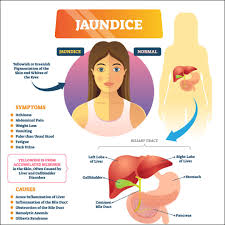
Jaundice is a medical condition characterized by a yellowing of the skin and eyes due to an accumulation of bilirubin, a yellow pigment produced during the breakdown of red blood cells.
Causes of J
Causes of J
Jaundice is a medical condition characterized by a yellowing of the skin and eyes due to an accumulation of bilirubin, a yellow pigment produced during the breakdown of red blood cells.
Causes of Jaundice:
1. Liver diseases: Hepatitis, cirrhosis, and liver cancer can cause jaundice.
2. Bile duct obstruction: Blockage of the bile ducts can prevent bilirubin from being excreted.
3. Hemolytic anemia: Conditions like sickle cell anemia and thalassemia can cause excessive red blood cell breakdown.
4. Infections: Certain infections, such as malaria and sepsis, can cause jaundice.
5. Medications: Certain medications, such as anabolic steroids and certain antibiotics, can cause jaundice.
Symptoms of Jaundice:
1. Yellowing of the skin and eyes
2. Dark urine
3. Pale stools
4. Fatigue
5. Loss of appetite
6. Nausea and vomiting
7. Abdominal pain
Foods to Include:
1. Fresh fruits: Fresh fruits like papaya, mango, and pineapple are rich in vitamins, minerals, and antioxidants that help reduce bilirubin levels.
2. Leafy greens: Leafy greens like spinach, kale, and collard greens are rich in chlorophyll, which helps remove bilirubin from the body.
3. Vegetables: Vegetables like carrots, beets, and sweet potatoes are rich in fiber, vitamins, and minerals that support liver health.
4. Whole grains: Whole grains like brown rice, quinoa, and whole-wheat bread provide fiber, vitamins, and minerals that support liver health.
5. Protein-rich foods: Protein-rich foods like legumes help build and repair liver cells.
6. Healthy fats: Healthy fats like avocado, nuts, and seeds support liver health and provide energy.
Foods to Avoid:
1. Fatty foods: Fatty foods like fried foods, processed meats, and high-fat dairy products can worsen jaundice.
2. Spicy foods: Spicy foods can irritate the liver and worsen jaundice.
3. High-sugar foods: High-sugar foods can worsen insulin resistance and liver damage.
4. Processed foods: Processed foods like packaged snacks, frozen meals, and sugary drinks can worsen liver damage.
5. Alcohol: Alcohol can worsen liver damage and jaundice.
Causes of Jaundice:
1. Liver diseases: Hepatitis, cirrhosis, and liver cancer can cause jaundice.
2. Bile duct obstruction: Blockage of the bile ducts can prevent bilirubin from being excreted.
3. Hemolytic anemia: Conditions like sickle cell anemia and thalassemia can cause excessive red blood cell breakdown.
4. Infections: Certain infections, such as malaria and sepsis, can cause jaundice.
5. Medications: Certain medications, such as anabolic steroids and certain antibiotics, can cause jaundice.
Symptoms of Jaundice:
1. Yellowing of the skin and eyes
2. Dark urine
3. Pale stools
4. Fatigue
5. Loss of appetite
6. Nausea and vomiting
7. Abdominal pain
Foods to Include:
1. Fresh fruits: Fresh fruits like papaya, mango, and pineapple are rich in vitamins, minerals, and antioxidants that help reduce bilirubin levels.
2. Leafy greens: Leafy greens like spinach, kale, and collard greens are rich in chlorophyll, which helps remove bilirubin from the body.
3. Vegetables: Vegetables like carrots, beets, and sweet potatoes are rich in fiber, vitamins, and minerals that support liver health.
4. Whole grains: Whole grains like brown rice, quinoa, and whole-wheat bread provide fiber, vitamins, and minerals that support liver health.
5. Protein-rich foods: Protein-rich foods like legumes help build and repair liver cells.
6. Healthy fats: Healthy fats like avocado, nuts, and seeds support liver health and provide energy.
Foods to Avoid:
1. Fatty foods: Fatty foods like fried foods, processed meats, and high-fat dairy products can worsen jaundice.
2. Spicy foods: Spicy foods can irritate the liver and worsen jaundice.
3. High-sugar foods: High-sugar foods can worsen insulin resistance and liver damage.
4. Processed foods: Processed foods like packaged snacks, frozen meals, and sugary drinks can worsen liver damage.
5. Alcohol: Alcohol can worsen liver damage and jaundice.
Monocytosis
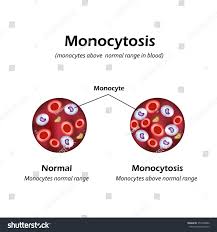
Monocytosis is a condition characterized by an abnormally high number of monocytes in the blood. Monocytes are a type of white blood cell that plays a crucial role in the immune system, helping to fig
Monocytosis is a condition characterized by an abnormally high number of monocytes in the blood. Monocytes are a type of white blood cell that plays a crucial role in the immune system, helping to fight infections and inflammation.
Monocytosis can be caused by a variety of factors, including:
1. Infections: Bacterial, viral, or fungal infections can cause an increase in monocytes.
2. Inflammatory conditions: Conditions like rheumatoid arthritis, lupus, and inflammatory bowel disease can cause monocytosis.
3. Cancer: Certain types of cancer, like leukemia and lymphoma, can cause an increase in monocytes.
4. Chronic diseases: Conditions like diabetes, hypertension, and cardiovascular disease can cause monocytosis.
5. Medications: Certain medications, like corticosteroids and immunosuppressants, can cause an increase in monocytes.
Symptoms of monocytosis may include:
1. Fatigue
2. Fever
3. Weight loss
4. Swollen lymph nodes
5. Skin rashes
Foods to Include in Diet:
1. Fruits: Fruits like berries, citrus fruits, and apples can help boost the immune system.
2. Vegetables: Vegetables like leafy greens, broccoli, and bell peppers can help reduce inflammation.
3. Whole grains: Whole grains like brown rice, quinoa, and whole-wheat bread can help reduce inflammation.
4. Lean proteins: Lean proteins like chicken, fish, and tofu can help boost the immune system.
5. Healthy fats: Healthy fats like avocado, nuts, and seeds can help reduce inflammation.
Monocytosis can be caused by a variety of factors, including:
1. Infections: Bacterial, viral, or fungal infections can cause an increase in monocytes.
2. Inflammatory conditions: Conditions like rheumatoid arthritis, lupus, and inflammatory bowel disease can cause monocytosis.
3. Cancer: Certain types of cancer, like leukemia and lymphoma, can cause an increase in monocytes.
4. Chronic diseases: Conditions like diabetes, hypertension, and cardiovascular disease can cause monocytosis.
5. Medications: Certain medications, like corticosteroids and immunosuppressants, can cause an increase in monocytes.
Symptoms of monocytosis may include:
1. Fatigue
2. Fever
3. Weight loss
4. Swollen lymph nodes
5. Skin rashes
Foods to Include in Diet:
1. Fruits: Fruits like berries, citrus fruits, and apples can help boost the immune system.
2. Vegetables: Vegetables like leafy greens, broccoli, and bell peppers can help reduce inflammation.
3. Whole grains: Whole grains like brown rice, quinoa, and whole-wheat bread can help reduce inflammation.
4. Lean proteins: Lean proteins like chicken, fish, and tofu can help boost the immune system.
5. Healthy fats: Healthy fats like avocado, nuts, and seeds can help reduce inflammation.
Neutrophils
.jpg)
Neutrophils are a type of white blood cell that plays a crucial role in the immune system. They are the most abundant type of white blood cell in the human body and are essential for fighting infectio
Neutrophils are a type of white blood cell that plays a crucial role in the immune system. They are the most abundant type of white blood cell in the human body and are essential for fighting infections.
Types of Neutrophils:
1. Segmented neutrophils: Mature neutrophils with a segmented nucleus.
2. Band neutrophils: Immature neutrophils with a band-shaped nucleus.
3. Metamyelocytes: Immature neutrophils with a distinctive nucleus.
Functions of Neutrophils:
1. Phagocytosis: Neutrophils engulf and digest foreign particles, bacteria, and dead cells.
2. Antimicrobial activity: Neutrophils produce enzymes and chemicals that help kill microorganisms.
3. Inflammation: Neutrophils contribute to the inflammatory response by releasing chemical signals that attract other immune cells.
- Neutrophilia: An increase in neutrophil count, which can indicate infection, inflammation, or cancer.
- Neutropenia: A decrease in neutrophil count, which can indicate bone marrow failure, cancer, or certain medications.
Causes of Abnormal Neutrophil Count:
1. Infections: Bacterial, viral, or fungal infections can cause an increase in neutrophil count.
2. Inflammatory conditions: Conditions like arthritis, gout, or inflammatory bowel disease can cause an increase in neutrophil count.
3. Cancer: Certain types of cancer, like leukemia, can cause an abnormal neutrophil count.
4. Medications: Certain medications, like corticosteroids, can cause an increase in neutrophil count.
Symptoms of Abnormal Neutrophil Count:
1. Fever
2. Fatigue
3. Weight loss
4. Swollen lymph nodes
5. Skin rashes
Types of Neutrophils:
1. Segmented neutrophils: Mature neutrophils with a segmented nucleus.
2. Band neutrophils: Immature neutrophils with a band-shaped nucleus.
3. Metamyelocytes: Immature neutrophils with a distinctive nucleus.
Functions of Neutrophils:
1. Phagocytosis: Neutrophils engulf and digest foreign particles, bacteria, and dead cells.
2. Antimicrobial activity: Neutrophils produce enzymes and chemicals that help kill microorganisms.
3. Inflammation: Neutrophils contribute to the inflammatory response by releasing chemical signals that attract other immune cells.
- Neutrophilia: An increase in neutrophil count, which can indicate infection, inflammation, or cancer.
- Neutropenia: A decrease in neutrophil count, which can indicate bone marrow failure, cancer, or certain medications.
Causes of Abnormal Neutrophil Count:
1. Infections: Bacterial, viral, or fungal infections can cause an increase in neutrophil count.
2. Inflammatory conditions: Conditions like arthritis, gout, or inflammatory bowel disease can cause an increase in neutrophil count.
3. Cancer: Certain types of cancer, like leukemia, can cause an abnormal neutrophil count.
4. Medications: Certain medications, like corticosteroids, can cause an increase in neutrophil count.
Symptoms of Abnormal Neutrophil Count:
1. Fever
2. Fatigue
3. Weight loss
4. Swollen lymph nodes
5. Skin rashes
Stem cell
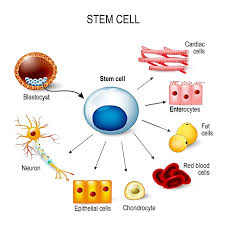
Stem cells are specialized cells that have the ability to differentiate into various cell types, such as muscle cells, nerve cells, or blood cells. They play a crucial role in development, growth, and
Stem cells are specialized cells that have the ability to differentiate into various cell types, such as muscle cells, nerve cells, or blood cells. They play a crucial role in development, growth, and repair of tissues.
Types of Stem Cells:
1. Embryonic Stem Cells: Derived from embryos, these cells have the ability to differentiate into any cell type.
2. Adult Stem Cells: Found in adult tissues, these cells can differentiate into specific cell types, such as blood cells or skin cells.
3. Induced Pluripotent Stem Cells (iPSCs): Created in the laboratory by reprogramming adult cells, iPSCs have the ability to differentiate into any cell type.
Sources of Stem Cells:
1. Bone marrow: A rich source of adult stem cells.
2. Adipose tissue: A source of adult stem cells.
3. Umbilical cord blood: A source of embryonic stem cells.
4. Embryonic stem cells: Derived from embryos.
Functions of Stem Cells:
1. Tissue repair: Stem cells can repair damaged tissues by differentiating into specialized cell types.
2. Regeneration: Stem cells can regenerate lost or damaged tissues.
3. Development: Stem cells play a crucial role in embryonic development.
Stem Cell Treatment for Various Conditions:
1. Orthopedic conditions: Stem cell treatment for joint pain, osteoarthritis, and tendonitis.
2. Neurological conditions: Stem cell treatment for Parkinson's disease, multiple sclerosis, and stroke.
3. Cardiovascular conditions: Stem cell treatment for heart failure, coronary artery disease, and peripheral artery disease.
4. Autoimmune conditions: Stem cell treatment for rheumatoid arthritis, lupus, and type 1 diabetes.
5. Cancer: Stem cell treatment for cancer, including leukemia, lymphoma, and solid tumors.
Stem Cell Treatment Procedures:
1. Bone marrow aspiration: Harvesting stem cells from bone marrow.
2. Adipose tissue harvesting: Harvesting stem cells from fat tissue.
3. Blood collection: Collecting stem cells from blood.
4. Stem cell expansion: Expanding stem cells in a laboratory.
5. Stem cell transplantation: Transplanting stem cells into the patient.
Benefits of Stem Cell Treatment:
1. Minimally invasive: Stem cell treatment is often minimally invasive, reducing recovery time.
2. Low risk of complications: Stem cell treatment has a low risk of complications compared to traditional surgery.
3. Promotes natural healing: Stem cell treatment promotes natural healing, reducing the need for medication or surgery.
4. Improves quality of life: Stem cell treatment can improve quality of life by reducing pain, inflammation, and disability.
Types of Stem Cells:
1. Embryonic Stem Cells: Derived from embryos, these cells have the ability to differentiate into any cell type.
2. Adult Stem Cells: Found in adult tissues, these cells can differentiate into specific cell types, such as blood cells or skin cells.
3. Induced Pluripotent Stem Cells (iPSCs): Created in the laboratory by reprogramming adult cells, iPSCs have the ability to differentiate into any cell type.
Sources of Stem Cells:
1. Bone marrow: A rich source of adult stem cells.
2. Adipose tissue: A source of adult stem cells.
3. Umbilical cord blood: A source of embryonic stem cells.
4. Embryonic stem cells: Derived from embryos.
Functions of Stem Cells:
1. Tissue repair: Stem cells can repair damaged tissues by differentiating into specialized cell types.
2. Regeneration: Stem cells can regenerate lost or damaged tissues.
3. Development: Stem cells play a crucial role in embryonic development.
Stem Cell Treatment for Various Conditions:
1. Orthopedic conditions: Stem cell treatment for joint pain, osteoarthritis, and tendonitis.
2. Neurological conditions: Stem cell treatment for Parkinson's disease, multiple sclerosis, and stroke.
3. Cardiovascular conditions: Stem cell treatment for heart failure, coronary artery disease, and peripheral artery disease.
4. Autoimmune conditions: Stem cell treatment for rheumatoid arthritis, lupus, and type 1 diabetes.
5. Cancer: Stem cell treatment for cancer, including leukemia, lymphoma, and solid tumors.
Stem Cell Treatment Procedures:
1. Bone marrow aspiration: Harvesting stem cells from bone marrow.
2. Adipose tissue harvesting: Harvesting stem cells from fat tissue.
3. Blood collection: Collecting stem cells from blood.
4. Stem cell expansion: Expanding stem cells in a laboratory.
5. Stem cell transplantation: Transplanting stem cells into the patient.
Benefits of Stem Cell Treatment:
1. Minimally invasive: Stem cell treatment is often minimally invasive, reducing recovery time.
2. Low risk of complications: Stem cell treatment has a low risk of complications compared to traditional surgery.
3. Promotes natural healing: Stem cell treatment promotes natural healing, reducing the need for medication or surgery.
4. Improves quality of life: Stem cell treatment can improve quality of life by reducing pain, inflammation, and disability.
Hypernatremia
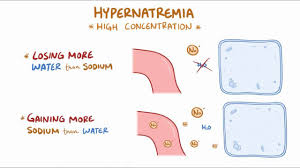
Hypernatremia is a condition where the sodium levels in the blood are higher than normal. Sodium is an essential electrolyte that helps regulate the amount of water in the body and supports nerve and
Hypernatremia is a condition where the sodium levels in the blood are higher than normal. Sodium is an essential electrolyte that helps regulate the amount of water in the body and supports nerve and muscle function.
Causes of Hypernatremia:
1. Dehydration: Excessive loss of water and electrolytes can lead to hypernatremia.
2. Diabetes insipidus: A condition where the body produces excessive amounts of urine, leading to dehydration and hypernatremia.
3. Kidney disease: Certain kidney diseases, such as nephrotic syndrome, can cause the kidneys to excrete too much water, leading to hypernatremia.
4. Hormonal imbalances: Hormonal imbalances, such as Cushing's syndrome, can cause the body to retain too much sodium.
5. Medications: Certain medications, such as diuretics and steroids, can cause the body to retain too much sodium.
Symptoms of Hypernatremia:
1. Thirst: Excessive thirst is a common symptom of hypernatremia.
2. Dry mouth: A dry mouth and decreased saliva production can occur.
3. Dark urine: Urine may become dark yellow or amber-colored due to dehydration.
4. Fatigue: Hypernatremia can cause fatigue, weakness, and lethargy.
5. Seizures: In severe cases, hypernatremia can cause seizures, coma, or even death.
Effects of hypernatremia :
1. High Blood Pressure: Excess sodium can increase blood pressure, which can lead to cardiovascular disease, heart failure, and stroke.
2. Fluid Retention: Sodium helps regulate the amount of fluid in the body. Excess sodium can lead to fluid retention, causing swelling in the feet, ankles, and hands.
3. Kidney Strain: The kidneys have to work harder to process excess sodium, which can lead to kidney strain and potentially kidney disease.
4. Stomach Problems: Excess sodium can cause stomach pain, bloating, and gas.
5. Weakened Bones: Excess sodium can increase the excretion of calcium in the urine, which can lead to weakened bones and osteoporosis.
Dietary Guidelines-
1. Fresh fruits and vegetables: Emphasize fresh fruits and vegetables, which are naturally low in sodium.
2. Low-sodium protein sources: Choose low-sodium protein sources, such as:
- Legumes (e.g., beans, lentils)
- Low-sodium dairy products
3. Whole grains: Choose whole grains, which are naturally low in sodium, such as:
- Brown rice
- Quinoa
- Whole-wheat bread
- Whole-grain pasta
Foods to Limit or Avoid:
1. High-sodium foods: Limit or avoid foods high in sodium, such as:
- Processed meats (e.g., bacon, sausage)
- Canned goods (e.g., soups, vegetables)
- Frozen meals
- Soy sauce
- Teriyaki sauce
- Pickled foods
2. Salty snacks: Limit or avoid salty snacks, such as:
- Chips
- Popcorn
- Pretzels
- Crackers
3. Condiments and sauces: Limit or avoid condiments and sauces high in sodium, such as:
- Ketchup
- Mustard
- Relish
- BBQ sauce
Causes of Hypernatremia:
1. Dehydration: Excessive loss of water and electrolytes can lead to hypernatremia.
2. Diabetes insipidus: A condition where the body produces excessive amounts of urine, leading to dehydration and hypernatremia.
3. Kidney disease: Certain kidney diseases, such as nephrotic syndrome, can cause the kidneys to excrete too much water, leading to hypernatremia.
4. Hormonal imbalances: Hormonal imbalances, such as Cushing's syndrome, can cause the body to retain too much sodium.
5. Medications: Certain medications, such as diuretics and steroids, can cause the body to retain too much sodium.
Symptoms of Hypernatremia:
1. Thirst: Excessive thirst is a common symptom of hypernatremia.
2. Dry mouth: A dry mouth and decreased saliva production can occur.
3. Dark urine: Urine may become dark yellow or amber-colored due to dehydration.
4. Fatigue: Hypernatremia can cause fatigue, weakness, and lethargy.
5. Seizures: In severe cases, hypernatremia can cause seizures, coma, or even death.
Effects of hypernatremia :
1. High Blood Pressure: Excess sodium can increase blood pressure, which can lead to cardiovascular disease, heart failure, and stroke.
2. Fluid Retention: Sodium helps regulate the amount of fluid in the body. Excess sodium can lead to fluid retention, causing swelling in the feet, ankles, and hands.
3. Kidney Strain: The kidneys have to work harder to process excess sodium, which can lead to kidney strain and potentially kidney disease.
4. Stomach Problems: Excess sodium can cause stomach pain, bloating, and gas.
5. Weakened Bones: Excess sodium can increase the excretion of calcium in the urine, which can lead to weakened bones and osteoporosis.
Dietary Guidelines-
1. Fresh fruits and vegetables: Emphasize fresh fruits and vegetables, which are naturally low in sodium.
2. Low-sodium protein sources: Choose low-sodium protein sources, such as:
- Legumes (e.g., beans, lentils)
- Low-sodium dairy products
3. Whole grains: Choose whole grains, which are naturally low in sodium, such as:
- Brown rice
- Quinoa
- Whole-wheat bread
- Whole-grain pasta
Foods to Limit or Avoid:
1. High-sodium foods: Limit or avoid foods high in sodium, such as:
- Processed meats (e.g., bacon, sausage)
- Canned goods (e.g., soups, vegetables)
- Frozen meals
- Soy sauce
- Teriyaki sauce
- Pickled foods
2. Salty snacks: Limit or avoid salty snacks, such as:
- Chips
- Popcorn
- Pretzels
- Crackers
3. Condiments and sauces: Limit or avoid condiments and sauces high in sodium, such as:
- Ketchup
- Mustard
- Relish
- BBQ sauce
Pellagra
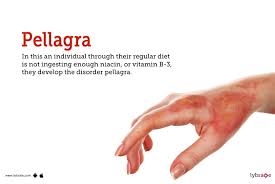
What is pellagra?
Pellagra is a disease caused by a deficiency of niacin, otherwise known as vitamin B3. It’s a form of malnutrition — specifically, micronutrient undernutrition. Niacin is crucia
Pellagra is a disease caused by a deficiency of niacin, otherwise known as vitamin B3. It’s a form of malnutrition — specifically, micronutrient undernutrition. Niacin is crucia
What is pellagra?
Pellagra is a disease caused by a deficiency of niacin, otherwise known as vitamin B3. It’s a form of malnutrition — specifically, micronutrient undernutrition. Niacin is crucial to cell functioning throughout body, and the lack of it shows up in symptoms throughout your body, including your skin, mouth, bowels and brain. If left untreated, pellagra can cause lasting damage to nervous system and even death.
What are the causes of pellagra?
The primary cause of pellagra is an inadequate diet. we can get vitamin B3 from a wide range of foods, but people who don’t have enough food choices may lack certain nutrients.The secondary causes are other health conditions that prevent your body from absorbing or using niacin. Some of these include:
1. Gastrointestinal diseases that cause malabsorption, such as inflammatory bowel disease or cirrhosis of the liver.
2. Alcohol use disorder. Heavy alcohol use can induce pellagra by way of organ damage, causing malabsorption and general malnutrition.
3. Gastric bypass surgery. Bariatric surgery can damage the intestinal mucosa, leading to various micronutrient deficiencies, including pellagra.
4. Iron deficiency anemia. Your body needs iron to convert and use niacin.
5. Hartnup disease. This genetic disorder prevents your body from absorbing amino acids, which are necessary to produce vitamins from food.
6. Carcinoid syndrome. This syndrome is characterized by active tumor cells that depress niacin production.
7. Certain drugs can disrupt your body’s niacin metabolism process, particularly antispasmodic and chemotherapy drugs.
8. HIV infectiondepletes niacin in your body.
What are the symptoms of pellagra?
Chronic diarrhea, sometimes bloody.
Abdominal pain and indigestion.
Loss of appetite, nausea and vomiting.
Itchy or painful skin rashes.
Mouth sores and a red, swollen tongue.
Fatigue, weakness and malaise.
Mood changes, depression.
Neurological symptoms such tremors or numbness and tingling in the hands and feet.
Delirium and dementia.
How do you prevent pellagra?
A well-balanced diet is the simplest way to ensure adequate nutrition. When food choices are limited, enriched foods and dietary supplements can help.
The best food sources of niacin are:
Beets.
Brewer's yeast.
Enriched bread and cereals.
Peanuts.
Potato.
Rice.
Sunflower seeds.
Pellagra is a disease caused by a deficiency of niacin, otherwise known as vitamin B3. It’s a form of malnutrition — specifically, micronutrient undernutrition. Niacin is crucial to cell functioning throughout body, and the lack of it shows up in symptoms throughout your body, including your skin, mouth, bowels and brain. If left untreated, pellagra can cause lasting damage to nervous system and even death.
What are the causes of pellagra?
The primary cause of pellagra is an inadequate diet. we can get vitamin B3 from a wide range of foods, but people who don’t have enough food choices may lack certain nutrients.The secondary causes are other health conditions that prevent your body from absorbing or using niacin. Some of these include:
1. Gastrointestinal diseases that cause malabsorption, such as inflammatory bowel disease or cirrhosis of the liver.
2. Alcohol use disorder. Heavy alcohol use can induce pellagra by way of organ damage, causing malabsorption and general malnutrition.
3. Gastric bypass surgery. Bariatric surgery can damage the intestinal mucosa, leading to various micronutrient deficiencies, including pellagra.
4. Iron deficiency anemia. Your body needs iron to convert and use niacin.
5. Hartnup disease. This genetic disorder prevents your body from absorbing amino acids, which are necessary to produce vitamins from food.
6. Carcinoid syndrome. This syndrome is characterized by active tumor cells that depress niacin production.
7. Certain drugs can disrupt your body’s niacin metabolism process, particularly antispasmodic and chemotherapy drugs.
8. HIV infectiondepletes niacin in your body.
What are the symptoms of pellagra?
Chronic diarrhea, sometimes bloody.
Abdominal pain and indigestion.
Loss of appetite, nausea and vomiting.
Itchy or painful skin rashes.
Mouth sores and a red, swollen tongue.
Fatigue, weakness and malaise.
Mood changes, depression.
Neurological symptoms such tremors or numbness and tingling in the hands and feet.
Delirium and dementia.
How do you prevent pellagra?
A well-balanced diet is the simplest way to ensure adequate nutrition. When food choices are limited, enriched foods and dietary supplements can help.
The best food sources of niacin are:
Beets.
Brewer's yeast.
Enriched bread and cereals.
Peanuts.
Potato.
Rice.
Sunflower seeds.
Vitamin A deficiency
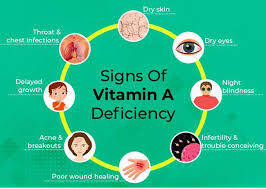
What is vitamin A?
Vitamin A plays a key role in many systems of body. Vitamin A is essential for healthy vision, metabolism and cell development. It’s an important factor in keeping your immune sy
Vitamin A plays a key role in many systems of body. Vitamin A is essential for healthy vision, metabolism and cell development. It’s an important factor in keeping your immune sy
What is vitamin A?
Vitamin A plays a key role in many systems of body. Vitamin A is essential for healthy vision, metabolism and cell development. It’s an important factor in keeping your immune system and reproductive system healthy. Body can’t make vitamin A on its own, so one must get it through the foods you eat.
Vitamin A is vital for your vision. Eyes need to make specific pigments for your retinas to work correctly. A lack of vitamin A hinders eyes ability to make these pigments, which can lead to night blindness. In other words, we need vitamin A to be able to see at night.Eyes also need vitamin A to produce moisture to keep your corneas properly lubricated. If your corneas get too dry, they can become damaged, which can lead to blindness.Vitamin A also keeps skin and the lining of your lungs, intestines and urinary tract in tip-top shape. Plus, it helps the immune system to protect against infections.
Causes of Vitamin A deficiency-
Vitamin A deficiency also occurs because of liver disorders. Liver stores most of your body’s vitamin A, and liver disorders can interfere with vitamin storage.
Diseases and conditions that impair your intestine’s ability to absorb fat can also cause vitamin A deficiency. These conditions can reduce your body’s ability to absorb vitamins such as vitamin A. These conditions include:
Chronic diarrhea.
Celiac disease.
Cystic fibrosis.
Certain pancreatic disorders.
Bile duct blockage.
Zinc or iron deficiency.
Small bowel bypass or bariatric surgery.
Alcohol use disorder.
Intestine or pancreas surgery.
Symptoms-
Difficulty seeing in the dark or night blindness (Nyctalopia).
Dry corneas or the whites of the eyes (Xerophthalmia)
Bitot spots in the whites of the eye
Sores in the corneas (Corneal ulcers)
Cloudy corneas (Keratomalacia)
If left untreated, these symptoms can lead to blindness.
Dietary Guidelines for Vitamin A deficiency-
1. Green vegetables, such as leafy greens and broccoli.
2. Orange and yellow vegetables, such as carrots, pumpkin, sweet potatoes and squash.
3. Orange and yellow fruits, such as oranges, mangos, cantaloupe and papayas.
4. Dairy products.
Vitamin A plays a key role in many systems of body. Vitamin A is essential for healthy vision, metabolism and cell development. It’s an important factor in keeping your immune system and reproductive system healthy. Body can’t make vitamin A on its own, so one must get it through the foods you eat.
Vitamin A is vital for your vision. Eyes need to make specific pigments for your retinas to work correctly. A lack of vitamin A hinders eyes ability to make these pigments, which can lead to night blindness. In other words, we need vitamin A to be able to see at night.Eyes also need vitamin A to produce moisture to keep your corneas properly lubricated. If your corneas get too dry, they can become damaged, which can lead to blindness.Vitamin A also keeps skin and the lining of your lungs, intestines and urinary tract in tip-top shape. Plus, it helps the immune system to protect against infections.
Causes of Vitamin A deficiency-
Vitamin A deficiency also occurs because of liver disorders. Liver stores most of your body’s vitamin A, and liver disorders can interfere with vitamin storage.
Diseases and conditions that impair your intestine’s ability to absorb fat can also cause vitamin A deficiency. These conditions can reduce your body’s ability to absorb vitamins such as vitamin A. These conditions include:
Chronic diarrhea.
Celiac disease.
Cystic fibrosis.
Certain pancreatic disorders.
Bile duct blockage.
Zinc or iron deficiency.
Small bowel bypass or bariatric surgery.
Alcohol use disorder.
Intestine or pancreas surgery.
Symptoms-
Difficulty seeing in the dark or night blindness (Nyctalopia).
Dry corneas or the whites of the eyes (Xerophthalmia)
Bitot spots in the whites of the eye
Sores in the corneas (Corneal ulcers)
Cloudy corneas (Keratomalacia)
If left untreated, these symptoms can lead to blindness.
Dietary Guidelines for Vitamin A deficiency-
1. Green vegetables, such as leafy greens and broccoli.
2. Orange and yellow vegetables, such as carrots, pumpkin, sweet potatoes and squash.
3. Orange and yellow fruits, such as oranges, mangos, cantaloupe and papayas.
4. Dairy products.
Ebola
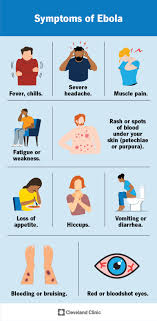
What is Ebola?
Ebola is a type of viral hemorrhagic fever caused by several species of viruses from the genus Ebolavirus. Symptoms of Ebola start out flu-like but can progress to severe vomiting, ble
Ebola is a type of viral hemorrhagic fever caused by several species of viruses from the genus Ebolavirus. Symptoms of Ebola start out flu-like but can progress to severe vomiting, ble
What is Ebola?
Ebola is a type of viral hemorrhagic fever caused by several species of viruses from the genus Ebolavirus. Symptoms of Ebola start out flu-like but can progress to severe vomiting, bleeding and neurological (brain and nerve) issues.Ebola can spread to people from bats, nonhuman primates and antelope.
What causes Ebola?
Four species of viruses cause Ebola disease in humans:
Zaire ebolavirus.
Sudan ebolavirus.
Taï Forest ebolavirus.
Bundibugyo ebolavirus.
Ebolaviruses start in bats, nonhuman primates (monkeys and apes) and antelope in countries of West, Central and East Africa. They all cause similar symptoms and spread in the same way.
What are the symptoms of Ebola disease?
Symptoms of Ebola include:
Severe headache.
Muscle pain.
Sore throat.
Rash or spots of blood under your skin (petechiae or purpura).
Fatigue and weakness.
Loss of appetite.
Vomiting or diarrhea. This could be bloody.
Bleeding or bruising.
Red or bloodshot eyes.
Recommended Foods
1. Fruits: Fresh fruits like mangoes, bananas, and papayas are rich in vitamins, minerals, and antioxidants.
2. Vegetables: Leafy greens like spinach, kale, and collard greens are rich in vitamins and minerals.
3. Whole grains: Brown rice, whole-wheat bread, and whole-grain pasta are rich in fiber, vitamins, and minerals.
4. Lean proteins: Chicken, fish, and beans are good sources of lean protein.
5. Healthy fats: Nuts, seeds, and avocados are rich in healthy fats.
Foods to Avoid
1. Raw or undercooked meat: Avoid raw or undercooked meat, especially bushmeat.
2. Unpasteurized dairy products: Avoid unpasteurized dairy products, like raw milk and cheese.
3. Raw or undercooked eggs: Avoid raw or undercooked eggs.
4. High-sugar foods: Limit high-sugar foods and drinks.
5. Processed and packaged foods: Limit processed and packaged foods, which can be high in salt, sugar, and unhealthy fats.
Ebola is a type of viral hemorrhagic fever caused by several species of viruses from the genus Ebolavirus. Symptoms of Ebola start out flu-like but can progress to severe vomiting, bleeding and neurological (brain and nerve) issues.Ebola can spread to people from bats, nonhuman primates and antelope.
What causes Ebola?
Four species of viruses cause Ebola disease in humans:
Zaire ebolavirus.
Sudan ebolavirus.
Taï Forest ebolavirus.
Bundibugyo ebolavirus.
Ebolaviruses start in bats, nonhuman primates (monkeys and apes) and antelope in countries of West, Central and East Africa. They all cause similar symptoms and spread in the same way.
What are the symptoms of Ebola disease?
Symptoms of Ebola include:
Severe headache.
Muscle pain.
Sore throat.
Rash or spots of blood under your skin (petechiae or purpura).
Fatigue and weakness.
Loss of appetite.
Vomiting or diarrhea. This could be bloody.
Bleeding or bruising.
Red or bloodshot eyes.
Recommended Foods
1. Fruits: Fresh fruits like mangoes, bananas, and papayas are rich in vitamins, minerals, and antioxidants.
2. Vegetables: Leafy greens like spinach, kale, and collard greens are rich in vitamins and minerals.
3. Whole grains: Brown rice, whole-wheat bread, and whole-grain pasta are rich in fiber, vitamins, and minerals.
4. Lean proteins: Chicken, fish, and beans are good sources of lean protein.
5. Healthy fats: Nuts, seeds, and avocados are rich in healthy fats.
Foods to Avoid
1. Raw or undercooked meat: Avoid raw or undercooked meat, especially bushmeat.
2. Unpasteurized dairy products: Avoid unpasteurized dairy products, like raw milk and cheese.
3. Raw or undercooked eggs: Avoid raw or undercooked eggs.
4. High-sugar foods: Limit high-sugar foods and drinks.
5. Processed and packaged foods: Limit processed and packaged foods, which can be high in salt, sugar, and unhealthy fats.
Mumps
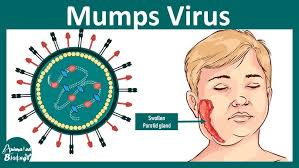
What is mumps?
Mumps is a contagious disease caused by the mumps virus, which belongs to a group of viruses known as paramyxoviruses. The illness starts with mild symptoms such as headache, fever and
Mumps is a contagious disease caused by the mumps virus, which belongs to a group of viruses known as paramyxoviruses. The illness starts with mild symptoms such as headache, fever and
What is mumps?
Mumps is a contagious disease caused by the mumps virus, which belongs to a group of viruses known as paramyxoviruses. The illness starts with mild symptoms such as headache, fever and fatigue. But then it typically leads to severe swelling in certain salivary glands (parotitis) that causes puffy cheeks and a tender, swollen jaw.
Causes and Transmission
1. Viral infection: Mumps is caused by a virus that affects the salivary glands.
2. Airborne transmission: Mumps is spread through airborne droplets that are released when an infected person coughs or sneezes.
3. Close contact: Mumps can also be spread through close contact with an infected person, such as touching or sharing utensils.
Symptoms
1. Swollen salivary glands: The most common symptom of mumps is swollen salivary glands, which can cause the cheeks to puff out.
2. Fever: Mumps is often accompanied by a fever, which can range from mild to severe.
3. Headache: A headache is another common symptom of mumps.
4. Fatigue: Mumps can cause fatigue and a general feeling of being unwell.
5. Loss of appetite: Mumps can also cause a loss of appetite.
Recommended Foods
1. Soups: Clear soups like chicken or vegetable broth can help replace lost fluids and electrolytes.
2. Yogurt: Yogurt is a good source of protein and can help soothe the throat.
3. Scrambled eggs: Scrambled eggs are a good source of protein and can be easy to chew.
4. Mashed potatoes: Mashed potatoes are a comforting, easy-to-chew food.
5. Fresh fruits: Fresh fruits like bananas, apples, and grapes can provide essential vitamins and minerals.
Foods to Avoid
1. Citrus fruits: Avoid citrus fruits like oranges, lemons, and grapefruits, which can irritate the throat and salivary glands.
2. Spicy foods: Avoid spicy foods like hot peppers, wasabi, and horseradish, which can irritate the throat and salivary glands.
3. Acidic foods: Avoid acidic foods like tomatoes, vinegar, and pickled foods, which can irritate the throat and salivary glands.
4. Hard or crunchy foods: Avoid hard or crunchy foods like nuts, seeds, and raw vegetables, which can be difficult to chew.
Mumps is a contagious disease caused by the mumps virus, which belongs to a group of viruses known as paramyxoviruses. The illness starts with mild symptoms such as headache, fever and fatigue. But then it typically leads to severe swelling in certain salivary glands (parotitis) that causes puffy cheeks and a tender, swollen jaw.
Causes and Transmission
1. Viral infection: Mumps is caused by a virus that affects the salivary glands.
2. Airborne transmission: Mumps is spread through airborne droplets that are released when an infected person coughs or sneezes.
3. Close contact: Mumps can also be spread through close contact with an infected person, such as touching or sharing utensils.
Symptoms
1. Swollen salivary glands: The most common symptom of mumps is swollen salivary glands, which can cause the cheeks to puff out.
2. Fever: Mumps is often accompanied by a fever, which can range from mild to severe.
3. Headache: A headache is another common symptom of mumps.
4. Fatigue: Mumps can cause fatigue and a general feeling of being unwell.
5. Loss of appetite: Mumps can also cause a loss of appetite.
Recommended Foods
1. Soups: Clear soups like chicken or vegetable broth can help replace lost fluids and electrolytes.
2. Yogurt: Yogurt is a good source of protein and can help soothe the throat.
3. Scrambled eggs: Scrambled eggs are a good source of protein and can be easy to chew.
4. Mashed potatoes: Mashed potatoes are a comforting, easy-to-chew food.
5. Fresh fruits: Fresh fruits like bananas, apples, and grapes can provide essential vitamins and minerals.
Foods to Avoid
1. Citrus fruits: Avoid citrus fruits like oranges, lemons, and grapefruits, which can irritate the throat and salivary glands.
2. Spicy foods: Avoid spicy foods like hot peppers, wasabi, and horseradish, which can irritate the throat and salivary glands.
3. Acidic foods: Avoid acidic foods like tomatoes, vinegar, and pickled foods, which can irritate the throat and salivary glands.
4. Hard or crunchy foods: Avoid hard or crunchy foods like nuts, seeds, and raw vegetables, which can be difficult to chew.
Measles
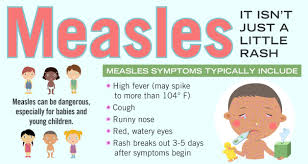
Measles is a highly contagious disease caused by a virus. It spreads easily when an infected person breathes, coughs or sneezes. It can cause severe disease, complications, and even death.Measles can
Measles is a highly contagious disease caused by a virus. It spreads easily when an infected person breathes, coughs or sneezes. It can cause severe disease, complications, and even death.Measles can affect anyone but is most common in children.
Causes and Transmission
1. Viral infection: Measles is caused by a virus that affects the respiratory system.
2. Airborne transmission: Measles is spread through airborne droplets that are released when an infected person coughs or sneezes.
3. Close contact: Measles can also be spread through close contact with an infected person.
Symptoms
1. Fever: Measles is often accompanied by a high fever.
2. Cough: A persistent cough is a common symptom of measles.
3. Runny nose: Measles can cause a runny nose and congestion.
4. Red eyes: Measles can cause red, watery eyes.
5. Rash: A characteristic rash appears 3-5 days after the onset of symptoms.
Foods to Eat
1. Soups: Clear soups like chicken or vegetable broth can help replace lost fluids and electrolytes.
2. Fresh fruits: Fresh fruits like bananas, apples, and grapes can provide essential vitamins and minerals.
3. Yogurt: Yogurt is a good source of protein and can help soothe the digestive system.
4. Whole grains: Whole grains like brown rice, quinoa, and whole-wheat bread can provide fiber, vitamins, and minerals.
Foods to Avoid
1. Spicy foods: Avoid spicy foods like hot peppers, wasabi, and horseradish.
2. Acidic foods: Avoid acidic foods like citrus fruits, tomatoes, and vinegar.
3. High-sugar foods: Limit high-sugar foods and drinks.
4. Processed and packaged foods: Limit processed and packaged foods, which can be high in salt, sugar, and unhealthy fats.
Causes and Transmission
1. Viral infection: Measles is caused by a virus that affects the respiratory system.
2. Airborne transmission: Measles is spread through airborne droplets that are released when an infected person coughs or sneezes.
3. Close contact: Measles can also be spread through close contact with an infected person.
Symptoms
1. Fever: Measles is often accompanied by a high fever.
2. Cough: A persistent cough is a common symptom of measles.
3. Runny nose: Measles can cause a runny nose and congestion.
4. Red eyes: Measles can cause red, watery eyes.
5. Rash: A characteristic rash appears 3-5 days after the onset of symptoms.
Foods to Eat
1. Soups: Clear soups like chicken or vegetable broth can help replace lost fluids and electrolytes.
2. Fresh fruits: Fresh fruits like bananas, apples, and grapes can provide essential vitamins and minerals.
3. Yogurt: Yogurt is a good source of protein and can help soothe the digestive system.
4. Whole grains: Whole grains like brown rice, quinoa, and whole-wheat bread can provide fiber, vitamins, and minerals.
Foods to Avoid
1. Spicy foods: Avoid spicy foods like hot peppers, wasabi, and horseradish.
2. Acidic foods: Avoid acidic foods like citrus fruits, tomatoes, and vinegar.
3. High-sugar foods: Limit high-sugar foods and drinks.
4. Processed and packaged foods: Limit processed and packaged foods, which can be high in salt, sugar, and unhealthy fats.
Fibromyalgia
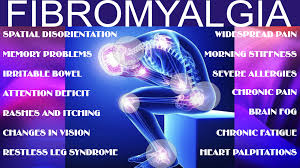
What is fibromyalgia?
Fibromyalgia is a long-term (chronic) health condition that causes pain and tenderness throughout your body. It causes musculoskeletal pain and fatigue.
People with fibromyalgi
Fibromyalgia is a long-term (chronic) health condition that causes pain and tenderness throughout your body. It causes musculoskeletal pain and fatigue.
People with fibromyalgi
What is fibromyalgia?
Fibromyalgia is a long-term (chronic) health condition that causes pain and tenderness throughout your body. It causes musculoskeletal pain and fatigue.
People with fibromyalgia usually experience symptoms that come and go in periods called flare-ups. Sometimes, it can feel exhausting and challenging to navigate living with fibromyalgia.
Causes-
Genetic Factors
1. Genetic predisposition: Fibromyalgia tends to run in families, suggesting a possible genetic component.
2. Genetic variations: Certain genetic variations, such as those affecting serotonin and dopamine regulation, may contribute to fibromyalgia.
Neurological Factors
1. Central nervous system (CNS) abnormalities: Fibromyalgia is characterized by altered CNS processing, including changes in pain perception and neurotransmitter regulation.
2. Neurotransmitter imbalances: Imbalances in neurotransmitters like serotonin, dopamine, and substance P may contribute to fibromyalgia symptoms.
Hormonal Factors
1. Hormonal imbalances: Hormonal changes, particularly in cortisol and thyroid hormone levels, may play a role in fibromyalgia.
2. Stress response: The stress response, which involves the release of cortisol and other hormones, may contribute to fibromyalgia symptoms.
Environmental Factors
1. Trauma: Physical or emotional trauma, such as a car accident or abuse, may trigger fibromyalgia.
2. Infections: Certain infections, like Lyme disease or hepatitis C, may contribute to fibromyalgia.
3. Autoimmune disorders: Fibromyalgia often co-occurs with autoimmune disorders, such as rheumatoid arthritis or lupus.
Symptoms-
Primary Symptoms:
1. Widespread muscle pain: Pain and stiffness in muscles, tendons, and ligaments, especially in the neck, back, shoulders, and hips.
2. Fatigue: Persistent and profound fatigue, which can interfere with daily activities.
3. Sleep disturbances: Difficulty sleeping or insomnia, which can exacerbate symptoms.
4. Cognitive difficulties: Difficulty concentrating, memory problems, and confusion.
5. Tender points: Specific areas on the body that are sensitive to touch, such as the elbows, knees, and hips.
Secondary Symptoms:
1. Headaches: Frequent and recurring headaches, including migraines and tension headaches.
2. Irritable bowel syndrome (IBS): Abdominal pain, bloating, and changes in bowel movements.
3. Restless leg syndrome: Uncomfortable sensations in the legs, such as itching, tingling, or burning.
4. Sensitivity to light and sound: Increased sensitivity to light and sound, which can exacerbate symptoms.
5. Mood changes: Depression, anxiety, and mood swings, which can be related to chronic pain and fatigue.
6. Memory problems: Difficulty remembering recent events, learning new information, and concentrating.
7. Muscle spasms: Muscle spasms, cramps, and stiffness, especially in the neck, back, and legs.
8. Numbness or tingling: Numbness or tingling sensations in the hands and feet.
Dietary guidelines-
Foods to Eat
1. Fruits: Fresh fruits like berries, citrus fruits, and apples are rich in antioxidants and fiber.
2. Vegetables: Leafy greens like spinach, kale, and broccoli are rich in vitamins and minerals.
3. Whole grains: Brown rice, quinoa, and whole-wheat bread provide fiber, vitamins, and minerals.
4. Lean proteins: Chicken, fish, and tofu are good sources of protein.
5. Healthy fats: Nuts, seeds, and avocados provide healthy fats.
Foods to Avoid
1. Gluten: Some people with fibromyalgia may experience symptoms triggered by gluten.
2. Dairy: Dairy products can trigger symptoms in some individuals.
3. Spicy foods: Spicy foods can exacerbate symptoms like pain and inflammation.
4. Processed and packaged foods: Limit foods high in salt, sugar, and unhealthy fats.
5. Caffeine and sugar: Limit or avoid caffeine and sugar, which can exacerbate symptoms.
Fibromyalgia is a long-term (chronic) health condition that causes pain and tenderness throughout your body. It causes musculoskeletal pain and fatigue.
People with fibromyalgia usually experience symptoms that come and go in periods called flare-ups. Sometimes, it can feel exhausting and challenging to navigate living with fibromyalgia.
Causes-
Genetic Factors
1. Genetic predisposition: Fibromyalgia tends to run in families, suggesting a possible genetic component.
2. Genetic variations: Certain genetic variations, such as those affecting serotonin and dopamine regulation, may contribute to fibromyalgia.
Neurological Factors
1. Central nervous system (CNS) abnormalities: Fibromyalgia is characterized by altered CNS processing, including changes in pain perception and neurotransmitter regulation.
2. Neurotransmitter imbalances: Imbalances in neurotransmitters like serotonin, dopamine, and substance P may contribute to fibromyalgia symptoms.
Hormonal Factors
1. Hormonal imbalances: Hormonal changes, particularly in cortisol and thyroid hormone levels, may play a role in fibromyalgia.
2. Stress response: The stress response, which involves the release of cortisol and other hormones, may contribute to fibromyalgia symptoms.
Environmental Factors
1. Trauma: Physical or emotional trauma, such as a car accident or abuse, may trigger fibromyalgia.
2. Infections: Certain infections, like Lyme disease or hepatitis C, may contribute to fibromyalgia.
3. Autoimmune disorders: Fibromyalgia often co-occurs with autoimmune disorders, such as rheumatoid arthritis or lupus.
Symptoms-
Primary Symptoms:
1. Widespread muscle pain: Pain and stiffness in muscles, tendons, and ligaments, especially in the neck, back, shoulders, and hips.
2. Fatigue: Persistent and profound fatigue, which can interfere with daily activities.
3. Sleep disturbances: Difficulty sleeping or insomnia, which can exacerbate symptoms.
4. Cognitive difficulties: Difficulty concentrating, memory problems, and confusion.
5. Tender points: Specific areas on the body that are sensitive to touch, such as the elbows, knees, and hips.
Secondary Symptoms:
1. Headaches: Frequent and recurring headaches, including migraines and tension headaches.
2. Irritable bowel syndrome (IBS): Abdominal pain, bloating, and changes in bowel movements.
3. Restless leg syndrome: Uncomfortable sensations in the legs, such as itching, tingling, or burning.
4. Sensitivity to light and sound: Increased sensitivity to light and sound, which can exacerbate symptoms.
5. Mood changes: Depression, anxiety, and mood swings, which can be related to chronic pain and fatigue.
6. Memory problems: Difficulty remembering recent events, learning new information, and concentrating.
7. Muscle spasms: Muscle spasms, cramps, and stiffness, especially in the neck, back, and legs.
8. Numbness or tingling: Numbness or tingling sensations in the hands and feet.
Dietary guidelines-
Foods to Eat
1. Fruits: Fresh fruits like berries, citrus fruits, and apples are rich in antioxidants and fiber.
2. Vegetables: Leafy greens like spinach, kale, and broccoli are rich in vitamins and minerals.
3. Whole grains: Brown rice, quinoa, and whole-wheat bread provide fiber, vitamins, and minerals.
4. Lean proteins: Chicken, fish, and tofu are good sources of protein.
5. Healthy fats: Nuts, seeds, and avocados provide healthy fats.
Foods to Avoid
1. Gluten: Some people with fibromyalgia may experience symptoms triggered by gluten.
2. Dairy: Dairy products can trigger symptoms in some individuals.
3. Spicy foods: Spicy foods can exacerbate symptoms like pain and inflammation.
4. Processed and packaged foods: Limit foods high in salt, sugar, and unhealthy fats.
5. Caffeine and sugar: Limit or avoid caffeine and sugar, which can exacerbate symptoms.
Insomnia

Insomnia is a common sleep disorder that can make it hard to fall asleep or stay asleep. It also can cause you to wake up too early and not be able to get back to sleep. You may still feel tired when
Insomnia is a common sleep disorder that can make it hard to fall asleep or stay asleep. It also can cause you to wake up too early and not be able to get back to sleep. You may still feel tired when you wake up. Insomnia can drain your energy level and affect mood. It also can affect health, work performance and quality of life.
Causes of Insomnia-
1. Stress and anxiety: Stress and anxiety can make it difficult to fall asleep or stay asleep.
2. Poor sleep habits: Irregular sleep schedules, consuming caffeine or electronics before bedtime, and sleeping in an uncomfortable environment can disrupt
sleep.
3. Medical conditions: Chronic pain, sleep apnea, restless leg syndrome, and other medical conditions can cause insomnia.
4. Medications: Certain medications, such as those used to treat depression, ADHD, and high blood pressure, can interfere with sleep.
5. Lifestyle factors: Working late shifts, traveling across time zones, and working long hours can disrupt sleep patterns.
Symptoms of Insomnia-
1. Difficulty falling asleep: Taking more than 30 minutes to fall asleep.
2. Waking up frequently: Waking up multiple times during the night and having trouble falling back asleep.
3. Waking up too early: Waking up earlier than desired and being unable to fall back asleep.
4. Poor sleep quality: Waking up feeling tired, groggy, or unrefreshed.
Dietary guidelines-
Foods to Eat
1. Tryptophan-rich foods: Tryptophan is an amino acid that helps produce serotonin, a neurotransmitter that regulates sleep. Include tryptophan-rich foods like turkey, chicken, fish, beans, and eggs in your diet.
2. Complex carbohydrates: Complex carbohydrates like whole grains, fruits, and vegetables can help increase serotonin levels. Include foods like brown rice, quinoa, sweet potatoes, and leafy greens in your diet.
3. Calcium-rich foods: Calcium helps regulate muscle relaxation and can promote better sleep. Include calcium-rich foods like dairy products, leafy greens, and fortified plant-based milk in your diet.
4. Omega-3 fatty acids: Omega-3 fatty acids can help reduce inflammation and promote relaxation. Include foods rich in omega-3s like fatty fish, nuts, and seeds in your diet.
Foods to Avoid
1. Caffeine: Avoid consuming caffeine, especially in the hours leading up to bedtime, as it can disrupt sleep patterns.
2. Sugar: Avoid consuming sugary foods and drinks, especially close to bedtime, as they can cause a spike in energy and make it harder to fall asleep.
3. Heavy meals: Avoid eating heavy meals close to bedtime, as they can cause discomfort and indigestion, making it harder to fall asleep.
4. Spicy foods: Avoid consuming spicy foods close to bedtime, as they can cause discomfort and indigestion, making it harder to fall asleep.
Causes of Insomnia-
1. Stress and anxiety: Stress and anxiety can make it difficult to fall asleep or stay asleep.
2. Poor sleep habits: Irregular sleep schedules, consuming caffeine or electronics before bedtime, and sleeping in an uncomfortable environment can disrupt
sleep.
3. Medical conditions: Chronic pain, sleep apnea, restless leg syndrome, and other medical conditions can cause insomnia.
4. Medications: Certain medications, such as those used to treat depression, ADHD, and high blood pressure, can interfere with sleep.
5. Lifestyle factors: Working late shifts, traveling across time zones, and working long hours can disrupt sleep patterns.
Symptoms of Insomnia-
1. Difficulty falling asleep: Taking more than 30 minutes to fall asleep.
2. Waking up frequently: Waking up multiple times during the night and having trouble falling back asleep.
3. Waking up too early: Waking up earlier than desired and being unable to fall back asleep.
4. Poor sleep quality: Waking up feeling tired, groggy, or unrefreshed.
Dietary guidelines-
Foods to Eat
1. Tryptophan-rich foods: Tryptophan is an amino acid that helps produce serotonin, a neurotransmitter that regulates sleep. Include tryptophan-rich foods like turkey, chicken, fish, beans, and eggs in your diet.
2. Complex carbohydrates: Complex carbohydrates like whole grains, fruits, and vegetables can help increase serotonin levels. Include foods like brown rice, quinoa, sweet potatoes, and leafy greens in your diet.
3. Calcium-rich foods: Calcium helps regulate muscle relaxation and can promote better sleep. Include calcium-rich foods like dairy products, leafy greens, and fortified plant-based milk in your diet.
4. Omega-3 fatty acids: Omega-3 fatty acids can help reduce inflammation and promote relaxation. Include foods rich in omega-3s like fatty fish, nuts, and seeds in your diet.
Foods to Avoid
1. Caffeine: Avoid consuming caffeine, especially in the hours leading up to bedtime, as it can disrupt sleep patterns.
2. Sugar: Avoid consuming sugary foods and drinks, especially close to bedtime, as they can cause a spike in energy and make it harder to fall asleep.
3. Heavy meals: Avoid eating heavy meals close to bedtime, as they can cause discomfort and indigestion, making it harder to fall asleep.
4. Spicy foods: Avoid consuming spicy foods close to bedtime, as they can cause discomfort and indigestion, making it harder to fall asleep.
Sleep apnea
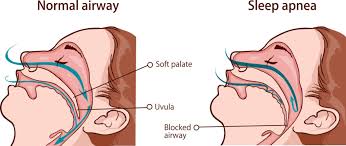
Sleep apnea is a potentially serious sleep disorder in which breathing repeatedly stops and starts. If you snore loudly and feel tired even after a full night's sleep, you might have sleep apnea.
T
T
Sleep apnea is a potentially serious sleep disorder in which breathing repeatedly stops and starts. If you snore loudly and feel tired even after a full night's sleep, you might have sleep apnea.
Types of Sleep Apnea
1. Obstructive Sleep Apnea (OSA): The most common type, caused by a blockage in the airway, usually due to the collapse of the soft tissues in the throat.
2. Central Sleep Apnea (CSA): Caused by a lack of signal from the brain to breathe, often seen in people with underlying medical conditions such as heart failure or stroke.
3. Mixed Sleep Apnea: A combination of OSA and CSA
Causes and Risk Factors
1. Obesity: Excess weight can cause fat to accumulate in the throat, blocking the airway
2. Age: Sleep apnea is more common in older adults
3. Family history: Having a family history of sleep apnea increases the risk
4. Smoking: Smoking can increase the risk of sleep apnea
5. Narrow airways: Some people may have a narrower airway, making them more prone to sleep apnea
Symptoms
1. Loud snoring: Often accompanied by pauses in breathing
2. Morning headaches: Due to lack of oxygen during sleep
3. Daytime fatigue: Despite getting a full night's sleep
4. Difficulty concentrating: And paying attention
5. High blood pressure: Often seen in people with sleep apnea
6. Waking up with a dry mouth or sore throat: Due to breathing through the mouth during sleep
Dietary guidelines-
Foods to Eat
1. Fruits and vegetables: Rich in antioxidants and fiber, which can help reduce inflammation and promote weight loss.
2. Whole grains: Whole grains like brown rice, quinoa, and whole-wheat bread can help regulate blood sugar and insulin levels.
3. Lean proteins: Lean proteins like chicken, fish, and tofu can help reduce inflammation and promote weight loss.
4. Healthy fats: Healthy fats like avocado, nuts, and seeds can help reduce inflammation and promote weight loss.
5. Low-fat dairy: Low-fat dairy products like milk, yogurt, and cheese can help reduce inflammation and promote weight loss.
Foods to Avoid-
1. Refined carbohydrates: Refined carbohydrates like white bread, sugary snacks, and sweetened beverages can increase inflammation and worsen sleep
apnea symptoms.
2. Fried foods: Fried foods like french fries, fried chicken, and doughnuts can increase inflammation and worsen sleep apnea symptoms.
3. High-sugar foods: High-sugar foods like candy, cakes, and pastries can increase inflammation and worsen sleep apnea symptoms.
4. Salty foods: Salty foods like chips, pretzels, and processed snacks can increase inflammation and worsen sleep apnea symptoms.
Types of Sleep Apnea
1. Obstructive Sleep Apnea (OSA): The most common type, caused by a blockage in the airway, usually due to the collapse of the soft tissues in the throat.
2. Central Sleep Apnea (CSA): Caused by a lack of signal from the brain to breathe, often seen in people with underlying medical conditions such as heart failure or stroke.
3. Mixed Sleep Apnea: A combination of OSA and CSA
Causes and Risk Factors
1. Obesity: Excess weight can cause fat to accumulate in the throat, blocking the airway
2. Age: Sleep apnea is more common in older adults
3. Family history: Having a family history of sleep apnea increases the risk
4. Smoking: Smoking can increase the risk of sleep apnea
5. Narrow airways: Some people may have a narrower airway, making them more prone to sleep apnea
Symptoms
1. Loud snoring: Often accompanied by pauses in breathing
2. Morning headaches: Due to lack of oxygen during sleep
3. Daytime fatigue: Despite getting a full night's sleep
4. Difficulty concentrating: And paying attention
5. High blood pressure: Often seen in people with sleep apnea
6. Waking up with a dry mouth or sore throat: Due to breathing through the mouth during sleep
Dietary guidelines-
Foods to Eat
1. Fruits and vegetables: Rich in antioxidants and fiber, which can help reduce inflammation and promote weight loss.
2. Whole grains: Whole grains like brown rice, quinoa, and whole-wheat bread can help regulate blood sugar and insulin levels.
3. Lean proteins: Lean proteins like chicken, fish, and tofu can help reduce inflammation and promote weight loss.
4. Healthy fats: Healthy fats like avocado, nuts, and seeds can help reduce inflammation and promote weight loss.
5. Low-fat dairy: Low-fat dairy products like milk, yogurt, and cheese can help reduce inflammation and promote weight loss.
Foods to Avoid-
1. Refined carbohydrates: Refined carbohydrates like white bread, sugary snacks, and sweetened beverages can increase inflammation and worsen sleep
apnea symptoms.
2. Fried foods: Fried foods like french fries, fried chicken, and doughnuts can increase inflammation and worsen sleep apnea symptoms.
3. High-sugar foods: High-sugar foods like candy, cakes, and pastries can increase inflammation and worsen sleep apnea symptoms.
4. Salty foods: Salty foods like chips, pretzels, and processed snacks can increase inflammation and worsen sleep apnea symptoms.
Parasomnias
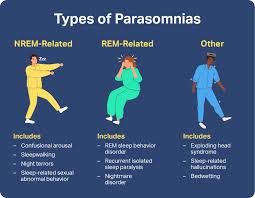
Parasomnias are disruptive behaviors or events that affect your sleep. You might walk, talk or make physical movements to act out a dream. You might wake up in fear or be unable to move.
Types of
Types of
Parasomnias are disruptive behaviors or events that affect your sleep. You might walk, talk or make physical movements to act out a dream. You might wake up in fear or be unable to move.
Types of Parasomnias
1. Sleepwalking (Somnambulism): Getting up and walking around during deep sleep, often with no memory of the event.
2. Sleep Talking (Somniloquy): Talking during sleep, ranging from simple sounds to complex conversations.
3. Sleep Terrors (Night Terrors): Waking up with a loud scream or intense fear, often with no memory of the event.
4. REM Sleep Behavior Disorder (RBD): Acting out dreams during REM sleep, often involving violent or aggressive behavior.
5. Nocturnal Eating Syndrome: Eating during sleep, often with no memory of the event.
Causes and Risk Factors
1. Genetics: Family history can play a role in the development of parasomnias.
2. Sleep Deprivation: Lack of sleep or disrupted sleep patterns can trigger parasomnias.
3. Sleep Disorders: Conditions like sleep apnea, restless leg syndrome, and insomnia can increase the risk of parasomnias.
4. Medications: Certain medications, such as sedatives and antidepressants, can trigger parasomnias.
5. Stress and Anxiety: High levels of stress and anxiety can contribute to parasomnias.
Symptoms
1. Abnormal Sleep Behaviors: Sleepwalking, sleep talking, sleep terrors, and other abnormal behaviors during sleep.
2. Disrupted Sleep Patterns: Difficulty falling asleep, staying asleep, or experiencing excessive daytime sleepiness.
3. Memory Loss: No memory of the parasomnic event or fragmented memories.
Dietary Guidelines-
Foods to Eat
1. Complex carbohydrates: Include foods rich in complex carbohydrates like whole grains, fruits, and vegetables to help regulate blood sugar and promote relaxation.
2. Lean proteins: Eat lean protein sources like chicken, fish, and tofu to help regulate sleep patterns.
3. Healthy fats: Include healthy fats like nuts, seeds, and avocado in your diet to support brain health and relaxation.
4. Calcium-rich foods: Calcium can help regulate muscle relaxation and sleep. Include calcium-rich foods like dairy, leafy greens, and fortified plant-based milk in your diet.
5. Magnesium-rich foods: Magnesium can help relax muscles and promote sleep. Include magnesium-rich foods like dark leafy greens, nuts, and seeds in your diet.
Foods to Avoid
1. Caffeine: Avoid consuming caffeine, especially in the hours leading up to bedtime, as it can disrupt sleep patterns.
2. Sugar: Limit sugary foods and drinks, especially close to bedtime, as they can cause a spike in energy and disrupt sleep.
3. Processed foods: Avoid processed foods that contain artificial additives, preservatives, and flavor enhancers, which can disrupt sleep patterns.
4. Heavy meals: Avoid eating heavy meals close to bedtime, as they can cause discomfort and indigestion, disrupting sleep.
5. Foods high in tyramine: Tyramine is an amino acid that can stimulate the brain and disrupt sleep. Avoid foods high in tyramine, such as aged cheeses, wine, and fermented meats.
Types of Parasomnias
1. Sleepwalking (Somnambulism): Getting up and walking around during deep sleep, often with no memory of the event.
2. Sleep Talking (Somniloquy): Talking during sleep, ranging from simple sounds to complex conversations.
3. Sleep Terrors (Night Terrors): Waking up with a loud scream or intense fear, often with no memory of the event.
4. REM Sleep Behavior Disorder (RBD): Acting out dreams during REM sleep, often involving violent or aggressive behavior.
5. Nocturnal Eating Syndrome: Eating during sleep, often with no memory of the event.
Causes and Risk Factors
1. Genetics: Family history can play a role in the development of parasomnias.
2. Sleep Deprivation: Lack of sleep or disrupted sleep patterns can trigger parasomnias.
3. Sleep Disorders: Conditions like sleep apnea, restless leg syndrome, and insomnia can increase the risk of parasomnias.
4. Medications: Certain medications, such as sedatives and antidepressants, can trigger parasomnias.
5. Stress and Anxiety: High levels of stress and anxiety can contribute to parasomnias.
Symptoms
1. Abnormal Sleep Behaviors: Sleepwalking, sleep talking, sleep terrors, and other abnormal behaviors during sleep.
2. Disrupted Sleep Patterns: Difficulty falling asleep, staying asleep, or experiencing excessive daytime sleepiness.
3. Memory Loss: No memory of the parasomnic event or fragmented memories.
Dietary Guidelines-
Foods to Eat
1. Complex carbohydrates: Include foods rich in complex carbohydrates like whole grains, fruits, and vegetables to help regulate blood sugar and promote relaxation.
2. Lean proteins: Eat lean protein sources like chicken, fish, and tofu to help regulate sleep patterns.
3. Healthy fats: Include healthy fats like nuts, seeds, and avocado in your diet to support brain health and relaxation.
4. Calcium-rich foods: Calcium can help regulate muscle relaxation and sleep. Include calcium-rich foods like dairy, leafy greens, and fortified plant-based milk in your diet.
5. Magnesium-rich foods: Magnesium can help relax muscles and promote sleep. Include magnesium-rich foods like dark leafy greens, nuts, and seeds in your diet.
Foods to Avoid
1. Caffeine: Avoid consuming caffeine, especially in the hours leading up to bedtime, as it can disrupt sleep patterns.
2. Sugar: Limit sugary foods and drinks, especially close to bedtime, as they can cause a spike in energy and disrupt sleep.
3. Processed foods: Avoid processed foods that contain artificial additives, preservatives, and flavor enhancers, which can disrupt sleep patterns.
4. Heavy meals: Avoid eating heavy meals close to bedtime, as they can cause discomfort and indigestion, disrupting sleep.
5. Foods high in tyramine: Tyramine is an amino acid that can stimulate the brain and disrupt sleep. Avoid foods high in tyramine, such as aged cheeses, wine, and fermented meats.
Paget’s disease
.jpg)
What is Paget’s disease of the bone (osteitis deformans)
Paget’s disease of the bone is a rare chronic bone disorder in which there's excessive and disordered bone turnover with both excessive re
Paget’s disease of the bone is a rare chronic bone disorder in which there's excessive and disordered bone turnover with both excessive re
What is Paget’s disease of the bone (osteitis deformans)
Paget’s disease of the bone is a rare chronic bone disorder in which there's excessive and disordered bone turnover with both excessive resorption and formation. This is the process by body breaks down old bone and creates new bone. A person with Paget’s disease of the bone is more likely to experience bone fractures (breaks). When the disease is around a joint, it can cause arthritis.
Causes and Risk Factors
1. Genetics: Family history plays a role, with certain genetic mutations increasing the risk.
2. Age: Typically affects people over 55 years old.
3. Sex: More common in men than women.
4. Geography: More common in people of European descent.
Symptoms
1. Bone pain: Pain in the affected bones, often in the hips, pelvis, or spine.
2. Deformity: Abnormal bone growth can lead to deformities, such as bowed legs or an enlarged skull.
3. Fractures: Weakened bones can increase the risk of fractures.
4. Hearing loss: Bone growth in the skull can affect the nerves responsible for hearing.
Dietary guidelines-
Foods to Eat
1. Calcium-rich foods: Include calcium-rich foods like dairy, leafy greens, and fortified plant-based milk to support bone health.
2. Vitamin D-rich foods: Vitamin D is essential for calcium absorption. Include vitamin D-rich foods like fatty fish, egg yolks, and fortified dairy products.
3. Omega-3 fatty acids: Omega-3 fatty acids found in fatty fish, nuts, and seeds can help reduce inflammation.
4. Antioxidant-rich foods: Include antioxidant-rich foods like fruits, vegetables, and whole grains to help reduce oxidative stress.
Foods to Avoid
1. High-sodium foods: Excessive sodium can increase calcium loss. Limit high-sodium foods like processed meats, canned goods, and restaurant meals.
2. High-oxalate foods: Oxalate can inhibit calcium absorption. Limit high-oxalate foods like spinach, beets, and rhubarb.
3. Caffeine: Excessive caffeine can increase calcium loss. Limit caffeine intake to moderate levels.
4. Alcohol: Excessive alcohol consumption can weaken bones. Limit alcohol intake to moderate levels.
Paget’s disease of the bone is a rare chronic bone disorder in which there's excessive and disordered bone turnover with both excessive resorption and formation. This is the process by body breaks down old bone and creates new bone. A person with Paget’s disease of the bone is more likely to experience bone fractures (breaks). When the disease is around a joint, it can cause arthritis.
Causes and Risk Factors
1. Genetics: Family history plays a role, with certain genetic mutations increasing the risk.
2. Age: Typically affects people over 55 years old.
3. Sex: More common in men than women.
4. Geography: More common in people of European descent.
Symptoms
1. Bone pain: Pain in the affected bones, often in the hips, pelvis, or spine.
2. Deformity: Abnormal bone growth can lead to deformities, such as bowed legs or an enlarged skull.
3. Fractures: Weakened bones can increase the risk of fractures.
4. Hearing loss: Bone growth in the skull can affect the nerves responsible for hearing.
Dietary guidelines-
Foods to Eat
1. Calcium-rich foods: Include calcium-rich foods like dairy, leafy greens, and fortified plant-based milk to support bone health.
2. Vitamin D-rich foods: Vitamin D is essential for calcium absorption. Include vitamin D-rich foods like fatty fish, egg yolks, and fortified dairy products.
3. Omega-3 fatty acids: Omega-3 fatty acids found in fatty fish, nuts, and seeds can help reduce inflammation.
4. Antioxidant-rich foods: Include antioxidant-rich foods like fruits, vegetables, and whole grains to help reduce oxidative stress.
Foods to Avoid
1. High-sodium foods: Excessive sodium can increase calcium loss. Limit high-sodium foods like processed meats, canned goods, and restaurant meals.
2. High-oxalate foods: Oxalate can inhibit calcium absorption. Limit high-oxalate foods like spinach, beets, and rhubarb.
3. Caffeine: Excessive caffeine can increase calcium loss. Limit caffeine intake to moderate levels.
4. Alcohol: Excessive alcohol consumption can weaken bones. Limit alcohol intake to moderate levels.
Renal artery stenosis (RAS)
.jpg)
What is renal artery stenosis?
Renal artery stenosis (RAS), or renal artery disease, is a narrowing of the arteries that carry blood from your heart to kidneys. Two renal arteries that supply blood t
Renal artery stenosis (RAS), or renal artery disease, is a narrowing of the arteries that carry blood from your heart to kidneys. Two renal arteries that supply blood t
What is renal artery stenosis?
Renal artery stenosis (RAS), or renal artery disease, is a narrowing of the arteries that carry blood from your heart to kidneys. Two renal arteries that supply blood to right and left kidneys. One or both of these arteries can develop stenosis. Renal artery stenosis can lead to hypertension (high blood pressure), chronic kidney disease or kidney failure.
Causes and Risk Factors
1. Atherosclerosis: The most common cause of RAS, where plaque builds up in the renal arteries.
2. Fibromuscular dysplasia: A condition where the renal arteries become narrowed or blocked due to abnormal cell growth.
3. High blood pressure: Uncontrolled high blood pressure can increase the risk of RAS.
4. Smoking: Smoking can damage the renal arteries and increase the risk of RAS.
5. Diabetes: People with diabetes are at higher risk of developing RAS.
6. Family history: Having a family history of RAS or other cardiovascular diseases can increase the risk.
Symptoms
1. High blood pressure: Uncontrolled high blood pressure is a common symptom of RAS.
2. Kidney damage: RAS can lead to kidney damage or kidney failure if left untreated.
3. Flank pain: Pain in the flank area (between the ribs and hip) can occur due to reduced blood flow to the kidneys.
4. Fatigue: Reduced kidney function can lead to fatigue, weakness, and a general feeling of being unwell.
Dietary guidelines-
Foods to Eat
1. Low-sodium foods: Limit sodium intake to less than 2,300 milligrams per day to help manage high blood pressure.
2. Fresh fruits and vegetables: Include a variety of fresh fruits and vegetables in your diet to help lower blood pressure and improve overall health.
3. Whole grains: Choose whole grains like brown rice, quinoa, and whole-wheat bread to help lower blood pressure and improve kidney function.
4. Lean protein sources: Include lean protein sources like poultry, fish, and legumes in your diet to help manage high blood pressure and improve kidney function.
5. Low-fat dairy products: Choose low-fat dairy products like milk, yogurt, and cheese to help manage high blood pressure and improve kidney function.
Foods to Avoid
1. High-sodium foods: Limit or avoid foods high in sodium like processed meats, canned goods, and restaurant meals.
2. Sugary drinks: Avoid sugary drinks like soda, sports drinks, and sweet tea or coffee to help manage high blood pressure and improve kidney function.
3. Refined carbohydrates: Limit or avoid refined carbohydrates like white bread, sugary snacks, and sweetened beverages to help manage high blood pressure and improve kidney function.
4. Processed meats: Limit or avoid processed meats like hot dogs, sausages, and bacon to help manage high blood pressure and improve kidney function.
5. Foods high in saturated and trans fats: Limit or avoid foods high in saturated and trans fats like butter, lard, and partially hydrogenated oils to help manage high blood pressure and improve kidney function.
Renal artery stenosis (RAS), or renal artery disease, is a narrowing of the arteries that carry blood from your heart to kidneys. Two renal arteries that supply blood to right and left kidneys. One or both of these arteries can develop stenosis. Renal artery stenosis can lead to hypertension (high blood pressure), chronic kidney disease or kidney failure.
Causes and Risk Factors
1. Atherosclerosis: The most common cause of RAS, where plaque builds up in the renal arteries.
2. Fibromuscular dysplasia: A condition where the renal arteries become narrowed or blocked due to abnormal cell growth.
3. High blood pressure: Uncontrolled high blood pressure can increase the risk of RAS.
4. Smoking: Smoking can damage the renal arteries and increase the risk of RAS.
5. Diabetes: People with diabetes are at higher risk of developing RAS.
6. Family history: Having a family history of RAS or other cardiovascular diseases can increase the risk.
Symptoms
1. High blood pressure: Uncontrolled high blood pressure is a common symptom of RAS.
2. Kidney damage: RAS can lead to kidney damage or kidney failure if left untreated.
3. Flank pain: Pain in the flank area (between the ribs and hip) can occur due to reduced blood flow to the kidneys.
4. Fatigue: Reduced kidney function can lead to fatigue, weakness, and a general feeling of being unwell.
Dietary guidelines-
Foods to Eat
1. Low-sodium foods: Limit sodium intake to less than 2,300 milligrams per day to help manage high blood pressure.
2. Fresh fruits and vegetables: Include a variety of fresh fruits and vegetables in your diet to help lower blood pressure and improve overall health.
3. Whole grains: Choose whole grains like brown rice, quinoa, and whole-wheat bread to help lower blood pressure and improve kidney function.
4. Lean protein sources: Include lean protein sources like poultry, fish, and legumes in your diet to help manage high blood pressure and improve kidney function.
5. Low-fat dairy products: Choose low-fat dairy products like milk, yogurt, and cheese to help manage high blood pressure and improve kidney function.
Foods to Avoid
1. High-sodium foods: Limit or avoid foods high in sodium like processed meats, canned goods, and restaurant meals.
2. Sugary drinks: Avoid sugary drinks like soda, sports drinks, and sweet tea or coffee to help manage high blood pressure and improve kidney function.
3. Refined carbohydrates: Limit or avoid refined carbohydrates like white bread, sugary snacks, and sweetened beverages to help manage high blood pressure and improve kidney function.
4. Processed meats: Limit or avoid processed meats like hot dogs, sausages, and bacon to help manage high blood pressure and improve kidney function.
5. Foods high in saturated and trans fats: Limit or avoid foods high in saturated and trans fats like butter, lard, and partially hydrogenated oils to help manage high blood pressure and improve kidney function.
Diabetic retinopathy
.jpg)
What is Diabetic Retinopathy?
Diabetic retinopathy is a complication of diabetes that occurs when high blood sugar levels damage the blood vessels in the retina, the light-sensitive tissue at the bac
Diabetic retinopathy is a complication of diabetes that occurs when high blood sugar levels damage the blood vessels in the retina, the light-sensitive tissue at the bac
What is Diabetic Retinopathy?
Diabetic retinopathy is a complication of diabetes that occurs when high blood sugar levels damage the blood vessels in the retina, the light-sensitive tissue at the back of the eye.
Stages of Diabetic Retinopathy-
1. Mild non-proliferative diabetic retinopathy (NPDR): This is the earliest stage of diabetic retinopathy, where small blood vessels in the retina become damaged.
2. Moderate NPDR: As the condition progresses, more blood vessels become damaged, and you may start to notice vision problems.
3. Severe NPDR: This is a more advanced stage of diabetic retinopathy, where many blood vessels are damaged, and you may experience significant vision loss.
4. Proliferative diabetic retinopathy (PDR): This is the most advanced stage of diabetic retinopathy, where new, fragile blood vessels grow in the retina, which can lead to vision loss and blindness.
Causes and Risk Factors
1. High blood sugar levels: High blood sugar levels can damage the blood vessels in the retina.
2. High blood pressure: High blood pressure can damage the blood vessels in the retina.
3. Duration of diabetes: The longer you have diabetes, the higher your risk of developing diabetic retinopathy.
4. Genetics: If you have a family history of diabetic retinopathy, you may be more likely to develop the condition.
Symptoms
1. Blurred vision: Diabetic retinopathy can cause blurred vision or double vision.
2. Floaters: You may see floaters or spots in your vision.
3. Flashes of light: You may see flashes of light or sudden changes in your vision.
4. Vision loss: If left untreated, diabetic retinopathy can cause vision loss or blindness.
Dietary guidelines-
Foods to Eat
1. Leafy Greens: Spinach, kale, and collard greens are rich in antioxidants and omega-3 fatty acids.
2. Citrus Fruits: Oranges, grapefruits, and lemons are high in vitamin C, which can help protect the eyes.
3. Berries: Blueberries, strawberries, and raspberries are rich in antioxidants and may help reduce inflammation.
4. Fatty Fish: Fatty fish like salmon, tuna, and mackerel are high in omega-3 fatty acids, which can help reduce inflammation.
5. Nuts and Seeds: Almonds, sunflower seeds, and pumpkin seeds are rich in vitamin E and magnesium, which can help protect the eyes.
Foods to Avoid
1. Sugary Foods: Foods high in sugar can cause inflammation and worsen diabetic retinopathy.
2. Saturated and Trans Fats: Foods high in saturated and trans fats, such as red meat and processed snacks, can increase inflammation.
3. Refined Carbohydrates: Foods high in refined carbohydrates, such as white bread and sugary snacks, can cause inflammation.
4. High-Sodium Foods: Foods high in sodium can increase blood pressure and worsen diabetic retinopathy.
Diabetic retinopathy is a complication of diabetes that occurs when high blood sugar levels damage the blood vessels in the retina, the light-sensitive tissue at the back of the eye.
Stages of Diabetic Retinopathy-
1. Mild non-proliferative diabetic retinopathy (NPDR): This is the earliest stage of diabetic retinopathy, where small blood vessels in the retina become damaged.
2. Moderate NPDR: As the condition progresses, more blood vessels become damaged, and you may start to notice vision problems.
3. Severe NPDR: This is a more advanced stage of diabetic retinopathy, where many blood vessels are damaged, and you may experience significant vision loss.
4. Proliferative diabetic retinopathy (PDR): This is the most advanced stage of diabetic retinopathy, where new, fragile blood vessels grow in the retina, which can lead to vision loss and blindness.
Causes and Risk Factors
1. High blood sugar levels: High blood sugar levels can damage the blood vessels in the retina.
2. High blood pressure: High blood pressure can damage the blood vessels in the retina.
3. Duration of diabetes: The longer you have diabetes, the higher your risk of developing diabetic retinopathy.
4. Genetics: If you have a family history of diabetic retinopathy, you may be more likely to develop the condition.
Symptoms
1. Blurred vision: Diabetic retinopathy can cause blurred vision or double vision.
2. Floaters: You may see floaters or spots in your vision.
3. Flashes of light: You may see flashes of light or sudden changes in your vision.
4. Vision loss: If left untreated, diabetic retinopathy can cause vision loss or blindness.
Dietary guidelines-
Foods to Eat
1. Leafy Greens: Spinach, kale, and collard greens are rich in antioxidants and omega-3 fatty acids.
2. Citrus Fruits: Oranges, grapefruits, and lemons are high in vitamin C, which can help protect the eyes.
3. Berries: Blueberries, strawberries, and raspberries are rich in antioxidants and may help reduce inflammation.
4. Fatty Fish: Fatty fish like salmon, tuna, and mackerel are high in omega-3 fatty acids, which can help reduce inflammation.
5. Nuts and Seeds: Almonds, sunflower seeds, and pumpkin seeds are rich in vitamin E and magnesium, which can help protect the eyes.
Foods to Avoid
1. Sugary Foods: Foods high in sugar can cause inflammation and worsen diabetic retinopathy.
2. Saturated and Trans Fats: Foods high in saturated and trans fats, such as red meat and processed snacks, can increase inflammation.
3. Refined Carbohydrates: Foods high in refined carbohydrates, such as white bread and sugary snacks, can cause inflammation.
4. High-Sodium Foods: Foods high in sodium can increase blood pressure and worsen diabetic retinopathy.
Diabetic foot
.jpg)
A diabetic foot disease is any condition that results directly from peripheral artery disease or sensory neuropathy affecting the feet of people living with diabetes. Diabetic foot conditions can be a
A diabetic foot disease is any condition that results directly from peripheral artery disease or sensory neuropathy affecting the feet of people living with diabetes. Diabetic foot conditions can be acute or chronic complications of diabetes.
Causes
1. Nerve damage (neuropathy): High blood sugar levels can damage the nerves in the feet, leading to numbness, tingling, and loss of sensation.
2. Poor blood flow: Diabetes can damage blood vessels, reducing blood flow to the feet.
3. Foot deformities: Conditions like hammertoes, bunions, and Charcot foot can increase pressure on the feet, leading to ulcers.
Symptoms
1. Numbness or tingling: Loss of sensation in the feet.
2. Pain: Pain or discomfort in the feet or legs.
3. Ulcers: Open sores on the feet that can become infected.
4. Infections: Redness, swelling, and warmth around an ulcer.
5. Foul odor: A foul smell from an infected ulcer.
Dietary guidelines-
Foods to Eat
1. Leafy Greens: Spinach, kale, and collard greens are rich in vitamins and minerals that promote wound healing.
2. Citrus Fruits: Oranges, grapefruits, and lemons are high in vitamin C, which helps to boost the immune system and promote wound healing.
3. Berries: Blueberries, strawberries, and raspberries are rich in antioxidants and may help to reduce inflammation and promote wound healing.
4. Fatty Fish: Fatty fish like salmon, tuna, and mackerel are high in omega-3 fatty acids, which help to reduce inflammation and promote wound healing.
5. Whole Grains: Whole grains like brown rice, quinoa, and whole-wheat bread provide fiber, vitamins, and minerals that promote wound healing.
Foods to Avoid
1. Sugary Foods: Foods high in sugar can worsen diabetes and impair wound healing.
2. Saturated and Trans Fats: Foods high in saturated and trans fats, such as red meat and processed snacks, can increase inflammation and impair wound healing.
3. Refined Carbohydrates: Foods high in refined carbohydrates, such as white bread and sugary snacks, can cause inflammation and impair wound healing.
4. High-Sodium Foods: Foods high in sodium can increase blood pressure and impair wound healing.
Causes
1. Nerve damage (neuropathy): High blood sugar levels can damage the nerves in the feet, leading to numbness, tingling, and loss of sensation.
2. Poor blood flow: Diabetes can damage blood vessels, reducing blood flow to the feet.
3. Foot deformities: Conditions like hammertoes, bunions, and Charcot foot can increase pressure on the feet, leading to ulcers.
Symptoms
1. Numbness or tingling: Loss of sensation in the feet.
2. Pain: Pain or discomfort in the feet or legs.
3. Ulcers: Open sores on the feet that can become infected.
4. Infections: Redness, swelling, and warmth around an ulcer.
5. Foul odor: A foul smell from an infected ulcer.
Dietary guidelines-
Foods to Eat
1. Leafy Greens: Spinach, kale, and collard greens are rich in vitamins and minerals that promote wound healing.
2. Citrus Fruits: Oranges, grapefruits, and lemons are high in vitamin C, which helps to boost the immune system and promote wound healing.
3. Berries: Blueberries, strawberries, and raspberries are rich in antioxidants and may help to reduce inflammation and promote wound healing.
4. Fatty Fish: Fatty fish like salmon, tuna, and mackerel are high in omega-3 fatty acids, which help to reduce inflammation and promote wound healing.
5. Whole Grains: Whole grains like brown rice, quinoa, and whole-wheat bread provide fiber, vitamins, and minerals that promote wound healing.
Foods to Avoid
1. Sugary Foods: Foods high in sugar can worsen diabetes and impair wound healing.
2. Saturated and Trans Fats: Foods high in saturated and trans fats, such as red meat and processed snacks, can increase inflammation and impair wound healing.
3. Refined Carbohydrates: Foods high in refined carbohydrates, such as white bread and sugary snacks, can cause inflammation and impair wound healing.
4. High-Sodium Foods: Foods high in sodium can increase blood pressure and impair wound healing.
Mushroom
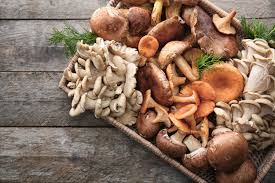
Mushrooms are the fleshy fruit bodies of numerous species of macrofungi (fungi that bear fruiting structures large enough to be seen with the naked eye). Edibility may be defined by criteria including
Mushrooms are the fleshy fruit bodies of numerous species of macrofungi (fungi that bear fruiting structures large enough to be seen with the naked eye). Edibility may be defined by criteria including the absence of poisonous effects on humans and desirable taste and aroma.
Some popular types of mushrooms include:
1. Button mushrooms
2. Crimini mushrooms
3. Portobello mushrooms
4. Shiitake mushrooms
5. Oyster mushrooms
Mushrooms are a nutritious and delicious addition to many meals. They're a good source of:
1. Nutritional Value
Mushrooms are a nutrient-rich food that provides:
- Protein: Mushrooms are a good source of protein, making them an excellent option for vegetarians and vegans.
- Fiber: Mushrooms are high in dietary fiber, which can help promote digestive health and support healthy blood sugar levels.
- Vitamins and Minerals: Mushrooms are a rich source of various vitamins and minerals, including copper, selenium, potassium, and vitamin D.
- Antioxidants: Mushrooms contain a range of antioxidants, including polyphenols and glutathione, which can help protect cells from damage and reduce inflammation.
Health benefits-
1. Immune System Support
Mushrooms have been found to have immunomodulatory effects, meaning they can help support the immune system:
- Beta-Glucans: Mushrooms contain beta-glucans, which can stimulate the immune system and increase its response to infection.
- Polysaccharides: Mushrooms contain polysaccharides, which can help activate immune cells and increase their ability to fight off infection.
2. Cancer Prevention
Some mushrooms have been found to have antitumor properties, which can help reduce the risk of cancer.
3. Cardiovascular Health
Mushrooms have been found to have a range of cardiovascular benefits:
- Cholesterol-Lowering Effects: Some mushrooms, such as the Shiitake mushroom, have been found to have cholesterol-lowering effects.
- Blood Pressure Reduction: Some mushrooms, such as the Reishi mushroom, have been found to have blood pressure-reducing effects.
4. Neuroprotective Effects
Some mushrooms have been found to have neuroprotective effects, which can help reduce the risk of neurodegenerative diseases.
5. Anti-Inflammatory Effects
Mushrooms have been found to have anti-inflammatory effects, which can help reduce the risk of chronic diseases:
- Polysaccharides: Mushrooms contain polysaccharides, which can help reduce inflammation and improve immune function.
- Polyphenols: Mushrooms contain polyphenols, which can help reduce inflammation and improve antioxidant function.
6. Digestive Health
Mushrooms have been found to have prebiotic effects, which can help support digestive health:
- Prebiotic Fiber: Mushrooms contain prebiotic fiber, which can help feed beneficial gut bacteria and support digestive health.
- Antimicrobial Effects: Some mushrooms, such as the Shiitake mushroom, have been found to have antimicrobial effects, which can help reduce the risk of
digestive infections.
Some popular types of mushrooms include:
1. Button mushrooms
2. Crimini mushrooms
3. Portobello mushrooms
4. Shiitake mushrooms
5. Oyster mushrooms
Mushrooms are a nutritious and delicious addition to many meals. They're a good source of:
1. Nutritional Value
Mushrooms are a nutrient-rich food that provides:
- Protein: Mushrooms are a good source of protein, making them an excellent option for vegetarians and vegans.
- Fiber: Mushrooms are high in dietary fiber, which can help promote digestive health and support healthy blood sugar levels.
- Vitamins and Minerals: Mushrooms are a rich source of various vitamins and minerals, including copper, selenium, potassium, and vitamin D.
- Antioxidants: Mushrooms contain a range of antioxidants, including polyphenols and glutathione, which can help protect cells from damage and reduce inflammation.
Health benefits-
1. Immune System Support
Mushrooms have been found to have immunomodulatory effects, meaning they can help support the immune system:
- Beta-Glucans: Mushrooms contain beta-glucans, which can stimulate the immune system and increase its response to infection.
- Polysaccharides: Mushrooms contain polysaccharides, which can help activate immune cells and increase their ability to fight off infection.
2. Cancer Prevention
Some mushrooms have been found to have antitumor properties, which can help reduce the risk of cancer.
3. Cardiovascular Health
Mushrooms have been found to have a range of cardiovascular benefits:
- Cholesterol-Lowering Effects: Some mushrooms, such as the Shiitake mushroom, have been found to have cholesterol-lowering effects.
- Blood Pressure Reduction: Some mushrooms, such as the Reishi mushroom, have been found to have blood pressure-reducing effects.
4. Neuroprotective Effects
Some mushrooms have been found to have neuroprotective effects, which can help reduce the risk of neurodegenerative diseases.
5. Anti-Inflammatory Effects
Mushrooms have been found to have anti-inflammatory effects, which can help reduce the risk of chronic diseases:
- Polysaccharides: Mushrooms contain polysaccharides, which can help reduce inflammation and improve immune function.
- Polyphenols: Mushrooms contain polyphenols, which can help reduce inflammation and improve antioxidant function.
6. Digestive Health
Mushrooms have been found to have prebiotic effects, which can help support digestive health:
- Prebiotic Fiber: Mushrooms contain prebiotic fiber, which can help feed beneficial gut bacteria and support digestive health.
- Antimicrobial Effects: Some mushrooms, such as the Shiitake mushroom, have been found to have antimicrobial effects, which can help reduce the risk of
digestive infections.
Salmonella
.jpg)
Salmonella is a genus of rod-shaped, (bacillus) Gram-negative bacteria of the family Enterobacteriaceae. The two known species of Salmonella are Salmonella enterica and Salmonella bongori.
Causes-
Causes-
Salmonella is a genus of rod-shaped, (bacillus) Gram-negative bacteria of the family Enterobacteriaceae. The two known species of Salmonella are Salmonella enterica and Salmonella bongori.
Causes-
1. Raw meat, poultry and seafood. Feces may get onto raw meat and poultry during the butchering process. Seafood may be contaminated if harvested from
contaminated water.
2. Raw or undercooked eggs. While an egg's shell may seem to be a perfect barrier to contamination, some infected chickens produce eggs that contain
salmonella before the shell is even formed. Raw eggs are used in homemade versions of foods such as mayonnaise and hollandaise sauce.
3. Unpasteurized dairy products. Unpasteurized milk and milk products — sometimes called raw milk — may be contaminated with salmonella. The
pasteurization process kills harmful bacteria, including salmonella.
4. Fruits and vegetables. Some fresh produce, particularly imported varieties, may be irrigated in the field or washed during processing with water contaminated
with salmonella. Contamination can also occur in the kitchen, when juices from raw meat and poultry come into contact with uncooked foods, such as salads.
Improperly handled food
5. Many foods become contaminated when prepared by people who don't wash their hands thoroughly after using the toilet or changing a diaper or after
handling contaminated food.
6. Infected surfaces- Infection can also occur if people touch something that is contaminated and then put their fingers in their mouths.
7. Infected pets and other animals- Animals and pets, especially birds and reptiles, may carry salmonella bacteria on their feathers, fur or skin or in their feces.
Some pet foods may be contaminated with salmonella and can infect animals.
Symptoms-
Possible signs and symptoms of salmonella infection include:
Diarrhea
Stomach (abdominal) cramps
Fever
Nausea
Vomiting
Chills
Headache
Blood in the stool
Dietary guidelines-
Foods to Include
1. Bananas: Bananas are easy to digest and can help replace potassium lost due to diarrhea.
2. Rice: Rice is easy to digest and can help firm up stool.
3. Applesauce: Applesauce is easy to digest and can help replace fiber lost due to diarrhea.
4. Toast: Toast is easy to digest and can help firm up stool.
5. Clear broths: Clear broths, such as chicken or vegetable broth, can help replace fluids and electrolytes lost due to diarrhea.
6. Electrolyte-rich beverages: Electrolyte-rich beverages, such as coconut water or sports drinks, can help replace fluids and electrolytes lost due to diarrhea.
Foods to Avoid
1. Raw or undercooked eggs: Avoid raw or undercooked eggs, as they can contain Salmonella bacteria.
2. Raw or undercooked poultry: Avoid raw or undercooked poultry, such as chicken or turkey, as they can also contain Salmonella bacteria.
3. Unpasteurized dairy products: Avoid unpasteurized dairy products, such as raw milk or soft cheeses, as they can contain Salmonella bacteria.
4. High-risk foods: Avoid high-risk foods, such as raw sprouts, unpasteurized juices, and raw or undercooked meat, poultry, or seafood.
Causes-
1. Raw meat, poultry and seafood. Feces may get onto raw meat and poultry during the butchering process. Seafood may be contaminated if harvested from
contaminated water.
2. Raw or undercooked eggs. While an egg's shell may seem to be a perfect barrier to contamination, some infected chickens produce eggs that contain
salmonella before the shell is even formed. Raw eggs are used in homemade versions of foods such as mayonnaise and hollandaise sauce.
3. Unpasteurized dairy products. Unpasteurized milk and milk products — sometimes called raw milk — may be contaminated with salmonella. The
pasteurization process kills harmful bacteria, including salmonella.
4. Fruits and vegetables. Some fresh produce, particularly imported varieties, may be irrigated in the field or washed during processing with water contaminated
with salmonella. Contamination can also occur in the kitchen, when juices from raw meat and poultry come into contact with uncooked foods, such as salads.
Improperly handled food
5. Many foods become contaminated when prepared by people who don't wash their hands thoroughly after using the toilet or changing a diaper or after
handling contaminated food.
6. Infected surfaces- Infection can also occur if people touch something that is contaminated and then put their fingers in their mouths.
7. Infected pets and other animals- Animals and pets, especially birds and reptiles, may carry salmonella bacteria on their feathers, fur or skin or in their feces.
Some pet foods may be contaminated with salmonella and can infect animals.
Symptoms-
Possible signs and symptoms of salmonella infection include:
Diarrhea
Stomach (abdominal) cramps
Fever
Nausea
Vomiting
Chills
Headache
Blood in the stool
Dietary guidelines-
Foods to Include
1. Bananas: Bananas are easy to digest and can help replace potassium lost due to diarrhea.
2. Rice: Rice is easy to digest and can help firm up stool.
3. Applesauce: Applesauce is easy to digest and can help replace fiber lost due to diarrhea.
4. Toast: Toast is easy to digest and can help firm up stool.
5. Clear broths: Clear broths, such as chicken or vegetable broth, can help replace fluids and electrolytes lost due to diarrhea.
6. Electrolyte-rich beverages: Electrolyte-rich beverages, such as coconut water or sports drinks, can help replace fluids and electrolytes lost due to diarrhea.
Foods to Avoid
1. Raw or undercooked eggs: Avoid raw or undercooked eggs, as they can contain Salmonella bacteria.
2. Raw or undercooked poultry: Avoid raw or undercooked poultry, such as chicken or turkey, as they can also contain Salmonella bacteria.
3. Unpasteurized dairy products: Avoid unpasteurized dairy products, such as raw milk or soft cheeses, as they can contain Salmonella bacteria.
4. High-risk foods: Avoid high-risk foods, such as raw sprouts, unpasteurized juices, and raw or undercooked meat, poultry, or seafood.
Stevens-Johnson syndrome (SJS)
What is Stevens-Johnson syndrome (SJS)?
Stevens-Johnson syndrome (SJS) and toxic epidermal necrolysis (TEN) are serious skin conditions that cause your skin to develop rashes, blisters, and then peel
Stevens-Johnson syndrome (SJS) and toxic epidermal necrolysis (TEN) are serious skin conditions that cause your skin to develop rashes, blisters, and then peel
What is Stevens-Johnson syndrome (SJS)?
Stevens-Johnson syndrome (SJS) and toxic epidermal necrolysis (TEN) are serious skin conditions that cause your skin to develop rashes, blisters, and then peel. Mucus membranes, including eyes, genitalia and mouth, are also affected.
Causes-
1. Medications: Certain medications, such as antibiotics (e.g., sulfonamides), anticonvulsants (e.g., carbamazepine), and nonsteroidal anti-inflammatory drugs (NSAIDs).
2. Infections: Bacterial or viral infections, such as pneumonia or HIV.
3. Genetic predisposition: Some people may be more susceptible to SJS due to genetic factors.
Symptoms-
1. Skin lesions: Painful blisters or lesions on the skin, often on the face, torso, and limbs.
2. Mucous membrane involvement: Lesions on the mucous membranes, such as the eyes, mouth, nose, and genital area.
3. Fever: High fever, often accompanied by chills.
4. Fatigue: Feeling weak and tired.
5. Eye problems: Eye pain, redness, and vision changes.
Dietary guidelines-
General Guidelines
1. Stay hydrated: Drink plenty of water and other fluids to help manage symptoms and support skin health.
2. Eat small, frequent meals: Divide your daily food intake into 5-6 small meals to help manage nausea and vomiting.
3. Choose soft, easy-to-swallow foods: Opt for foods that are gentle on the mouth, throat, and digestive tract, such as soups, pureed fruits and vegetables, and yogurt.
4. Avoid spicy, acidic, or sharp foods: Steer clear of foods that can irritate the skin and mucous membranes, such as citrus fruits, tomatoes, and spicy dishes.
Nutrient-Rich Foods
1. Protein-rich foods: Include foods high in protein, such as lean meats, fish, eggs, dairy products, and legumes, to support skin health and wound healing.
2. Omega-3 rich foods: Fatty fish, flaxseeds, and walnuts are rich in omega-3 fatty acids, which can help reduce inflammation.
3. Antioxidant-rich foods: Include foods high in antioxidants, such as berries, leafy greens, and other fruits and vegetables, to help protect the skin and mucous membranes from damage.
4. Whole grains: Choose whole grains, such as brown rice, quinoa, and whole-wheat bread, to provide fiber, vitamins, and minerals.
Foods to Avoid
1. Foods high in sugar: Limit foods high in added sugars, such as sweets, sugary drinks, and refined grains.
2. Foods high in salt: Restrict foods high in sodium, such as processed meats, canned goods, and restaurant meals.
3. Foods high in unhealthy fats: Limit foods high in saturated and trans fats, such as fried foods, processed meats, and full-fat dairy products.
Stevens-Johnson syndrome (SJS) and toxic epidermal necrolysis (TEN) are serious skin conditions that cause your skin to develop rashes, blisters, and then peel. Mucus membranes, including eyes, genitalia and mouth, are also affected.
Causes-
1. Medications: Certain medications, such as antibiotics (e.g., sulfonamides), anticonvulsants (e.g., carbamazepine), and nonsteroidal anti-inflammatory drugs (NSAIDs).
2. Infections: Bacterial or viral infections, such as pneumonia or HIV.
3. Genetic predisposition: Some people may be more susceptible to SJS due to genetic factors.
Symptoms-
1. Skin lesions: Painful blisters or lesions on the skin, often on the face, torso, and limbs.
2. Mucous membrane involvement: Lesions on the mucous membranes, such as the eyes, mouth, nose, and genital area.
3. Fever: High fever, often accompanied by chills.
4. Fatigue: Feeling weak and tired.
5. Eye problems: Eye pain, redness, and vision changes.
Dietary guidelines-
General Guidelines
1. Stay hydrated: Drink plenty of water and other fluids to help manage symptoms and support skin health.
2. Eat small, frequent meals: Divide your daily food intake into 5-6 small meals to help manage nausea and vomiting.
3. Choose soft, easy-to-swallow foods: Opt for foods that are gentle on the mouth, throat, and digestive tract, such as soups, pureed fruits and vegetables, and yogurt.
4. Avoid spicy, acidic, or sharp foods: Steer clear of foods that can irritate the skin and mucous membranes, such as citrus fruits, tomatoes, and spicy dishes.
Nutrient-Rich Foods
1. Protein-rich foods: Include foods high in protein, such as lean meats, fish, eggs, dairy products, and legumes, to support skin health and wound healing.
2. Omega-3 rich foods: Fatty fish, flaxseeds, and walnuts are rich in omega-3 fatty acids, which can help reduce inflammation.
3. Antioxidant-rich foods: Include foods high in antioxidants, such as berries, leafy greens, and other fruits and vegetables, to help protect the skin and mucous membranes from damage.
4. Whole grains: Choose whole grains, such as brown rice, quinoa, and whole-wheat bread, to provide fiber, vitamins, and minerals.
Foods to Avoid
1. Foods high in sugar: Limit foods high in added sugars, such as sweets, sugary drinks, and refined grains.
2. Foods high in salt: Restrict foods high in sodium, such as processed meats, canned goods, and restaurant meals.
3. Foods high in unhealthy fats: Limit foods high in saturated and trans fats, such as fried foods, processed meats, and full-fat dairy products.
Kawasaki disease
.jpg)
What is Kawasaki disease?
Kawasaki disease or Kawasaki syndrome is a rare type of vasculitis (blood vessel inflammation). Inflamed blood vessels can become weak and stretched out. When that happens,
Kawasaki disease or Kawasaki syndrome is a rare type of vasculitis (blood vessel inflammation). Inflamed blood vessels can become weak and stretched out. When that happens,
What is Kawasaki disease?
Kawasaki disease or Kawasaki syndrome is a rare type of vasculitis (blood vessel inflammation). Inflamed blood vessels can become weak and stretched out. When that happens, they’re at risk of tearing. They can also develop scarring and become too narrow. This limits how much blood can get through to nourish tissues and organs.Kawasaki disease happens most often in children 6 months to 5 years of age. It affects all of their arteries, but the biggest concern is their coronary arteries. These supply blood to their heart. Children with affected coronary arteries can have heart issues as a result.
Causes and Risk Factors
1. Unknown cause: The exact cause of Kawasaki disease is still unknown.
2. Genetic predisposition: Some children may be more susceptible to Kawasaki disease due to genetic factors.
3. Environmental factors: Exposure to certain environmental factors, such as viral infections, may trigger Kawasaki disease.
Symptoms
1. Fever: High fever that lasts for more than 5 days.
2. Rash: A rash that appears on the trunk, arms, and legs.
3. Swollen lymph nodes: Enlarged lymph nodes in the neck.
4. Red eyes: Conjunctivitis (redness and inflammation of the eyes).
5. Red lips and tongue: Inflammation of the lips and tongue.
6. Swollen hands and feet: Swelling and redness of the hands and feet.
Dietary Guidelines-
1. Fruits: Offer fruits rich in antioxidants, such as berries, citrus fruits, and apples.
2. Vegetables: Serve vegetables rich in antioxidants, such as leafy greens, broccoli, and bell peppers.
3. Whole grains: Choose whole grains, such as brown rice, quinoa, and whole-wheat bread, to provide fiber and essential nutrients.
4. Lean protein sources: Include lean protein sources, such as chicken, fish, and tofu, to support immune function and overall health.
Foods to Avoid
1. Processed meats: Limit processed meats, such as hot dogs, sausages, and bacon, which are high in sodium and preservatives.
2. Foods high in added sugars: Restrict foods high in added sugars, such as sugary drinks, candy, and baked goods.
3. Foods high in saturated and trans fats: Limit foods high in saturated and trans fats, such as fried foods, processed snacks, and full-fat dairy products.
Kawasaki disease or Kawasaki syndrome is a rare type of vasculitis (blood vessel inflammation). Inflamed blood vessels can become weak and stretched out. When that happens, they’re at risk of tearing. They can also develop scarring and become too narrow. This limits how much blood can get through to nourish tissues and organs.Kawasaki disease happens most often in children 6 months to 5 years of age. It affects all of their arteries, but the biggest concern is their coronary arteries. These supply blood to their heart. Children with affected coronary arteries can have heart issues as a result.
Causes and Risk Factors
1. Unknown cause: The exact cause of Kawasaki disease is still unknown.
2. Genetic predisposition: Some children may be more susceptible to Kawasaki disease due to genetic factors.
3. Environmental factors: Exposure to certain environmental factors, such as viral infections, may trigger Kawasaki disease.
Symptoms
1. Fever: High fever that lasts for more than 5 days.
2. Rash: A rash that appears on the trunk, arms, and legs.
3. Swollen lymph nodes: Enlarged lymph nodes in the neck.
4. Red eyes: Conjunctivitis (redness and inflammation of the eyes).
5. Red lips and tongue: Inflammation of the lips and tongue.
6. Swollen hands and feet: Swelling and redness of the hands and feet.
Dietary Guidelines-
1. Fruits: Offer fruits rich in antioxidants, such as berries, citrus fruits, and apples.
2. Vegetables: Serve vegetables rich in antioxidants, such as leafy greens, broccoli, and bell peppers.
3. Whole grains: Choose whole grains, such as brown rice, quinoa, and whole-wheat bread, to provide fiber and essential nutrients.
4. Lean protein sources: Include lean protein sources, such as chicken, fish, and tofu, to support immune function and overall health.
Foods to Avoid
1. Processed meats: Limit processed meats, such as hot dogs, sausages, and bacon, which are high in sodium and preservatives.
2. Foods high in added sugars: Restrict foods high in added sugars, such as sugary drinks, candy, and baked goods.
3. Foods high in saturated and trans fats: Limit foods high in saturated and trans fats, such as fried foods, processed snacks, and full-fat dairy products.
Influenza
.jpg)
What is the flu (influenza)?
The flu is an illness you get from the influenza virus. It causes symptoms like head and body aches, sore throat, fever and respiratory symptoms, which can be severe. Flu
The flu is an illness you get from the influenza virus. It causes symptoms like head and body aches, sore throat, fever and respiratory symptoms, which can be severe. Flu
What is the flu (influenza)?
The flu is an illness you get from the influenza virus. It causes symptoms like head and body aches, sore throat, fever and respiratory symptoms, which can be severe. Flu is most common in winter months, when many people can get sick at once (an epidemic).
Types of Influenza
1. Influenza A: This type of flu virus can infect animals, but some strains can also infect humans.
2. Influenza B: This type of flu virus primarily infects humans.
3. Influenza C: This type of flu virus is relatively mild and typically affects children.
Symptoms
1. Fever: High temperature, usually over 102°F (39°C).
2. Chills: Feeling cold, even if your body temperature is normal.
3. Cough: Dry, hacking cough or a productive cough that brings up mucus.
4. Sore throat: Pain or discomfort in the throat.
5. Runny or stuffy nose: Nasal congestion or a runny nose.
6. Headache: A headache can be severe.
7. Fatigue: Feeling extremely tired or weak.
8. Muscle or body aches: Pain or discomfort in the muscles, back, arms, and legs.
9. Diarrhea and vomiting: More common in children than adults.
Dietary Guidelines-
General Guidelines-
1. Stay hydrated: Drink plenty of fluids, such as water, clear broths, and electrolyte-rich beverages like coconut water or sports drinks.
2. Opt for bland foods: Choose bland foods that are easy to digest, such as crackers, toast, plain rice, bananas, and applesauce.
3. Avoid spicy or fatty foods: Steer clear of spicy or fatty foods that can irritate the stomach and worsen nausea and vomiting.
4. Eat small, frequent meals: Divide your daily food intake into 5-6 small meals to help manage nausea and vomiting.
Nutrient-Rich Foods
1. Garlic: Garlic has antimicrobial properties that can help fight off the flu virus.
2. Ginger: Ginger has anti-inflammatory properties that can help alleviate nausea and vomiting.
3. Citrus fruits: Oranges, grapefruits, and lemons are high in vitamin C, which can help boost the immune system.
4. Sweet potatoes: Sweet potatoes are rich in vitamin A, which can help boost the immune system.
Foods to Avoid
1. Caffeine: Avoid caffeine, as it can dehydrate the body and worsen flu symptoms.
2. Alcohol: Avoid alcohol, as it can weaken the immune system and worsen flu symptoms.
3. Processed meats: Avoid processed meats, such as hot dogs and sausages, which are high in sodium and preservatives.
4. Foods high in added sugars: Avoid foods high in added sugars, such as sugary drinks and baked goods.
The flu is an illness you get from the influenza virus. It causes symptoms like head and body aches, sore throat, fever and respiratory symptoms, which can be severe. Flu is most common in winter months, when many people can get sick at once (an epidemic).
Types of Influenza
1. Influenza A: This type of flu virus can infect animals, but some strains can also infect humans.
2. Influenza B: This type of flu virus primarily infects humans.
3. Influenza C: This type of flu virus is relatively mild and typically affects children.
Symptoms
1. Fever: High temperature, usually over 102°F (39°C).
2. Chills: Feeling cold, even if your body temperature is normal.
3. Cough: Dry, hacking cough or a productive cough that brings up mucus.
4. Sore throat: Pain or discomfort in the throat.
5. Runny or stuffy nose: Nasal congestion or a runny nose.
6. Headache: A headache can be severe.
7. Fatigue: Feeling extremely tired or weak.
8. Muscle or body aches: Pain or discomfort in the muscles, back, arms, and legs.
9. Diarrhea and vomiting: More common in children than adults.
Dietary Guidelines-
General Guidelines-
1. Stay hydrated: Drink plenty of fluids, such as water, clear broths, and electrolyte-rich beverages like coconut water or sports drinks.
2. Opt for bland foods: Choose bland foods that are easy to digest, such as crackers, toast, plain rice, bananas, and applesauce.
3. Avoid spicy or fatty foods: Steer clear of spicy or fatty foods that can irritate the stomach and worsen nausea and vomiting.
4. Eat small, frequent meals: Divide your daily food intake into 5-6 small meals to help manage nausea and vomiting.
Nutrient-Rich Foods
1. Garlic: Garlic has antimicrobial properties that can help fight off the flu virus.
2. Ginger: Ginger has anti-inflammatory properties that can help alleviate nausea and vomiting.
3. Citrus fruits: Oranges, grapefruits, and lemons are high in vitamin C, which can help boost the immune system.
4. Sweet potatoes: Sweet potatoes are rich in vitamin A, which can help boost the immune system.
Foods to Avoid
1. Caffeine: Avoid caffeine, as it can dehydrate the body and worsen flu symptoms.
2. Alcohol: Avoid alcohol, as it can weaken the immune system and worsen flu symptoms.
3. Processed meats: Avoid processed meats, such as hot dogs and sausages, which are high in sodium and preservatives.
4. Foods high in added sugars: Avoid foods high in added sugars, such as sugary drinks and baked goods.
Japanese encephalitis (JE)
.jpg)
Japanese encephalitis (JE) is an infection of the brain caused by the Japanese encephalitis virus (JEV).While most infections result in little or no symptoms, occasional inflammation of the brain occu
Japanese encephalitis (JE) is an infection of the brain caused by the Japanese encephalitis virus (JEV).While most infections result in little or no symptoms, occasional inflammation of the brain occurs.In these cases, symptoms may include headache, vomiting, fever, confusion and seizures.
Transmission
1. Mosquito vector: JE is transmitted through the bite of an infected mosquito, typically the Culex tritaeniorhynchus mosquito.
2. Animal hosts: Pigs and birds are the primary animal hosts of the virus. Mosquitoes become infected when they feed on the blood of these animals.
3. Human infection: Humans become infected when an infected mosquito bites them.
Symptoms
1. Mild symptoms: Most people infected with JE will experience mild symptoms, such as fever, headache, and fatigue.
2. Severe symptoms: In severe cases, JE can cause:
- Encephalitis: Inflammation of the brain, leading to symptoms such as seizures, confusion, and coma.
- Meningitis: Inflammation of the membranes surrounding the brain and spinal cord.
- Acute flaccid paralysis: Weakness or paralysis of the arms and legs.
Dietary Guidelines-
Nutrient-Rich Foods
1. Fruits: Focus on fruits that are easy to digest, such as bananas, applesauce, and avocados.
2. Vegetables: Opt for cooked vegetables that are easy to digest, such as carrots, green beans, and peas.
3. Protein sources: Choose lean protein sources Pulses, tofu.
4. Whole grains: Include whole grains, such as brown rice, quinoa, and whole-wheat bread.
Foods to Avoid
1. Caffeine: Avoid caffeine, as it can dehydrate the body and worsen symptoms.
2. Alcohol: Avoid alcohol, as it can weaken the immune system and worsen symptoms.
3. Foods high in added sugars: Avoid foods high in added sugars, such as sugary drinks and baked goods.
Transmission
1. Mosquito vector: JE is transmitted through the bite of an infected mosquito, typically the Culex tritaeniorhynchus mosquito.
2. Animal hosts: Pigs and birds are the primary animal hosts of the virus. Mosquitoes become infected when they feed on the blood of these animals.
3. Human infection: Humans become infected when an infected mosquito bites them.
Symptoms
1. Mild symptoms: Most people infected with JE will experience mild symptoms, such as fever, headache, and fatigue.
2. Severe symptoms: In severe cases, JE can cause:
- Encephalitis: Inflammation of the brain, leading to symptoms such as seizures, confusion, and coma.
- Meningitis: Inflammation of the membranes surrounding the brain and spinal cord.
- Acute flaccid paralysis: Weakness or paralysis of the arms and legs.
Dietary Guidelines-
Nutrient-Rich Foods
1. Fruits: Focus on fruits that are easy to digest, such as bananas, applesauce, and avocados.
2. Vegetables: Opt for cooked vegetables that are easy to digest, such as carrots, green beans, and peas.
3. Protein sources: Choose lean protein sources Pulses, tofu.
4. Whole grains: Include whole grains, such as brown rice, quinoa, and whole-wheat bread.
Foods to Avoid
1. Caffeine: Avoid caffeine, as it can dehydrate the body and worsen symptoms.
2. Alcohol: Avoid alcohol, as it can weaken the immune system and worsen symptoms.
3. Foods high in added sugars: Avoid foods high in added sugars, such as sugary drinks and baked goods.
Diphtheria
.jpg)
What is diphtheria?
Diphtheria is a contagious infection caused by a bacterium called Corynebacterium diphtheriae. The bacterium releases a toxin that causes a buildup of grey tissue in your throat,
Diphtheria is a contagious infection caused by a bacterium called Corynebacterium diphtheriae. The bacterium releases a toxin that causes a buildup of grey tissue in your throat,
What is diphtheria?
Diphtheria is a contagious infection caused by a bacterium called Corynebacterium diphtheriae. The bacterium releases a toxin that causes a buildup of grey tissue in your throat, leading to problems with swallowing and breathing.In warmer climates, someone with diphtheria might also develop skin sores that will not heal and may be covered with the grey tissue. This type of diphtheria (called cutaneous diphtheria) also happens sometimes in the U.S. when people live in crowded and unhealthy conditions.
What causes diphtheria?
Diphtheria is caused by bacteria adhering to the lining of your respiratory system. These bacteria generate a toxin that damages your respiratory tissue cells. Within two or three days, the tissue left behind forms a bulky, grey coating. This coating has the potential to cover tissues in your voice box, throat, nose and tonsils. For the infected person, breathing and swallowing become hard to do.
Symptoms-
Common diphtheria symptoms include:
Throat pain.
Weakness or fatigue.
Fever.
Swollen neck glands.
Problems breathing due to tissues obstructing your nose and throat.
Difficulty swallowing (dysphagia).
Nerve, kidney or heart problems (if the bacteria enters your bloodstream).
Dietary Guidelines-
1. Fruits: Focus on fruits that are easy to digest, such as bananas, applesauce, and avocados.
2. Vegetables: Opt for cooked vegetables that are easy to digest, such as carrots, green beans, and peas.
3. Protein sources: Choose lean protein sources pulses and tofu.
4. Whole grains: Include whole grains, such as brown rice, quinoa, and whole-wheat bread.
Foods to Avoid
1. Caffeine: Avoid caffeine, as it can dehydrate the body and worsen symptoms.
2. Alcohol: Avoid alcohol, as it can weaken the immune system and worsen symptoms.
3. Processed meats: Limit processed meats, such as hot dogs and sausages, which are high in sodium and preservatives.
4. Foods high in added sugars: Avoid foods high in added sugars, such as sugary drinks and baked goods.
Diphtheria is a contagious infection caused by a bacterium called Corynebacterium diphtheriae. The bacterium releases a toxin that causes a buildup of grey tissue in your throat, leading to problems with swallowing and breathing.In warmer climates, someone with diphtheria might also develop skin sores that will not heal and may be covered with the grey tissue. This type of diphtheria (called cutaneous diphtheria) also happens sometimes in the U.S. when people live in crowded and unhealthy conditions.
What causes diphtheria?
Diphtheria is caused by bacteria adhering to the lining of your respiratory system. These bacteria generate a toxin that damages your respiratory tissue cells. Within two or three days, the tissue left behind forms a bulky, grey coating. This coating has the potential to cover tissues in your voice box, throat, nose and tonsils. For the infected person, breathing and swallowing become hard to do.
Symptoms-
Common diphtheria symptoms include:
Throat pain.
Weakness or fatigue.
Fever.
Swollen neck glands.
Problems breathing due to tissues obstructing your nose and throat.
Difficulty swallowing (dysphagia).
Nerve, kidney or heart problems (if the bacteria enters your bloodstream).
Dietary Guidelines-
1. Fruits: Focus on fruits that are easy to digest, such as bananas, applesauce, and avocados.
2. Vegetables: Opt for cooked vegetables that are easy to digest, such as carrots, green beans, and peas.
3. Protein sources: Choose lean protein sources pulses and tofu.
4. Whole grains: Include whole grains, such as brown rice, quinoa, and whole-wheat bread.
Foods to Avoid
1. Caffeine: Avoid caffeine, as it can dehydrate the body and worsen symptoms.
2. Alcohol: Avoid alcohol, as it can weaken the immune system and worsen symptoms.
3. Processed meats: Limit processed meats, such as hot dogs and sausages, which are high in sodium and preservatives.
4. Foods high in added sugars: Avoid foods high in added sugars, such as sugary drinks and baked goods.
Leprosy
.jpg)
What is leprosy?
Leprosy (also called Hansen’s disease) is an infectious disease caused by the bacteria Mycobacterium leprae. It can affect your eyes, skin, mucous membranes and nerves, causing dis
Leprosy (also called Hansen’s disease) is an infectious disease caused by the bacteria Mycobacterium leprae. It can affect your eyes, skin, mucous membranes and nerves, causing dis
What is leprosy?
Leprosy (also called Hansen’s disease) is an infectious disease caused by the bacteria Mycobacterium leprae. It can affect your eyes, skin, mucous membranes and nerves, causing disfiguring sores and nerve damage.
What are the three types of leprosy?
There are three main types of leprosy, including:
1. Tuberculoid leprosy. Someone with this type of leprosy usually has mild symptoms, developing only a few sores. This is because of a good immune response.
Tuberculoid leprosy is also called paucibacillary leprosy.
2. Lepromatous leprosy. People with this type of leprosy have widespread sores and lesions affecting nerves, skin and organs. With lepromatous leprosy, the
immune response is poor and the disease is more contagious. Lepromatous leprosy is also called multibacillary leprosy.
3. Borderline leprosy. This type of leprosy involves symptoms of both tuberculoid and lepromatous leprosy. Borderline leprosy is also called dimorphus
leprosy.
Symptoms-
Symptoms
1. Skin lesions: Leprosy causes skin lesions, which can be pale, pink, or red, and can appear anywhere on the body.
2. Numbness and tingling: Numbness and tingling sensations can occur in the affected areas.
3. Muscle weakness: Muscle weakness can occur, especially in the hands and feet.
4. Eye problems: Leprosy can cause eye problems, including dryness, ulcers, and vision loss.
5. Nerve damage: Leprosy can cause nerve damage, leading to loss of sensation and muscle weakness.
Dietary Guidelines-
Nutrient-Rich Foods
1. Vitamin C-rich foods: Include vitamin C-rich foods, such as citrus fruits, strawberries, and bell peppers, to support immune function.
2. Vitamin E-rich foods: Eat vitamin E-rich foods, such as nuts, seeds, and vegetable oils, to support skin health.
3. Omega-3 fatty acid-rich foods: Include omega-3 fatty acid-rich foods, such as fatty fish, flaxseeds, and chia seeds, to support heart health and reduce inflammation.
4. Probiotic-rich foods: Eat probiotic-rich foods, such as yogurt, kefir, and fermented vegetables, to support gut health.
Foods to Avoid
1. Processed meats: Limit processed meats, such as hot dogs and sausages, which are high in sodium and preservatives.
2. Sugary drinks: Avoid sugary drinks, such as soda and sports drinks, which can exacerbate inflammation.
3. Refined carbohydrates: Limit refined carbohydrates, such as white bread and sugary snacks, which can cause a spike in blood sugar levels.
4. Foods high in saturated and trans fats: Avoid foods high in saturated and trans fats, such as red meat and processed snacks, which can increase inflammation.
Leprosy (also called Hansen’s disease) is an infectious disease caused by the bacteria Mycobacterium leprae. It can affect your eyes, skin, mucous membranes and nerves, causing disfiguring sores and nerve damage.
What are the three types of leprosy?
There are three main types of leprosy, including:
1. Tuberculoid leprosy. Someone with this type of leprosy usually has mild symptoms, developing only a few sores. This is because of a good immune response.
Tuberculoid leprosy is also called paucibacillary leprosy.
2. Lepromatous leprosy. People with this type of leprosy have widespread sores and lesions affecting nerves, skin and organs. With lepromatous leprosy, the
immune response is poor and the disease is more contagious. Lepromatous leprosy is also called multibacillary leprosy.
3. Borderline leprosy. This type of leprosy involves symptoms of both tuberculoid and lepromatous leprosy. Borderline leprosy is also called dimorphus
leprosy.
Symptoms-
Symptoms
1. Skin lesions: Leprosy causes skin lesions, which can be pale, pink, or red, and can appear anywhere on the body.
2. Numbness and tingling: Numbness and tingling sensations can occur in the affected areas.
3. Muscle weakness: Muscle weakness can occur, especially in the hands and feet.
4. Eye problems: Leprosy can cause eye problems, including dryness, ulcers, and vision loss.
5. Nerve damage: Leprosy can cause nerve damage, leading to loss of sensation and muscle weakness.
Dietary Guidelines-
Nutrient-Rich Foods
1. Vitamin C-rich foods: Include vitamin C-rich foods, such as citrus fruits, strawberries, and bell peppers, to support immune function.
2. Vitamin E-rich foods: Eat vitamin E-rich foods, such as nuts, seeds, and vegetable oils, to support skin health.
3. Omega-3 fatty acid-rich foods: Include omega-3 fatty acid-rich foods, such as fatty fish, flaxseeds, and chia seeds, to support heart health and reduce inflammation.
4. Probiotic-rich foods: Eat probiotic-rich foods, such as yogurt, kefir, and fermented vegetables, to support gut health.
Foods to Avoid
1. Processed meats: Limit processed meats, such as hot dogs and sausages, which are high in sodium and preservatives.
2. Sugary drinks: Avoid sugary drinks, such as soda and sports drinks, which can exacerbate inflammation.
3. Refined carbohydrates: Limit refined carbohydrates, such as white bread and sugary snacks, which can cause a spike in blood sugar levels.
4. Foods high in saturated and trans fats: Avoid foods high in saturated and trans fats, such as red meat and processed snacks, which can increase inflammation.
Pneumonia
.jpg)
Pneumonia is an infection that inflames the air sacs in one or both lungs. The air sacs may fill with fluid or pus (purulent material), causing cough with phlegm or pus, fever, chills, and difficulty
Pneumonia is an infection that inflames the air sacs in one or both lungs. The air sacs may fill with fluid or pus (purulent material), causing cough with phlegm or pus, fever, chills, and difficulty breathing. A variety of organisms, including bacteria, viruses and fungi, can cause pneumonia.
Causes
1. Bacteria: Streptococcus pneumoniae, Haemophilus influenzae, and Klebsiella pneumoniae are common bacterial causes.
2. Viruses: Influenza, respiratory syncytial virus (RSV), and adenovirus can cause pneumonia.
3. Fungi: Pneumocystis jirovecii can cause pneumonia in people with weakened immune systems.
Symptoms
1. Cough: A cough that produces phlegm or pus.
2. Fever: A high temperature, usually above 102°F (39°C).
3. Chills: Feeling cold, even if your body temperature is normal.
4. Shortness of breath: Difficulty breathing or feeling winded even when sitting still.
5. Chest pain: Sharp or stabbing pain in the chest, especially when coughing or taking deep breaths.
Dietary guidelines-
Nutrient-Rich Foods
1. Protein-rich foods: Include protein-rich foods like dairy products, legumes, and nuts to help support immune function.
2. Vitamin C-rich foods: Consume vitamin C-rich foods like citrus fruits, strawberries, and bell peppers to support immune function.
3. Zinc-rich foods: Include zinc-rich foods like oysters, beef, chicken, and fortified cereals to support immune function.
4. Omega-3 fatty acid-rich foods: Eat omega-3 fatty acid-rich foods like fatty fish, flaxseeds, and chia seeds to support heart health and reduce inflammation.
Foods to Avoid
1. Dairy products: Avoid dairy products if you're experiencing congestion or mucus production.
2. Processed meats: Limit processed meats like hot dogs and sausages, which are high in sodium and preservatives.
3. Foods high in added sugars: Avoid foods high in added sugars like sugary drinks, baked goods, and candy.
Causes
1. Bacteria: Streptococcus pneumoniae, Haemophilus influenzae, and Klebsiella pneumoniae are common bacterial causes.
2. Viruses: Influenza, respiratory syncytial virus (RSV), and adenovirus can cause pneumonia.
3. Fungi: Pneumocystis jirovecii can cause pneumonia in people with weakened immune systems.
Symptoms
1. Cough: A cough that produces phlegm or pus.
2. Fever: A high temperature, usually above 102°F (39°C).
3. Chills: Feeling cold, even if your body temperature is normal.
4. Shortness of breath: Difficulty breathing or feeling winded even when sitting still.
5. Chest pain: Sharp or stabbing pain in the chest, especially when coughing or taking deep breaths.
Dietary guidelines-
Nutrient-Rich Foods
1. Protein-rich foods: Include protein-rich foods like dairy products, legumes, and nuts to help support immune function.
2. Vitamin C-rich foods: Consume vitamin C-rich foods like citrus fruits, strawberries, and bell peppers to support immune function.
3. Zinc-rich foods: Include zinc-rich foods like oysters, beef, chicken, and fortified cereals to support immune function.
4. Omega-3 fatty acid-rich foods: Eat omega-3 fatty acid-rich foods like fatty fish, flaxseeds, and chia seeds to support heart health and reduce inflammation.
Foods to Avoid
1. Dairy products: Avoid dairy products if you're experiencing congestion or mucus production.
2. Processed meats: Limit processed meats like hot dogs and sausages, which are high in sodium and preservatives.
3. Foods high in added sugars: Avoid foods high in added sugars like sugary drinks, baked goods, and candy.
Tuberculosis (TB)
.jpg)
Tuberculosis (TB) is a bacterial infection caused by Mycobacterium tuberculosis that primarily affects the lungs, but can also affect other parts of the body.
Symptoms
1. Coughing: A persistent coug
Symptoms
1. Coughing: A persistent coug
Tuberculosis (TB) is a bacterial infection caused by Mycobacterium tuberculosis that primarily affects the lungs, but can also affect other parts of the body.
Symptoms
1. Coughing: A persistent cough that lasts for more than two weeks.
2. Chest pain: Chest pain that worsens when coughing or taking deep breaths.
3. Coughing up blood: Coughing up blood or rust-colored sputum.
4. Fatigue: Feeling tired or weak.
5. Weight loss: Unexplained weight loss.
6. Night sweats: Recurring night sweats.
7. Chills: Feeling cold, even in mild weather.
8. Loss of appetite: Loss of appetite.
Causes
1. Bacterial infection: TB is caused by the bacterium Mycobacterium tuberculosis.
2. Airborne transmission: TB is spread through the air when an infected person coughs, sneezes, or talks.
3. Close contact: Close contact with someone who has TB can increase the risk of infection.
Dietary Guidelines-
General Guidelines
1. High-calorie diet: Consume a high-calorie diet to help support weight gain and recovery.
2. Protein-rich foods: Include protein-rich foods like lean meats, fish, eggs, dairy products, legumes, and nuts to help support immune function.
3. Fresh fruits and vegetables: Consume fresh fruits and vegetables to provide essential vitamins, minerals, and antioxidants.
4. Whole grains: Choose whole grains like brown rice, quinoa, and whole-wheat bread to provide fiber, vitamins, and minerals.
Nutrient-Rich Foods
1. Vitamin C-rich foods: Consume vitamin C-rich foods like citrus fruits, strawberries, and bell peppers to support immune function.
2. Vitamin D-rich foods: Include vitamin D-rich foods like fatty fish, fortified dairy products, and mushrooms to support immune function.
3. Iron-rich foods: Consume iron-rich foods like lean meats, spinach, and fortified cereals to support healthy red blood cells.
4. Zinc-rich foods: Include zinc-rich foods like oysters, beef, chicken, and fortified cereals to support immune function.
Foods to Avoid
1. High-sugar foods: Limit high-sugar foods like sugary drinks, baked goods, and candy.
2. High-sodium foods: Limit high-sodium foods like processed meats, canned goods, and restaurant foods.
3. Foods high in saturated and trans fats: Limit foods high in saturated and trans fats like red meat, full-fat dairy products, and processed snacks.
Symptoms
1. Coughing: A persistent cough that lasts for more than two weeks.
2. Chest pain: Chest pain that worsens when coughing or taking deep breaths.
3. Coughing up blood: Coughing up blood or rust-colored sputum.
4. Fatigue: Feeling tired or weak.
5. Weight loss: Unexplained weight loss.
6. Night sweats: Recurring night sweats.
7. Chills: Feeling cold, even in mild weather.
8. Loss of appetite: Loss of appetite.
Causes
1. Bacterial infection: TB is caused by the bacterium Mycobacterium tuberculosis.
2. Airborne transmission: TB is spread through the air when an infected person coughs, sneezes, or talks.
3. Close contact: Close contact with someone who has TB can increase the risk of infection.
Dietary Guidelines-
General Guidelines
1. High-calorie diet: Consume a high-calorie diet to help support weight gain and recovery.
2. Protein-rich foods: Include protein-rich foods like lean meats, fish, eggs, dairy products, legumes, and nuts to help support immune function.
3. Fresh fruits and vegetables: Consume fresh fruits and vegetables to provide essential vitamins, minerals, and antioxidants.
4. Whole grains: Choose whole grains like brown rice, quinoa, and whole-wheat bread to provide fiber, vitamins, and minerals.
Nutrient-Rich Foods
1. Vitamin C-rich foods: Consume vitamin C-rich foods like citrus fruits, strawberries, and bell peppers to support immune function.
2. Vitamin D-rich foods: Include vitamin D-rich foods like fatty fish, fortified dairy products, and mushrooms to support immune function.
3. Iron-rich foods: Consume iron-rich foods like lean meats, spinach, and fortified cereals to support healthy red blood cells.
4. Zinc-rich foods: Include zinc-rich foods like oysters, beef, chicken, and fortified cereals to support immune function.
Foods to Avoid
1. High-sugar foods: Limit high-sugar foods like sugary drinks, baked goods, and candy.
2. High-sodium foods: Limit high-sodium foods like processed meats, canned goods, and restaurant foods.
3. Foods high in saturated and trans fats: Limit foods high in saturated and trans fats like red meat, full-fat dairy products, and processed snacks.
Cholera
.jpg)
Cholera is a highly infectious bacterial disease caused by Vibrio cholerae, which affects the small intestine.
Symptoms
1. Diarrhea: Cholera is characterized by sudden and severe diarrhea, often d
Symptoms
1. Diarrhea: Cholera is characterized by sudden and severe diarrhea, often d
Cholera is a highly infectious bacterial disease caused by Vibrio cholerae, which affects the small intestine.
Symptoms
1. Diarrhea: Cholera is characterized by sudden and severe diarrhea, often described as "rice-water stool."
2. Vomiting: Vomiting is common, which can lead to dehydration.
3. Dehydration: Severe dehydration can occur, leading to shock, organ failure, and even death.
4. Abdominal cramps: Abdominal cramps and bloating may occur.
Causes
1. Contaminated food and water: Cholera is usually spread through contaminated food and water.
2. Poor sanitation: Poor sanitation and hygiene practices can contribute to the spread of cholera.
3. Close contact: Close contact with an infected person can also spread the disease.
Dietary Guidelines-
Nutrient-Rich Foods
1. Protein-rich foods: Include protein-rich foods like lean meats, fish, eggs, dairy products, legumes, and nuts to help support immune function.
2. Vitamin C-rich foods: Consume vitamin C-rich foods like citrus fruits, strawberries, and bell peppers to support immune function.
3. Zinc-rich foods: Include zinc-rich foods like oysters, beef, chicken, and fortified cereals to support immune function.
Foods to Avoid
1. High-fiber foods: Avoid high-fiber foods like beans, cabbage, and broccoli, which can worsen diarrhea.
2. Dairy products: Avoid dairy products, especially if you're lactose intolerant, as they can worsen diarrhea.
3. Caffeine: Limit or avoid caffeine, as it can exacerbate dehydration.
Symptoms
1. Diarrhea: Cholera is characterized by sudden and severe diarrhea, often described as "rice-water stool."
2. Vomiting: Vomiting is common, which can lead to dehydration.
3. Dehydration: Severe dehydration can occur, leading to shock, organ failure, and even death.
4. Abdominal cramps: Abdominal cramps and bloating may occur.
Causes
1. Contaminated food and water: Cholera is usually spread through contaminated food and water.
2. Poor sanitation: Poor sanitation and hygiene practices can contribute to the spread of cholera.
3. Close contact: Close contact with an infected person can also spread the disease.
Dietary Guidelines-
Nutrient-Rich Foods
1. Protein-rich foods: Include protein-rich foods like lean meats, fish, eggs, dairy products, legumes, and nuts to help support immune function.
2. Vitamin C-rich foods: Consume vitamin C-rich foods like citrus fruits, strawberries, and bell peppers to support immune function.
3. Zinc-rich foods: Include zinc-rich foods like oysters, beef, chicken, and fortified cereals to support immune function.
Foods to Avoid
1. High-fiber foods: Avoid high-fiber foods like beans, cabbage, and broccoli, which can worsen diarrhea.
2. Dairy products: Avoid dairy products, especially if you're lactose intolerant, as they can worsen diarrhea.
3. Caffeine: Limit or avoid caffeine, as it can exacerbate dehydration.
Cerebrovascular accident (CVA)
.jpg)
CVA, or cerebrovascular accident, is the medical term for a stroke, a condition where blood flow to the brain is interrupted, leading to brain damage. Strokes can be caused by a blockage (ischemic) or
CVA, or cerebrovascular accident, is the medical term for a stroke, a condition where blood flow to the brain is interrupted, leading to brain damage. Strokes can be caused by a blockage (ischemic) or a rupture (hemorrhagic) of a blood vessel.
Types of CVA
1. Ischemic stroke: Occurs when a blood vessel in the brain becomes blocked, reducing blood flow to the brain.
2. Hemorrhagic stroke: Occurs when a blood vessel in the brain ruptures, causing bleeding into the brain.
Symptoms of CVA
1. Sudden weakness or numbness: In the face, arm, or leg, especially on one side of the body.
2. Sudden confusion: Trouble speaking or understanding speech.
3. Sudden trouble seeing: In one or both eyes.
4. Sudden trouble walking: Dizziness, loss of balance, or coordination.
5. Sudden severe headache: With no known cause.
Causes of CVA
1. High blood pressure: Can cause blood vessels in the brain to rupture or become blocked.
2. Atherosclerosis: The buildup of plaque in blood vessels, which can lead to blockages.
3. Blood clots: Can form in blood vessels and travel to the brain, causing a blockage.
4. Atrial fibrillation: An irregular heartbeat that can increase the risk of stroke.
5. Diabetes: Can increase the risk of stroke by damaging blood vessels.
Dietary guidelines-
General Guidelines
1. Follow a balanced diet: Focus on whole, unprocessed foods like vegetables, fruits, whole grains, lean proteins, and healthy fats.
2. Stay hydrated: Drink plenty of water and limit sugary drinks.
3. Limit sodium: Consume no more than 2,300 milligrams of sodium per day.
4. Choose healthy fats: Focus on unsaturated fats like those found in nuts, seeds, avocados, and olive oil.
Foods to Emphasize
1. Leafy greens: Spinach, kale, and collard greens are rich in vitamins and minerals.
2. Berries: Blueberries, strawberries, and raspberries are rich in antioxidants.
3. Nuts and seeds: Almonds, walnuts, chia seeds, and flaxseeds are rich in healthy fats and fiber.
4. Fatty fish: Salmon, tuna, and sardines are rich in omega-3 fatty acids.
5. Whole grains: Brown rice, quinoa, and whole-wheat bread provide fiber and nutrients.
Foods to Limit
1. Sugary drinks: Limit or avoid sugary drinks like soda, sports drinks, and sweet tea.
2. Processed meats: Limit or avoid processed meats like hot dogs, sausages, and bacon.
3. Refined grains: Limit or avoid refined grains like white bread, sugary snacks, and sweetened cereals.
4. Fried foods: Limit or avoid fried foods like french fries, fried chicken, and doughnuts.
Types of CVA
1. Ischemic stroke: Occurs when a blood vessel in the brain becomes blocked, reducing blood flow to the brain.
2. Hemorrhagic stroke: Occurs when a blood vessel in the brain ruptures, causing bleeding into the brain.
Symptoms of CVA
1. Sudden weakness or numbness: In the face, arm, or leg, especially on one side of the body.
2. Sudden confusion: Trouble speaking or understanding speech.
3. Sudden trouble seeing: In one or both eyes.
4. Sudden trouble walking: Dizziness, loss of balance, or coordination.
5. Sudden severe headache: With no known cause.
Causes of CVA
1. High blood pressure: Can cause blood vessels in the brain to rupture or become blocked.
2. Atherosclerosis: The buildup of plaque in blood vessels, which can lead to blockages.
3. Blood clots: Can form in blood vessels and travel to the brain, causing a blockage.
4. Atrial fibrillation: An irregular heartbeat that can increase the risk of stroke.
5. Diabetes: Can increase the risk of stroke by damaging blood vessels.
Dietary guidelines-
General Guidelines
1. Follow a balanced diet: Focus on whole, unprocessed foods like vegetables, fruits, whole grains, lean proteins, and healthy fats.
2. Stay hydrated: Drink plenty of water and limit sugary drinks.
3. Limit sodium: Consume no more than 2,300 milligrams of sodium per day.
4. Choose healthy fats: Focus on unsaturated fats like those found in nuts, seeds, avocados, and olive oil.
Foods to Emphasize
1. Leafy greens: Spinach, kale, and collard greens are rich in vitamins and minerals.
2. Berries: Blueberries, strawberries, and raspberries are rich in antioxidants.
3. Nuts and seeds: Almonds, walnuts, chia seeds, and flaxseeds are rich in healthy fats and fiber.
4. Fatty fish: Salmon, tuna, and sardines are rich in omega-3 fatty acids.
5. Whole grains: Brown rice, quinoa, and whole-wheat bread provide fiber and nutrients.
Foods to Limit
1. Sugary drinks: Limit or avoid sugary drinks like soda, sports drinks, and sweet tea.
2. Processed meats: Limit or avoid processed meats like hot dogs, sausages, and bacon.
3. Refined grains: Limit or avoid refined grains like white bread, sugary snacks, and sweetened cereals.
4. Fried foods: Limit or avoid fried foods like french fries, fried chicken, and doughnuts.
Neutrophilia
.jpg)
Neutrophilia is a condition characterized by an elevated count of neutrophils in the blood. Neutrophils are a type of white blood cell that plays a crucial role in fighting infections, particularly ba
Neutrophilia is a condition characterized by an elevated count of neutrophils in the blood. Neutrophils are a type of white blood cell that plays a crucial role in fighting infections, particularly bacterial infections.
Causes
1. Bacterial infections: Neutrophilia often occurs in response to bacterial infections, such as pneumonia or sepsis.
2. Inflammation: Conditions like rheumatoid arthritis or inflammatory bowel disease can cause neutrophilia.
3. Stress: Physical or emotional stress can lead to an increase in neutrophil count.
4. Certain medications: Some medications, such as corticosteroids, can cause neutrophilia.
Symptoms
Neutrophilia itself may not cause specific symptoms, but the underlying condition causing it may lead to symptoms like:
1. Fever
2. Fatigue
3. Swelling or redness
4. Pain
Dietary guidelines-
1. Fruits and vegetables: Aim for a variety of colors to ensure a range of nutrients.
2. Whole grains: Choose whole grains like brown rice, quinoa, and whole-wheat bread.
3. Lean proteins: Include lean protein sources like beans, and lentils.
4. Healthy fats: Nuts, seeds, avocados, and olive oil are good sources of healthy fats.
Foods to Limit
1. Processed and sugary foods: Try to avoid or limit foods high in added sugars, salt, and unhealthy fats.
2. Inflammatory foods: Some individuals may need to limit or avoid foods that can trigger inflammation, such as gluten or dairy.
Causes
1. Bacterial infections: Neutrophilia often occurs in response to bacterial infections, such as pneumonia or sepsis.
2. Inflammation: Conditions like rheumatoid arthritis or inflammatory bowel disease can cause neutrophilia.
3. Stress: Physical or emotional stress can lead to an increase in neutrophil count.
4. Certain medications: Some medications, such as corticosteroids, can cause neutrophilia.
Symptoms
Neutrophilia itself may not cause specific symptoms, but the underlying condition causing it may lead to symptoms like:
1. Fever
2. Fatigue
3. Swelling or redness
4. Pain
Dietary guidelines-
1. Fruits and vegetables: Aim for a variety of colors to ensure a range of nutrients.
2. Whole grains: Choose whole grains like brown rice, quinoa, and whole-wheat bread.
3. Lean proteins: Include lean protein sources like beans, and lentils.
4. Healthy fats: Nuts, seeds, avocados, and olive oil are good sources of healthy fats.
Foods to Limit
1. Processed and sugary foods: Try to avoid or limit foods high in added sugars, salt, and unhealthy fats.
2. Inflammatory foods: Some individuals may need to limit or avoid foods that can trigger inflammation, such as gluten or dairy.
Curry leaves
.jpg)
Curry leaves, also known as Murraya koenigii or kadi patta, are aromatic leaves used in Indian and Southeast Asian cuisine to add flavor and aroma to dishes. They are particularly common in South Indi
Curry leaves, also known as Murraya koenigii or kadi patta, are aromatic leaves used in Indian and Southeast Asian cuisine to add flavor and aroma to dishes. They are particularly common in South Indian cooking, especially in curries, dals, and chutneys.
Health benefits-
1. Boosts digestion: Curry leaves stimulate digestive enzymes, aiding in the efficient breakdown of food. They can help alleviate digestion-related issues like
indigestion, constipation, and gas. The fibre content in curry leaves also contributes to a healthy gut by promoting regular bowel movements.
2. Enhances heart health: The antioxidants in curry leaves reduce cholesterol levels, preventing plaque formation and reducing the possibility of heart
disease. Furthermore, their anti- inflammatory properties help reduce the risk of blood clots and improve blood circulation.
3. Supports liver health: Curry leaves have hepatoprotective properties, which means they aid in protecting the liver from damage caused by oxidative stress
and harmful toxins. Their ability to enhance liver function mainly benefits those with liver disorders.
4. Anti-diabetic effects: Several studies have shown that curry leaves can positively affect blood sugar levels. They help regulate the amount of glucose
released into the blood, thus managing diabetes effectively.
5. Promotes hair growth: Rich in proteins and beta-carotene, curry leaves are excellent for hair health. They help reduce hair fall, promote growth, and
prevent premature greying.
6. Enhances skin health: Curry leaf's vitamins and antioxidants are beneficial for the skin. They help reduce acne, blemishes, and fine lines, giving the skin a
youthful and radiant shine.
7. Improves eyesight: Vitamin A in curry leaves is crucial for eye health. It helps prevent vision-related issues like dry eyes, night blindness, and macular
degeneration.
8. Reduces stress: The aroma of curry leaves is said to have a calming effect on the mind, lowering stress and anxiety levels. It can have a positive impact on
overall mental health.
9. Anti-cancer properties: Curry leaves contain various compounds that have been found to have anti-cancer properties. They help arrest the growth of
cancer cells, especially in leukaemia and prostate cancer cases.
10. Boosts immunity: The rich vitamin C content in curry leaves helps boost the immune system, making the body more resistant to infections and diseases.
11. Anti-inflammatory effects: Curry leaves have significant anti-inflammatory properties, which can be beneficial in treating conditions like arthritis and
reducing inflammation in the body.
12. Aids in weight loss: Curry leaves can aid in weight loss by accelerating metabolism and eliminating toxins from the body. Their fibre content also helps in
keeping you full for longer periods.
Nutritional value of curry leaves-
hey are rich in essential nutrients that contribute significantly to their health benefits. Curry leaf's nutrients include vitamins like A, B, C, and E. Curry leaves help improve vision, reduce oxidative stress, and boost immunity. They are also a good source of minerals such as calcium, phosphorus, iron, and magnesium, essential for bone health, blood circulation, and more. Additionally, curry leaves contain antioxidants, which protect the body against free radical damage.
Health benefits-
1. Boosts digestion: Curry leaves stimulate digestive enzymes, aiding in the efficient breakdown of food. They can help alleviate digestion-related issues like
indigestion, constipation, and gas. The fibre content in curry leaves also contributes to a healthy gut by promoting regular bowel movements.
2. Enhances heart health: The antioxidants in curry leaves reduce cholesterol levels, preventing plaque formation and reducing the possibility of heart
disease. Furthermore, their anti- inflammatory properties help reduce the risk of blood clots and improve blood circulation.
3. Supports liver health: Curry leaves have hepatoprotective properties, which means they aid in protecting the liver from damage caused by oxidative stress
and harmful toxins. Their ability to enhance liver function mainly benefits those with liver disorders.
4. Anti-diabetic effects: Several studies have shown that curry leaves can positively affect blood sugar levels. They help regulate the amount of glucose
released into the blood, thus managing diabetes effectively.
5. Promotes hair growth: Rich in proteins and beta-carotene, curry leaves are excellent for hair health. They help reduce hair fall, promote growth, and
prevent premature greying.
6. Enhances skin health: Curry leaf's vitamins and antioxidants are beneficial for the skin. They help reduce acne, blemishes, and fine lines, giving the skin a
youthful and radiant shine.
7. Improves eyesight: Vitamin A in curry leaves is crucial for eye health. It helps prevent vision-related issues like dry eyes, night blindness, and macular
degeneration.
8. Reduces stress: The aroma of curry leaves is said to have a calming effect on the mind, lowering stress and anxiety levels. It can have a positive impact on
overall mental health.
9. Anti-cancer properties: Curry leaves contain various compounds that have been found to have anti-cancer properties. They help arrest the growth of
cancer cells, especially in leukaemia and prostate cancer cases.
10. Boosts immunity: The rich vitamin C content in curry leaves helps boost the immune system, making the body more resistant to infections and diseases.
11. Anti-inflammatory effects: Curry leaves have significant anti-inflammatory properties, which can be beneficial in treating conditions like arthritis and
reducing inflammation in the body.
12. Aids in weight loss: Curry leaves can aid in weight loss by accelerating metabolism and eliminating toxins from the body. Their fibre content also helps in
keeping you full for longer periods.
Nutritional value of curry leaves-
hey are rich in essential nutrients that contribute significantly to their health benefits. Curry leaf's nutrients include vitamins like A, B, C, and E. Curry leaves help improve vision, reduce oxidative stress, and boost immunity. They are also a good source of minerals such as calcium, phosphorus, iron, and magnesium, essential for bone health, blood circulation, and more. Additionally, curry leaves contain antioxidants, which protect the body against free radical damage.
Type 1 Diabetes (T1D)
.jpg)
Type 1 Diabetes (T1D) is a chronic autoimmune disease where the body's immune system attacks and destroys the insulin-producing beta cells in the pancreas. This results in a lack of insulin production
Type 1 Diabetes (T1D) is a chronic autoimmune disease where the body's immune system attacks and destroys the insulin-producing beta cells in the pancreas. This results in a lack of insulin production, requiring individuals to rely on insulin therapy to regulate their blood sugar levels.
Causes and Risk Factors
- Autoimmune response: The immune system mistakenly attacks and destroys the insulin-producing beta cells in the pancreas.
- Genetic predisposition: Family history plays a role, but it’s not the sole factor.
- Environmental triggers: Some research suggests viral infections or other environmental factors may trigger the autoimmune response.
Symptoms
- Increased thirst and urination: High blood sugar levels cause the kidneys to produce more urine.
- Fatigue: Cells aren’t getting the glucose they need for energy.
- Blurred vision: High blood sugar can affect the lens in the eye.
- Weight loss: Despite increased appetite, people may lose weight as the body breaks down muscle and fat for energy.
- Flu-like symptoms: Some people experience nausea, vomiting, or stomach pain.
Diagnosis
- Blood tests: Measuring blood glucose levels and detecting autoantibodies associated with T1D.
- Fasting glucose test: Assessing blood sugar levels after an overnight fast.
- Oral glucose tolerance test: Evaluating the body’s response to a sugary drink.
Management and Treatment
- Insulin therapy: Administering insulin through injections or an insulin pump to regulate blood sugar levels.
- Blood glucose monitoring: Regularly tracking blood sugar levels to adjust insulin doses and prevent complications.
- Carbohydrate counting: Monitoring carbohydrate intake to match insulin doses.
- Healthy lifestyle: Maintaining a balanced diet, engaging in regular physical activity, and managing stress.
Complications
- Hypoglycemia (low blood sugar): Can cause shakiness, dizziness, or even loss of consciousness.
- Hyperglycemia (high blood sugar): Can lead to long-term complications like nerve damage, kidney disease, or vision problems.
- Diabetic ketoacidosis: A life-threatening condition that occurs when the body produces high levels of blood acids called ketones.
Causes and Risk Factors
- Autoimmune response: The immune system mistakenly attacks and destroys the insulin-producing beta cells in the pancreas.
- Genetic predisposition: Family history plays a role, but it’s not the sole factor.
- Environmental triggers: Some research suggests viral infections or other environmental factors may trigger the autoimmune response.
Symptoms
- Increased thirst and urination: High blood sugar levels cause the kidneys to produce more urine.
- Fatigue: Cells aren’t getting the glucose they need for energy.
- Blurred vision: High blood sugar can affect the lens in the eye.
- Weight loss: Despite increased appetite, people may lose weight as the body breaks down muscle and fat for energy.
- Flu-like symptoms: Some people experience nausea, vomiting, or stomach pain.
Diagnosis
- Blood tests: Measuring blood glucose levels and detecting autoantibodies associated with T1D.
- Fasting glucose test: Assessing blood sugar levels after an overnight fast.
- Oral glucose tolerance test: Evaluating the body’s response to a sugary drink.
Management and Treatment
- Insulin therapy: Administering insulin through injections or an insulin pump to regulate blood sugar levels.
- Blood glucose monitoring: Regularly tracking blood sugar levels to adjust insulin doses and prevent complications.
- Carbohydrate counting: Monitoring carbohydrate intake to match insulin doses.
- Healthy lifestyle: Maintaining a balanced diet, engaging in regular physical activity, and managing stress.
Complications
- Hypoglycemia (low blood sugar): Can cause shakiness, dizziness, or even loss of consciousness.
- Hyperglycemia (high blood sugar): Can lead to long-term complications like nerve damage, kidney disease, or vision problems.
- Diabetic ketoacidosis: A life-threatening condition that occurs when the body produces high levels of blood acids called ketones.
Type 2 Diabetes Mellitus
.jpg)
Type 2 Diabetes Mellitus is a chronic metabolic disorder characterized by: - Insulin resistance: The body's cells become less responsive to insulin. - Impaired insulin secretion: The pancreas gradual
Type 2 Diabetes Mellitus is a chronic metabolic disorder characterized by: - Insulin resistance: The body's cells become less responsive to insulin. - Impaired insulin secretion: The pancreas gradually loses its ability to produce enough insulin. T2DM is a common form of diabetes, often associated with lifestyle factors such as obesity, physical inactivity, and an unhealthy diet. Management typically involves lifestyle changes, medications, and sometimes insulin therapy.
Causes and Risk Factors
- Obesity and physical inactivity: Sedentary lifestyle and excess weight contribute to insulin resistance.
- Genetics: Family history increases the risk.
- Age: Risk increases after 45.
- Ethnicity: Certain ethnic groups are more prone.
- Gestational diabetes: Women who had gestational diabetes during pregnancy are at higher risk.
- Polycystic ovary syndrome (PCOS): Women with PCOS are at increased risk.
Symptoms
- Increased thirst and urination
- Fatigue
- Blurred vision
- Slow healing of cuts and wounds
- Tingling or numbness in hands and feet
Management and Treatment
- Lifestyle changes: Healthy diet, regular physical activity, and weight management.
- Medications: Oral medications or injectables to improve insulin sensitivity or stimulate insulin production.
- Insulin therapy: May be necessary if medications and lifestyle changes aren’t enough.
- Regular monitoring: Tracking blood sugar levels, blood pressure, and cholesterol.
Complications
- Cardiovascular disease: Increased risk of heart attacks and strokes.
- Nerve damage (neuropathy): Numbness, tingling, or pain in hands and feet.
- Kidney damage (nephropathy): Potential for kidney failure.
- Vision problems: Retinopathy and potential blindness.
- Foot damage: Ulcers and infections due to poor circulation and nerve damage.
Prevention
- Maintain a healthy weight
- Engage in regular physical activity
- Eat a balanced diet
- Manage stress
- Get regular check-ups
Causes and Risk Factors
- Obesity and physical inactivity: Sedentary lifestyle and excess weight contribute to insulin resistance.
- Genetics: Family history increases the risk.
- Age: Risk increases after 45.
- Ethnicity: Certain ethnic groups are more prone.
- Gestational diabetes: Women who had gestational diabetes during pregnancy are at higher risk.
- Polycystic ovary syndrome (PCOS): Women with PCOS are at increased risk.
Symptoms
- Increased thirst and urination
- Fatigue
- Blurred vision
- Slow healing of cuts and wounds
- Tingling or numbness in hands and feet
Management and Treatment
- Lifestyle changes: Healthy diet, regular physical activity, and weight management.
- Medications: Oral medications or injectables to improve insulin sensitivity or stimulate insulin production.
- Insulin therapy: May be necessary if medications and lifestyle changes aren’t enough.
- Regular monitoring: Tracking blood sugar levels, blood pressure, and cholesterol.
Complications
- Cardiovascular disease: Increased risk of heart attacks and strokes.
- Nerve damage (neuropathy): Numbness, tingling, or pain in hands and feet.
- Kidney damage (nephropathy): Potential for kidney failure.
- Vision problems: Retinopathy and potential blindness.
- Foot damage: Ulcers and infections due to poor circulation and nerve damage.
Prevention
- Maintain a healthy weight
- Engage in regular physical activity
- Eat a balanced diet
- Manage stress
- Get regular check-ups
Bioflavonoids (Vitamin P)
.jpg)
What Are Bioflavonoids (Vitamin P)?
Bioflavonoids, sometimes historically referred to as Vitamin P, are a class of polyphenolic plant compounds that are not technically vitamins but have vitamin-like
Bioflavonoids, sometimes historically referred to as Vitamin P, are a class of polyphenolic plant compounds that are not technically vitamins but have vitamin-like
What Are Bioflavonoids (Vitamin P)?
Bioflavonoids, sometimes historically referred to as Vitamin P, are a class of polyphenolic plant compounds that are not technically vitamins but have vitamin-like properties. They are found in fruits, vegetables, tea, wine, and other plant-based foods, often responsible for the vivid colors of plants.
The term "Vitamin P" was coined by Albert Szent-Györgyi, who also discovered Vitamin C. He observed that extracts from citrus fruits could prevent capillary bleeding in patients with scurvy, even when pure Vitamin C couldn't — suggesting another compound was at work alongside Vitamin C.
🌱 Types of Bioflavonoids
There are over 6,000 known types of flavonoids, but they are grouped into major categories:
Flavonoid Type Common Sources Notable Compounds
Flavonols Onions, kale, apples Quercetin, Kaempferol
Flavones Parsley, celery Apigenin, Luteolin
Flavanones Citrus fruits Hesperidin, Naringenin
Flavanols Green tea, cocoa, berries Catechins, EGCG
Anthocyanidins Berries, red cabbage, grapes Cyanidin, Delphinidin
Isoflavones Soybeans, legumes Genistein, Daidzein
🩺 Biological Functions and Health Benefits
Though not essential in the way vitamins are, bioflavonoids play supportive and protective roles in human health:
1. Capillary Strength and Circulation-Prevent leakage and rupture of blood vesselsUsed in conditions like hemorrhoids, varicose veins, bruising, and capillary fragility.
2. Antioxidant Effects- Neutralize free radicals, preventing oxidative stress and cellular damage. May reduce the risk of chronic diseases like heart disease and
cancer.
3. Anti-inflammatory Properties-Modulate inflammatory pathways. Helpful in chronic inflammatory conditions like arthritis and asthma
4. Synergy with Vitamin C- Enhance the absorption and action of Vitamin C. Help protect Vitamin C from oxidation.This synergy led to their original “Vitamin P”
designation.
5. Cardiovascular Health-Improve endothelial function (lining of blood vessels),Lower blood pressure, Reduce LDL oxidation (a factor in atherosclerosis)
6. Immune Support- Some flavonoids (e.g., quercetin) exhibit antiviral, antibacterial, and immune-modulating effects
7. Anti-cancer Potential- Modulate cell signaling pathways involved in cancer growth and apoptosis
🍊 Dietary Sources
Food Key Bioflavonoids
Citrus fruits (peel especially) Hesperidin, Naringin
Berries (blueberries, Black berries) Anthocyanins
Green and black tea Catechins, Theaflavins
Apples Quercetin
Onions (especially red) Quercetin
Soy products Isoflavones
Red wine Resveratrol, Flavonols
Dark chocolate Flavanols (catechins)
Bioflavonoids, sometimes historically referred to as Vitamin P, are a class of polyphenolic plant compounds that are not technically vitamins but have vitamin-like properties. They are found in fruits, vegetables, tea, wine, and other plant-based foods, often responsible for the vivid colors of plants.
The term "Vitamin P" was coined by Albert Szent-Györgyi, who also discovered Vitamin C. He observed that extracts from citrus fruits could prevent capillary bleeding in patients with scurvy, even when pure Vitamin C couldn't — suggesting another compound was at work alongside Vitamin C.
🌱 Types of Bioflavonoids
There are over 6,000 known types of flavonoids, but they are grouped into major categories:
Flavonoid Type Common Sources Notable Compounds
Flavonols Onions, kale, apples Quercetin, Kaempferol
Flavones Parsley, celery Apigenin, Luteolin
Flavanones Citrus fruits Hesperidin, Naringenin
Flavanols Green tea, cocoa, berries Catechins, EGCG
Anthocyanidins Berries, red cabbage, grapes Cyanidin, Delphinidin
Isoflavones Soybeans, legumes Genistein, Daidzein
🩺 Biological Functions and Health Benefits
Though not essential in the way vitamins are, bioflavonoids play supportive and protective roles in human health:
1. Capillary Strength and Circulation-Prevent leakage and rupture of blood vesselsUsed in conditions like hemorrhoids, varicose veins, bruising, and capillary fragility.
2. Antioxidant Effects- Neutralize free radicals, preventing oxidative stress and cellular damage. May reduce the risk of chronic diseases like heart disease and
cancer.
3. Anti-inflammatory Properties-Modulate inflammatory pathways. Helpful in chronic inflammatory conditions like arthritis and asthma
4. Synergy with Vitamin C- Enhance the absorption and action of Vitamin C. Help protect Vitamin C from oxidation.This synergy led to their original “Vitamin P”
designation.
5. Cardiovascular Health-Improve endothelial function (lining of blood vessels),Lower blood pressure, Reduce LDL oxidation (a factor in atherosclerosis)
6. Immune Support- Some flavonoids (e.g., quercetin) exhibit antiviral, antibacterial, and immune-modulating effects
7. Anti-cancer Potential- Modulate cell signaling pathways involved in cancer growth and apoptosis
🍊 Dietary Sources
Food Key Bioflavonoids
Citrus fruits (peel especially) Hesperidin, Naringin
Berries (blueberries, Black berries) Anthocyanins
Green and black tea Catechins, Theaflavins
Apples Quercetin
Onions (especially red) Quercetin
Soy products Isoflavones
Red wine Resveratrol, Flavonols
Dark chocolate Flavanols (catechins)
Amla (Indian gooseberry)
.jpg)
Amla, also known as Indian gooseberry (Phyllanthus emblica), is a potent medicinal fruit widely used in Ayurveda and traditional medicine. It's celebrated for its high vitamin C content and powerful a
Amla, also known as Indian gooseberry (Phyllanthus emblica), is a potent medicinal fruit widely used in Ayurveda and traditional medicine. It's celebrated for its high vitamin C content and powerful antioxidant properties.
1. Rich in Vitamin C
Details: Amla contains up to 20 times more vitamin C than an orange. Unlike synthetic vitamin C, amla’s vitamin C is bonded with tannins, which makes it more stable and bioavailable even when heated or dried. It supports immune system function, improves iron absorption, and helps repair body tissues.
2. Powerful Antioxidant
Amla is rich in polyphenols (like ellagic acid and gallic acid), flavonoids, and tannins, which are potent antioxidants.Protects cells from oxidative damage, helps delay aging, and lowers the risk of cancer, neurodegenerative diseases, and heart disease.
3. Improves Digestion
Amla stimulates the secretion of digestive enzymes and bile, enhancing digestion and nutrient absorption.Relieves acidity, indigestion, bloating, and constipation. Its fiber content promotes regular bowel movements.
4. Supports Heart Health
Amla helps reduce LDL (bad cholesterol) and increase HDL (good cholesterol), and protects the heart against oxidative stress.Prevents plaque buildup in arteries, reducing the risk of heart attack and stroke. Also helps regulate blood pressure.
5. Helps Regulate Blood Sugar
Amla contains chromium, which enhances insulin sensitivity and stimulates pancreatic function.Helps manage Type 2 diabetes by lowering blood glucose levels and reducing insulin resistance.
6. Enhances Hair and Skin Health
For Hair:Strengthens roots, prevents dandruff, reduces hair fall. Contains amino acids and antioxidants that nourish the scalp.
For Skin:nFights pigmentation, acne, and signs of aging. Promotes collagen production for firm, glowing skin.
7. Detoxifies the Liver
Amla enhances the body’s detox pathways by promoting liver enzyme activity and flushing out toxins.Protects liver from damage due to alcohol, pollution, and medications. May help in fatty liver conditions.
8. Reduces Inflammation
Amla has natural anti-inflammatory properties comparable to some NSAIDs, without side effects.Beneficial for arthritis, joint pain, and inflammatory bowel diseases (IBD, ulcerative colitis).
9. Boosts Eye Health
Rich in carotene and vitamin A, which are essential for vision.Helps prevent age-related macular degeneration, cataracts, and night blindness.
10. Supports Weight Loss
Amla improves metabolism and supports fat breakdown.Helps reduce body fat, suppress appetite, and manage cravings by balancing blood sugar levels.
✅ Additional Benefits
Antibacterial and antiviral: Boosts resistance to common infections.
Improves memory and cognition: Antioxidants reduce brain fog and enhance neurotransmitter function.
1. Rich in Vitamin C
Details: Amla contains up to 20 times more vitamin C than an orange. Unlike synthetic vitamin C, amla’s vitamin C is bonded with tannins, which makes it more stable and bioavailable even when heated or dried. It supports immune system function, improves iron absorption, and helps repair body tissues.
2. Powerful Antioxidant
Amla is rich in polyphenols (like ellagic acid and gallic acid), flavonoids, and tannins, which are potent antioxidants.Protects cells from oxidative damage, helps delay aging, and lowers the risk of cancer, neurodegenerative diseases, and heart disease.
3. Improves Digestion
Amla stimulates the secretion of digestive enzymes and bile, enhancing digestion and nutrient absorption.Relieves acidity, indigestion, bloating, and constipation. Its fiber content promotes regular bowel movements.
4. Supports Heart Health
Amla helps reduce LDL (bad cholesterol) and increase HDL (good cholesterol), and protects the heart against oxidative stress.Prevents plaque buildup in arteries, reducing the risk of heart attack and stroke. Also helps regulate blood pressure.
5. Helps Regulate Blood Sugar
Amla contains chromium, which enhances insulin sensitivity and stimulates pancreatic function.Helps manage Type 2 diabetes by lowering blood glucose levels and reducing insulin resistance.
6. Enhances Hair and Skin Health
For Hair:Strengthens roots, prevents dandruff, reduces hair fall. Contains amino acids and antioxidants that nourish the scalp.
For Skin:nFights pigmentation, acne, and signs of aging. Promotes collagen production for firm, glowing skin.
7. Detoxifies the Liver
Amla enhances the body’s detox pathways by promoting liver enzyme activity and flushing out toxins.Protects liver from damage due to alcohol, pollution, and medications. May help in fatty liver conditions.
8. Reduces Inflammation
Amla has natural anti-inflammatory properties comparable to some NSAIDs, without side effects.Beneficial for arthritis, joint pain, and inflammatory bowel diseases (IBD, ulcerative colitis).
9. Boosts Eye Health
Rich in carotene and vitamin A, which are essential for vision.Helps prevent age-related macular degeneration, cataracts, and night blindness.
10. Supports Weight Loss
Amla improves metabolism and supports fat breakdown.Helps reduce body fat, suppress appetite, and manage cravings by balancing blood sugar levels.
✅ Additional Benefits
Antibacterial and antiviral: Boosts resistance to common infections.
Improves memory and cognition: Antioxidants reduce brain fog and enhance neurotransmitter function.
Jamun/ Indian Blackberry/ Java plum
.jpg)
Jamun, also known as Java plum, Indian blackberry, or Syzygium cumini, is a tropical fruit native to the Indian subcontinent and Southeast Asia.
Health Benefits-
1. Helps Manage Blood Sugar Levels
Health Benefits-
1. Helps Manage Blood Sugar Levels
Jamun, also known as Java plum, Indian blackberry, or Syzygium cumini, is a tropical fruit native to the Indian subcontinent and Southeast Asia.
Health Benefits-
1. Helps Manage Blood Sugar Levels
Contains jamboline and jambosine, alkaloids that help regulate the conversion of starch to sugar.Jamun seeds are widely used in traditional medicine for controlling blood sugar in diabetics.
2. Rich in Antioxidants- High levels of anthocyanins, flavonoids, and vitamin C help fight free radicals and oxidative stress.This may reduce the risk of chronic diseases, including heart disease and cancer.
3. Improves Digestion- Astringent properties of Jamun help with digestive disorders like diarrhea, dysentery, and indigestion.It may also relieve stomach pain and bloating.
4. Boosts Immunity- Jamun contains vitamin C, iron, and other nutrients that strengthen the immune system.
5. Good for Heart Health- May help lower blood pressure due to its potassium content. Its antioxidant properties also support heart health.
6. Enhances Skin Health- Antioxidants and vitamin C help in reducing acne, blemishes, and signs of aging. Jamun seed powder is sometimes used in natural skincare remedies.
7. Promotes Healthy Gums and Teeth- The astringent property of Jamun is beneficial for oral health.Bark and leaves are sometimes used in traditional mouthwashes to prevent gum diseases.
8. Supports Weight Management- Low in calories, high in fiber — helps promote satiety and digestion. The fruit is hydrating and may help curb cravings.
9. Beneficial for Anemia- Jamun contains iron, which may help increase hemoglobin levels, especially beneficial for those with anemia.
10. Urinary Health Support- Traditionally believed to help with urinary tract issues and excessive urination, especially in diabetic individuals.
Health Benefits-
1. Helps Manage Blood Sugar Levels
Contains jamboline and jambosine, alkaloids that help regulate the conversion of starch to sugar.Jamun seeds are widely used in traditional medicine for controlling blood sugar in diabetics.
2. Rich in Antioxidants- High levels of anthocyanins, flavonoids, and vitamin C help fight free radicals and oxidative stress.This may reduce the risk of chronic diseases, including heart disease and cancer.
3. Improves Digestion- Astringent properties of Jamun help with digestive disorders like diarrhea, dysentery, and indigestion.It may also relieve stomach pain and bloating.
4. Boosts Immunity- Jamun contains vitamin C, iron, and other nutrients that strengthen the immune system.
5. Good for Heart Health- May help lower blood pressure due to its potassium content. Its antioxidant properties also support heart health.
6. Enhances Skin Health- Antioxidants and vitamin C help in reducing acne, blemishes, and signs of aging. Jamun seed powder is sometimes used in natural skincare remedies.
7. Promotes Healthy Gums and Teeth- The astringent property of Jamun is beneficial for oral health.Bark and leaves are sometimes used in traditional mouthwashes to prevent gum diseases.
8. Supports Weight Management- Low in calories, high in fiber — helps promote satiety and digestion. The fruit is hydrating and may help curb cravings.
9. Beneficial for Anemia- Jamun contains iron, which may help increase hemoglobin levels, especially beneficial for those with anemia.
10. Urinary Health Support- Traditionally believed to help with urinary tract issues and excessive urination, especially in diabetic individuals.
Ash gourd
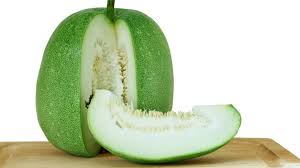
Ash gourd, also known as winter melon, wax gourd, or Benincasa hispida, is a versatile vegetable widely used in Indian and Asian cuisines, and revered in traditional medicine systems like Ayurveda. It
Ash gourd, also known as winter melon, wax gourd, or Benincasa hispida, is a versatile vegetable widely used in Indian and Asian cuisines, and revered in traditional medicine systems like Ayurveda. It's especially popular for its cooling properties and its ability to cleanse and nourish the body.
Here are some of the key benefits of ash gourd:
1. Excellent Hydration and Cooling:
High Water Content: Ash gourd is made up of over 95% water, making it incredibly hydrating. This is particularly beneficial in hot climates like India, helping to prevent dehydration and maintain electrolyte balance.
Cooling Effect: Its naturally cooling properties help to reduce body heat, making it a popular choice for juices and dishes during summer.
2. Digestive Health and Detoxification:
Rich in Fiber: Both soluble and insoluble fiber are present in ash gourd, which promotes healthy digestion, prevents constipation, and supports regular bowel movements.
Alleviates Acidity and Gastric Issues: Its alkaline nature can help neutralize excess stomach acid, providing relief from heartburn, indigestion, and bloating.
Detoxifying Properties: Ash gourd acts as a natural detoxifier, helping to flush out toxins from the body and support kidney function.
Soothes Stomach Lining: It can help protect and heal the stomach lining, making it beneficial for individuals with peptic ulcers.
3. Weight Management:
Low in Calories and Fat: Ash gourd is very low in calories and virtually fat-free, making it an excellent food for weight loss.
High Fiber Content: The high fiber content promotes a feeling of fullness, reducing cravings and preventing overeating.
Boosts Metabolism: Some studies suggest it can help improve metabolism, aiding in more efficient fat burning.
Eliminates Water Retention: Its natural diuretic properties can help reduce excess water weight and bloating.
4. Boosts Immunity:
Rich in Vitamin C: Ash gourd is a good source of Vitamin C, a powerful antioxidant that strengthens the immune system and helps the body fight off infections.
Antioxidants: It contains other antioxidants like flavonoids and carotenes that help neutralize free radicals, protecting cells from damage.
Zinc Content: Ash gourd also contains zinc, another vital mineral for a healthy immune system.
5. Mental Clarity and Nervous System Support:
Calming Effect: In Ayurveda, ash gourd is believed to have a calming effect on the nervous system, helping to reduce stress, anxiety, and improve mental clarity and focus.
Brain Health: It contains certain compounds that are believed to support brain function and memory.
6. Respiratory Health:
Expectorant Properties: Ash gourd has expectorant qualities, meaning it can help loosen and remove excess phlegm and mucus from the respiratory tract, benefiting those with coughs, colds, and other respiratory issues.
7. Skin and Hair Health:
Antioxidants and Vitamins: The vitamins and antioxidants contribute to healthy, glowing skin by fighting free radicals and improving skin texture.
Moisturizing: Its high water content helps keep the skin hydrated.
Scalp Health: The peel and seeds, when boiled with coconut oil, are traditionally used to help with dandruff and strengthen hair roots.
8. Blood Sugar Regulation:
Low Glycemic Index: Ash gourd has a low glycemic index and can be beneficial for managing blood sugar levels, making it a suitable option for individuals with diabetes. Its fiber also slows down sugar absorption.
Nutritional Profile (per 100 grams, approximate):
Water: ~96.1 g
Calories: ~13 kcal
Carbohydrates: ~3 g
Dietary Fiber: ~2.9 g
Protein: ~0.4 g
Fat: ~0.2 g
Vitamins: Vitamin C, B1 (Thiamine), B2 (Riboflavin), B3 (Niacin), B5, B6, Folate.
Minerals: Calcium, Iron, Magnesium, Phosphorus, Potassium, Sodium, Zinc, Copper, Manganese, Selenium.
Ways to Consume:
Ash gourd can be consumed in various forms:
Juice: Often consumed on an empty stomach for maximum benefits.
Curries and Soups: Used in savory dishes.
Sweets: In India, it's famous for making "petha," a sweet candy.
Salads and Smoothies: Due to its mild flavor, it blends well.
Important Considerations:
While generally safe, some individuals, especially those prone to colds or asthma, might need to consume ash gourd in moderation due to its strong cooling properties.
Here are some of the key benefits of ash gourd:
1. Excellent Hydration and Cooling:
High Water Content: Ash gourd is made up of over 95% water, making it incredibly hydrating. This is particularly beneficial in hot climates like India, helping to prevent dehydration and maintain electrolyte balance.
Cooling Effect: Its naturally cooling properties help to reduce body heat, making it a popular choice for juices and dishes during summer.
2. Digestive Health and Detoxification:
Rich in Fiber: Both soluble and insoluble fiber are present in ash gourd, which promotes healthy digestion, prevents constipation, and supports regular bowel movements.
Alleviates Acidity and Gastric Issues: Its alkaline nature can help neutralize excess stomach acid, providing relief from heartburn, indigestion, and bloating.
Detoxifying Properties: Ash gourd acts as a natural detoxifier, helping to flush out toxins from the body and support kidney function.
Soothes Stomach Lining: It can help protect and heal the stomach lining, making it beneficial for individuals with peptic ulcers.
3. Weight Management:
Low in Calories and Fat: Ash gourd is very low in calories and virtually fat-free, making it an excellent food for weight loss.
High Fiber Content: The high fiber content promotes a feeling of fullness, reducing cravings and preventing overeating.
Boosts Metabolism: Some studies suggest it can help improve metabolism, aiding in more efficient fat burning.
Eliminates Water Retention: Its natural diuretic properties can help reduce excess water weight and bloating.
4. Boosts Immunity:
Rich in Vitamin C: Ash gourd is a good source of Vitamin C, a powerful antioxidant that strengthens the immune system and helps the body fight off infections.
Antioxidants: It contains other antioxidants like flavonoids and carotenes that help neutralize free radicals, protecting cells from damage.
Zinc Content: Ash gourd also contains zinc, another vital mineral for a healthy immune system.
5. Mental Clarity and Nervous System Support:
Calming Effect: In Ayurveda, ash gourd is believed to have a calming effect on the nervous system, helping to reduce stress, anxiety, and improve mental clarity and focus.
Brain Health: It contains certain compounds that are believed to support brain function and memory.
6. Respiratory Health:
Expectorant Properties: Ash gourd has expectorant qualities, meaning it can help loosen and remove excess phlegm and mucus from the respiratory tract, benefiting those with coughs, colds, and other respiratory issues.
7. Skin and Hair Health:
Antioxidants and Vitamins: The vitamins and antioxidants contribute to healthy, glowing skin by fighting free radicals and improving skin texture.
Moisturizing: Its high water content helps keep the skin hydrated.
Scalp Health: The peel and seeds, when boiled with coconut oil, are traditionally used to help with dandruff and strengthen hair roots.
8. Blood Sugar Regulation:
Low Glycemic Index: Ash gourd has a low glycemic index and can be beneficial for managing blood sugar levels, making it a suitable option for individuals with diabetes. Its fiber also slows down sugar absorption.
Nutritional Profile (per 100 grams, approximate):
Water: ~96.1 g
Calories: ~13 kcal
Carbohydrates: ~3 g
Dietary Fiber: ~2.9 g
Protein: ~0.4 g
Fat: ~0.2 g
Vitamins: Vitamin C, B1 (Thiamine), B2 (Riboflavin), B3 (Niacin), B5, B6, Folate.
Minerals: Calcium, Iron, Magnesium, Phosphorus, Potassium, Sodium, Zinc, Copper, Manganese, Selenium.
Ways to Consume:
Ash gourd can be consumed in various forms:
Juice: Often consumed on an empty stomach for maximum benefits.
Curries and Soups: Used in savory dishes.
Sweets: In India, it's famous for making "petha," a sweet candy.
Salads and Smoothies: Due to its mild flavor, it blends well.
Important Considerations:
While generally safe, some individuals, especially those prone to colds or asthma, might need to consume ash gourd in moderation due to its strong cooling properties.
Bottle Gourd
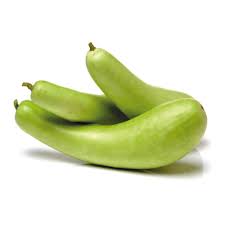
Bottle gourd (Lagenaria siceraria), also known as lauki, calabash, or white-flowered gourd, is a widely consumed vegetable with a host of impressive health benefits. It's recognized in various traditi
Bottle gourd (Lagenaria siceraria), also known as lauki, calabash, or white-flowered gourd, is a widely consumed vegetable with a host of impressive health benefits. It's recognized in various traditional medicine systems, including Ayurveda, for its therapeutic properties.
Here are some of the key benefits of bottle gourd:
1. Hydration and Cooling:
High Water Content: Bottle gourd is composed of approximately 92-96% water, making it an excellent vegetable for staying hydrated, especially during hot weather or after physical activity.
Cooling Properties: Its cooling nature helps soothe the body and reduce heat-related discomfort.
2. Digestive Health:
Rich in Dietary Fiber: Both soluble and insoluble fiber are present in bottle gourd, which aids in promoting healthy bowel movements and preventing constipation, flatulence, and piles.
Easy to Digest: Its light and easily digestible nature makes it suitable for individuals with sensitive digestive systems.
Alleviates Acidity: Its alkaline nature can help reduce acidity and heartburn.
3. Weight Management:
Low in Calories and Fat: Bottle gourd is very low in calories and almost fat-free, making it an ideal food for weight loss.
High Fiber Content: The fiber keeps you feeling full for longer, which can help reduce overall calorie intake and curb unnecessary cravings.
4. Heart Health:
Potassium Rich: It contains a good amount of potassium, which is crucial for regulating blood pressure and maintaining a healthy heart rate.
Lowers Cholesterol: Its fiber content and other nutrients can help reduce bad cholesterol (LDL) and prevent arterial blockages, contributing to overall cardiovascular health.
5. Detoxification and Liver Support:
Natural Detoxifier: The high water content aids in flushing out toxins from the body.
Liver Health: It's believed to support liver function and help in the detoxification process, potentially reducing liver inflammation.
6. Boosts Immunity:
Vitamin C: Bottle gourd is a good source of Vitamin C, which is essential for boosting the immune system and increasing resistance to diseases and infections.
7. Skin and Hair Health:
Antioxidants and Vitamins: Rich in vitamins (C, B, K) and minerals (zinc, magnesium), it promotes healthy skin function and rejuvenation, helping combat free radicals and reduce signs of aging.
Anti-inflammatory Properties: Can help soothe irritated skin conditions like eczema and psoriasis.
Hair Benefits: Some traditional uses suggest it helps strengthen hair roots and reduce hair fall and premature greying.
8. Blood Sugar Regulation:
Low Glycemic Index: Bottle gourd generally has a low glycemic index, making it suitable for diabetics. It can help regulate blood sugar levels, though monitoring is always advised.
9. Other Potential Benefits:
Reduces Stress and Anxiety: Contains choline, a nutrient that can help calm the mind and body.
Urinary Health: Its diuretic properties can help promote healthy kidney function and manage urinary disorders.
Anti-inflammatory: Helps reduce inflammation throughout the body.
Important Note: While bottle gourd offers numerous benefits, it's crucial to taste a small piece before consuming, especially if preparing juice. Bitter-tasting bottle gourd can be toxic due to the presence of cucurbitacins and should not be consumed, as it can lead to severe gastrointestinal issues and even poisoning. If you experience bitterness, discard it immediately.
Here are some of the key benefits of bottle gourd:
1. Hydration and Cooling:
High Water Content: Bottle gourd is composed of approximately 92-96% water, making it an excellent vegetable for staying hydrated, especially during hot weather or after physical activity.
Cooling Properties: Its cooling nature helps soothe the body and reduce heat-related discomfort.
2. Digestive Health:
Rich in Dietary Fiber: Both soluble and insoluble fiber are present in bottle gourd, which aids in promoting healthy bowel movements and preventing constipation, flatulence, and piles.
Easy to Digest: Its light and easily digestible nature makes it suitable for individuals with sensitive digestive systems.
Alleviates Acidity: Its alkaline nature can help reduce acidity and heartburn.
3. Weight Management:
Low in Calories and Fat: Bottle gourd is very low in calories and almost fat-free, making it an ideal food for weight loss.
High Fiber Content: The fiber keeps you feeling full for longer, which can help reduce overall calorie intake and curb unnecessary cravings.
4. Heart Health:
Potassium Rich: It contains a good amount of potassium, which is crucial for regulating blood pressure and maintaining a healthy heart rate.
Lowers Cholesterol: Its fiber content and other nutrients can help reduce bad cholesterol (LDL) and prevent arterial blockages, contributing to overall cardiovascular health.
5. Detoxification and Liver Support:
Natural Detoxifier: The high water content aids in flushing out toxins from the body.
Liver Health: It's believed to support liver function and help in the detoxification process, potentially reducing liver inflammation.
6. Boosts Immunity:
Vitamin C: Bottle gourd is a good source of Vitamin C, which is essential for boosting the immune system and increasing resistance to diseases and infections.
7. Skin and Hair Health:
Antioxidants and Vitamins: Rich in vitamins (C, B, K) and minerals (zinc, magnesium), it promotes healthy skin function and rejuvenation, helping combat free radicals and reduce signs of aging.
Anti-inflammatory Properties: Can help soothe irritated skin conditions like eczema and psoriasis.
Hair Benefits: Some traditional uses suggest it helps strengthen hair roots and reduce hair fall and premature greying.
8. Blood Sugar Regulation:
Low Glycemic Index: Bottle gourd generally has a low glycemic index, making it suitable for diabetics. It can help regulate blood sugar levels, though monitoring is always advised.
9. Other Potential Benefits:
Reduces Stress and Anxiety: Contains choline, a nutrient that can help calm the mind and body.
Urinary Health: Its diuretic properties can help promote healthy kidney function and manage urinary disorders.
Anti-inflammatory: Helps reduce inflammation throughout the body.
Important Note: While bottle gourd offers numerous benefits, it's crucial to taste a small piece before consuming, especially if preparing juice. Bitter-tasting bottle gourd can be toxic due to the presence of cucurbitacins and should not be consumed, as it can lead to severe gastrointestinal issues and even poisoning. If you experience bitterness, discard it immediately.
Bitter gourd

Bitter gourd, also known as bitter melon or Momordica charantia, is a unique and widely consumed vegetable, particularly in Asian countries. Despite its notoriously bitter taste, it's packed with nutr
Bitter gourd, also known as bitter melon or Momordica charantia, is a unique and widely consumed vegetable, particularly in Asian countries. Despite its notoriously bitter taste, it's packed with nutrients and has been traditionally used for its medicinal properties for centuries.
Here are some of the key benefits of bitter gourd:
1. Blood Sugar Management (Most Researched Benefit):
Insulin-like Compounds: Bitter gourd contains compounds like charantin, vicine, and polypeptide-P, which are known to mimic insulin's action. They help in lowering blood glucose levels by increasing glucose uptake by cells and promoting insulin secretion.
Improved Insulin Sensitivity: Regular consumption may help improve the body's sensitivity to insulin, which is crucial for individuals with Type 2 diabetes where insulin resistance is a key issue.
Reduced Sugar Spikes: Its low glycemic index and fiber content help slow down the absorption of sugar, preventing rapid spikes in blood sugar levels after meals.
Note: While promising, it's important to understand that bitter gourd is not a substitute for prescribed diabetes medication. Always consult a doctor before incorporating it into your diabetes management plan, especially if you are on medication, as it can cause excessively low blood sugar (hypoglycemia).
2. Digestive Health:
High Fiber Content: Bitter gourd is a good source of dietary fiber, which aids in healthy digestion, prevents constipation, and promotes regular bowel movements.
Stimulates Gastric Juices: It can stimulate the secretion of gastric juices, helping in better digestion and nutrient absorption.
Alleviates Digestive Issues: It can help relieve indigestion, bloating, and other gastric discomforts.
3. Weight Management:
Low in Calories and Fat: Being very low in calories and almost fat-free, bitter gourd is an excellent addition to a weight loss diet.
High Fiber Content: The fiber helps you feel full for longer, reducing overall calorie intake and curbing unhealthy cravings.
Supports Metabolism: Some research suggests it may help boost metabolism and aid in fat utilization.
4. Boosts Immunity:
Rich in Vitamin C: Bitter gourd is an excellent source of Vitamin C, a powerful antioxidant that strengthens the immune system and protects the body against infections and diseases.
Antioxidant Properties: It contains various antioxidants like phenols and flavonoids that combat free radicals, reducing oxidative stress and inflammation in the body.
5. Liver Detoxification and Health:
Natural Detoxifier: Bitter gourd is believed to support liver function and aid in detoxifying the body by flushing out toxins.
Liver Support: It has been traditionally used to manage liver disorders and may help regenerate liver cells.
6. Heart Health:
Lowers Cholesterol: Emerging studies suggest that bitter gourd may help lower levels of "bad" cholesterol (LDL) and triglycerides, which can reduce the risk of heart disease and improve cardiovascular health.
Potassium Rich: It contains potassium, which is important for maintaining healthy blood pressure levels.
7. Skin and Hair Health:
Blood Purification: Its antioxidant and antimicrobial properties help purify the blood, which can contribute to clearer skin and combat issues like acne, blemishes, and even eczema.
Vitamins for Skin: Vitamins A and C, along with other antioxidants, support healthy skin function and protect against damage.
Hair Benefits: Traditionally, it's believed to promote hair growth and add shine to hair.
8. Eye Health:
Rich in Vitamin A and Beta-carotene: These compounds are essential for maintaining healthy vision and preventing eye-related disorders like cataracts and night blindness.
9. Respiratory Conditions:
Bitter gourd has been used in traditional medicine to manage coughs, bronchitis, and sinus issues due to its anti-inflammatory and antiviral properties.
Nutritional Profile (per 100 grams, approximate):
Calories: ~17-30 kcal
Water: ~94%
Carbohydrates: ~3-4 g
Dietary Fiber: ~1-3 g
Protein: ~0.4-1 g
Fat: ~0.1-0.2 g
Vitamins: Excellent source of Vitamin C, good source of Vitamin A, Vitamin B1 (Thiamine), B2 (Riboflavin), B3 (Niacin), B5, B6, and Folate (B9).
Minerals: Calcium, Iron, Magnesium, Phosphorus, Potassium, Zinc, Copper, Manganese.
Here are some of the key benefits of bitter gourd:
1. Blood Sugar Management (Most Researched Benefit):
Insulin-like Compounds: Bitter gourd contains compounds like charantin, vicine, and polypeptide-P, which are known to mimic insulin's action. They help in lowering blood glucose levels by increasing glucose uptake by cells and promoting insulin secretion.
Improved Insulin Sensitivity: Regular consumption may help improve the body's sensitivity to insulin, which is crucial for individuals with Type 2 diabetes where insulin resistance is a key issue.
Reduced Sugar Spikes: Its low glycemic index and fiber content help slow down the absorption of sugar, preventing rapid spikes in blood sugar levels after meals.
Note: While promising, it's important to understand that bitter gourd is not a substitute for prescribed diabetes medication. Always consult a doctor before incorporating it into your diabetes management plan, especially if you are on medication, as it can cause excessively low blood sugar (hypoglycemia).
2. Digestive Health:
High Fiber Content: Bitter gourd is a good source of dietary fiber, which aids in healthy digestion, prevents constipation, and promotes regular bowel movements.
Stimulates Gastric Juices: It can stimulate the secretion of gastric juices, helping in better digestion and nutrient absorption.
Alleviates Digestive Issues: It can help relieve indigestion, bloating, and other gastric discomforts.
3. Weight Management:
Low in Calories and Fat: Being very low in calories and almost fat-free, bitter gourd is an excellent addition to a weight loss diet.
High Fiber Content: The fiber helps you feel full for longer, reducing overall calorie intake and curbing unhealthy cravings.
Supports Metabolism: Some research suggests it may help boost metabolism and aid in fat utilization.
4. Boosts Immunity:
Rich in Vitamin C: Bitter gourd is an excellent source of Vitamin C, a powerful antioxidant that strengthens the immune system and protects the body against infections and diseases.
Antioxidant Properties: It contains various antioxidants like phenols and flavonoids that combat free radicals, reducing oxidative stress and inflammation in the body.
5. Liver Detoxification and Health:
Natural Detoxifier: Bitter gourd is believed to support liver function and aid in detoxifying the body by flushing out toxins.
Liver Support: It has been traditionally used to manage liver disorders and may help regenerate liver cells.
6. Heart Health:
Lowers Cholesterol: Emerging studies suggest that bitter gourd may help lower levels of "bad" cholesterol (LDL) and triglycerides, which can reduce the risk of heart disease and improve cardiovascular health.
Potassium Rich: It contains potassium, which is important for maintaining healthy blood pressure levels.
7. Skin and Hair Health:
Blood Purification: Its antioxidant and antimicrobial properties help purify the blood, which can contribute to clearer skin and combat issues like acne, blemishes, and even eczema.
Vitamins for Skin: Vitamins A and C, along with other antioxidants, support healthy skin function and protect against damage.
Hair Benefits: Traditionally, it's believed to promote hair growth and add shine to hair.
8. Eye Health:
Rich in Vitamin A and Beta-carotene: These compounds are essential for maintaining healthy vision and preventing eye-related disorders like cataracts and night blindness.
9. Respiratory Conditions:
Bitter gourd has been used in traditional medicine to manage coughs, bronchitis, and sinus issues due to its anti-inflammatory and antiviral properties.
Nutritional Profile (per 100 grams, approximate):
Calories: ~17-30 kcal
Water: ~94%
Carbohydrates: ~3-4 g
Dietary Fiber: ~1-3 g
Protein: ~0.4-1 g
Fat: ~0.1-0.2 g
Vitamins: Excellent source of Vitamin C, good source of Vitamin A, Vitamin B1 (Thiamine), B2 (Riboflavin), B3 (Niacin), B5, B6, and Folate (B9).
Minerals: Calcium, Iron, Magnesium, Phosphorus, Potassium, Zinc, Copper, Manganese.
Snake gourd
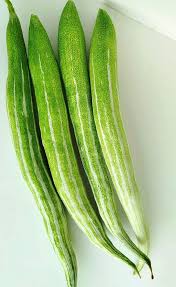
Snake gourd (Trichosanthes cucumerina), also known as serpent gourd, chichinda, or padwal, is a long, slender vegetable widely consumed in South and Southeast Asian cuisines. Like its gourd relatives,
Snake gourd (Trichosanthes cucumerina), also known as serpent gourd, chichinda, or padwal, is a long, slender vegetable widely consumed in South and Southeast Asian cuisines. Like its gourd relatives, it offers a range of impressive health benefits due to its rich nutritional profile.
Here are some of the key benefits of snake gourd:
1. Digestive Health:
High Fiber Content: Snake gourd is an excellent source of dietary fiber, both soluble and insoluble. This promotes healthy digestion, aids in regular bowel movements, and can help prevent constipation, bloating, and other digestive discomforts.
Aids in Detoxification: The fiber and water content help to flush out toxins from the digestive tract, contributing to a cleaner system.
Gastroprotective Properties: Some traditional uses suggest it can help soothe the stomach and protect its lining.
2. Hydration and Cooling:
High Water Content: Snake gourd is composed of a significant amount of water, making it a natural coolant and highly effective in keeping the body hydrated, especially in hot climates. This also helps in maintaining electrolyte balance.
3. Weight Management:
Low in Calories and Fat: With negligible calories and fat, snake gourd is an ideal food for those aiming for weight loss or maintaining a healthy weight.
Filling Fiber: The high fiber content helps you feel full and satiated for longer, reducing the urge to overeat and curbing unhealthy snacking.
4. Blood Sugar Regulation:
Potential Anti-diabetic Effects: Research suggests that snake gourd may help in lowering blood sugar levels and improving glucose tolerance. It can delay carbohydrate digestion, thereby reducing post-meal blood sugar spikes. This makes it potentially beneficial for individuals with Type 2 diabetes, though it should always complement and not replace prescribed medication.
5. Heart Health:
Low Cholesterol: Snake gourd has zero cholesterol, making it a heart-friendly vegetable.
Potassium Rich: It contains a good amount of potassium, an important electrolyte that helps regulate blood pressure and counteracts the effects of sodium, thus promoting cardiovascular health.
6. Boosts Immunity:
Rich in Vitamin C: Snake gourd is a good source of Vitamin C, a powerful antioxidant that strengthens the immune system, helping the body fight off infections and diseases.
Antioxidants: It contains other antioxidants like flavonoids, carotenoids, and phenolic acids that help combat free radicals and reduce oxidative stress in the body.
7. Kidney Detoxification:
Diuretic Properties: Snake gourd stimulates the natural elimination of waste products from the body via the excretory system, including the kidneys. It can promote fluid secretion within the kidneys, aiding in the removal of accumulated toxins and potentially helping with kidney stones.
8. Respiratory Health:
Expectorant Qualities: In traditional medicine, snake gourd is used for its expectorant properties, which means it can help loosen and remove excess phlegm and mucus from the respiratory tracts, providing relief from coughs, colds, and other respiratory issues.
9. Skin and Hair Benefits:
Vitamins and Minerals: The presence of vitamins (A, C, E) and minerals supports overall skin health, helping to revitalize skin texture and combat damage from sun and pollution.
Hair Growth: Some traditional applications suggest that extracts from the plant can help with hair growth and improve scalp conditions like dandruff.
10. Calming and Anti-inflammatory:
Nervous System Support: Compounds like organic amines and flavonoids are believed to protect brain and nerve cells, contributing to reduced stress and anxiety, and improving mental well-being.
Anti-inflammatory Properties: Its intrinsic anti-inflammatory components may help ease inflammation in the body.
Nutritional Profile (approximate per 100g):
Calories: 16-30 kcal
Water: ~94-96%
Carbohydrates: 3-4 g
Dietary Fiber: 0.5-3 g
Protein: 0.4-2.0 g
Fat: 0.1-0.2 g
Vitamins: Vitamin A, Vitamin B6, Vitamin C (significant amount), Vitamin E.
Minerals: Calcium, Iron, Magnesium, Manganese, Phosphorus, Potassium, Zinc, Iodine.
Here are some of the key benefits of snake gourd:
1. Digestive Health:
High Fiber Content: Snake gourd is an excellent source of dietary fiber, both soluble and insoluble. This promotes healthy digestion, aids in regular bowel movements, and can help prevent constipation, bloating, and other digestive discomforts.
Aids in Detoxification: The fiber and water content help to flush out toxins from the digestive tract, contributing to a cleaner system.
Gastroprotective Properties: Some traditional uses suggest it can help soothe the stomach and protect its lining.
2. Hydration and Cooling:
High Water Content: Snake gourd is composed of a significant amount of water, making it a natural coolant and highly effective in keeping the body hydrated, especially in hot climates. This also helps in maintaining electrolyte balance.
3. Weight Management:
Low in Calories and Fat: With negligible calories and fat, snake gourd is an ideal food for those aiming for weight loss or maintaining a healthy weight.
Filling Fiber: The high fiber content helps you feel full and satiated for longer, reducing the urge to overeat and curbing unhealthy snacking.
4. Blood Sugar Regulation:
Potential Anti-diabetic Effects: Research suggests that snake gourd may help in lowering blood sugar levels and improving glucose tolerance. It can delay carbohydrate digestion, thereby reducing post-meal blood sugar spikes. This makes it potentially beneficial for individuals with Type 2 diabetes, though it should always complement and not replace prescribed medication.
5. Heart Health:
Low Cholesterol: Snake gourd has zero cholesterol, making it a heart-friendly vegetable.
Potassium Rich: It contains a good amount of potassium, an important electrolyte that helps regulate blood pressure and counteracts the effects of sodium, thus promoting cardiovascular health.
6. Boosts Immunity:
Rich in Vitamin C: Snake gourd is a good source of Vitamin C, a powerful antioxidant that strengthens the immune system, helping the body fight off infections and diseases.
Antioxidants: It contains other antioxidants like flavonoids, carotenoids, and phenolic acids that help combat free radicals and reduce oxidative stress in the body.
7. Kidney Detoxification:
Diuretic Properties: Snake gourd stimulates the natural elimination of waste products from the body via the excretory system, including the kidneys. It can promote fluid secretion within the kidneys, aiding in the removal of accumulated toxins and potentially helping with kidney stones.
8. Respiratory Health:
Expectorant Qualities: In traditional medicine, snake gourd is used for its expectorant properties, which means it can help loosen and remove excess phlegm and mucus from the respiratory tracts, providing relief from coughs, colds, and other respiratory issues.
9. Skin and Hair Benefits:
Vitamins and Minerals: The presence of vitamins (A, C, E) and minerals supports overall skin health, helping to revitalize skin texture and combat damage from sun and pollution.
Hair Growth: Some traditional applications suggest that extracts from the plant can help with hair growth and improve scalp conditions like dandruff.
10. Calming and Anti-inflammatory:
Nervous System Support: Compounds like organic amines and flavonoids are believed to protect brain and nerve cells, contributing to reduced stress and anxiety, and improving mental well-being.
Anti-inflammatory Properties: Its intrinsic anti-inflammatory components may help ease inflammation in the body.
Nutritional Profile (approximate per 100g):
Calories: 16-30 kcal
Water: ~94-96%
Carbohydrates: 3-4 g
Dietary Fiber: 0.5-3 g
Protein: 0.4-2.0 g
Fat: 0.1-0.2 g
Vitamins: Vitamin A, Vitamin B6, Vitamin C (significant amount), Vitamin E.
Minerals: Calcium, Iron, Magnesium, Manganese, Phosphorus, Potassium, Zinc, Iodine.
Ridge gourd

Ridge gourd, known as turai or tori in Hindi, heerekai in Kannada, and peerkangai in Tamil, is a popular vegetable with distinctive ridges on its skin. Despite its mild flavor, it's a nutritional powe
Ridge gourd, known as turai or tori in Hindi, heerekai in Kannada, and peerkangai in Tamil, is a popular vegetable with distinctive ridges on its skin. Despite its mild flavor, it's a nutritional powerhouse offering several health benefits.
Here are some of the key benefits of ridge gourd:
1. Digestive Health:
High Fiber Content: Ridge gourd is rich in dietary fiber, which is crucial for a healthy digestive system. It adds bulk to stool, promoting regular bowel movements and preventing constipation, gas, and bloating.
Aids in Digestion: Its fiber content and water make it easy to digest and can help soothe the digestive tract. It also contains enzymes that aid in digestion.
2. Weight Management:
Low in Calories and Fat: Ridge gourd is inherently low in calories and virtually fat-free, making it an excellent choice for those looking to lose or maintain weight.
High Water and Fiber Content: The high water and fiber content help you feel full and satisfied for longer, reducing overall calorie intake and discouraging overeating or unhealthy snacking.
3. Blood Sugar Management:
Low Glycemic Index (GI): Ridge gourd has a low glycemic index, meaning it causes a slow and steady rise in blood sugar levels, rather than sharp spikes. This makes it a suitable vegetable for individuals with diabetes.
Improved Insulin Sensitivity: Its fiber and certain phytonutrients can help improve the body's sensitivity to insulin, aiding in better glucose utilization.
4. Hydration and Cooling:
High Water Content: Comprising over 90% water, ridge gourd is highly hydrating. This makes it an excellent vegetable to consume, especially during hot weather, to prevent dehydration and maintain electrolyte balance.
Cooling Effect: It has a natural cooling effect on the body, helping to reduce internal heat.
5. Liver Health:
Detoxifying Properties: Ridge gourd is believed to have detoxifying properties that support liver function. It aids in flushing out toxins from the body and promotes the secretion of bile, which is essential for fat digestion and overall liver health.
6. Boosts Immunity:
Rich in Vitamin C: Ridge gourd is a good source of Vitamin C, a powerful antioxidant that plays a vital role in strengthening the immune system. It helps the body fight off infections and diseases.
Antioxidants: It contains other antioxidants like carotenoids, flavonoids, and phenolic acids that combat free radicals, reduce oxidative stress, and protect cells from damage.
7. Eye Health:
Vitamin A and Beta-Carotene: Ridge gourd contains Vitamin A (in the form of beta-carotene), which is crucial for maintaining good vision. It helps protect the eyes from age-related macular degeneration, night blindness, and other vision problems.
8. Anemia Prevention:
Good Source of Iron and Vitamin B6: Ridge gourd contains iron, which is essential for the production of red blood cells and preventing iron-deficiency anemia. Vitamin B6 also plays a role in healthy red blood cell synthesis, helping to improve blood flow and reduce fatigue.
9. Skin and Hair Health:
Vitamins and Antioxidants: The presence of vitamins A and C, along with other antioxidants, promotes healthy skin by combating free radicals, reducing oxidative damage, and supporting collagen production. This can lead to clearer and more vibrant skin.
Hair Nourishment: It's traditionally believed to nourish hair and help prevent premature greying due to its nutrient content.
10. Anti-inflammatory Properties:
Ridge gourd contains compounds that may help reduce inflammation throughout the body, contributing to overall well-being.
Nutritional Profile (Approximate per 100g cooked, without added fat):
Calories: 15-30 kcal
Water: >90%
Carbohydrates: 2-4 g
Dietary Fiber: 1-3 g
Protein: 0.5-1 g
Fat: <0.2 g
Vitamins: Vitamin C (significant amount), Vitamin A (as beta-carotene), Vitamin B6, Folate.
Minerals: Potassium, Iron, Magnesium, Phosphorus, Zinc.
Here are some of the key benefits of ridge gourd:
1. Digestive Health:
High Fiber Content: Ridge gourd is rich in dietary fiber, which is crucial for a healthy digestive system. It adds bulk to stool, promoting regular bowel movements and preventing constipation, gas, and bloating.
Aids in Digestion: Its fiber content and water make it easy to digest and can help soothe the digestive tract. It also contains enzymes that aid in digestion.
2. Weight Management:
Low in Calories and Fat: Ridge gourd is inherently low in calories and virtually fat-free, making it an excellent choice for those looking to lose or maintain weight.
High Water and Fiber Content: The high water and fiber content help you feel full and satisfied for longer, reducing overall calorie intake and discouraging overeating or unhealthy snacking.
3. Blood Sugar Management:
Low Glycemic Index (GI): Ridge gourd has a low glycemic index, meaning it causes a slow and steady rise in blood sugar levels, rather than sharp spikes. This makes it a suitable vegetable for individuals with diabetes.
Improved Insulin Sensitivity: Its fiber and certain phytonutrients can help improve the body's sensitivity to insulin, aiding in better glucose utilization.
4. Hydration and Cooling:
High Water Content: Comprising over 90% water, ridge gourd is highly hydrating. This makes it an excellent vegetable to consume, especially during hot weather, to prevent dehydration and maintain electrolyte balance.
Cooling Effect: It has a natural cooling effect on the body, helping to reduce internal heat.
5. Liver Health:
Detoxifying Properties: Ridge gourd is believed to have detoxifying properties that support liver function. It aids in flushing out toxins from the body and promotes the secretion of bile, which is essential for fat digestion and overall liver health.
6. Boosts Immunity:
Rich in Vitamin C: Ridge gourd is a good source of Vitamin C, a powerful antioxidant that plays a vital role in strengthening the immune system. It helps the body fight off infections and diseases.
Antioxidants: It contains other antioxidants like carotenoids, flavonoids, and phenolic acids that combat free radicals, reduce oxidative stress, and protect cells from damage.
7. Eye Health:
Vitamin A and Beta-Carotene: Ridge gourd contains Vitamin A (in the form of beta-carotene), which is crucial for maintaining good vision. It helps protect the eyes from age-related macular degeneration, night blindness, and other vision problems.
8. Anemia Prevention:
Good Source of Iron and Vitamin B6: Ridge gourd contains iron, which is essential for the production of red blood cells and preventing iron-deficiency anemia. Vitamin B6 also plays a role in healthy red blood cell synthesis, helping to improve blood flow and reduce fatigue.
9. Skin and Hair Health:
Vitamins and Antioxidants: The presence of vitamins A and C, along with other antioxidants, promotes healthy skin by combating free radicals, reducing oxidative damage, and supporting collagen production. This can lead to clearer and more vibrant skin.
Hair Nourishment: It's traditionally believed to nourish hair and help prevent premature greying due to its nutrient content.
10. Anti-inflammatory Properties:
Ridge gourd contains compounds that may help reduce inflammation throughout the body, contributing to overall well-being.
Nutritional Profile (Approximate per 100g cooked, without added fat):
Calories: 15-30 kcal
Water: >90%
Carbohydrates: 2-4 g
Dietary Fiber: 1-3 g
Protein: 0.5-1 g
Fat: <0.2 g
Vitamins: Vitamin C (significant amount), Vitamin A (as beta-carotene), Vitamin B6, Folate.
Minerals: Potassium, Iron, Magnesium, Phosphorus, Zinc.
Migraine
.jpg)
A migraine is a complex neurological disorder that typically causes a severe, throbbing headache, often on one side of the head. Migraine attacks can be highly debilitating, lasting for hours to sever
A migraine is a complex neurological disorder that typically causes a severe, throbbing headache, often on one side of the head. Migraine attacks can be highly debilitating, lasting for hours to several days. They are not just a bad headache, but a condition with a variety of symptoms that can significantly interfere with daily life.
Symptoms
Migraine symptoms can be categorized into four phases, although not everyone experiences all of them:
Prodrome: This phase occurs one or two days before the headache. Symptoms can include:
Mood changes (from depression to elation)
Food cravings
Neck stiffness
Increased urination
Yawning
Constipation
Aura: This phase, which may occur before or during the headache, involves reversible neurological symptoms. The most common are visual disturbances, such as seeing shapes, bright spots, flashes of light, or temporary vision loss. Other auras can include:
Tingling or numbness in an arm or leg
Weakness or numbness on one side of the face or body
Difficulty speaking
Attack: This is the main headache phase. The pain is usually a throbbing or pulsing sensation on one side of the head, but it can affect both sides. During this phase, you may also experience:
Nausea and vomiting
Extreme sensitivity to light, sound, and sometimes smell and touch
Post-drome: This phase follows the headache. You may feel drained, confused, and washed out, but for some, there is a feeling of elation. Sudden head movements can cause a brief return of the pain.
Causes and Triggers-
The exact cause of migraines is not fully understood, but they are believed to be related to abnormal brain activity that affects nerve signals, chemicals, and blood vessels. Migraines often have a strong genetic component. A variety of triggers can initiate a migraine attack. Common triggers include:
1. Hormonal changes: Fluctuations in estrogen levels, such as those that occur during menstruation, pregnancy, or menopause, are a common trigger for many women.
2. Stress: Stress at work or home is a major trigger for many people.
3. Sensory stimuli: Bright or flashing lights, loud sounds, and strong smells (like perfume or paint thinner) can induce migraines.
4. Sleep changes: Both a lack of sleep and too much sleep can be a trigger.
5. Physical exertion: Intense physical activity can sometimes provoke a migraine.
6. Weather changes: Changes in weather or barometric pressure can be a trigger.
Foods and Substances to Consider Avoiding
Keeping a food diary is highly recommended to pinpoint which of these might be a trigger for you. Note what you eat and drink, and when you get a migraine, look for patterns.
1. Tyramine-rich foods: Tyramine is a natural compound that forms as certain foods age. It's a common suspect in food-triggered migraines. Foods high in tyramine include:
Aged cheeses: Cheddar, Swiss, Parmesan, blue cheese, feta.
Cured, smoked, or processed meats: Hot dogs, sausage, pepperoni, salami, bacon, deli meats.
Fermented and pickled foods: Sauerkraut, kimchi, soy sauce, miso soup, pickled vegetables.
Certain beans: Fava beans, lima beans, and other broad beans.
Some nuts: Peanuts and certain nut butters.
2. Caffeine: Caffeine is a "double-edged sword" when it comes to migraines. For some people, a small amount of caffeine can help stop an attack, which is why it's an ingredient in some migraine medications. However, for others, too much caffeine can be a trigger, and caffeine withdrawal can also lead to a headache.
3. Alcohol: Red wine is a well-known migraine trigger, but beer and other types of alcohol can also be problematic. This may be due to compounds like histamines, sulfites, and tyramine, as well as the dehydrating effects of alcohol.
4. Artificial sweeteners and additives: Aspartame and other artificial sweeteners found in diet sodas and other products are reported triggers for some individuals. Monosodium glutamate (MSG), a flavor enhancer, is also a common suspect.
5. Chocolate: This is a frequently reported trigger. It contains caffeine and a compound called phenylethylamine, which may be a factor. However, some researchers believe that the craving for chocolate is a symptom of a migraine's prodrome phase, rather than a cause.
6. Nitrates and Nitrites: These preservatives are often found in processed meats like hot dogs and bacon and can trigger headaches by dilating blood vessels.
7. Histamine-rich foods: Foods like aged cheeses, cured meats, and some fermented foods are high in histamine, which can be a migraine trigger.
Beneficial Dietary Practices
1. While avoiding triggers is key, incorporating certain foods and habits may help reduce the frequency and severity of migraines.
2. Maintain a consistent eating schedule: Skipping meals can cause blood sugar levels to drop, which is a known migraine trigger. Eating small, frequent meals throughout the day can help stabilize blood sugar.
3. Stay hydrated: Dehydration is a very common migraine trigger. Aim to drink plenty of water throughout the day.
4. Focus on whole, unprocessed foods: A diet rich in fresh fruits, vegetables, whole grains, and lean proteins is generally recommended.
5.Magnesium-rich foods: Magnesium has been shown to be beneficial for migraine prevention. Foods high in magnesium include dark leafy greens, whole grains, nuts, seeds, and avocados.
Omega-3 fatty acids: These are found in fatty fish like salmon and mackerel, as well as flaxseeds and walnuts, and have anti-inflammatory properties that may help with migraines.
Riboflavin (Vitamin B2): Some studies suggest that high doses of riboflavin can help reduce migraine frequency. Foods rich in B2 include mushrooms, quinoa, and eggs.
Symptoms
Migraine symptoms can be categorized into four phases, although not everyone experiences all of them:
Prodrome: This phase occurs one or two days before the headache. Symptoms can include:
Mood changes (from depression to elation)
Food cravings
Neck stiffness
Increased urination
Yawning
Constipation
Aura: This phase, which may occur before or during the headache, involves reversible neurological symptoms. The most common are visual disturbances, such as seeing shapes, bright spots, flashes of light, or temporary vision loss. Other auras can include:
Tingling or numbness in an arm or leg
Weakness or numbness on one side of the face or body
Difficulty speaking
Attack: This is the main headache phase. The pain is usually a throbbing or pulsing sensation on one side of the head, but it can affect both sides. During this phase, you may also experience:
Nausea and vomiting
Extreme sensitivity to light, sound, and sometimes smell and touch
Post-drome: This phase follows the headache. You may feel drained, confused, and washed out, but for some, there is a feeling of elation. Sudden head movements can cause a brief return of the pain.
Causes and Triggers-
The exact cause of migraines is not fully understood, but they are believed to be related to abnormal brain activity that affects nerve signals, chemicals, and blood vessels. Migraines often have a strong genetic component. A variety of triggers can initiate a migraine attack. Common triggers include:
1. Hormonal changes: Fluctuations in estrogen levels, such as those that occur during menstruation, pregnancy, or menopause, are a common trigger for many women.
2. Stress: Stress at work or home is a major trigger for many people.
3. Sensory stimuli: Bright or flashing lights, loud sounds, and strong smells (like perfume or paint thinner) can induce migraines.
4. Sleep changes: Both a lack of sleep and too much sleep can be a trigger.
5. Physical exertion: Intense physical activity can sometimes provoke a migraine.
6. Weather changes: Changes in weather or barometric pressure can be a trigger.
Foods and Substances to Consider Avoiding
Keeping a food diary is highly recommended to pinpoint which of these might be a trigger for you. Note what you eat and drink, and when you get a migraine, look for patterns.
1. Tyramine-rich foods: Tyramine is a natural compound that forms as certain foods age. It's a common suspect in food-triggered migraines. Foods high in tyramine include:
Aged cheeses: Cheddar, Swiss, Parmesan, blue cheese, feta.
Cured, smoked, or processed meats: Hot dogs, sausage, pepperoni, salami, bacon, deli meats.
Fermented and pickled foods: Sauerkraut, kimchi, soy sauce, miso soup, pickled vegetables.
Certain beans: Fava beans, lima beans, and other broad beans.
Some nuts: Peanuts and certain nut butters.
2. Caffeine: Caffeine is a "double-edged sword" when it comes to migraines. For some people, a small amount of caffeine can help stop an attack, which is why it's an ingredient in some migraine medications. However, for others, too much caffeine can be a trigger, and caffeine withdrawal can also lead to a headache.
3. Alcohol: Red wine is a well-known migraine trigger, but beer and other types of alcohol can also be problematic. This may be due to compounds like histamines, sulfites, and tyramine, as well as the dehydrating effects of alcohol.
4. Artificial sweeteners and additives: Aspartame and other artificial sweeteners found in diet sodas and other products are reported triggers for some individuals. Monosodium glutamate (MSG), a flavor enhancer, is also a common suspect.
5. Chocolate: This is a frequently reported trigger. It contains caffeine and a compound called phenylethylamine, which may be a factor. However, some researchers believe that the craving for chocolate is a symptom of a migraine's prodrome phase, rather than a cause.
6. Nitrates and Nitrites: These preservatives are often found in processed meats like hot dogs and bacon and can trigger headaches by dilating blood vessels.
7. Histamine-rich foods: Foods like aged cheeses, cured meats, and some fermented foods are high in histamine, which can be a migraine trigger.
Beneficial Dietary Practices
1. While avoiding triggers is key, incorporating certain foods and habits may help reduce the frequency and severity of migraines.
2. Maintain a consistent eating schedule: Skipping meals can cause blood sugar levels to drop, which is a known migraine trigger. Eating small, frequent meals throughout the day can help stabilize blood sugar.
3. Stay hydrated: Dehydration is a very common migraine trigger. Aim to drink plenty of water throughout the day.
4. Focus on whole, unprocessed foods: A diet rich in fresh fruits, vegetables, whole grains, and lean proteins is generally recommended.
5.Magnesium-rich foods: Magnesium has been shown to be beneficial for migraine prevention. Foods high in magnesium include dark leafy greens, whole grains, nuts, seeds, and avocados.
Omega-3 fatty acids: These are found in fatty fish like salmon and mackerel, as well as flaxseeds and walnuts, and have anti-inflammatory properties that may help with migraines.
Riboflavin (Vitamin B2): Some studies suggest that high doses of riboflavin can help reduce migraine frequency. Foods rich in B2 include mushrooms, quinoa, and eggs.
Spirulina

What is Spirulina?
Spirulina is incredibly nutrient-dense, containing a good amount of:
Protein: It's a complete protein, meaning it contains all essential amino acids, making it a great plant-based
Spirulina is incredibly nutrient-dense, containing a good amount of:
Protein: It's a complete protein, meaning it contains all essential amino acids, making it a great plant-based
What is Spirulina?
Spirulina is incredibly nutrient-dense, containing a good amount of:
Protein: It's a complete protein, meaning it contains all essential amino acids, making it a great plant-based protein source, especially for vegetarians and vegans.
Vitamins: Rich in B vitamins (B1, B2, B3), vitamin E, and beta-carotene.
Minerals: Provides iron, copper, magnesium, manganese, selenium, and zinc.
Antioxidants: Notably contains phycocyanin, which gives spirulina its characteristic blue-green color and possesses strong antioxidant and anti-inflammatory properties.
Fatty Acids: Contains beneficial omega-3 and omega-6 fatty acids.
Health benefits-
1. Powerful Antioxidant and Anti-inflammatory Properties: Spirulina's high antioxidant content, especially phycocyanin, helps combat oxidative stress in the body. Oxidative stress is caused by free radicals and can damage cells, contributing to various chronic diseases.Phycocyanin has been shown to inhibit inflammatory responses, making spirulina a natural anti-inflammatory agent. This can help reduce inflammation throughout the body.
2. Supports Heart Health: Cholesterol and Triglyceride Reduction: Studies suggest spirulina can help lower total cholesterol, "bad" LDL cholesterol, and triglycerides, while potentially increasing "good" HDL cholesterol. This can significantly reduce the risk of atherosclerosis (plaque buildup in arteries) and coronary artery disease.
3. Blood Pressure Regulation: Research indicates that spirulina can help reduce blood pressure, particularly in individuals with hypertension. This effect is
thought to be due to increased nitric oxide production, which helps relax and dilate blood vessels.
4. Blood Sugar Management: Some studies show that spirulina supplementation can improve fasting blood glucose levels and insulin sensitivity in people with type 2 diabetes. This may help in better blood sugar control.
5. Boosts Immune System: Spirulina can help enhance immune function by stimulating the production of white blood cells and antibodies that fight off infections. Its rich nutrient profile also supports overall immune health.
6. May Alleviate Allergies (Allergic Rhinitis): Several studies suggest that spirulina can significantly improve symptoms of allergic rhinitis (hay fever) like nasal discharge, sneezing, nasal congestion, and itching. It may do this by inhibiting the release of histamine.
7. May Aid in Anemia Prevention and Treatment: Being a good source of iron, spirulina can help increase hemoglobin levels in red blood cells, which is crucial for oxygen transport throughout the body. This makes it beneficial for preventing and managing anemia.
8. Supports Muscle Strength and Endurance: The high protein content in spirulina provides essential amino acids for muscle development and repair. Its antioxidant properties may also help reduce exercise-induced oxidative stress, potentially leading to improved muscle strength, endurance, and faster recovery.
9. Potential for Weight Management: Spirulina, rich in protein and fiber, can promote feelings of fullness and reduce appetite, which may aid in weight loss when combined with a calorie-reduced diet and exercise. Some studies have shown it can help reduce body fat percentage and waist circumference.
10. Promotes Oral Health: Spirulina exhibits antimicrobial and antibacterial properties. Research suggests that it may help reduce dental plaque and gingivitis (gum disease). Some studies even explore its potential in managing oral submucous fibrosis, a precancerous condition.
11. Supports Brain Health: Emerging research suggests a neuroprotective role for spirulina, particularly its antioxidant and anti-inflammatory effects on brain cells. It's being studied for its potential in preventing or slowing the progression of neurodegenerative diseases like Parkinson's and Alzheimer's, though more human research is needed.
12. May Have Anti-Cancer Properties: While more research is ongoing, laboratory studies suggest that the antioxidants in spirulina, particularly phycocyanin, may have anti-cancer effects by neutralizing free radicals, reducing inflammation, and potentially inhibiting the growth of cancer cells. This is an area of active investigation.
Spirulina is incredibly nutrient-dense, containing a good amount of:
Protein: It's a complete protein, meaning it contains all essential amino acids, making it a great plant-based protein source, especially for vegetarians and vegans.
Vitamins: Rich in B vitamins (B1, B2, B3), vitamin E, and beta-carotene.
Minerals: Provides iron, copper, magnesium, manganese, selenium, and zinc.
Antioxidants: Notably contains phycocyanin, which gives spirulina its characteristic blue-green color and possesses strong antioxidant and anti-inflammatory properties.
Fatty Acids: Contains beneficial omega-3 and omega-6 fatty acids.
Health benefits-
1. Powerful Antioxidant and Anti-inflammatory Properties: Spirulina's high antioxidant content, especially phycocyanin, helps combat oxidative stress in the body. Oxidative stress is caused by free radicals and can damage cells, contributing to various chronic diseases.Phycocyanin has been shown to inhibit inflammatory responses, making spirulina a natural anti-inflammatory agent. This can help reduce inflammation throughout the body.
2. Supports Heart Health: Cholesterol and Triglyceride Reduction: Studies suggest spirulina can help lower total cholesterol, "bad" LDL cholesterol, and triglycerides, while potentially increasing "good" HDL cholesterol. This can significantly reduce the risk of atherosclerosis (plaque buildup in arteries) and coronary artery disease.
3. Blood Pressure Regulation: Research indicates that spirulina can help reduce blood pressure, particularly in individuals with hypertension. This effect is
thought to be due to increased nitric oxide production, which helps relax and dilate blood vessels.
4. Blood Sugar Management: Some studies show that spirulina supplementation can improve fasting blood glucose levels and insulin sensitivity in people with type 2 diabetes. This may help in better blood sugar control.
5. Boosts Immune System: Spirulina can help enhance immune function by stimulating the production of white blood cells and antibodies that fight off infections. Its rich nutrient profile also supports overall immune health.
6. May Alleviate Allergies (Allergic Rhinitis): Several studies suggest that spirulina can significantly improve symptoms of allergic rhinitis (hay fever) like nasal discharge, sneezing, nasal congestion, and itching. It may do this by inhibiting the release of histamine.
7. May Aid in Anemia Prevention and Treatment: Being a good source of iron, spirulina can help increase hemoglobin levels in red blood cells, which is crucial for oxygen transport throughout the body. This makes it beneficial for preventing and managing anemia.
8. Supports Muscle Strength and Endurance: The high protein content in spirulina provides essential amino acids for muscle development and repair. Its antioxidant properties may also help reduce exercise-induced oxidative stress, potentially leading to improved muscle strength, endurance, and faster recovery.
9. Potential for Weight Management: Spirulina, rich in protein and fiber, can promote feelings of fullness and reduce appetite, which may aid in weight loss when combined with a calorie-reduced diet and exercise. Some studies have shown it can help reduce body fat percentage and waist circumference.
10. Promotes Oral Health: Spirulina exhibits antimicrobial and antibacterial properties. Research suggests that it may help reduce dental plaque and gingivitis (gum disease). Some studies even explore its potential in managing oral submucous fibrosis, a precancerous condition.
11. Supports Brain Health: Emerging research suggests a neuroprotective role for spirulina, particularly its antioxidant and anti-inflammatory effects on brain cells. It's being studied for its potential in preventing or slowing the progression of neurodegenerative diseases like Parkinson's and Alzheimer's, though more human research is needed.
12. May Have Anti-Cancer Properties: While more research is ongoing, laboratory studies suggest that the antioxidants in spirulina, particularly phycocyanin, may have anti-cancer effects by neutralizing free radicals, reducing inflammation, and potentially inhibiting the growth of cancer cells. This is an area of active investigation.
Spirulina
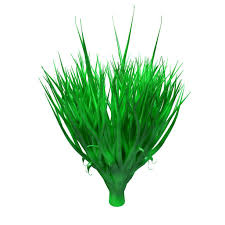
What is Spirulina?
Spirulina is incredibly nutrient-dense, containing a good amount of
Protein: It's a complete protein, meaning it contains all essential amino acids, making it a great plant-based
Spirulina is incredibly nutrient-dense, containing a good amount of
Protein: It's a complete protein, meaning it contains all essential amino acids, making it a great plant-based
What is Spirulina?
Spirulina is incredibly nutrient-dense, containing a good amount of
Protein: It's a complete protein, meaning it contains all essential amino acids, making it a great plant-based protein source, especially for vegetarians and vegans.
Vitamins: Rich in B vitamins (B1, B2, B3), vitamin E, and beta-carotene.
Minerals: Provides iron, copper, magnesium, manganese, selenium, and zinc.
Antioxidants: Notably contains phycocyanin, which gives spirulina its characteristic blue-green color and possesses strong antioxidant and anti-inflammatory properties.
Fatty Acids: Contains beneficial omega-3 and omega-6 fatty acids.
Health benefits-
1. Powerful Antioxidant and Anti-inflammatory Properties: Spirulina's high antioxidant content, especially phycocyanin, helps combat oxidative stress in the body. Oxidative stress is caused by free radicals and can damage cells, contributing to various chronic diseases.Phycocyanin has been shown to inhibit inflammatory responses, making spirulina a natural anti-inflammatory agent. This can help reduce inflammation throughout the body.
2. Supports Heart Health: Cholesterol and Triglyceride Reduction: Studies suggest spirulina can help lower total cholesterol, "bad" LDL cholesterol, and triglycerides, while potentially increasing "good" HDL cholesterol. This can significantly reduce the risk of atherosclerosis (plaque buildup in arteries) and coronary artery disease.
3. Blood Pressure Regulation: Research indicates that spirulina can help reduce blood pressure, particularly in individuals with hypertension. This effect is
thought to be due to increased nitric oxide production, which helps relax and dilate blood vessels.
4. Blood Sugar Management: Some studies show that spirulina supplementation can improve fasting blood glucose levels and insulin sensitivity in people with type 2 diabetes. This may help in better blood sugar control.
5. Boosts Immune System: Spirulina can help enhance immune function by stimulating the production of white blood cells and antibodies that fight off infections. Its rich nutrient profile also supports overall immune health.
6. May Alleviate Allergies (Allergic Rhinitis): Several studies suggest that spirulina can significantly improve symptoms of allergic rhinitis (hay fever) like nasal discharge, sneezing, nasal congestion, and itching. It may do this by inhibiting the release of histamine.
7. May Aid in Anemia Prevention and Treatment: Being a good source of iron, spirulina can help increase hemoglobin levels in red blood cells, which is crucial for oxygen transport throughout the body. This makes it beneficial for preventing and managing anemia.
8. Supports Muscle Strength and Endurance: The high protein content in spirulina provides essential amino acids for muscle development and repair. Its antioxidant properties may also help reduce exercise-induced oxidative stress, potentially leading to improved muscle strength, endurance, and faster recovery.
9. Potential for Weight Management: Spirulina, rich in protein and fiber, can promote feelings of fullness and reduce appetite, which may aid in weight loss when combined with a calorie-reduced diet and exercise. Some studies have shown it can help reduce body fat percentage and waist circumference.
10. Promotes Oral Health: Spirulina exhibits antimicrobial and antibacterial properties. Research suggests that it may help reduce dental plaque and gingivitis (gum disease). Some studies even explore its potential in managing oral submucous fibrosis, a precancerous condition.
11. Supports Brain Health: Emerging research suggests a neuroprotective role for spirulina, particularly its antioxidant and anti-inflammatory effects on brain cells. It's being studied for its potential in preventing or slowing the progression of neurodegenerative diseases like Parkinson's and Alzheimer's, though more human research is needed.
12. May Have Anti-Cancer Properties: While more research is ongoing, laboratory studies suggest that the antioxidants in spirulina, particularly phycocyanin, may have anti-cancer effects by neutralizing free radicals, reducing inflammation, and potentially inhibiting the growth of cancer cells. This is an area of active investigation.
Spirulina is incredibly nutrient-dense, containing a good amount of
Protein: It's a complete protein, meaning it contains all essential amino acids, making it a great plant-based protein source, especially for vegetarians and vegans.
Vitamins: Rich in B vitamins (B1, B2, B3), vitamin E, and beta-carotene.
Minerals: Provides iron, copper, magnesium, manganese, selenium, and zinc.
Antioxidants: Notably contains phycocyanin, which gives spirulina its characteristic blue-green color and possesses strong antioxidant and anti-inflammatory properties.
Fatty Acids: Contains beneficial omega-3 and omega-6 fatty acids.
Health benefits-
1. Powerful Antioxidant and Anti-inflammatory Properties: Spirulina's high antioxidant content, especially phycocyanin, helps combat oxidative stress in the body. Oxidative stress is caused by free radicals and can damage cells, contributing to various chronic diseases.Phycocyanin has been shown to inhibit inflammatory responses, making spirulina a natural anti-inflammatory agent. This can help reduce inflammation throughout the body.
2. Supports Heart Health: Cholesterol and Triglyceride Reduction: Studies suggest spirulina can help lower total cholesterol, "bad" LDL cholesterol, and triglycerides, while potentially increasing "good" HDL cholesterol. This can significantly reduce the risk of atherosclerosis (plaque buildup in arteries) and coronary artery disease.
3. Blood Pressure Regulation: Research indicates that spirulina can help reduce blood pressure, particularly in individuals with hypertension. This effect is
thought to be due to increased nitric oxide production, which helps relax and dilate blood vessels.
4. Blood Sugar Management: Some studies show that spirulina supplementation can improve fasting blood glucose levels and insulin sensitivity in people with type 2 diabetes. This may help in better blood sugar control.
5. Boosts Immune System: Spirulina can help enhance immune function by stimulating the production of white blood cells and antibodies that fight off infections. Its rich nutrient profile also supports overall immune health.
6. May Alleviate Allergies (Allergic Rhinitis): Several studies suggest that spirulina can significantly improve symptoms of allergic rhinitis (hay fever) like nasal discharge, sneezing, nasal congestion, and itching. It may do this by inhibiting the release of histamine.
7. May Aid in Anemia Prevention and Treatment: Being a good source of iron, spirulina can help increase hemoglobin levels in red blood cells, which is crucial for oxygen transport throughout the body. This makes it beneficial for preventing and managing anemia.
8. Supports Muscle Strength and Endurance: The high protein content in spirulina provides essential amino acids for muscle development and repair. Its antioxidant properties may also help reduce exercise-induced oxidative stress, potentially leading to improved muscle strength, endurance, and faster recovery.
9. Potential for Weight Management: Spirulina, rich in protein and fiber, can promote feelings of fullness and reduce appetite, which may aid in weight loss when combined with a calorie-reduced diet and exercise. Some studies have shown it can help reduce body fat percentage and waist circumference.
10. Promotes Oral Health: Spirulina exhibits antimicrobial and antibacterial properties. Research suggests that it may help reduce dental plaque and gingivitis (gum disease). Some studies even explore its potential in managing oral submucous fibrosis, a precancerous condition.
11. Supports Brain Health: Emerging research suggests a neuroprotective role for spirulina, particularly its antioxidant and anti-inflammatory effects on brain cells. It's being studied for its potential in preventing or slowing the progression of neurodegenerative diseases like Parkinson's and Alzheimer's, though more human research is needed.
12. May Have Anti-Cancer Properties: While more research is ongoing, laboratory studies suggest that the antioxidants in spirulina, particularly phycocyanin, may have anti-cancer effects by neutralizing free radicals, reducing inflammation, and potentially inhibiting the growth of cancer cells. This is an area of active investigation.
Custard Apple
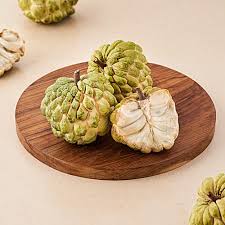
Custard apple, also known as sitaphal, is a delicious and nutritious fruit with a creamy texture and sweet flavor. It is packed with vitamins, minerals, and antioxidants, offering a range of health be
Custard apple, also known as sitaphal, is a delicious and nutritious fruit with a creamy texture and sweet flavor. It is packed with vitamins, minerals, and antioxidants, offering a range of health benefits.
Key Nutritional Components
Custard apple is a good source of:
1. Vitamins: Vitamin C, Vitamin A, Vitamin B6, and some B2 and B9 (folate).
2. Minerals: Potassium, magnesium, calcium, phosphorus, and iron.
3. Dietary Fiber: Both soluble and insoluble fiber.
4. Antioxidants: Flavonoids, carotenoids (like lutein), and other phenolic compounds.
Health Benefits
Supports Heart Health: The high content of potassium and magnesium helps regulate blood pressure by promoting the dilation of blood vessels. The dietary fiber can also help lower cholesterol levels, reducing the risk of heart disease.
Aids in Digestion: Custard apple is rich in dietary fiber, which promotes healthy bowel movements, prevents constipation, and supports the growth of beneficial gut bacteria.
Boosts Immunity: The fruit is an excellent source of Vitamin C, a powerful antioxidant that helps strengthen the immune system and protect the body from infections.
May Help Regulate Blood Sugar: Despite its sweet taste, custard apple has a low to moderate glycemic index. The high fiber content helps slow down the absorption of sugar into the bloodstream, preventing sudden spikes in blood glucose levels. Some studies also suggest that compounds in custard apple leaves may help enhance insulin production. However, it's important for individuals with diabetes to consume it in moderation and monitor their blood sugar levels.
Promotes Eye Health: Custard apple contains Vitamin A and the carotenoid antioxidant lutein, both of which are crucial for maintaining healthy vision, protecting the eyes from oxidative damage, and reducing the risk of age-related macular degeneration (AMD).
Enhances Mood and Brain Function: The Vitamin B6 in custard apple plays a vital role in the production of neurotransmitters like serotonin and dopamine, which help regulate mood and cognitive function.
Provides a Natural Energy Boost: The natural sugars (fructose and glucose) in custard apple provide sustained energy, making it an ideal snack for athletes or anyone needing a quick pick-me-up.
Has Anti-inflammatory Properties: The antioxidants in custard apple, such as kaurenoic acid and flavonoids, have anti-inflammatory effects that can help reduce the risk of chronic inflammatory conditions.
Key Nutritional Components
Custard apple is a good source of:
1. Vitamins: Vitamin C, Vitamin A, Vitamin B6, and some B2 and B9 (folate).
2. Minerals: Potassium, magnesium, calcium, phosphorus, and iron.
3. Dietary Fiber: Both soluble and insoluble fiber.
4. Antioxidants: Flavonoids, carotenoids (like lutein), and other phenolic compounds.
Health Benefits
Supports Heart Health: The high content of potassium and magnesium helps regulate blood pressure by promoting the dilation of blood vessels. The dietary fiber can also help lower cholesterol levels, reducing the risk of heart disease.
Aids in Digestion: Custard apple is rich in dietary fiber, which promotes healthy bowel movements, prevents constipation, and supports the growth of beneficial gut bacteria.
Boosts Immunity: The fruit is an excellent source of Vitamin C, a powerful antioxidant that helps strengthen the immune system and protect the body from infections.
May Help Regulate Blood Sugar: Despite its sweet taste, custard apple has a low to moderate glycemic index. The high fiber content helps slow down the absorption of sugar into the bloodstream, preventing sudden spikes in blood glucose levels. Some studies also suggest that compounds in custard apple leaves may help enhance insulin production. However, it's important for individuals with diabetes to consume it in moderation and monitor their blood sugar levels.
Promotes Eye Health: Custard apple contains Vitamin A and the carotenoid antioxidant lutein, both of which are crucial for maintaining healthy vision, protecting the eyes from oxidative damage, and reducing the risk of age-related macular degeneration (AMD).
Enhances Mood and Brain Function: The Vitamin B6 in custard apple plays a vital role in the production of neurotransmitters like serotonin and dopamine, which help regulate mood and cognitive function.
Provides a Natural Energy Boost: The natural sugars (fructose and glucose) in custard apple provide sustained energy, making it an ideal snack for athletes or anyone needing a quick pick-me-up.
Has Anti-inflammatory Properties: The antioxidants in custard apple, such as kaurenoic acid and flavonoids, have anti-inflammatory effects that can help reduce the risk of chronic inflammatory conditions.
Lima Beans
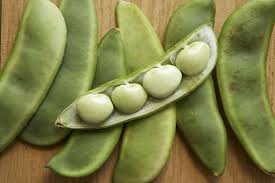
Lima beans, scientifically known as Phaseolus lunatus, are a type of legume cultivated for their edible seeds. They are also widely referred to as butter beans.Lima beans are typically flat and kidney
Lima beans, scientifically known as Phaseolus lunatus, are a type of legume cultivated for their edible seeds. They are also widely referred to as butter beans.Lima beans are typically flat and kidney-shaped. They can range in color from pale green when immature to white, cream, or speckled when mature.
Lima beans are a good source of protein, fiber, folate, Manganese, iron, Potassium.
Health Benefits
1. Promotes Heart Health: Lima beans are low in fat and cholesterol. The soluble fiber they contain can help lower LDL ("bad") cholesterol levels. They also provide magnesium and potassium, two minerals that are vital for maintaining healthy blood pressure.
2. Aids in Blood Sugar Control: Due to their high fiber content and low glycemic index, lima beans can help stabilize blood sugar levels. The fiber slows down the absorption of carbohydrates, preventing a rapid spike in blood glucose after a meal.
3. Supports Digestive Health: Both soluble and insoluble fiber in lima beans contribute to a healthy digestive system. Insoluble fiber adds bulk to stool, helping to prevent constipation, while resistant starch feeds the "good" bacteria in your gut, which can improve overall gut health and may lower the risk of colon cancer.
4. Assists with Weight Management: Lima beans are high in both protein and fiber, which help you feel full and satisfied for longer. This can reduce overeating and assist with weight loss or weight maintenance.
5. Rich in Antioxidants: Lima beans contain antioxidants, such as polyphenols, which help protect your body's cells from damage caused by oxidative stress and inflammation.
6. Provides Plant-Based Protein: Lima beans are an excellent source of plant-based protein, making them a great food choice for vegetarians and vegans
Lima beans are a good source of protein, fiber, folate, Manganese, iron, Potassium.
Health Benefits
1. Promotes Heart Health: Lima beans are low in fat and cholesterol. The soluble fiber they contain can help lower LDL ("bad") cholesterol levels. They also provide magnesium and potassium, two minerals that are vital for maintaining healthy blood pressure.
2. Aids in Blood Sugar Control: Due to their high fiber content and low glycemic index, lima beans can help stabilize blood sugar levels. The fiber slows down the absorption of carbohydrates, preventing a rapid spike in blood glucose after a meal.
3. Supports Digestive Health: Both soluble and insoluble fiber in lima beans contribute to a healthy digestive system. Insoluble fiber adds bulk to stool, helping to prevent constipation, while resistant starch feeds the "good" bacteria in your gut, which can improve overall gut health and may lower the risk of colon cancer.
4. Assists with Weight Management: Lima beans are high in both protein and fiber, which help you feel full and satisfied for longer. This can reduce overeating and assist with weight loss or weight maintenance.
5. Rich in Antioxidants: Lima beans contain antioxidants, such as polyphenols, which help protect your body's cells from damage caused by oxidative stress and inflammation.
6. Provides Plant-Based Protein: Lima beans are an excellent source of plant-based protein, making them a great food choice for vegetarians and vegans
Cortisol Hormone
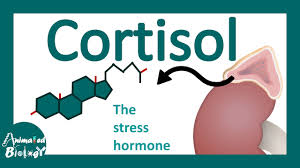
Cortisol is a steroid hormone produced by the adrenal glands, which are located on top of each kidney. It is often referred to as the "stress hormone" because of its crucial role in the body's respons
Cortisol is a steroid hormone produced by the adrenal glands, which are located on top of each kidney. It is often referred to as the "stress hormone" because of its crucial role in the body's response to stress.
Functions of Cortisol
Cortisol has wide-ranging effects on nearly every organ and tissue in the body, including:
1. Stress Response: Cortisol is a key component of the "fight-or-flight" response. In a stressful situation, the hypothalamus in the brain signals the adrenal
glands to release cortisol and other hormones like adrenaline. Cortisol increases blood sugar (glucose) to provide the body with a quick energy source and
suppresses non-essential functions like the immune system, digestion, and reproduction, allowing the body to focus on dealing with the perceived threat.
2. Metabolism: Cortisol helps regulate how the body uses carbohydrates, fats, and proteins for energy.
3. Inflammation: It has anti-inflammatory properties, helping to reduce swelling and pain.
4. Blood Pressure: Cortisol plays a role in regulating blood pressure.
5. Sleep-Wake Cycle: Cortisol levels naturally fluctuate throughout the day, peaking in the morning to help you wake up and decreasing in the evening to prepare you for sleep.
Cortisol and Health
While cortisol is essential for health, chronic or prolonged stress can lead to consistently high cortisol levels, which may have negative health consequences, including:
1. Anxiety and depression
2. Headaches
3. Weight gain (especially around the abdomen and face)
4. High blood pressure and heart disease
5. Trouble sleeping
6. Muscle weakness and loss
Cortisol levels can be measured through blood, urine, or saliva tests to help diagnose conditions like Cushing's syndrome (too much cortisol) or Addison's disease (too little cortisol).
Here are some foods and nutrients that are particularly good for managing cortisol levels:
1. Foods Rich in Magnesium
Magnesium is a mineral that plays a crucial role in calming the nervous system and is often depleted during times of stress.
Foods to eat: Leafy green vegetables (spinach, kale), nuts (almonds, cashews), seeds (pumpkin, chia), legumes, and dark chocolate.
2. Omega-3 Fatty Acids
These healthy fats can help reduce inflammation, which is closely linked to high cortisol levels. They also support overall brain health.
Foods to eat: Fatty fish (salmon, mackerel, sardines), walnuts, and flaxseeds.
3. Probiotic and Fermented Foods
A healthy gut microbiome has a strong connection to brain health and mood. Fermented foods contain beneficial bacteria that can help regulate your body's stress response.
Foods to eat: Yogurt with live and active cultures, kefir, sauerkraut, kimchi, and kombucha.
4. Foods High in Vitamin C
Vitamin C helps support the adrenal glands, which produce cortisol. It also helps to neutralize oxidative stress caused by chronic stress.
Foods to eat: Citrus fruits (oranges, grapefruit), bell peppers, strawberries, and kiwi.
5. Complex Carbohydrates
While processed carbs can cause blood sugar spikes and crashes, complex carbs provide a steady source of energy and can help boost serotonin, a feel-good neurotransmitter.
Foods to eat: Whole grains (oats, brown rice, quinoa), sweet potatoes, and legumes.
6. Foods Containing B Vitamins
B vitamins, especially B5, B6, and B12, are essential for energy production and adrenal health, which is vital for managing stress hormones.
Foods to eat: Lean proteins (chicken, turkey, eggs), whole grains, and leafy greens.
7. Other Notable Foods
Dark Chocolate: In moderation, dark chocolate (with a high cacao content) contains antioxidants and magnesium that may help lower cortisol.
Green Tea: Contains L-theanine, an amino acid known for its calming effects and ability to promote relaxation.
Foods to Limit or Avoid
1. Excessive Sugar and Processed Foods: These can cause blood sugar spikes and inflammation, putting more stress on the body.
2. Excessive Caffeine: While a little caffeine is fine, too much can increase cortisol levels and disrupt your sleep cycle.
3. Alcohol: Alcohol can interfere with sleep and hormone regulation, leading to higher cortisol levels.
Functions of Cortisol
Cortisol has wide-ranging effects on nearly every organ and tissue in the body, including:
1. Stress Response: Cortisol is a key component of the "fight-or-flight" response. In a stressful situation, the hypothalamus in the brain signals the adrenal
glands to release cortisol and other hormones like adrenaline. Cortisol increases blood sugar (glucose) to provide the body with a quick energy source and
suppresses non-essential functions like the immune system, digestion, and reproduction, allowing the body to focus on dealing with the perceived threat.
2. Metabolism: Cortisol helps regulate how the body uses carbohydrates, fats, and proteins for energy.
3. Inflammation: It has anti-inflammatory properties, helping to reduce swelling and pain.
4. Blood Pressure: Cortisol plays a role in regulating blood pressure.
5. Sleep-Wake Cycle: Cortisol levels naturally fluctuate throughout the day, peaking in the morning to help you wake up and decreasing in the evening to prepare you for sleep.
Cortisol and Health
While cortisol is essential for health, chronic or prolonged stress can lead to consistently high cortisol levels, which may have negative health consequences, including:
1. Anxiety and depression
2. Headaches
3. Weight gain (especially around the abdomen and face)
4. High blood pressure and heart disease
5. Trouble sleeping
6. Muscle weakness and loss
Cortisol levels can be measured through blood, urine, or saliva tests to help diagnose conditions like Cushing's syndrome (too much cortisol) or Addison's disease (too little cortisol).
Here are some foods and nutrients that are particularly good for managing cortisol levels:
1. Foods Rich in Magnesium
Magnesium is a mineral that plays a crucial role in calming the nervous system and is often depleted during times of stress.
Foods to eat: Leafy green vegetables (spinach, kale), nuts (almonds, cashews), seeds (pumpkin, chia), legumes, and dark chocolate.
2. Omega-3 Fatty Acids
These healthy fats can help reduce inflammation, which is closely linked to high cortisol levels. They also support overall brain health.
Foods to eat: Fatty fish (salmon, mackerel, sardines), walnuts, and flaxseeds.
3. Probiotic and Fermented Foods
A healthy gut microbiome has a strong connection to brain health and mood. Fermented foods contain beneficial bacteria that can help regulate your body's stress response.
Foods to eat: Yogurt with live and active cultures, kefir, sauerkraut, kimchi, and kombucha.
4. Foods High in Vitamin C
Vitamin C helps support the adrenal glands, which produce cortisol. It also helps to neutralize oxidative stress caused by chronic stress.
Foods to eat: Citrus fruits (oranges, grapefruit), bell peppers, strawberries, and kiwi.
5. Complex Carbohydrates
While processed carbs can cause blood sugar spikes and crashes, complex carbs provide a steady source of energy and can help boost serotonin, a feel-good neurotransmitter.
Foods to eat: Whole grains (oats, brown rice, quinoa), sweet potatoes, and legumes.
6. Foods Containing B Vitamins
B vitamins, especially B5, B6, and B12, are essential for energy production and adrenal health, which is vital for managing stress hormones.
Foods to eat: Lean proteins (chicken, turkey, eggs), whole grains, and leafy greens.
7. Other Notable Foods
Dark Chocolate: In moderation, dark chocolate (with a high cacao content) contains antioxidants and magnesium that may help lower cortisol.
Green Tea: Contains L-theanine, an amino acid known for its calming effects and ability to promote relaxation.
Foods to Limit or Avoid
1. Excessive Sugar and Processed Foods: These can cause blood sugar spikes and inflammation, putting more stress on the body.
2. Excessive Caffeine: While a little caffeine is fine, too much can increase cortisol levels and disrupt your sleep cycle.
3. Alcohol: Alcohol can interfere with sleep and hormone regulation, leading to higher cortisol levels.
Ivy Gourd ( Coccinia)
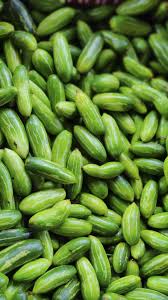
Coccinia, more commonly known as ivy gourd, tindora, or kundru, is a nutritional powerhouse with various health benefits. This tropical vegetable is rich in vitamins, minerals, and antioxidants that c
Coccinia, more commonly known as ivy gourd, tindora, or kundru, is a nutritional powerhouse with various health benefits. This tropical vegetable is rich in vitamins, minerals, and antioxidants that contribute to overall health and help manage several conditions.
Key health benefits of ivy gourd
1. Regulates blood sugar: Ivy gourd has long been used in traditional medicine to help manage diabetes. It contains compounds that help regulate blood sugar levels, improve glucose metabolism, and enhance insulin sensitivity.
Aids in weight management: Low in calories and high in dietary fiber, ivy gourd can help you feel full for longer, which can reduce overall calorie intake and support weight loss.
2. Promotes digestive health: Its high fiber content supports optimal digestion, promotes regular bowel movements, and can help prevent constipation. Fiber also acts as a prebiotic, feeding the beneficial bacteria in your gut.
3. Boosts immunity: Ivy gourd is rich in vitamin C, a vital nutrient that stimulates the production of white blood cells and strengthens the body's natural defense mechanisms.
4. Supports heart health: This vegetable contains potassium, which helps regulate blood pressure, and its high fiber content can help lower cholesterol levels, both of which reduce the risk of heart disease.
5. Fights inflammation: Packed with antioxidants, such as beta-carotene, ivy gourd has anti-inflammatory properties that can help manage conditions like arthritis.
6. Enhances energy metabolism: Ivy gourd is a good source of B vitamins like thiamine (B1), which plays a crucial role in converting carbohydrates, fats, and proteins into usable energy. The iron content also helps combat fatigue.
7. Protects against cancer: The antioxidants and beta-carotene found in ivy gourd can help protect the body from oxidative stress and free radical damage, which are linked to the growth of cancer cells.
Nutritional profile
Ivy gourd contains a robust combination of nutrients, including:
Vitamins: A, C, B1, and B2.
Minerals: Iron, calcium, and potassium.
Antioxidants: Beta-carotene, flavonoids, and other compounds.
Key health benefits of ivy gourd
1. Regulates blood sugar: Ivy gourd has long been used in traditional medicine to help manage diabetes. It contains compounds that help regulate blood sugar levels, improve glucose metabolism, and enhance insulin sensitivity.
Aids in weight management: Low in calories and high in dietary fiber, ivy gourd can help you feel full for longer, which can reduce overall calorie intake and support weight loss.
2. Promotes digestive health: Its high fiber content supports optimal digestion, promotes regular bowel movements, and can help prevent constipation. Fiber also acts as a prebiotic, feeding the beneficial bacteria in your gut.
3. Boosts immunity: Ivy gourd is rich in vitamin C, a vital nutrient that stimulates the production of white blood cells and strengthens the body's natural defense mechanisms.
4. Supports heart health: This vegetable contains potassium, which helps regulate blood pressure, and its high fiber content can help lower cholesterol levels, both of which reduce the risk of heart disease.
5. Fights inflammation: Packed with antioxidants, such as beta-carotene, ivy gourd has anti-inflammatory properties that can help manage conditions like arthritis.
6. Enhances energy metabolism: Ivy gourd is a good source of B vitamins like thiamine (B1), which plays a crucial role in converting carbohydrates, fats, and proteins into usable energy. The iron content also helps combat fatigue.
7. Protects against cancer: The antioxidants and beta-carotene found in ivy gourd can help protect the body from oxidative stress and free radical damage, which are linked to the growth of cancer cells.
Nutritional profile
Ivy gourd contains a robust combination of nutrients, including:
Vitamins: A, C, B1, and B2.
Minerals: Iron, calcium, and potassium.
Antioxidants: Beta-carotene, flavonoids, and other compounds.
Spine gourd
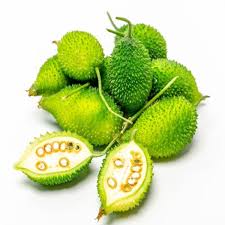
spiny gourd, also known as kantola or teasel gourd, is a nutritious vegetable from the Cucurbitaceae family, prized in South Asian cuisine. It is characterized by a spiny green exterior, with a slight
spiny gourd, also known as kantola or teasel gourd, is a nutritious vegetable from the Cucurbitaceae family, prized in South Asian cuisine. It is characterized by a spiny green exterior, with a slightly bitter flesh that becomes tender when cooked. Rich in vitamins, minerals, and fiber, it is used in various dishes like curries, stir-fries, and stuffed recipes.
Health benefits-
1. Digestive health
High fiber content: Spine gourd's high fiber promotes healthy digestion by adding bulk to stool and preventing constipation.
Aids in digestion: It helps maintain a healthy gut and can aid in regulating blood sugar by slowing sugar absorption into the bloodstream.
2.Blood sugar management
Controls blood sugar: It has properties that help regulate blood sugar levels, making it beneficial for individuals with diabetes.
Improves insulin sensitivity: It can help improve insulin sensitivity and promote pancreatic cell regeneration.
3. Skin and eye health
Healthy skin: Antioxidants and other nutrients in spine gourd help fight oxidative stress, reduce inflammation, and can boost collagen production for healthier skin.
Improved vision: As a good source of vitamin A and carotenoids like lutein, it can help improve eyesight and prevent certain eye diseases.
4. Other benefits
Anti-inflammatory properties: It contains natural compounds that can help reduce inflammation in the body.
Detoxification: It helps the body eliminate toxins, improving overall health and well-being.
Liver health: Its antioxidants and flavonoids can help protect the liver from conditions like fatty liver.
Antioxidant properties: It is rich in antioxidants that protect cells from damage by free radicals
Nutritional benefit-
Spine gourd is a good source of antioxidants and other nutrients, including beta-carotene, vitamin C, folic acid, magnesium, phosphorus, and potassium.
Health benefits-
1. Digestive health
High fiber content: Spine gourd's high fiber promotes healthy digestion by adding bulk to stool and preventing constipation.
Aids in digestion: It helps maintain a healthy gut and can aid in regulating blood sugar by slowing sugar absorption into the bloodstream.
2.Blood sugar management
Controls blood sugar: It has properties that help regulate blood sugar levels, making it beneficial for individuals with diabetes.
Improves insulin sensitivity: It can help improve insulin sensitivity and promote pancreatic cell regeneration.
3. Skin and eye health
Healthy skin: Antioxidants and other nutrients in spine gourd help fight oxidative stress, reduce inflammation, and can boost collagen production for healthier skin.
Improved vision: As a good source of vitamin A and carotenoids like lutein, it can help improve eyesight and prevent certain eye diseases.
4. Other benefits
Anti-inflammatory properties: It contains natural compounds that can help reduce inflammation in the body.
Detoxification: It helps the body eliminate toxins, improving overall health and well-being.
Liver health: Its antioxidants and flavonoids can help protect the liver from conditions like fatty liver.
Antioxidant properties: It is rich in antioxidants that protect cells from damage by free radicals
Nutritional benefit-
Spine gourd is a good source of antioxidants and other nutrients, including beta-carotene, vitamin C, folic acid, magnesium, phosphorus, and potassium.
Aplastic Anemia
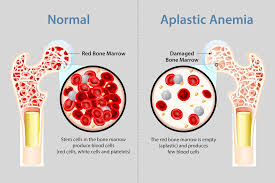
What is aplastic anemia?
Aplastic anemia occurs when your bone marrow doesn’t make enough red and white blood cells, and platelets. Having fewer red blood cells causes hemoglobin to drop.Hemoglobin
Aplastic anemia occurs when your bone marrow doesn’t make enough red and white blood cells, and platelets. Having fewer red blood cells causes hemoglobin to drop.Hemoglobin
What is aplastic anemia?
Aplastic anemia occurs when your bone marrow doesn’t make enough red and white blood cells, and platelets. Having fewer red blood cells causes hemoglobin to drop.Hemoglobin is the part of blood that carries oxygen through your body. Having fewer white blood cells makes you more likely to get an infection. And having fewer platelets makes it hard for the blood to clot. This means you can bleed more easily.
What causes aplastic anemia?
Aplastic anemia has many causes. Sometimes it occurs for no known reason. Other causes are linked to a past illness or disorder. Risk factors may include:
History of certain infectious diseases, such as hepatitis, HIV, Epstein-Barr virus, or CMV)
History of taking certain medicines, such as antibiotics and anticonvulsants
Exposure to certain toxins, such as heavy metals
Exposure to radiation
History of an autoimmune disease, such as lupus
An inherited condition
What are the symptoms of aplastic anemia?
Each person’s symptoms may vary. Symptoms may include:
Headache
Dizziness
Upset stomach (nausea)
Shortness of breath
Bruising
Lack of energy or tiring easily (fatigue)
Abnormal paleness or lack of color in the skin
Blood in stool
Nosebleeds
Bleeding gums
Fevers
Sore sinuses
Enlarged liver or spleen
White patches in the mouth (oral thrush)
How is aplastic anemia treated?
Blood transfusion (both red blood cells and platelets)
Preventive antibiotic therapy
Good hygiene to prevent infection
Special care when making food, such as only eating well-cooked foods
Staying away from construction sites, which may be a source of certain fungi
Medicines to stimulate the bone marrow to make cells
Treatment to reduce your body’s immune system response
Hormone therapy
Aplastic anemia occurs when your bone marrow doesn’t make enough red and white blood cells, and platelets. Having fewer red blood cells causes hemoglobin to drop.Hemoglobin is the part of blood that carries oxygen through your body. Having fewer white blood cells makes you more likely to get an infection. And having fewer platelets makes it hard for the blood to clot. This means you can bleed more easily.
What causes aplastic anemia?
Aplastic anemia has many causes. Sometimes it occurs for no known reason. Other causes are linked to a past illness or disorder. Risk factors may include:
History of certain infectious diseases, such as hepatitis, HIV, Epstein-Barr virus, or CMV)
History of taking certain medicines, such as antibiotics and anticonvulsants
Exposure to certain toxins, such as heavy metals
Exposure to radiation
History of an autoimmune disease, such as lupus
An inherited condition
What are the symptoms of aplastic anemia?
Each person’s symptoms may vary. Symptoms may include:
Headache
Dizziness
Upset stomach (nausea)
Shortness of breath
Bruising
Lack of energy or tiring easily (fatigue)
Abnormal paleness or lack of color in the skin
Blood in stool
Nosebleeds
Bleeding gums
Fevers
Sore sinuses
Enlarged liver or spleen
White patches in the mouth (oral thrush)
How is aplastic anemia treated?
Blood transfusion (both red blood cells and platelets)
Preventive antibiotic therapy
Good hygiene to prevent infection
Special care when making food, such as only eating well-cooked foods
Staying away from construction sites, which may be a source of certain fungi
Medicines to stimulate the bone marrow to make cells
Treatment to reduce your body’s immune system response
Hormone therapy


